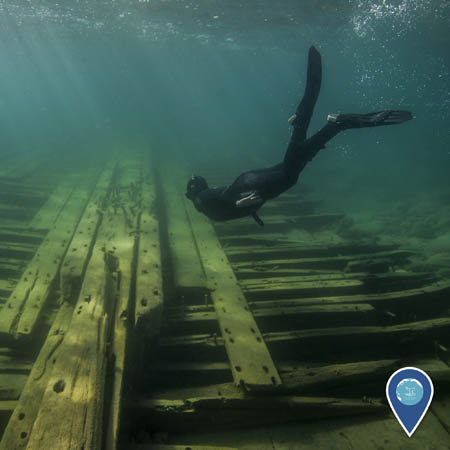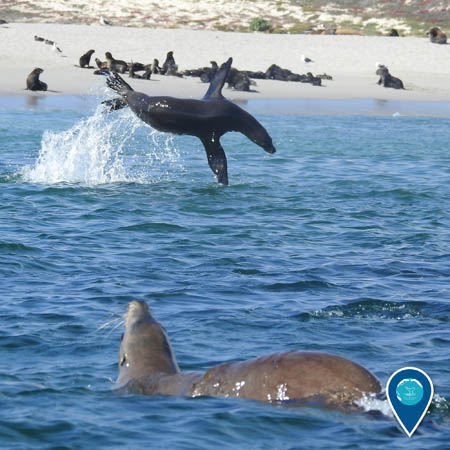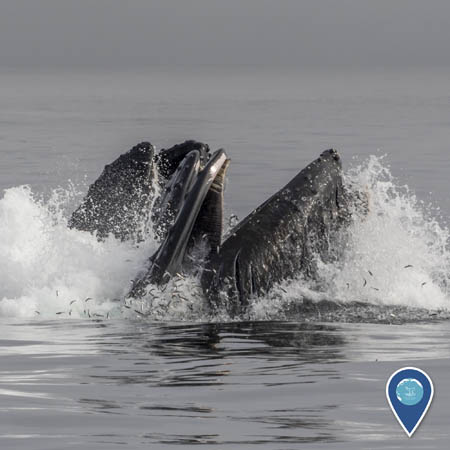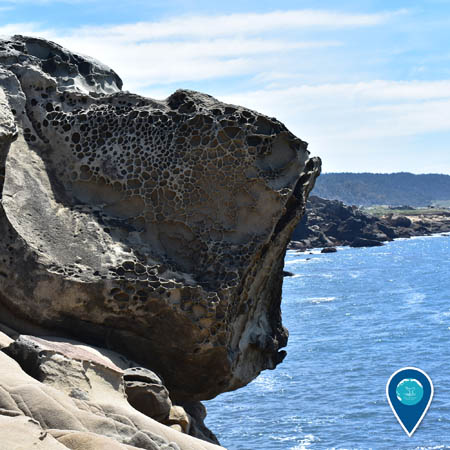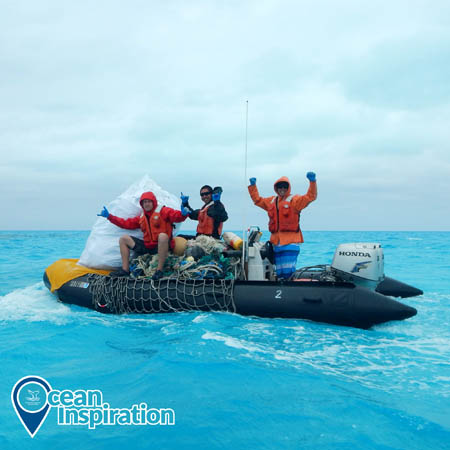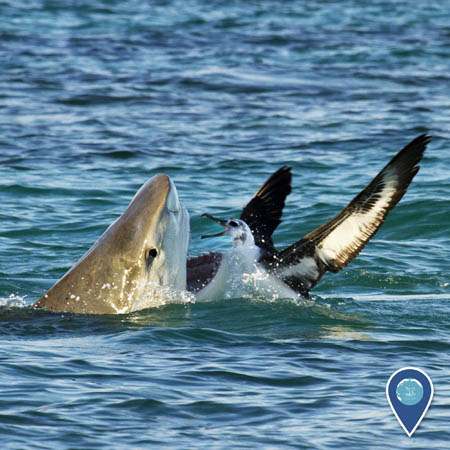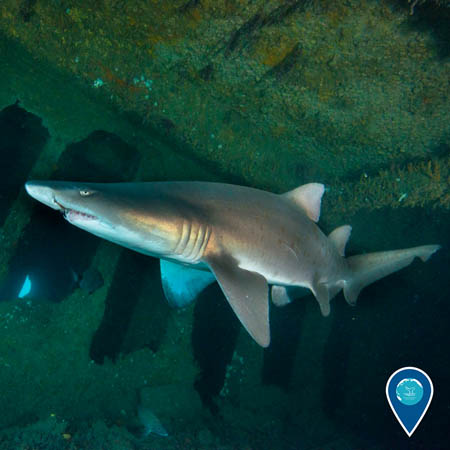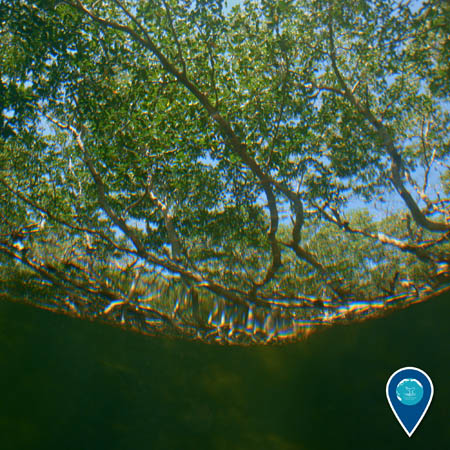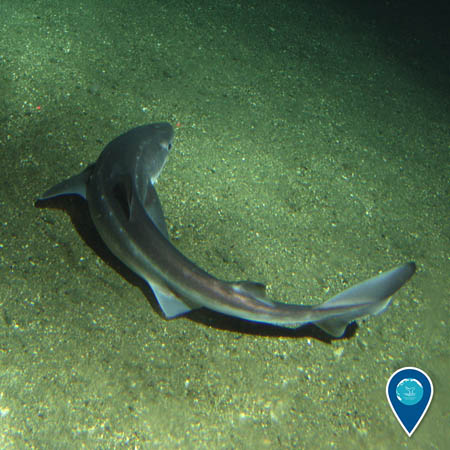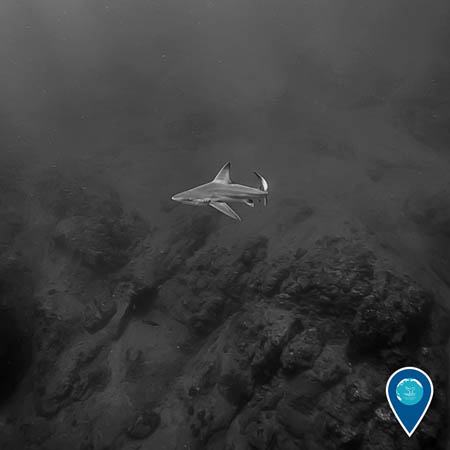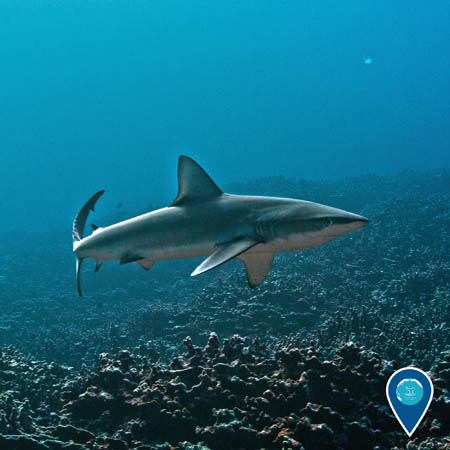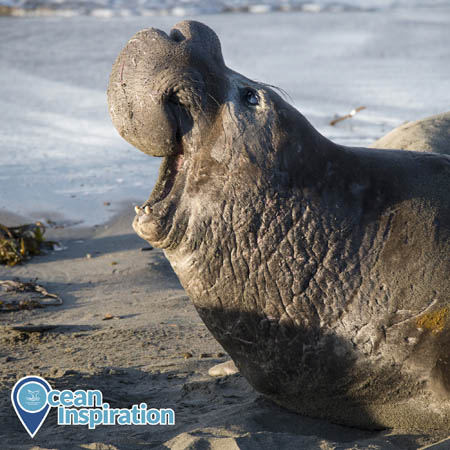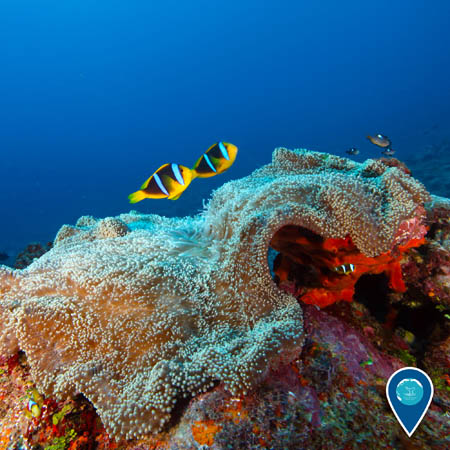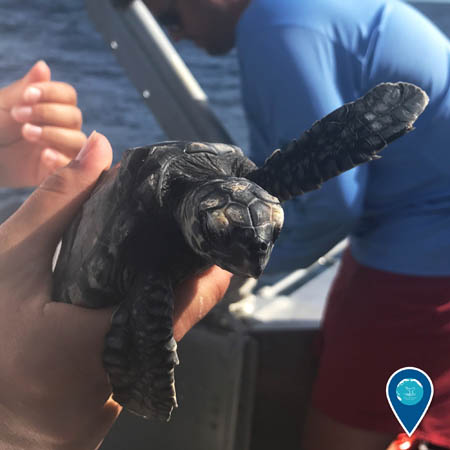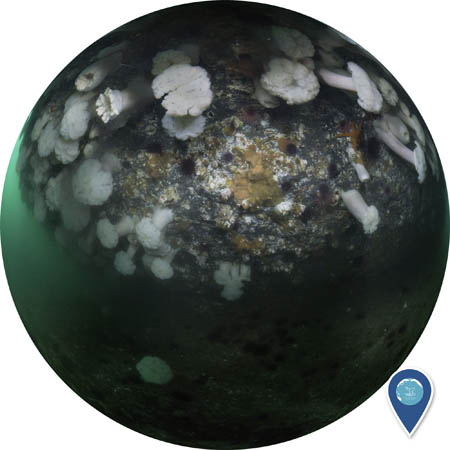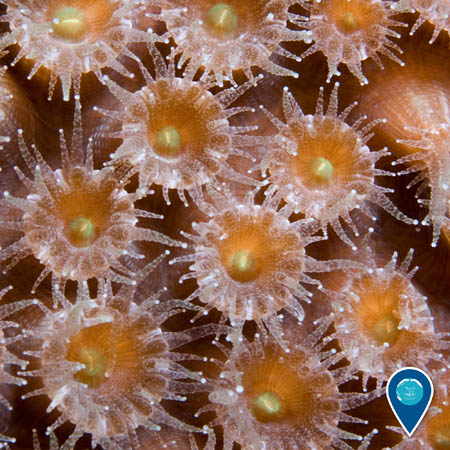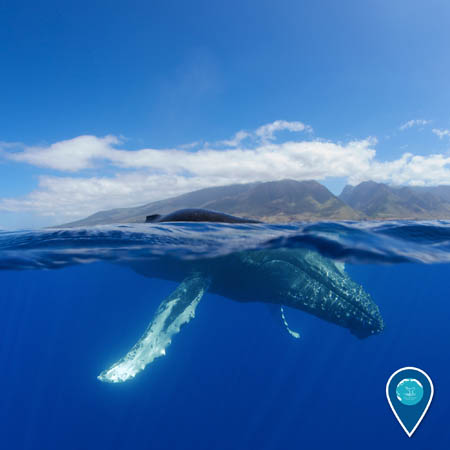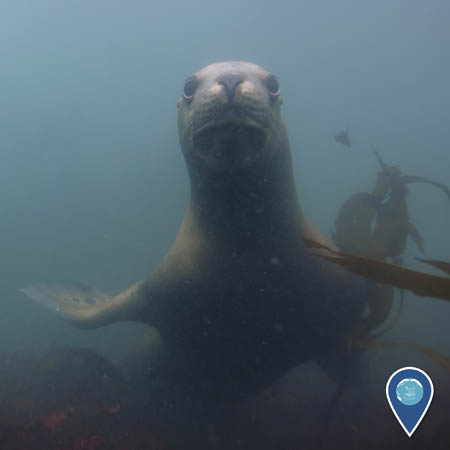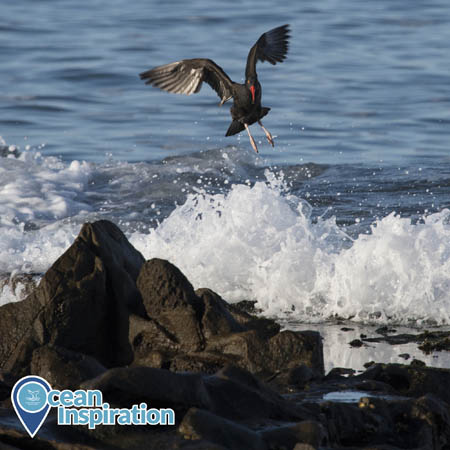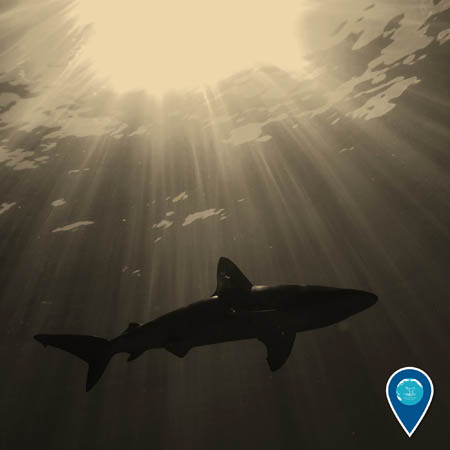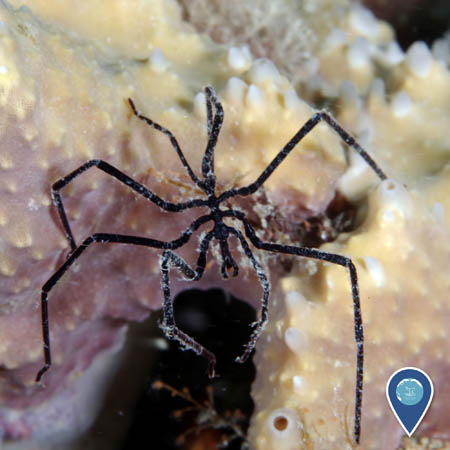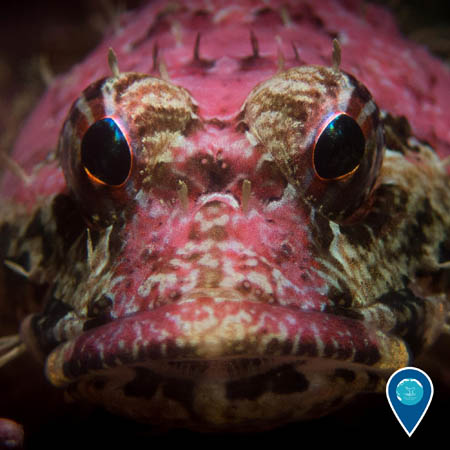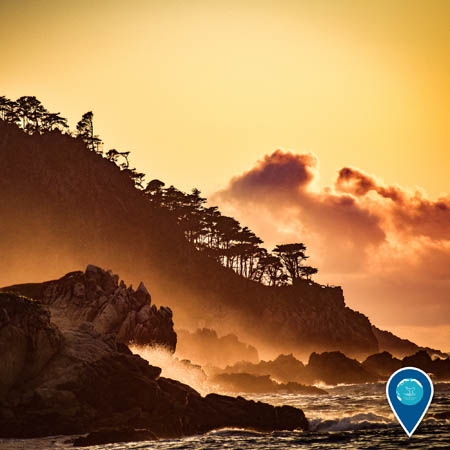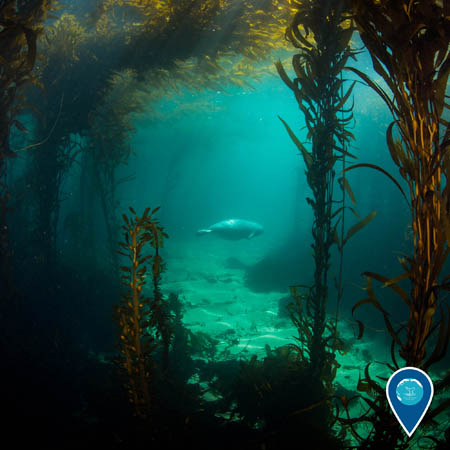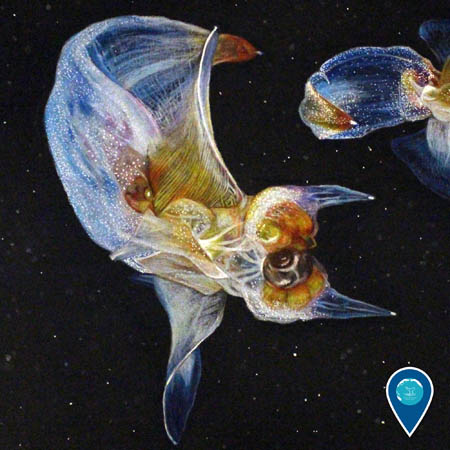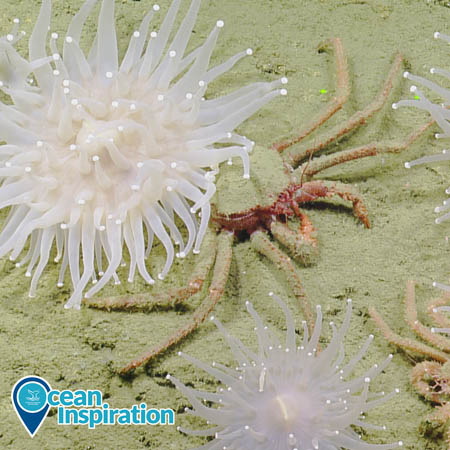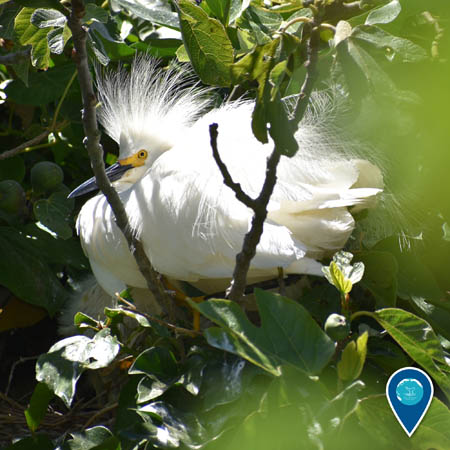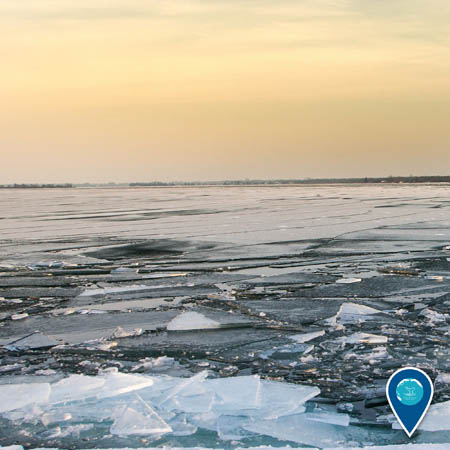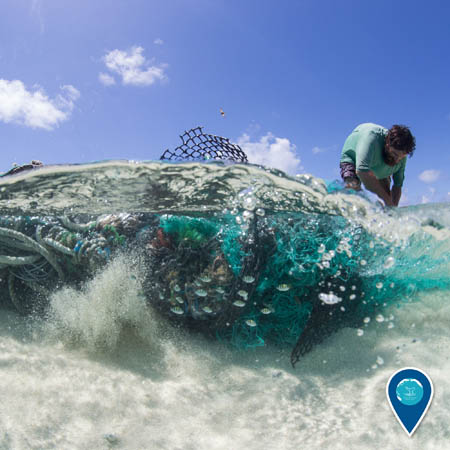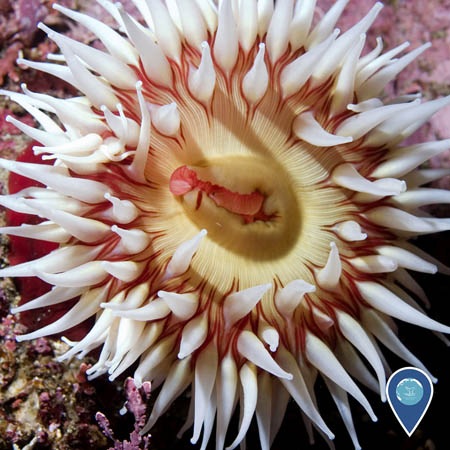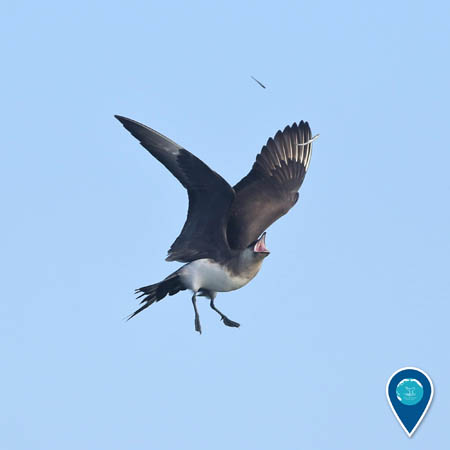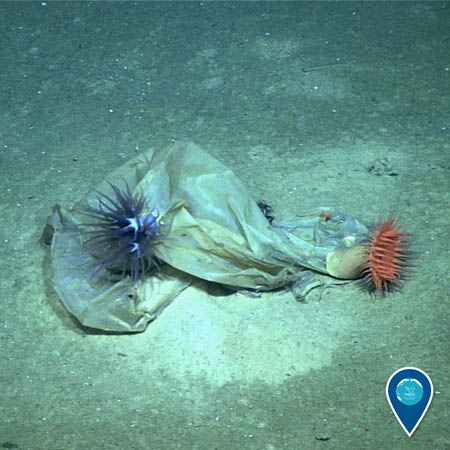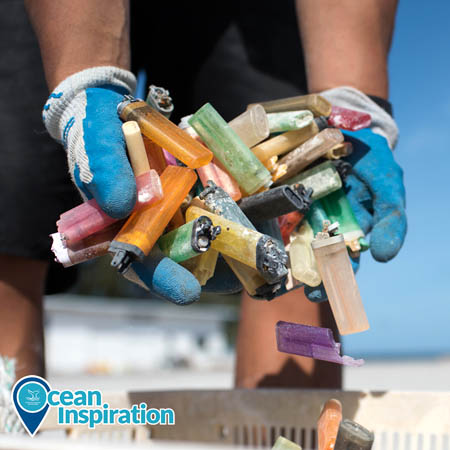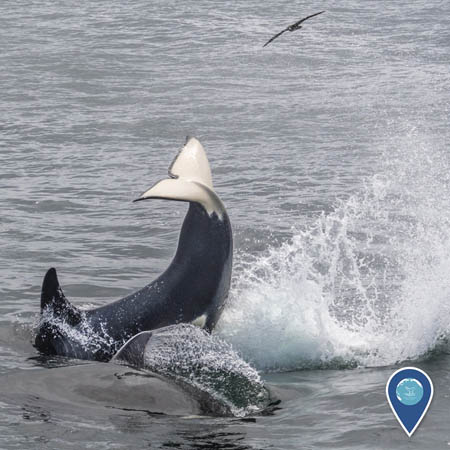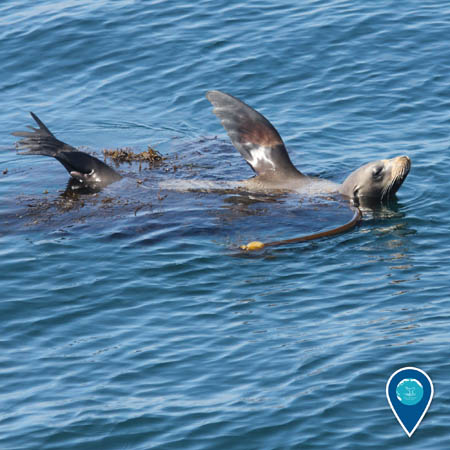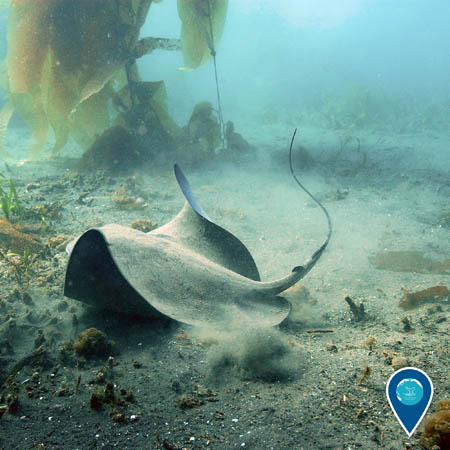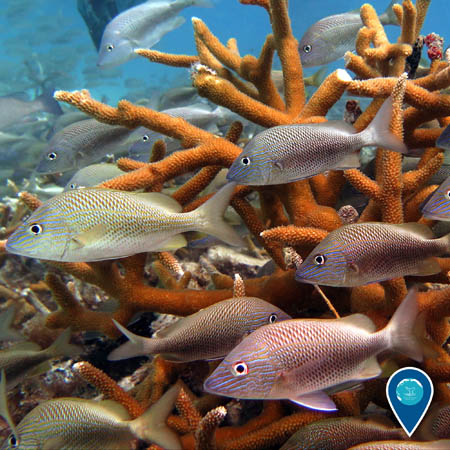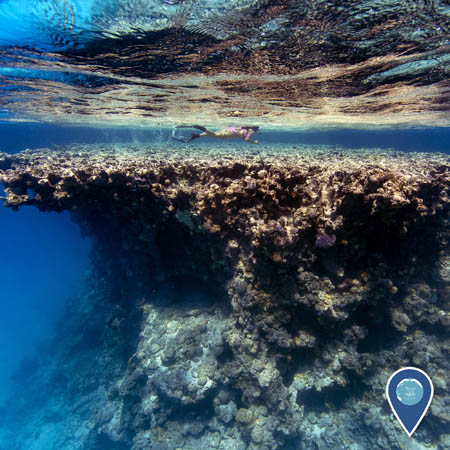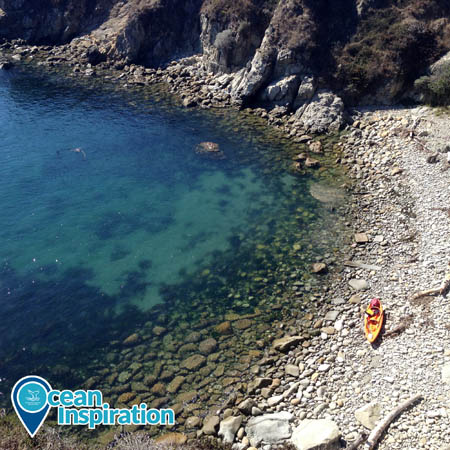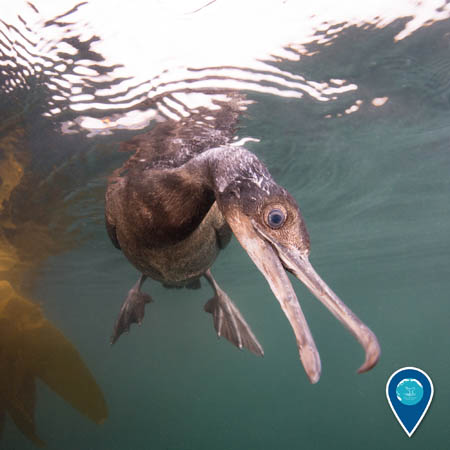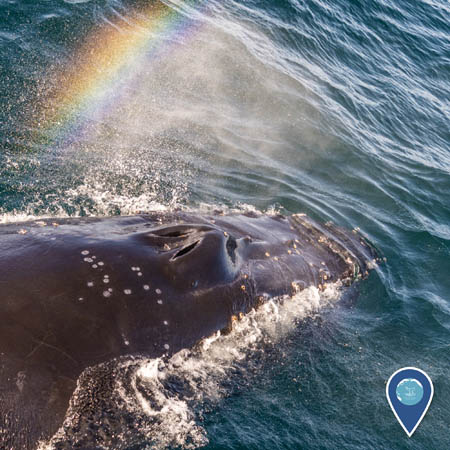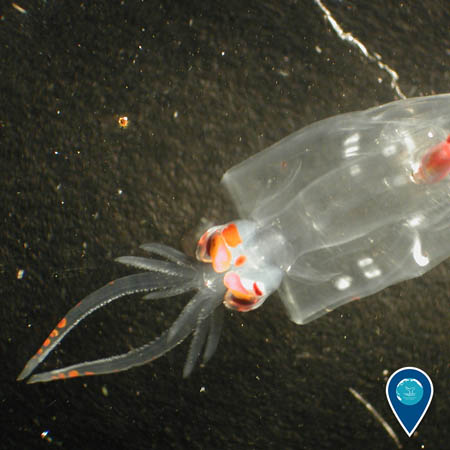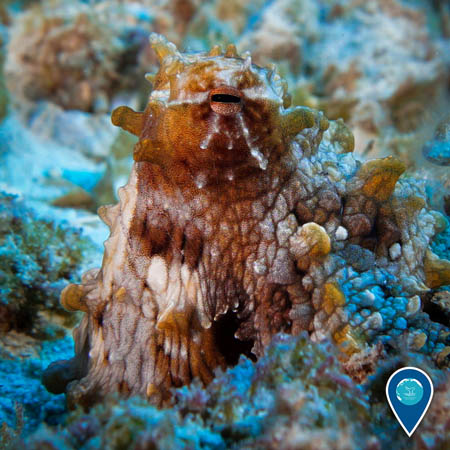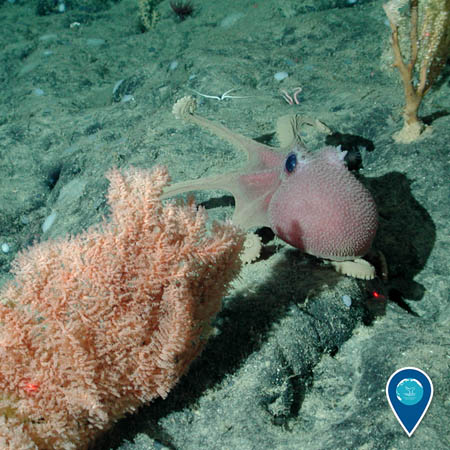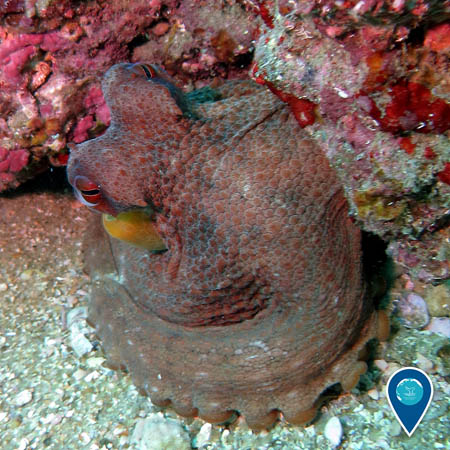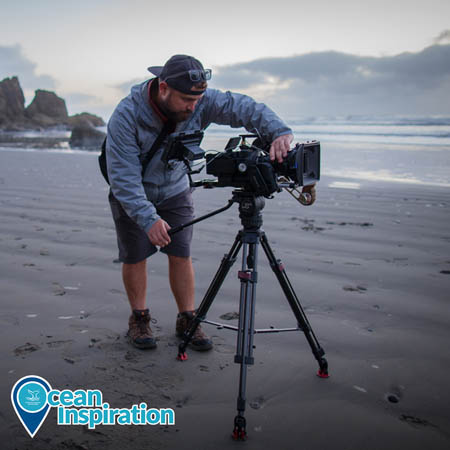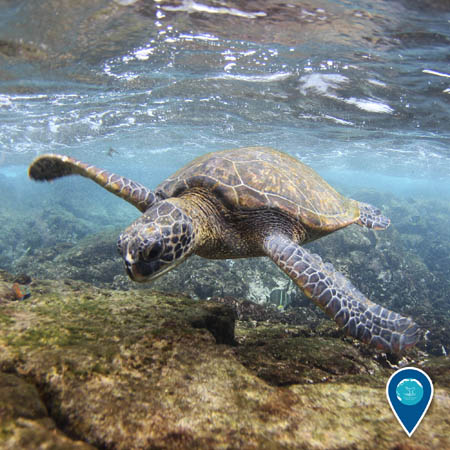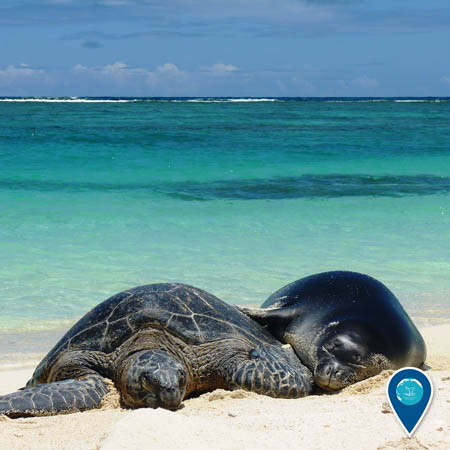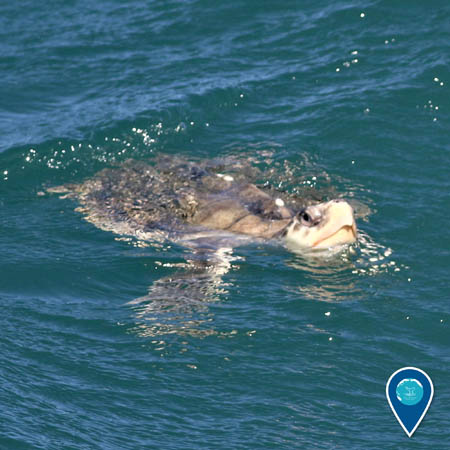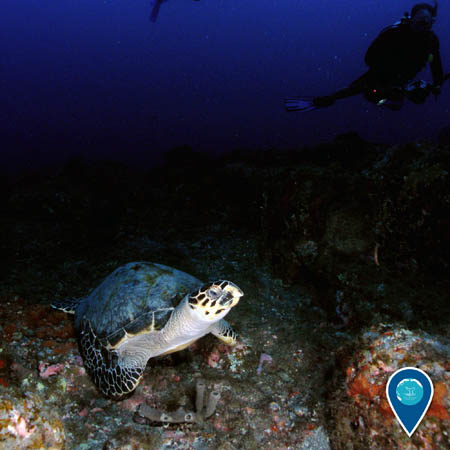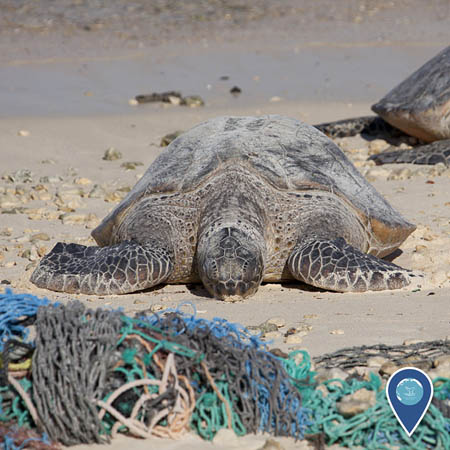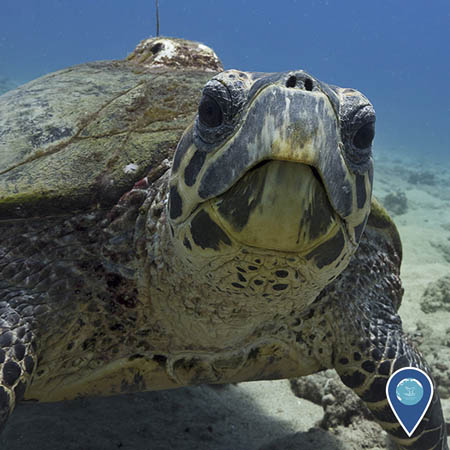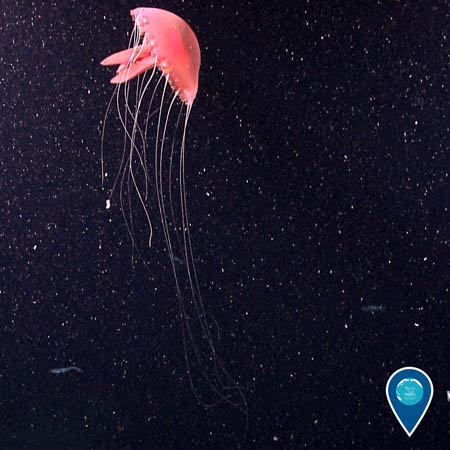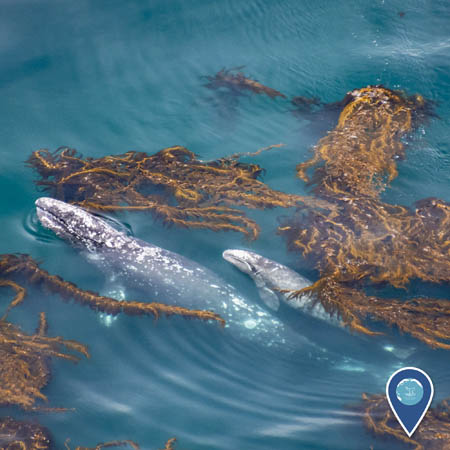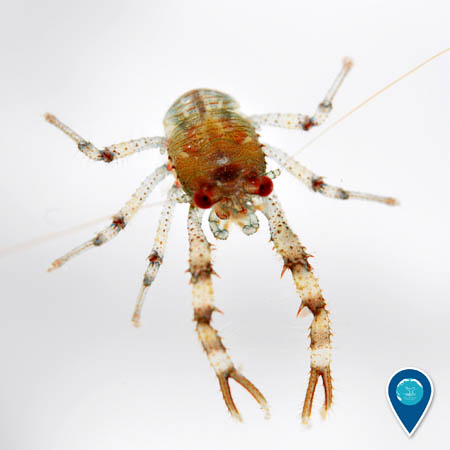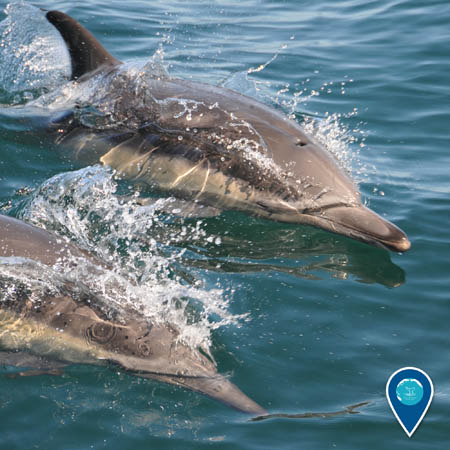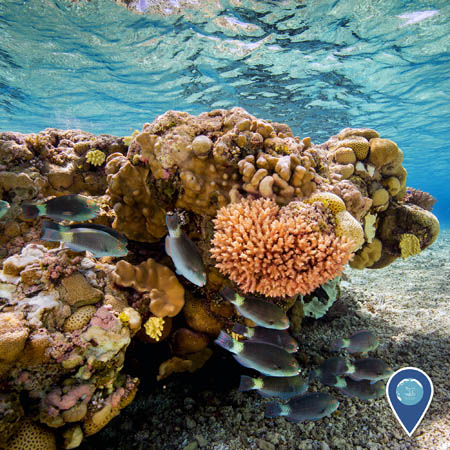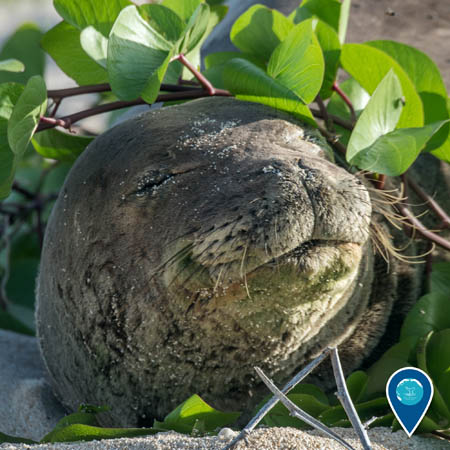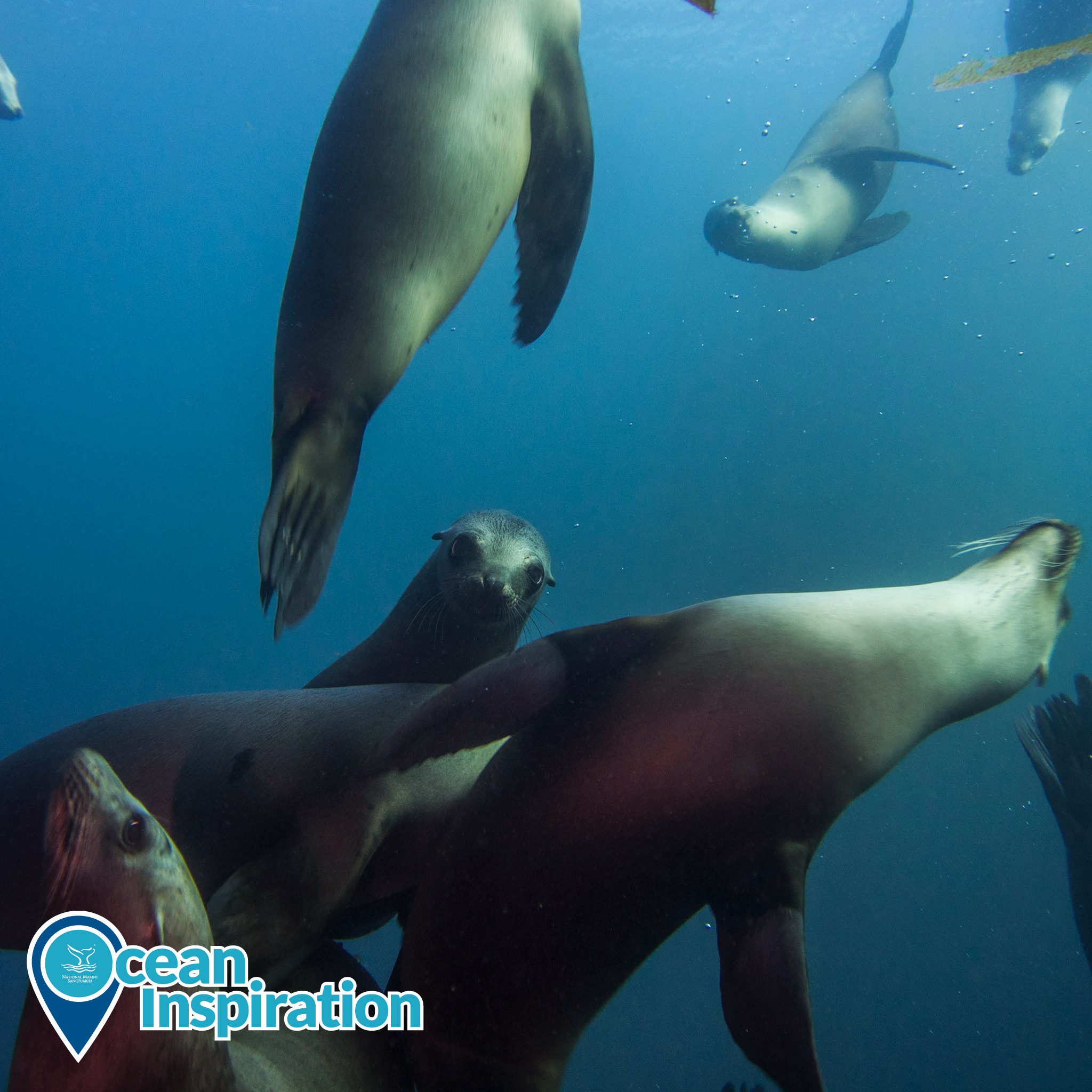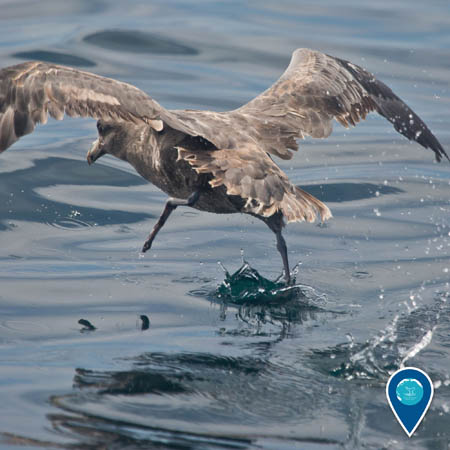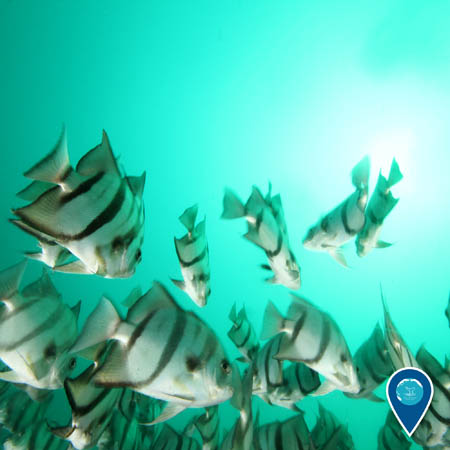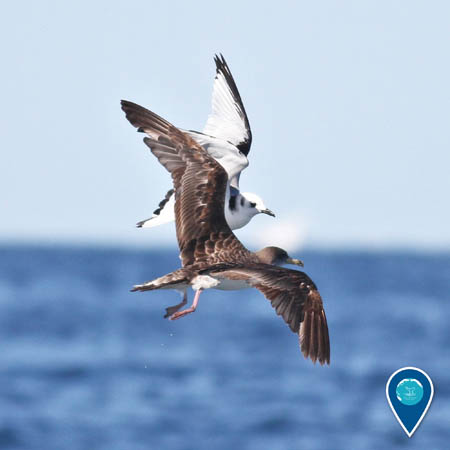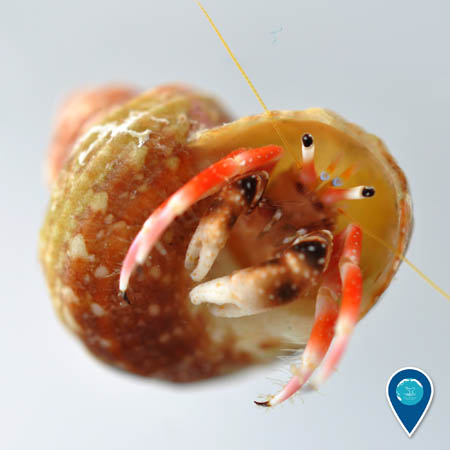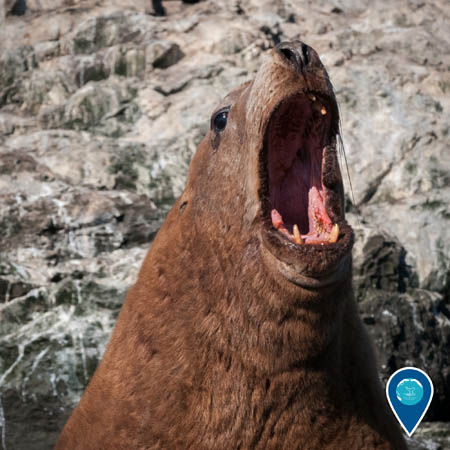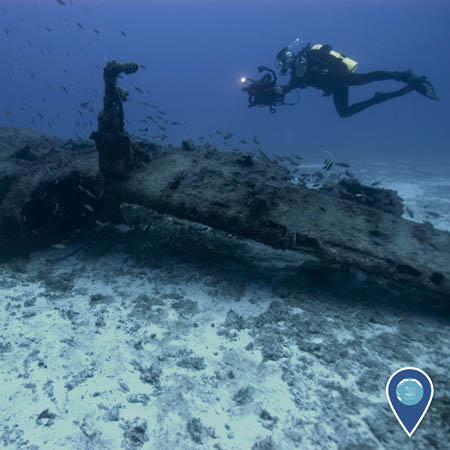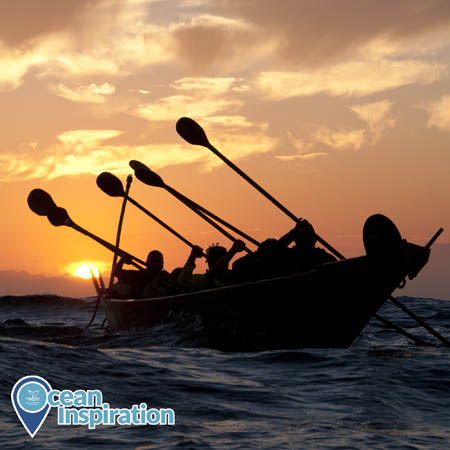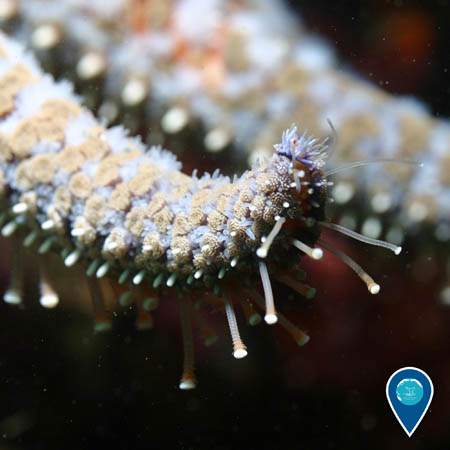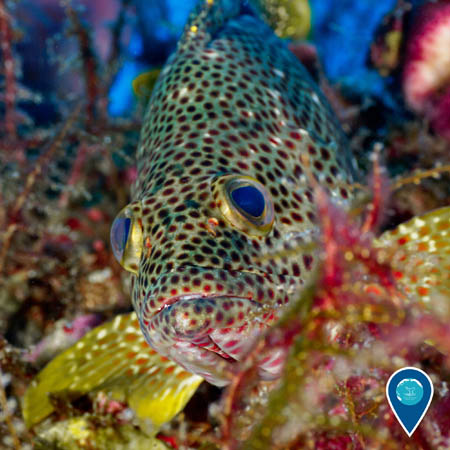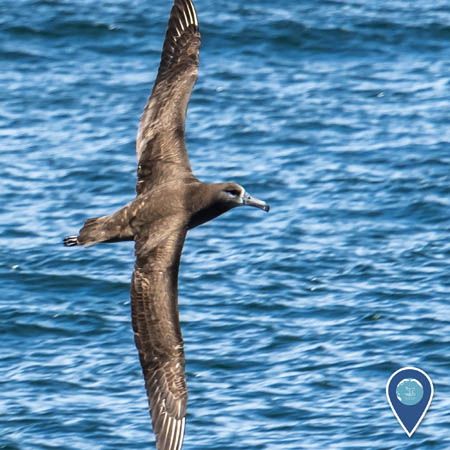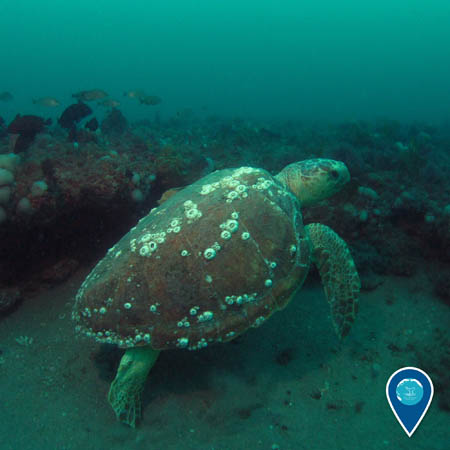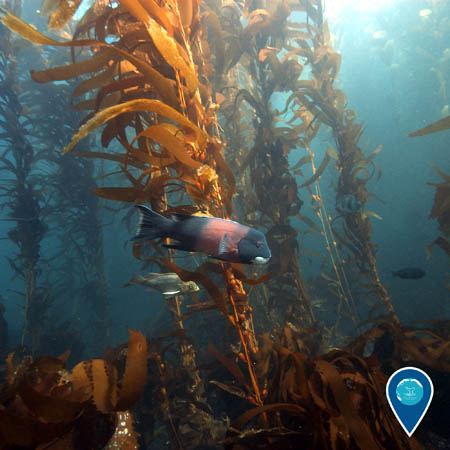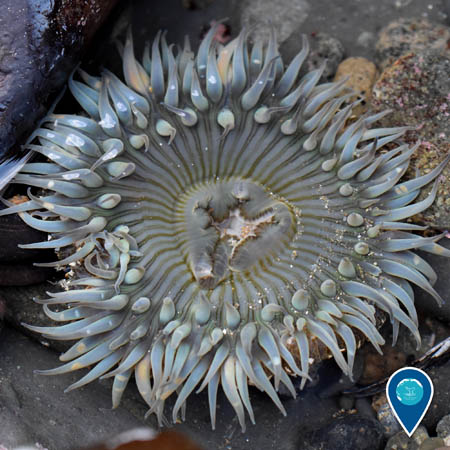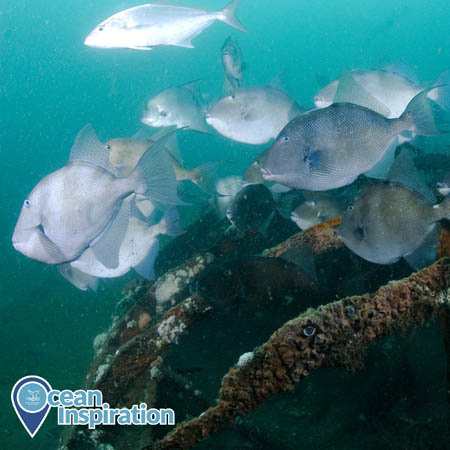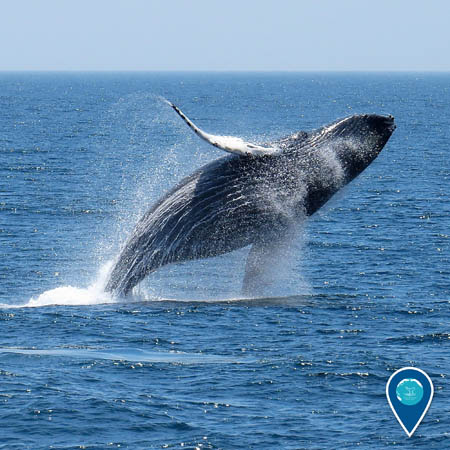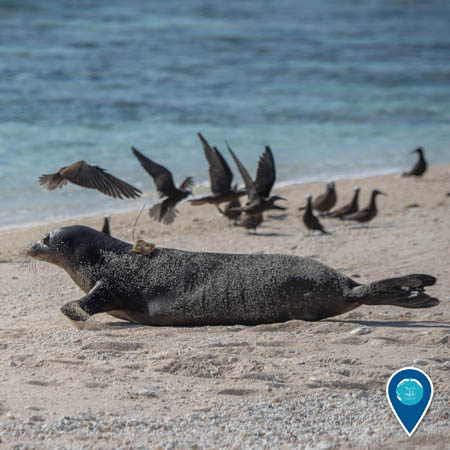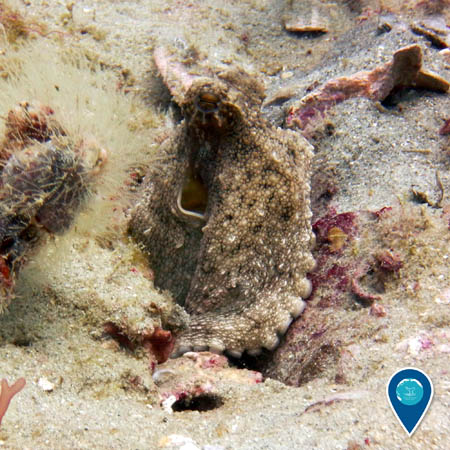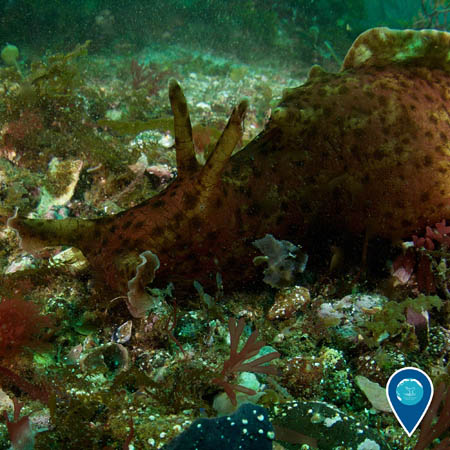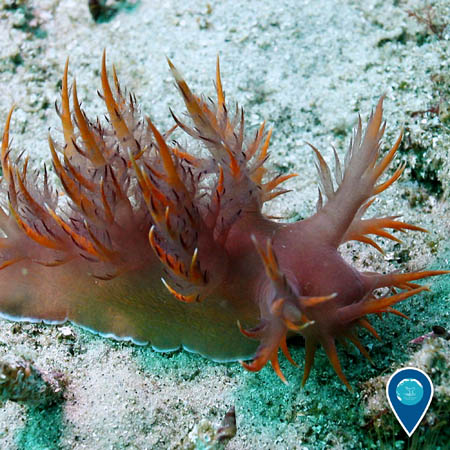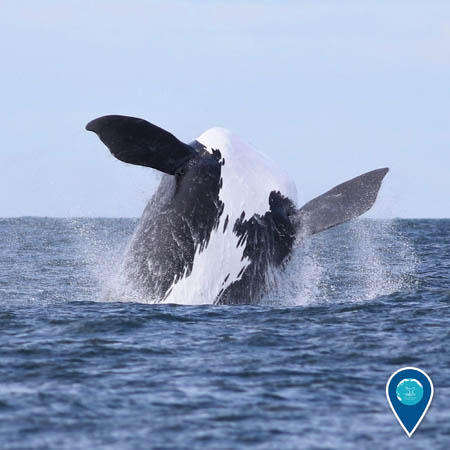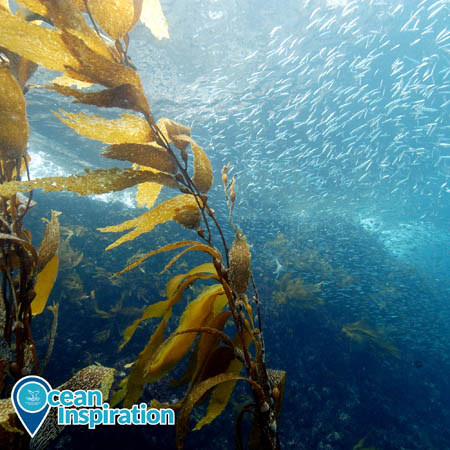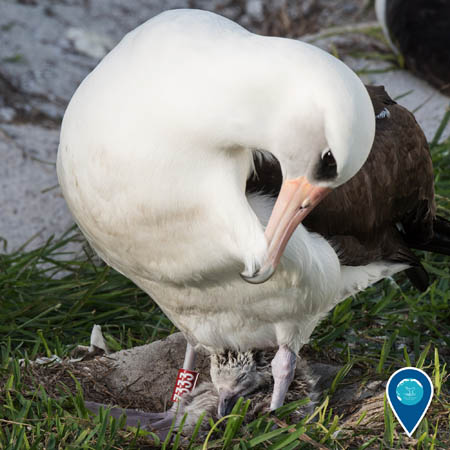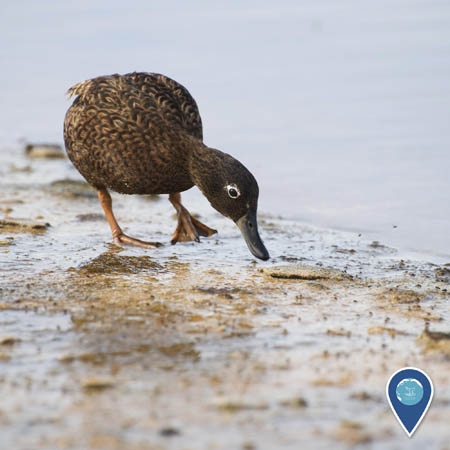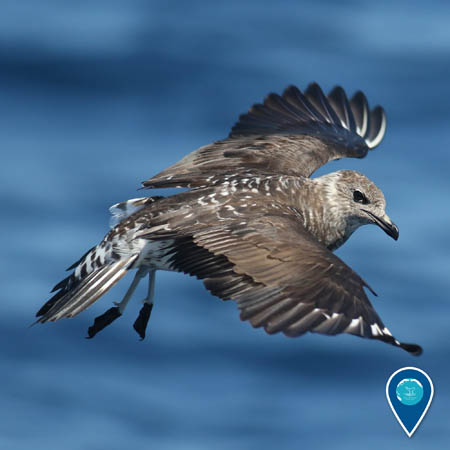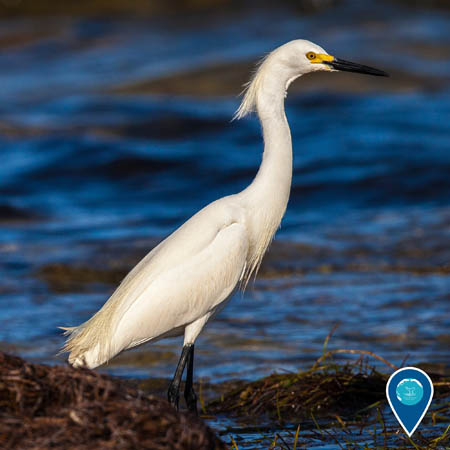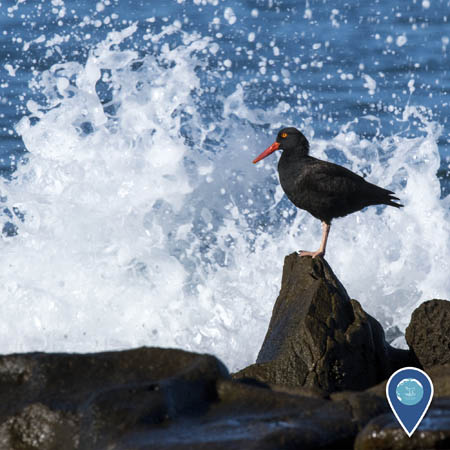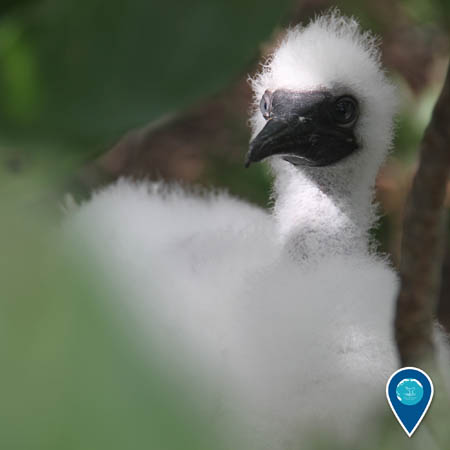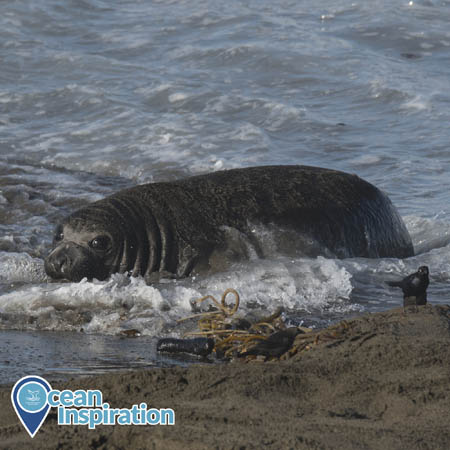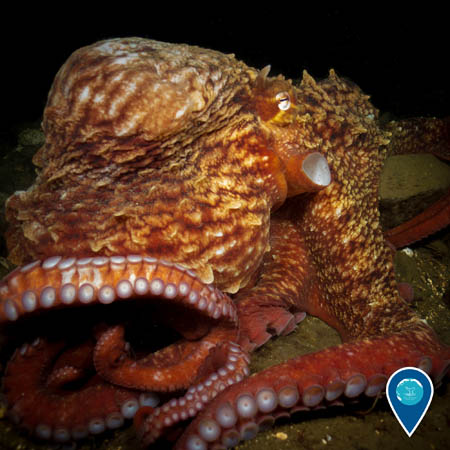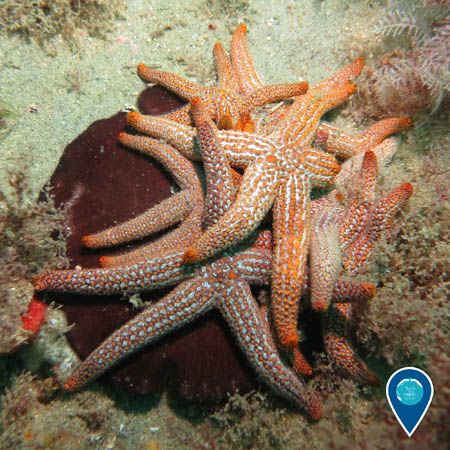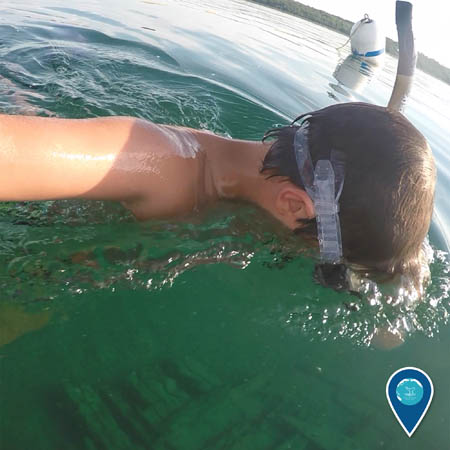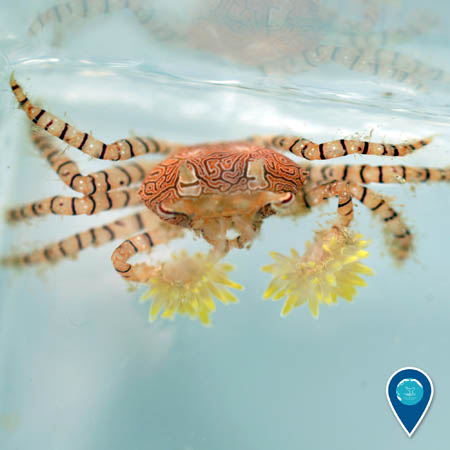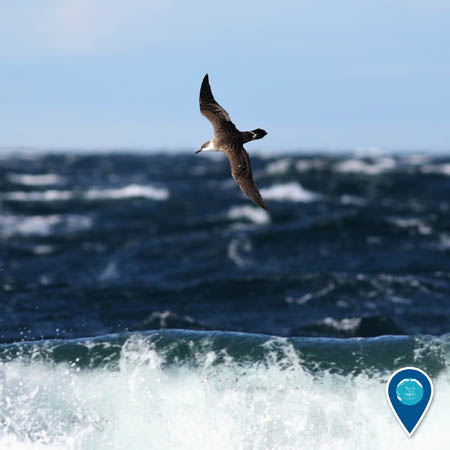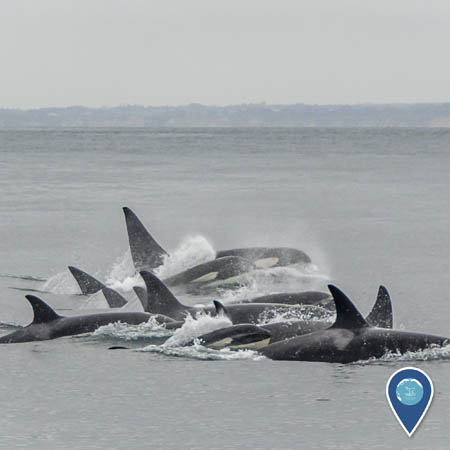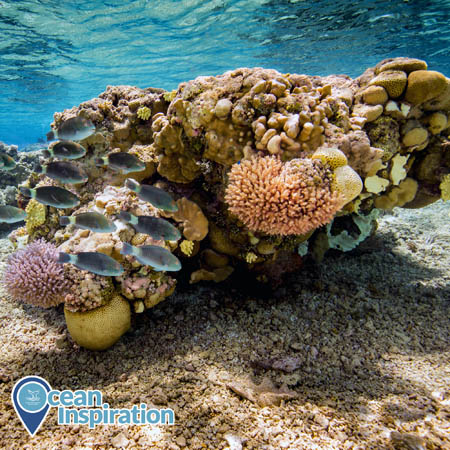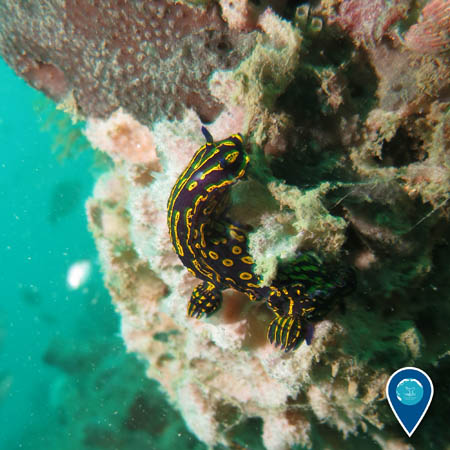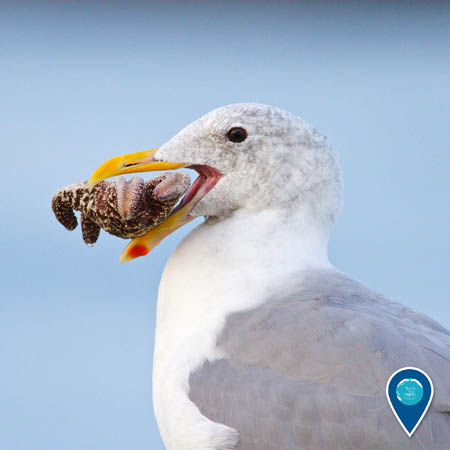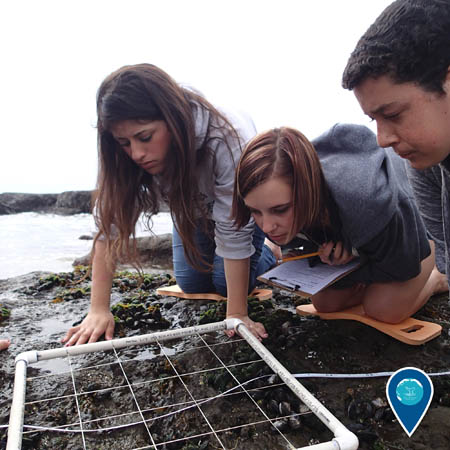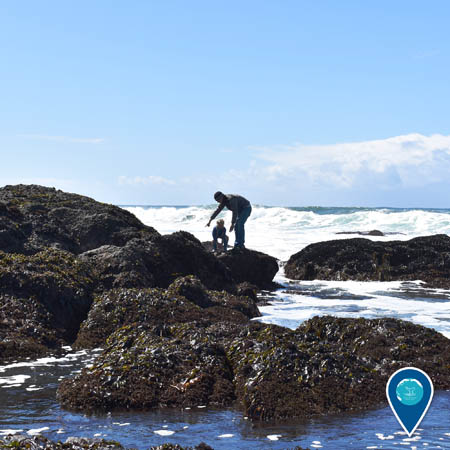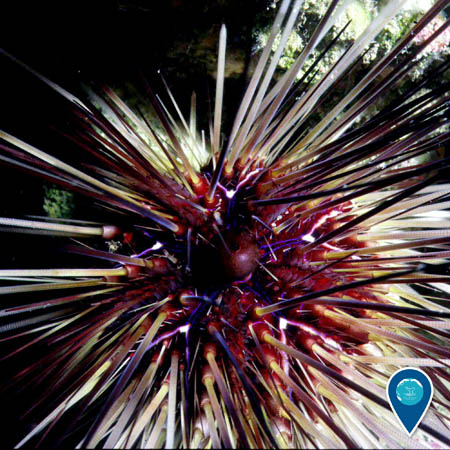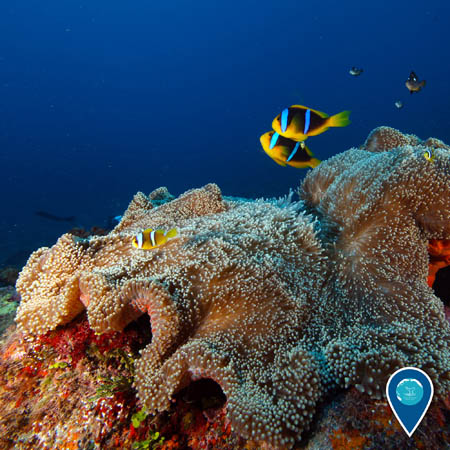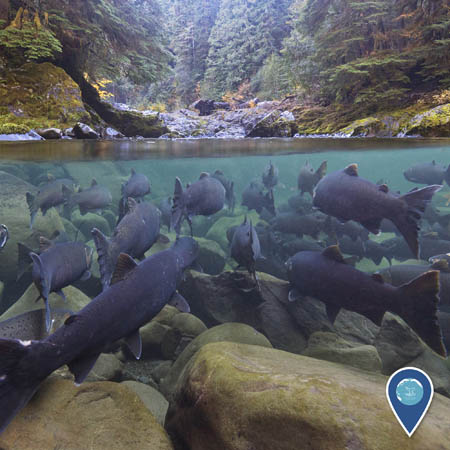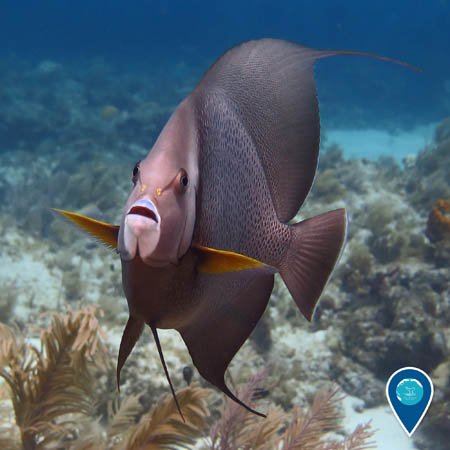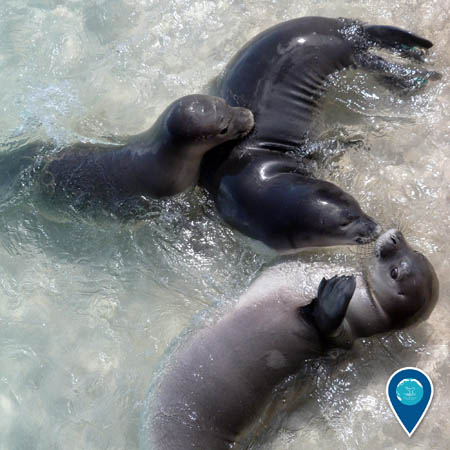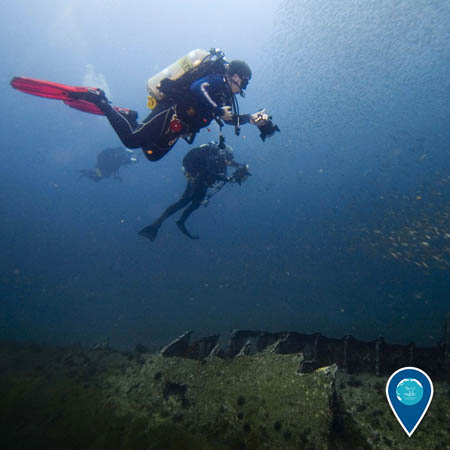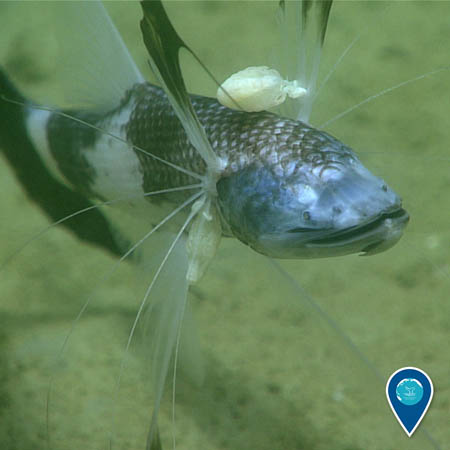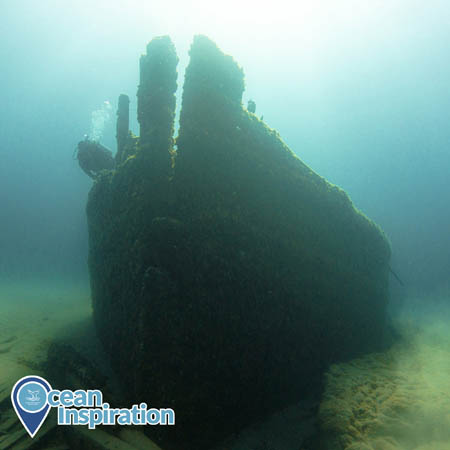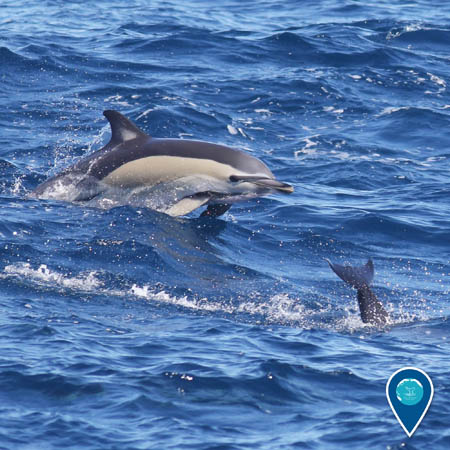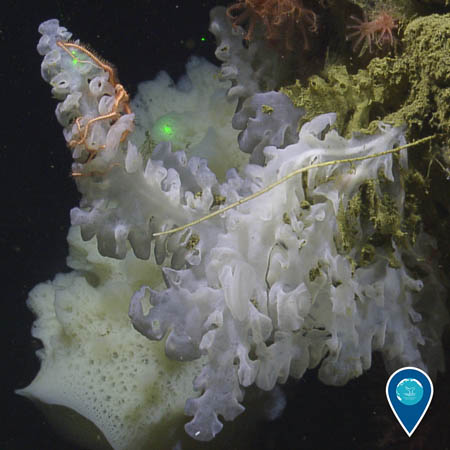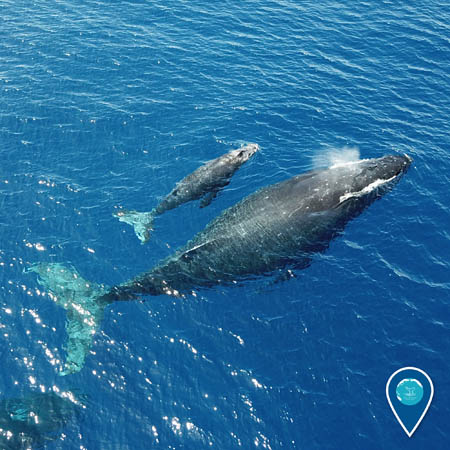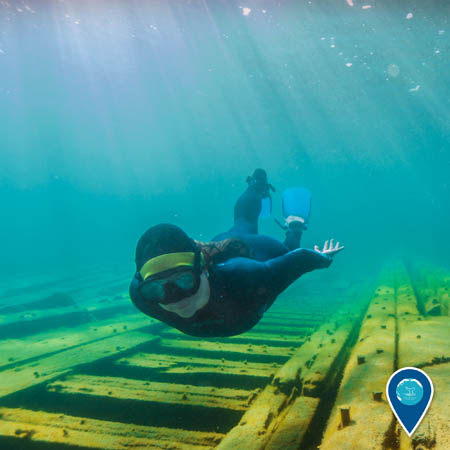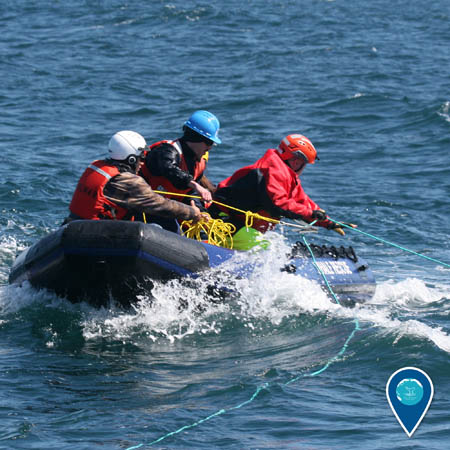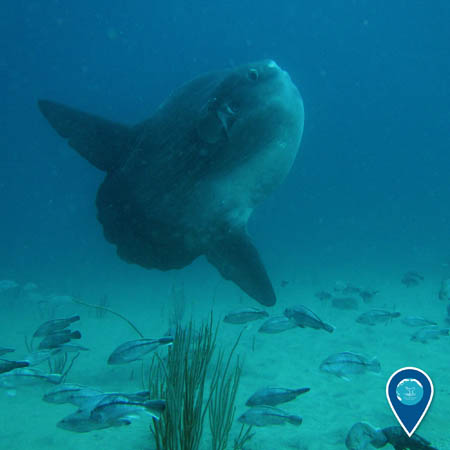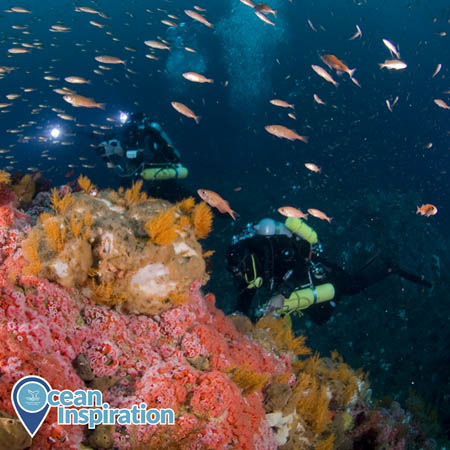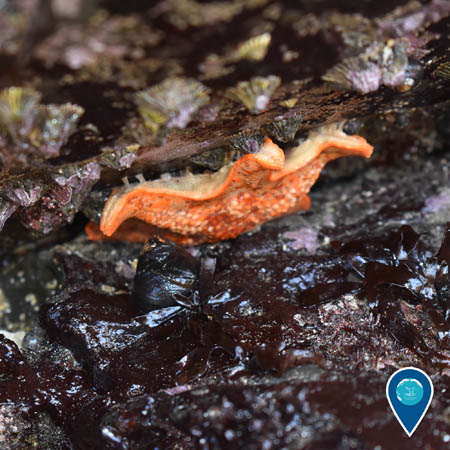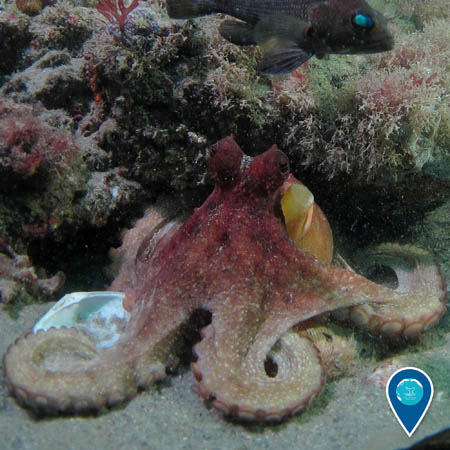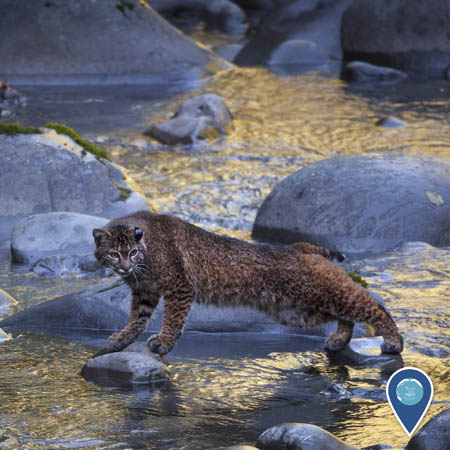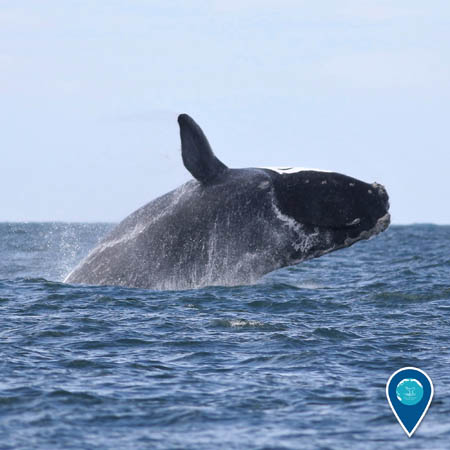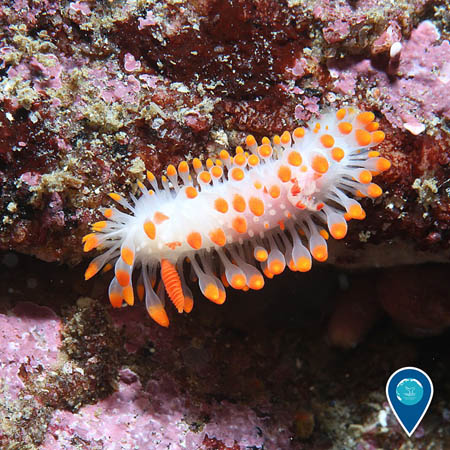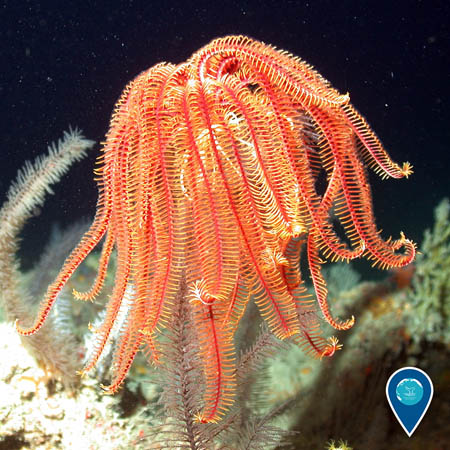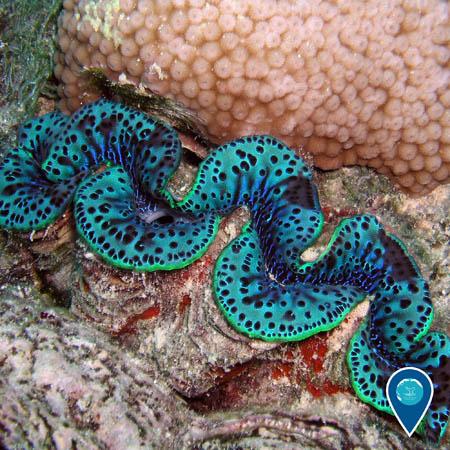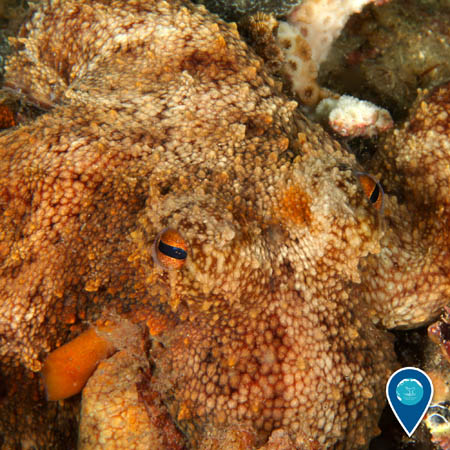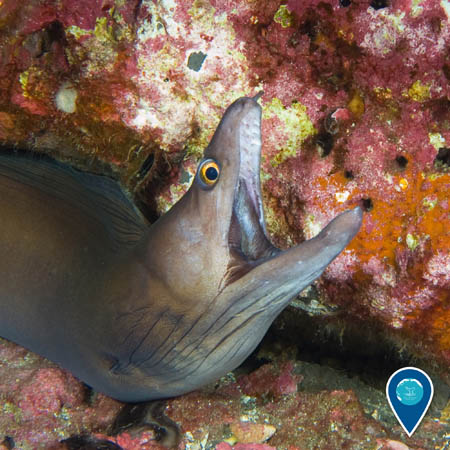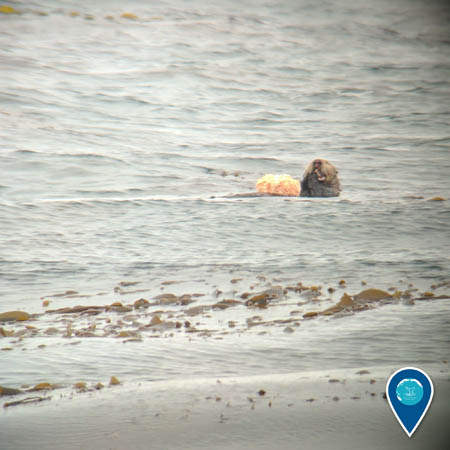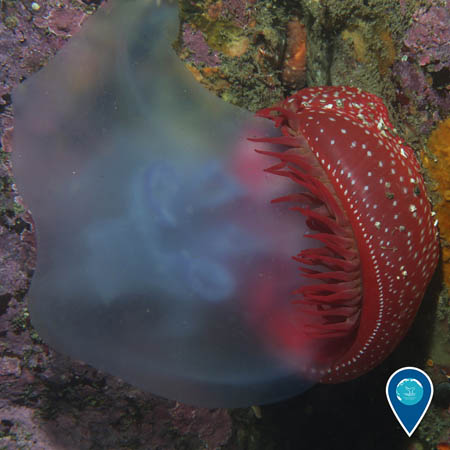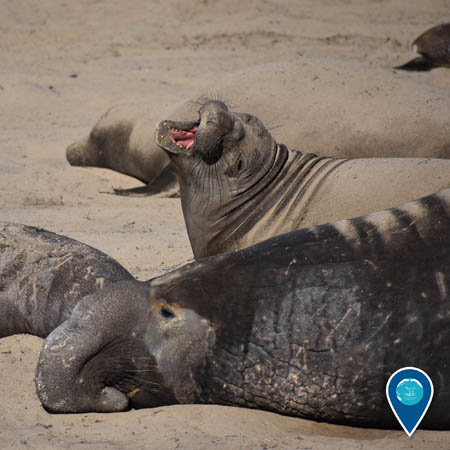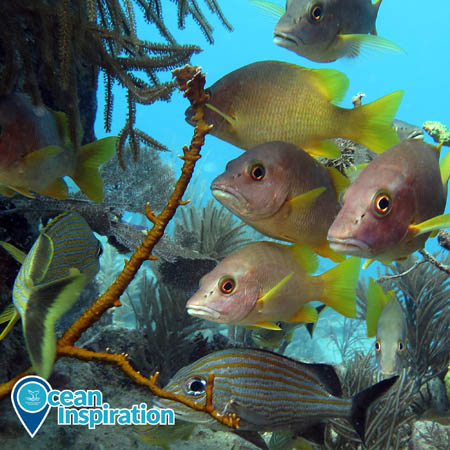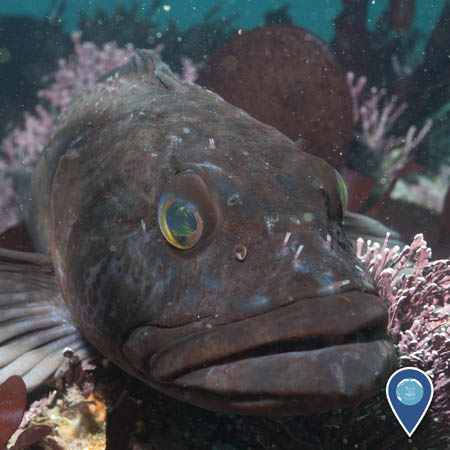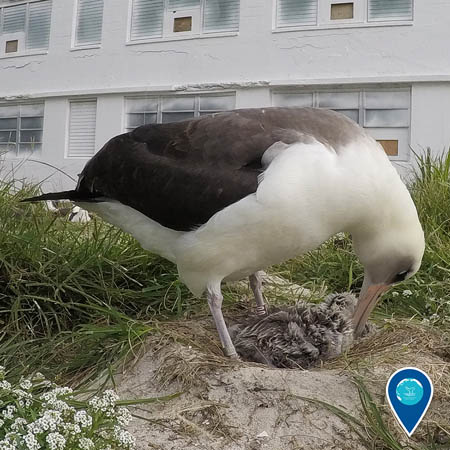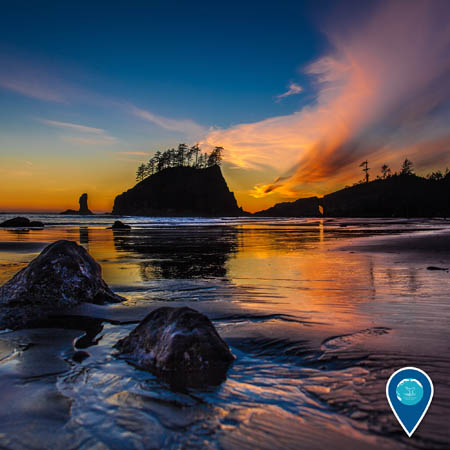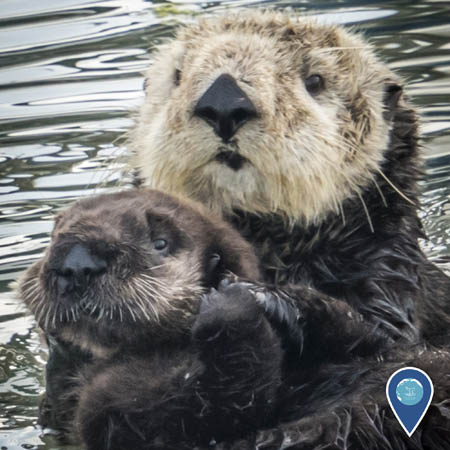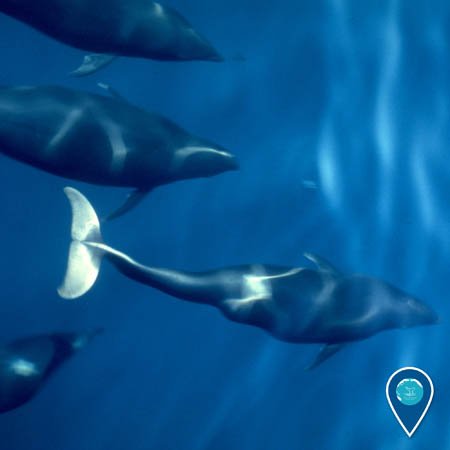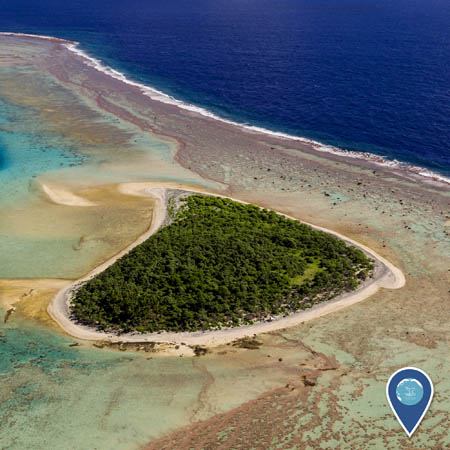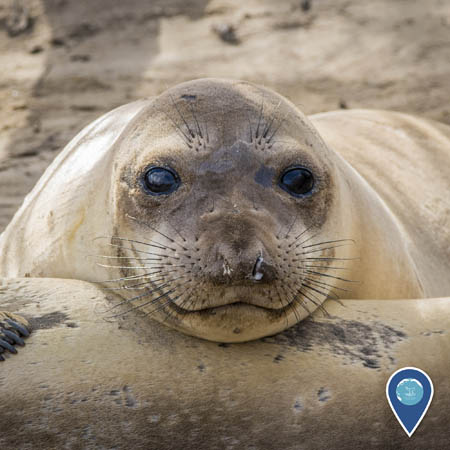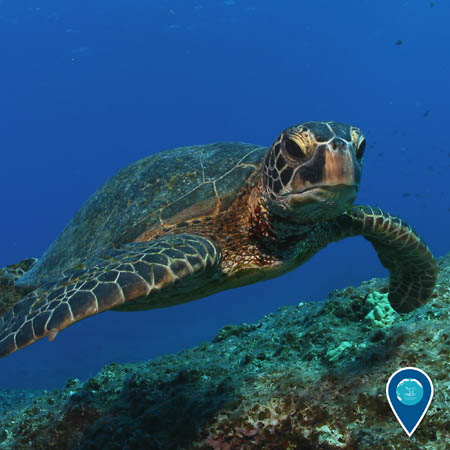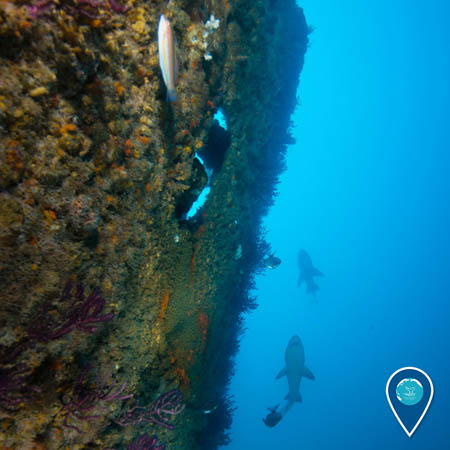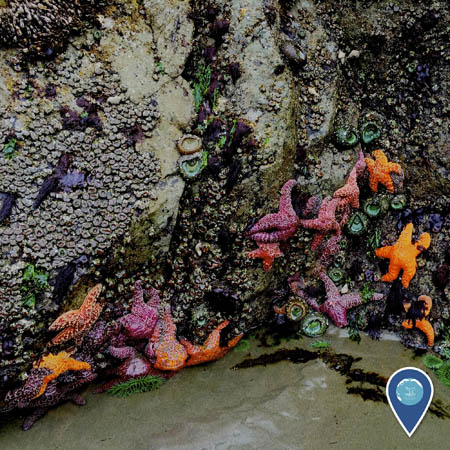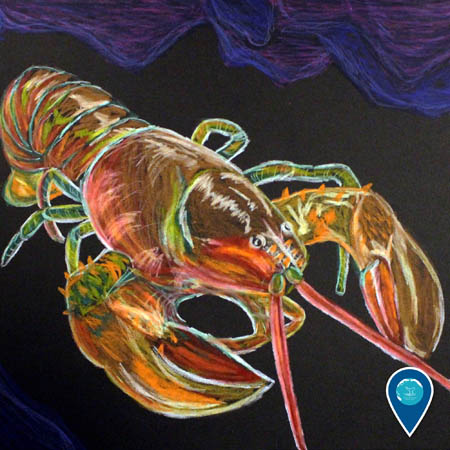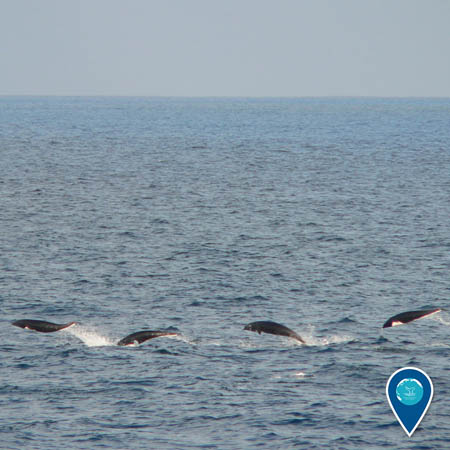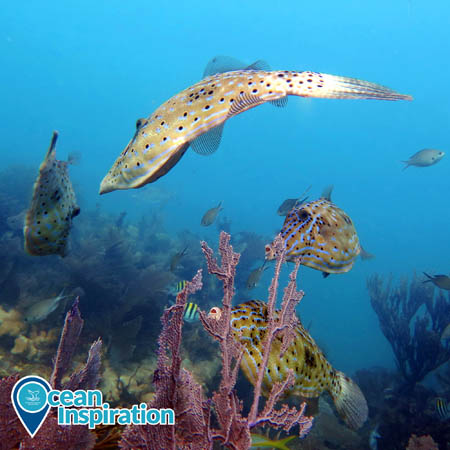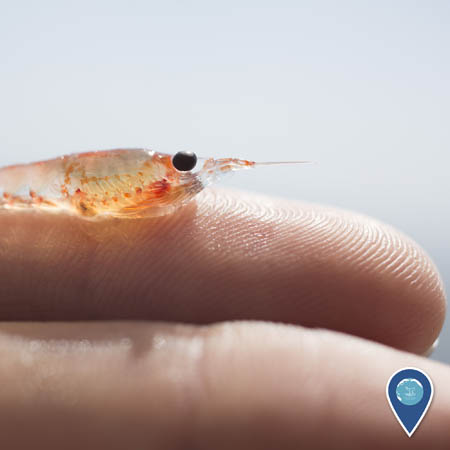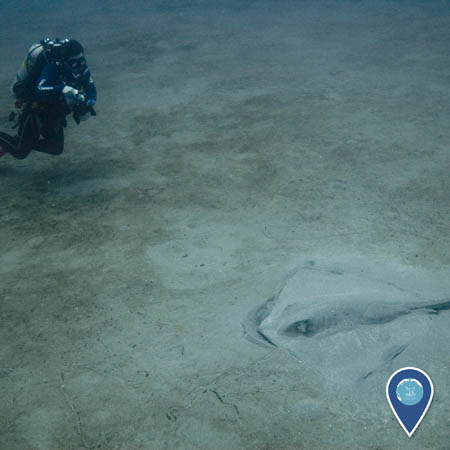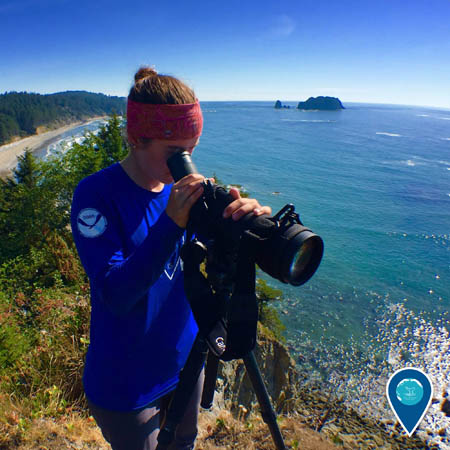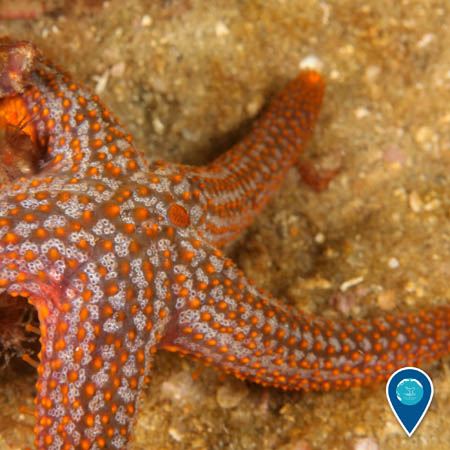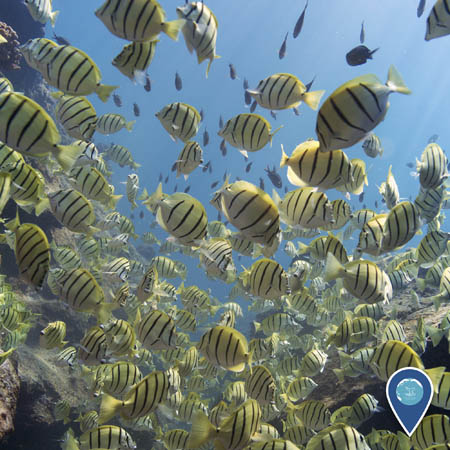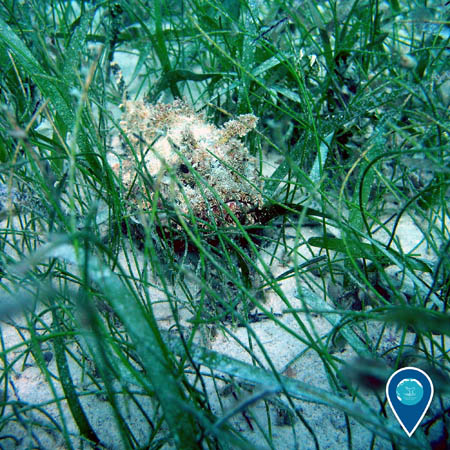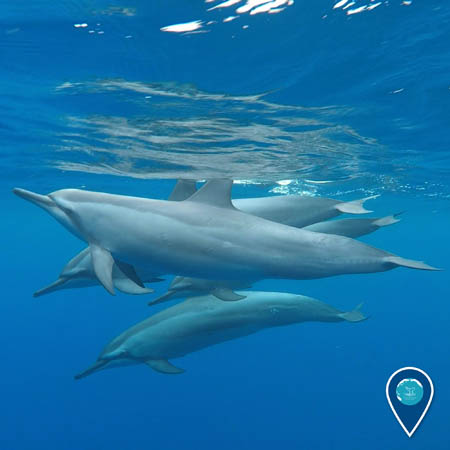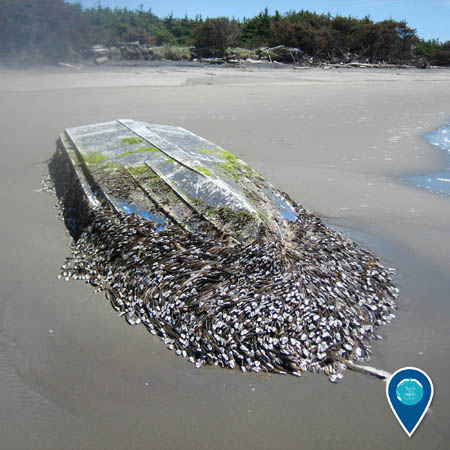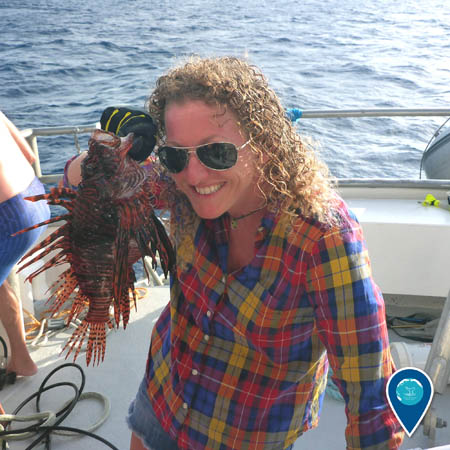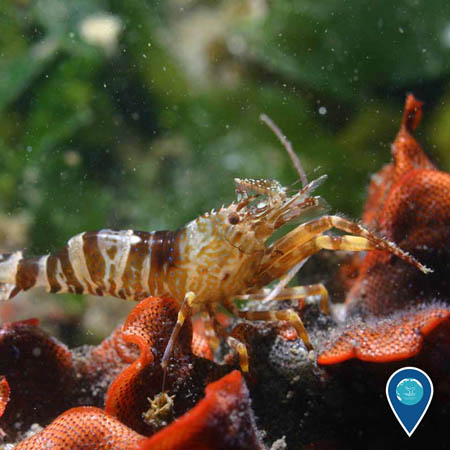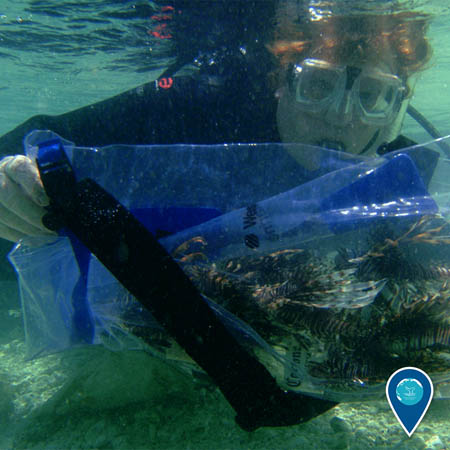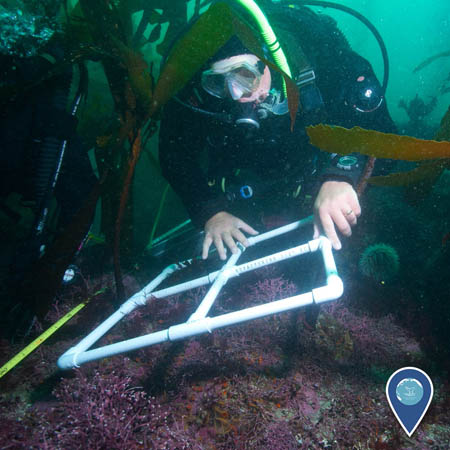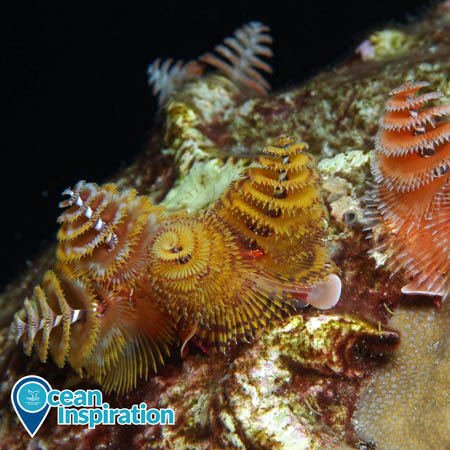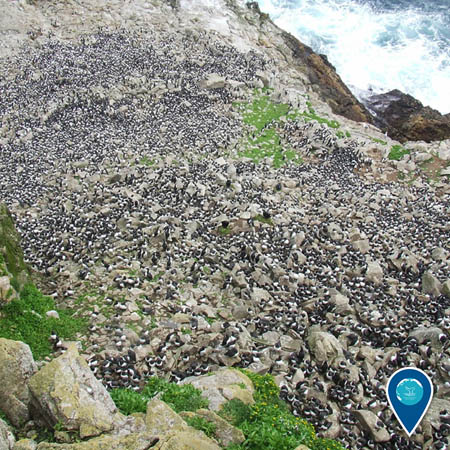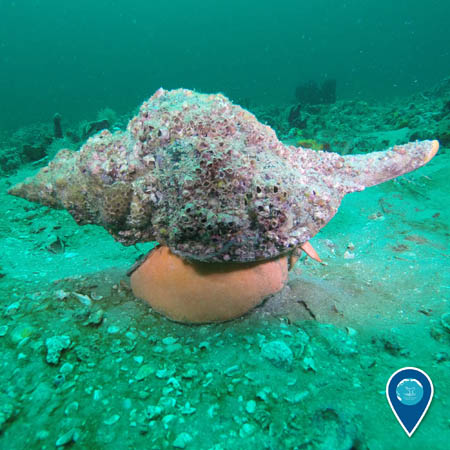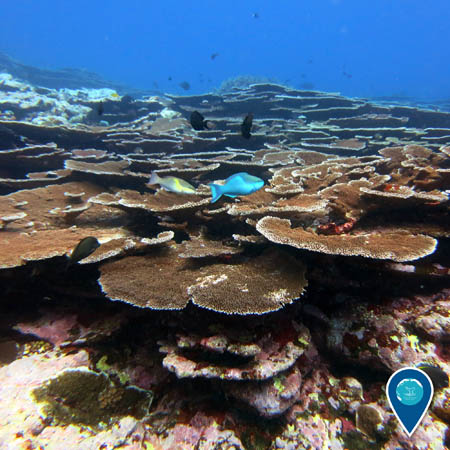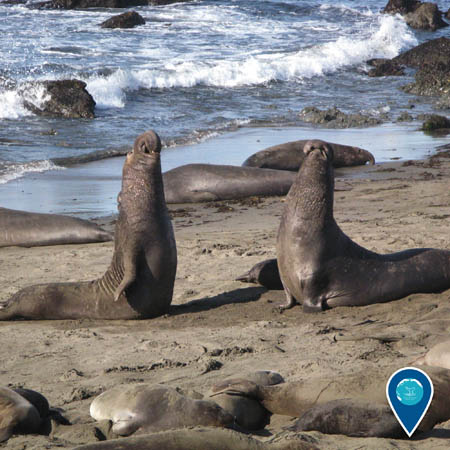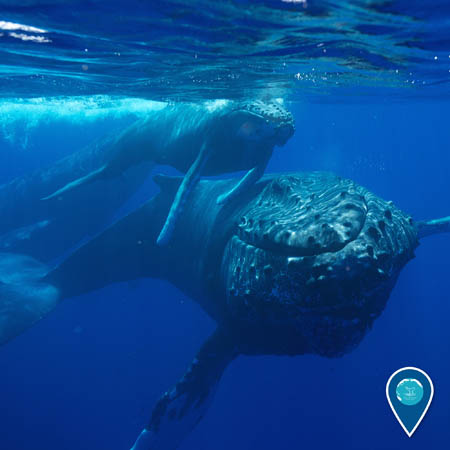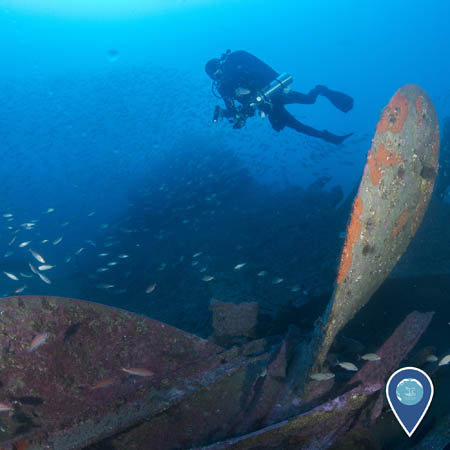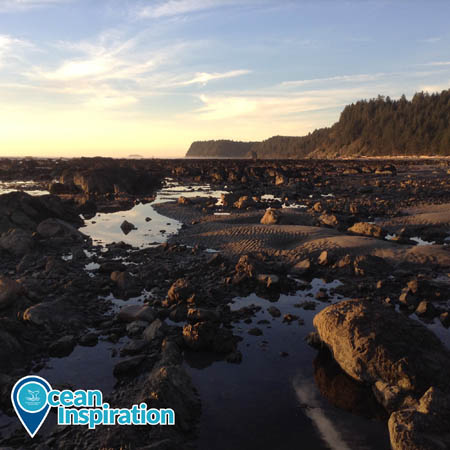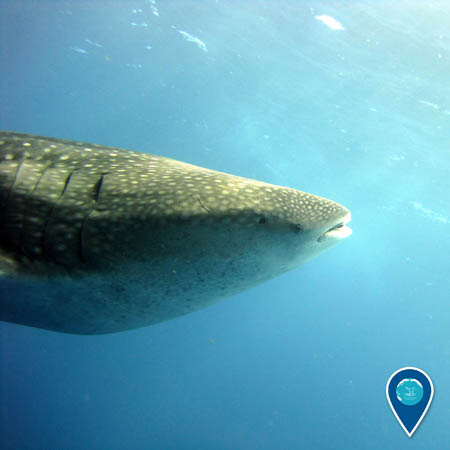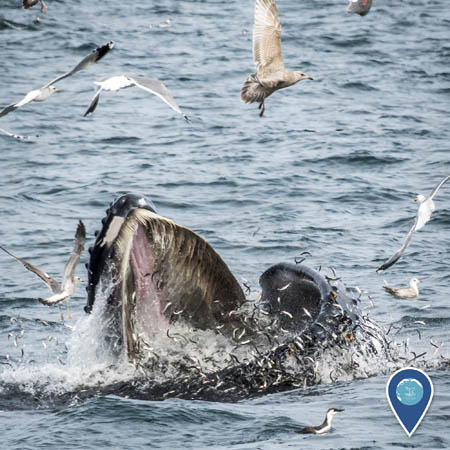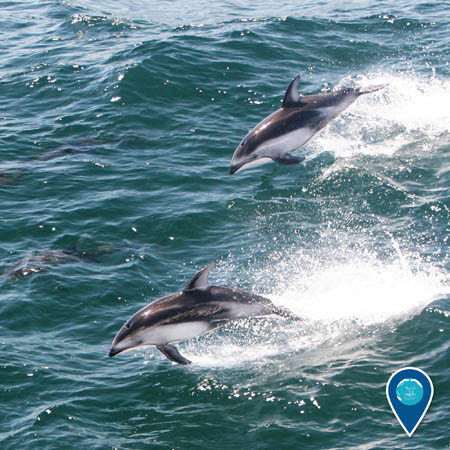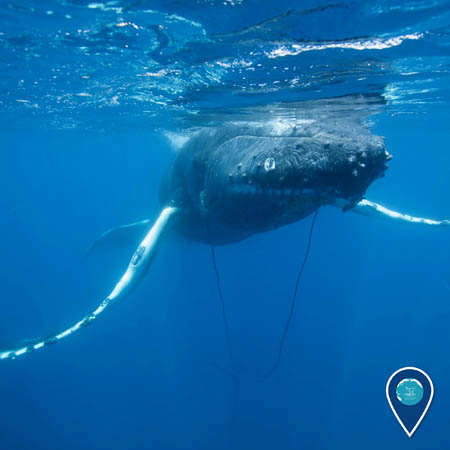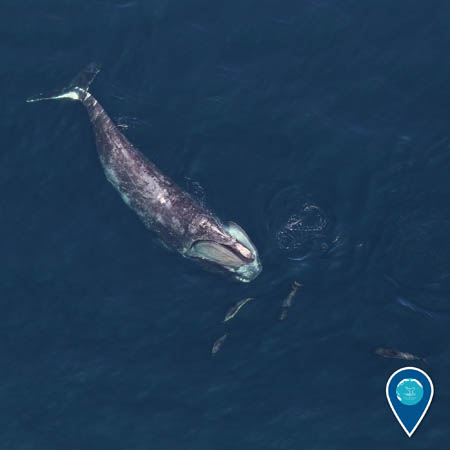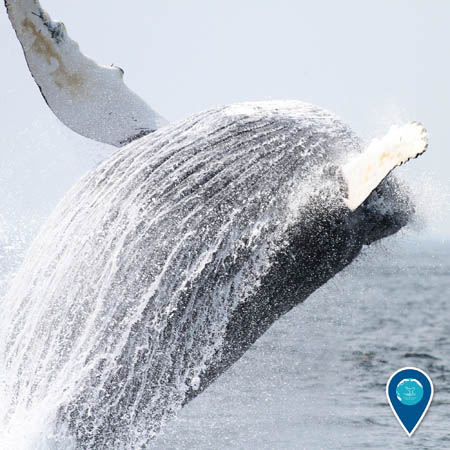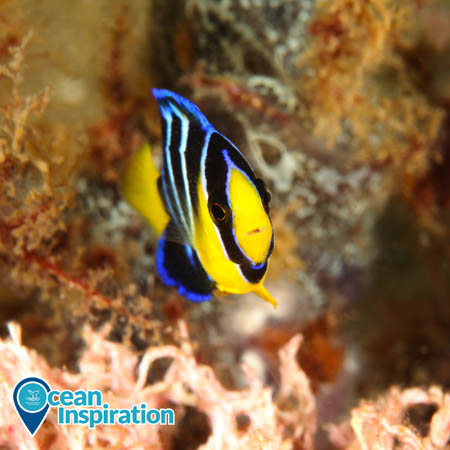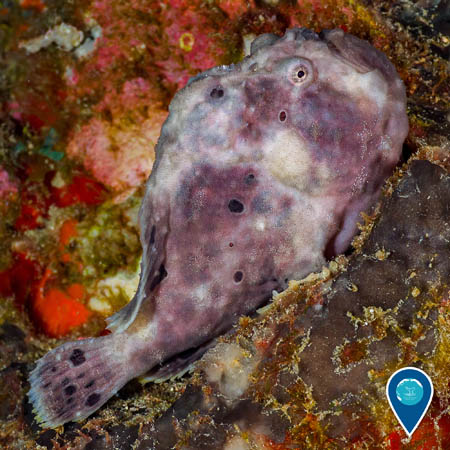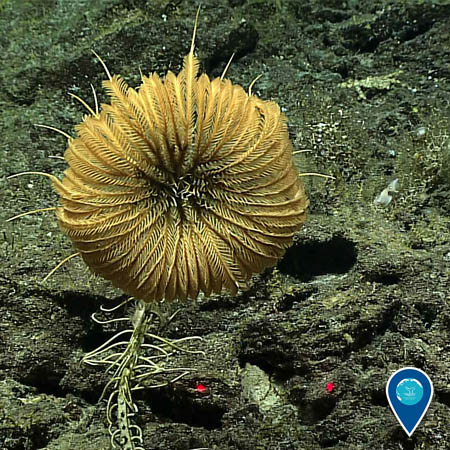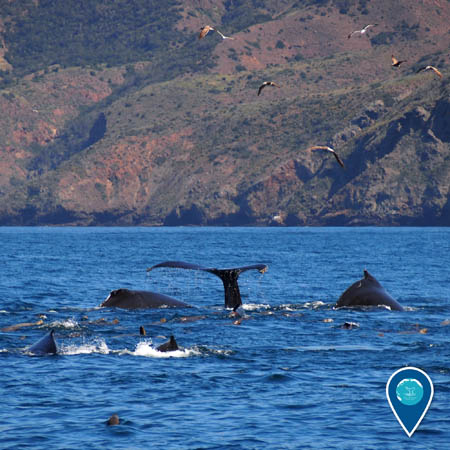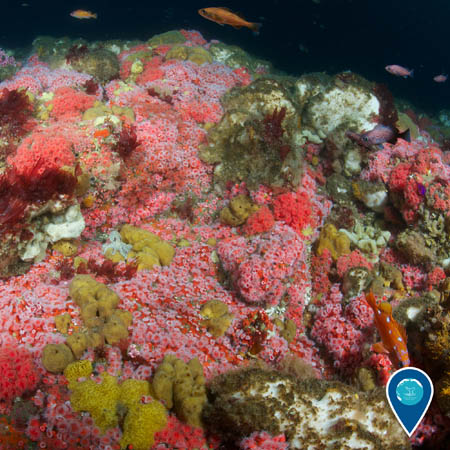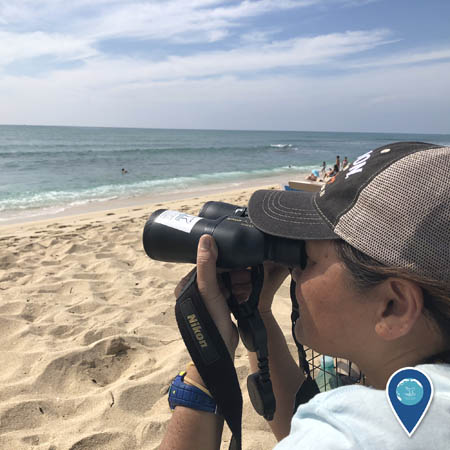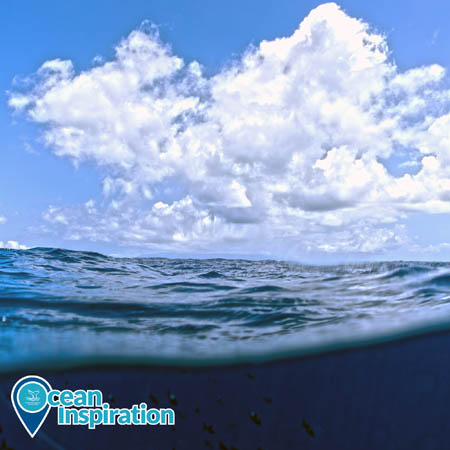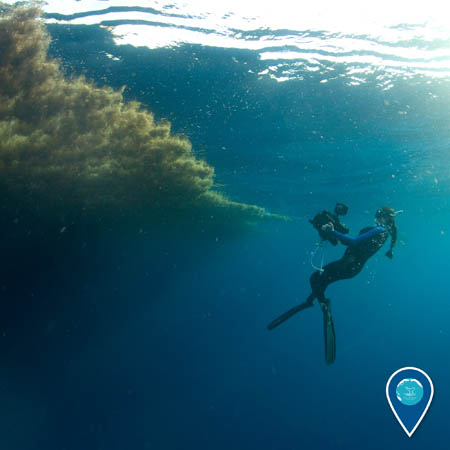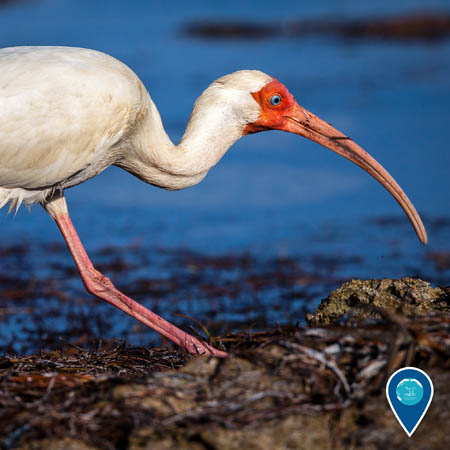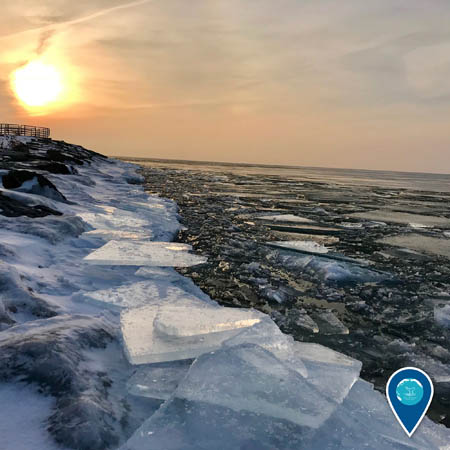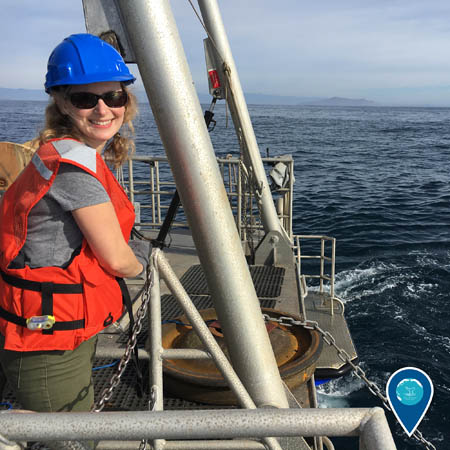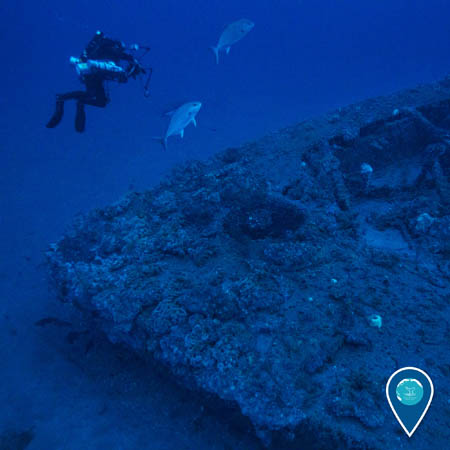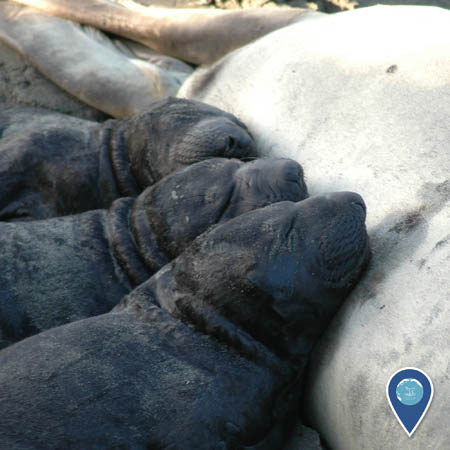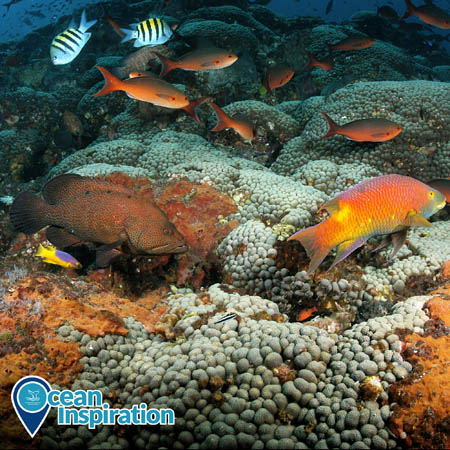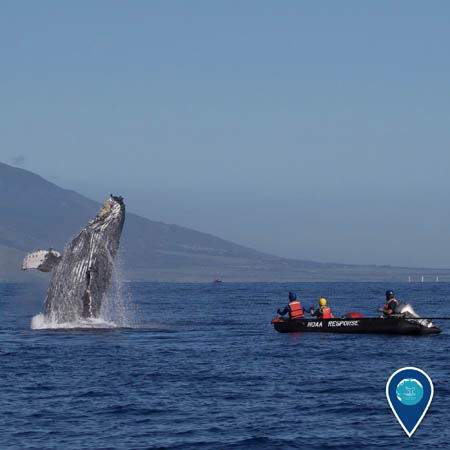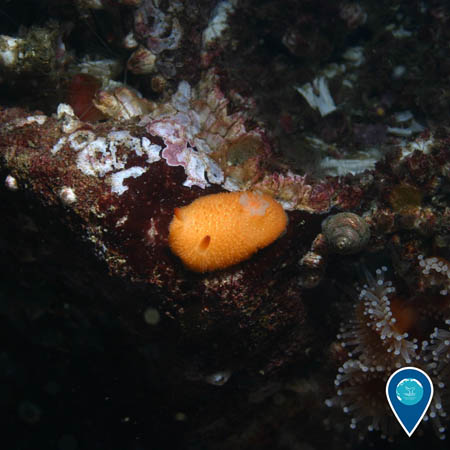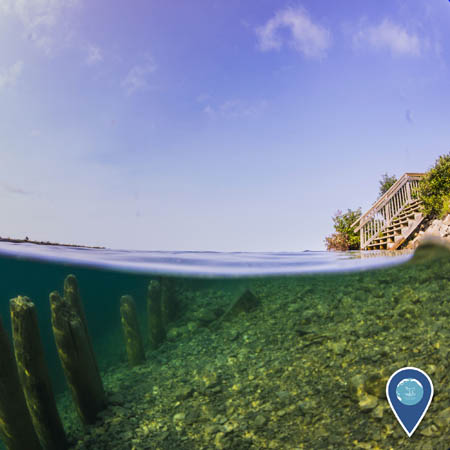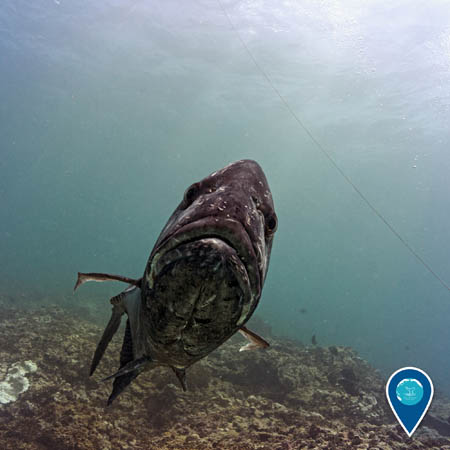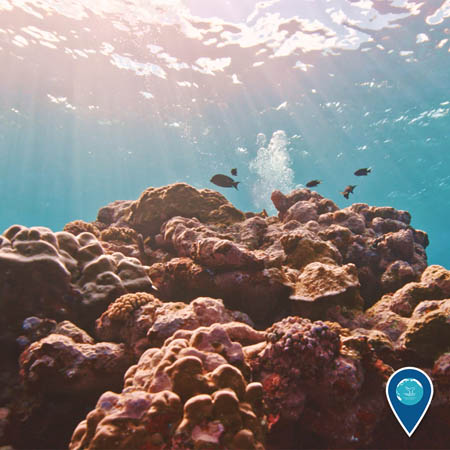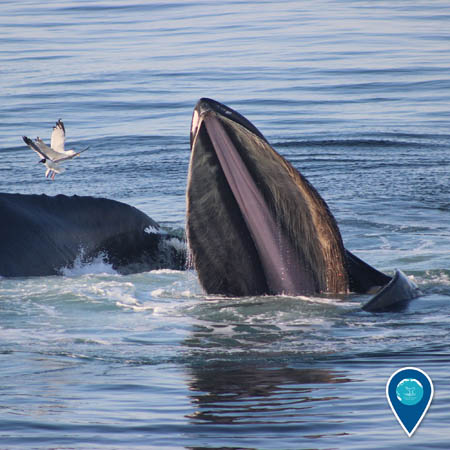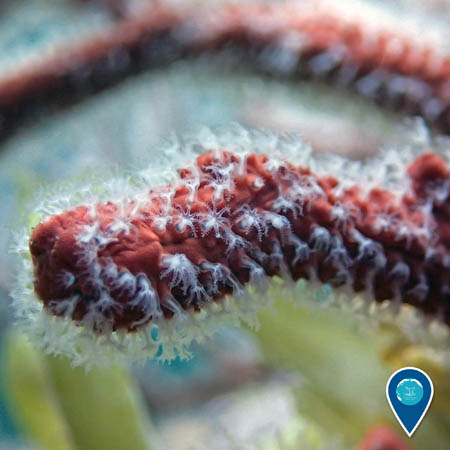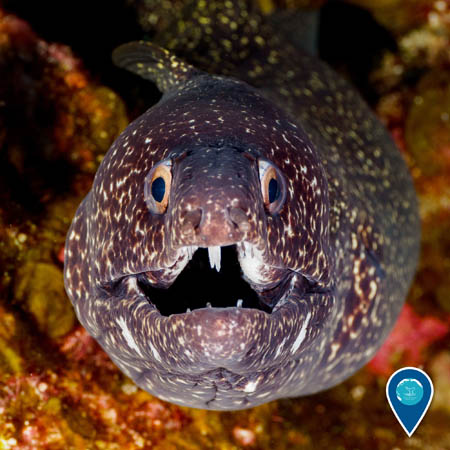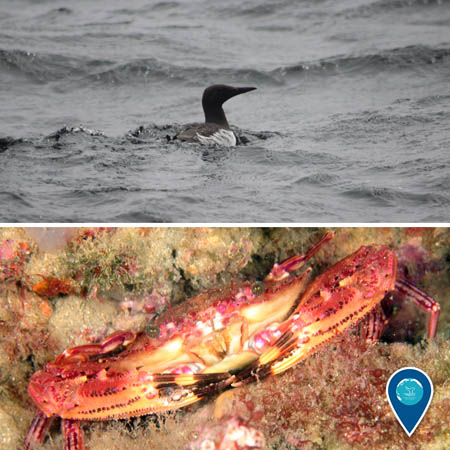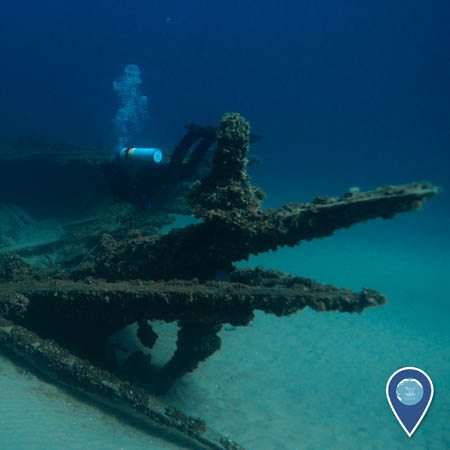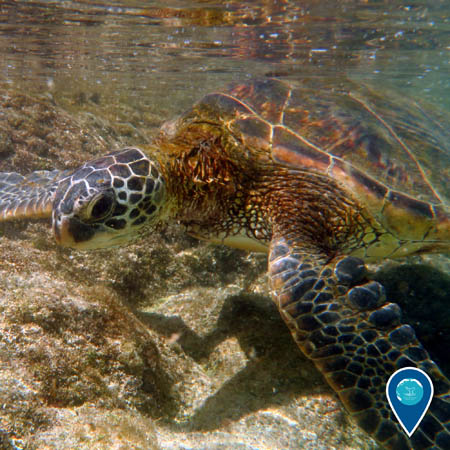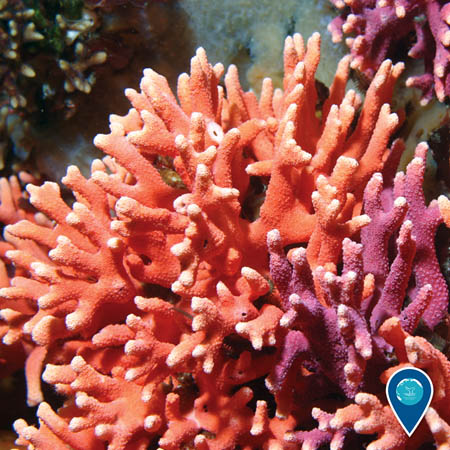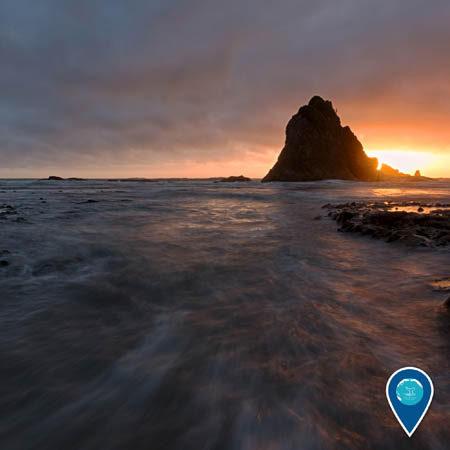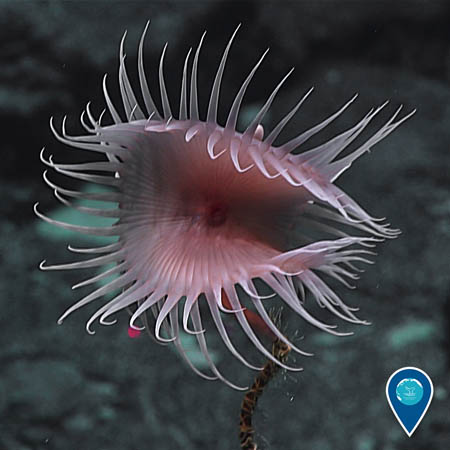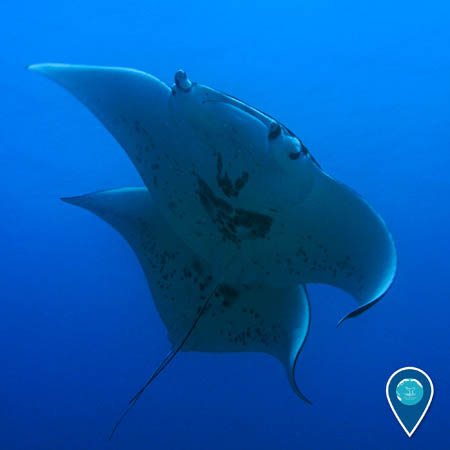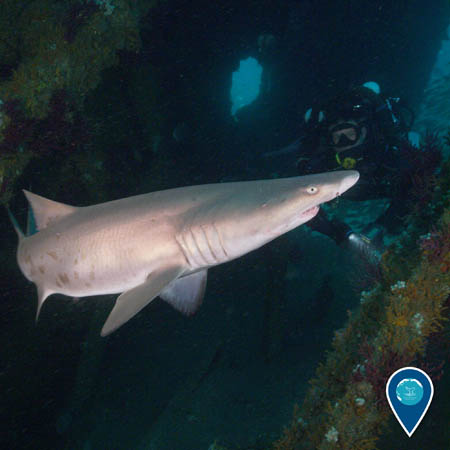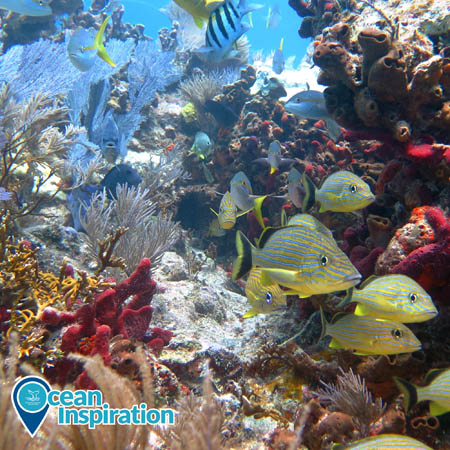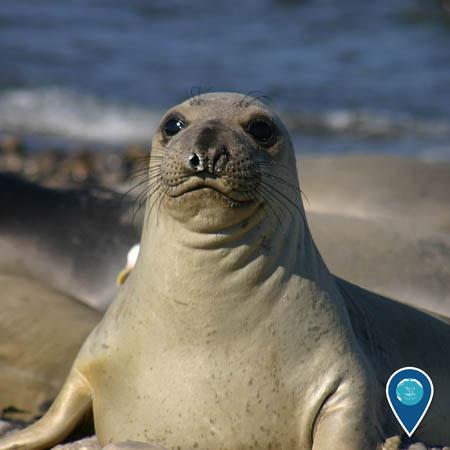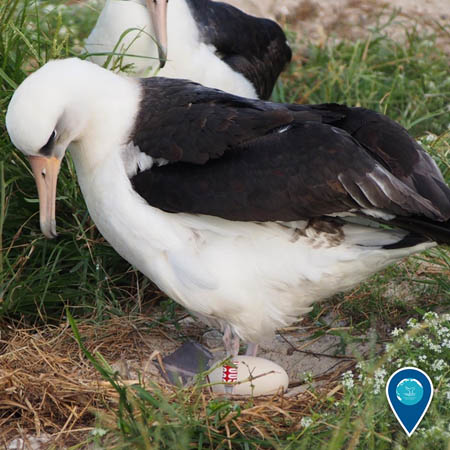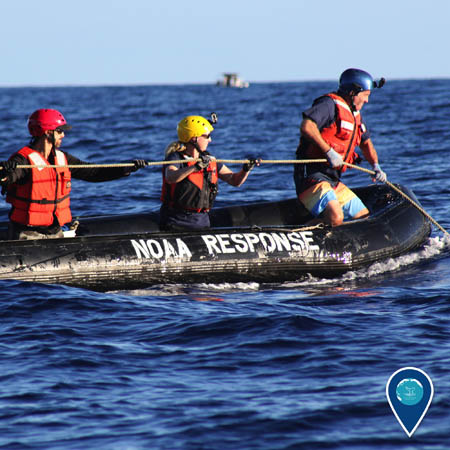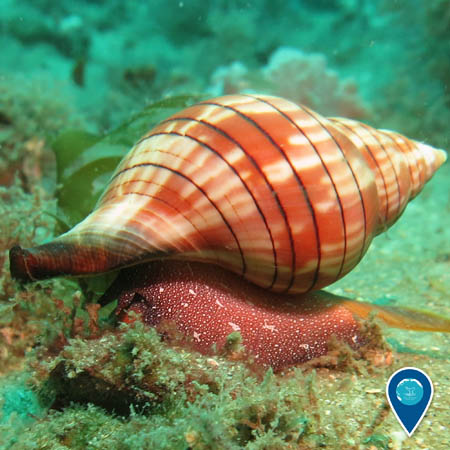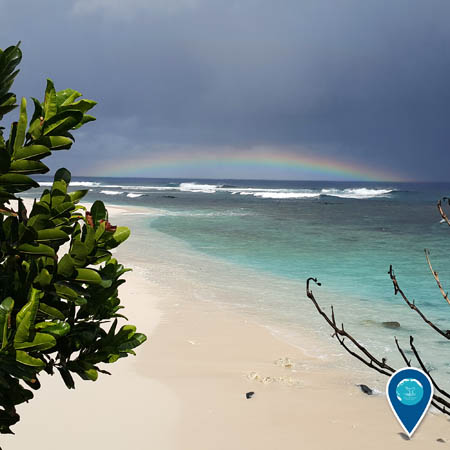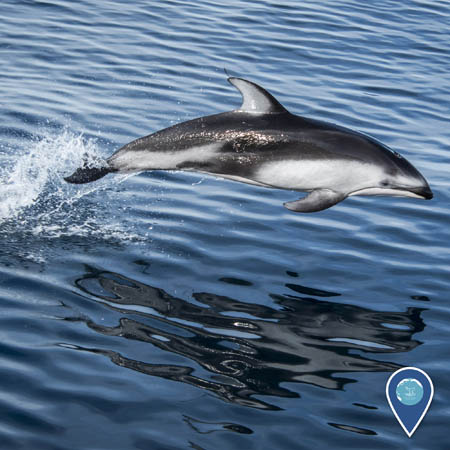Featured Videos
Earth is Blue: Your National Marine Sanctuary System
One Year Anniversary: Dr. Kathryn Sullivan
Featured Photos




Our planet is an ocean planet: Earth Is Blue. The National Marine Sanctuary System protects some of the most iconic underwater places throughout the United States, but we can't do it without you. No matter where you are, the ocean and Great Lakes are in your hands. We hope these images inspire you to help care for our ocean and to spread the word that Earth isn't green – it's blue.

BEHOLD the mighty, emperor helmet snail 😱
The emperor helmet snail (Cassis madagascariensis) is the largest helmet species and also one of the largest gastropods in the world. It is most famously known for its ornate shell resembling a medieval knight's helmet. Found in sandy bottoms of the tropical Western Atlantic, Gulf of Mexico, and Caribbean Sea, they often bury themselves during the day and emerge to hunt at night. They use a long, flexible, tube-like structure (proboscis) to pierce and feed on the soft tissues of echinoderms such as sea stars, sea urchins, and sand dollars.
Photo: Karen Neely (2023 Get Into Your Sanctuary Photo Contest submission)

We love mashed potatoes, and sometimes it's okay to relax and be a couch potato. But, a sea potato? That's a new one!
Stalked tunicates (Boltenia ovifera), commonly referred to as “sea potatoes,” are marine invertebrates that might be mistaken for plants due to their stationary appearance. Found in Arctic and North Atlantic waters, these animals belong to the Phylum Chordata, which makes them a primitive relative of vertebrates. Stalked tunicates, like other types of tunicates or “sea squirts” are filter feeders that pull water through their body (tunic) using a system of inhalant and exhalant siphons. This particular tunicate species is secured to the bottom of the sea by means of a long stalk.
Photo: Kevin McCarthy (2022 Get Into Your Sanctuary Photo Contest submission)

Martin Luther King, Jr. Day is not just a day off from school or work, but a day to give back.
Cleaning up your local shoreline or even just your neighborhood can help prevent trash from becoming marine debris and can help to create a healthy ocean that we can all enjoy. Pictured here is debris cleaned up by the Marine Debris team from the shores of Midway Atoll cleaning the waters of Papahānaumokuākea Marine National Monument!

"Behold the majestic whale shark. While these magnificent creatures are endangered, we are privileged to witness their grace and beauty in the wild worldwide. Let's cherish every encounter as a reminder of our responsibility to protect and conserve their precious habitat." -Lawrence Alex Wu
Congratulations to Lawrence Alex Wu for winning 2nd place in the Sanctuaries Around the World category of our photo contest! 📸

There's nothing like a family game night! How have you spent the holiday season with your family and friends?
Congratulations to the 2nd place winner of the Sanctuaries at Home category of our photo contest- Tina Morrison! 📸

This special place near NOAA's Greater Farallones and Cordell Bank National Marine Sanctuaries is called Bowling Ball Beach, can you guess why?
Congratulations to the 2nd place Sanctuary Views winner of our photo contest, Martin McClure! 🌅

Have you ever experienced a clear starry night in nature? 🌌 National marine sanctuaries provide great stargazing spots!
Congratulations to the 2nd place winner of the Sanctuary Recreation category, Daniel Eidsmoe for sharing his night under the stars in NOAA Florida Keys National Marine Sanctuary.

"Our marine habitats and all the native species that live in these sanctuaries are worth protecting." -Jean Zuo

This year, we introduced the "Sanctuaries Around the World" category, where photographers had the opportunity to share their connection to the ocean from across the globe 🌎
Our 3rd place winner, Kayvon Malek, shares his connection to species of the Antarctic Peninsula! In this photo, gentoo penguins dive off a piece of ice into the frigid, but extremely rich waters of Antarctica. Congratulations Kayvon! 🎉

Learning and play can go hand-in-hand. In this photo, an aspiring marine biologist practices measuring and counting toy "sea turtle hatchlings" and "eggs" at home.
Congratulations to the 3rd place winner of the Sanctuaries at Home category of our photo contest- Jenn Fletcher! 🎉 Thank you for sharing how you connect with national marine sanctuaries from home 🏠

Did you know this shipwreck is located only five feet below the surface of Lake Huron?
This angler and paddle boarder are checking out the remains of the wooden schooner Albany. Albany has rested on the bottom of Lake Huron since it ran aground in 1853. Today, it is a popular destination for snorkelers and paddlers.
We want to congratulate and thank our 3rd place Sanctuary Recreation winner, Bryan Dort, for sharing what it means to #RecreateResponsibly in NOAA Thunder Bay National Marine Sanctuary.

Congratulations to the 3rd place Sanctuary Life winner of our photo contest, Douglas Croft, for capturing this action shot of two elephant seals fighting in Greater Farallones National Marine Sanctuary.
Each year between December and February, elephant seals come to shore to breed. Males – like the two seen here – arrive first and fight for territory on the beach in quick, aggressive battles. Though males may experience minor injury as a result of these battles, severe harm or lasting damage rarely occur.
Following establishment of territories, females arrive and the mating season ensues. Each pregnant female then gives birth to a single pup, who she’ll nurse for about a month before returning to sea. Our National Marine Sanctuary System really is full of life!

🥁 Drum roll, please! 🥁
We would like to introduce you to the winners of the 2023 #GetIntoYourSanctuary Photo Contest.
Sanctuary Life
- Douglas Hoffman in Hawaiian Islands Humpback Whale National Marine Sanctuary
- Jean Zuo in NOAA's Monterey Bay National Marine Sanctuary
- Douglas Croft in NOAA's Greater Farallones and Cordell Bank National Marine Sanctuaries
Sanctuary Recreation
- Chuck Graham in NOAA Channel Islands National Marine Sanctuary
- Daniel Eidsmoe in NOAA Florida Keys National Marine Sanctuary
- Bryan Dort in NOAA Thunder Bay National Marine Sanctuary
Sanctuary Views
- Bruce Sudweeks in NOAA's Monterey Bay National Marine Sanctuary
- Martin McClure in NOAA's Greater Farallones and Cordell Bank National Marine Sanctuaries
- Courtney Stanford in NOAA Olympic Coast National Marine Sanctuary
Sanctuaries at Home
- Laurie Santoro
- Tina Morrison
- Jenn Fletcher
Sanctuaries Around the World
- María Rodríguez-Salinas
- Lawrence Alex Wu
- Kayvon Malek
Congratulations to all the outstanding photographers who entered our 2023 Get Into Your Sanctuary Photo Contest. Don’t forget to check out the winners and honorable mentions on our results page.
Stay tuned over the next few weeks as we feature each winner in our #EarthIsBlue campaign!

🥁 Drum roll, please! 🥁
We would like to introduce you to the winners of the 2023 #GetIntoYourSanctuary Photo Contest.
Sanctuary Life
- Douglas Hoffman in Hawaiian Islands Humpback Whale National Marine Sanctuary
- Jean Zuo in NOAA's Monterey Bay National Marine Sanctuary
- Douglas Croft in NOAA's Greater Farallones and Cordell Bank National Marine Sanctuaries
Sanctuary Recreation
- Chuck Graham in NOAA Channel Islands National Marine Sanctuary
- Daniel Eidsmoe in NOAA Florida Keys National Marine Sanctuary
- Bryan Dort in NOAA Thunder Bay National Marine Sanctuary
Sanctuary Views
- Bruce Sudweeks in NOAA's Monterey Bay National Marine Sanctuary
- Martin McClure in NOAA's Greater Farallones and Cordell Bank National Marine Sanctuaries
- Courtney Stanford in NOAA Olympic Coast National Marine Sanctuary
Sanctuaries at Home
- Laurie Santoro
- Tina Morrison
- Jenn Fletcher
Sanctuaries Around the World
- María Rodríguez-Salinas
- Lawrence Alex Wu
- Kayvon Malek
Congratulations to all the outstanding photographers who entered our 2023 Get Into Your Sanctuary Photo Contest. Don’t forget to check out the winners and honorable mentions on our results page.
Stay tuned over the next few weeks as we feature each winner in our #EarthIsBlue campaign!

🥁 Drum roll, please! 🥁
We would like to introduce you to the winners of the 2023 #GetIntoYourSanctuary Photo Contest.
Sanctuary Life
- Douglas Hoffman in Hawaiian Islands Humpback Whale National Marine Sanctuary
- Jean Zuo in NOAA's Monterey Bay National Marine Sanctuary
- Douglas Croft in NOAA's Greater Farallones and Cordell Bank National Marine Sanctuaries
Sanctuary Recreation
- Chuck Graham in NOAA Channel Islands National Marine Sanctuary
- Daniel Eidsmoe in NOAA Florida Keys National Marine Sanctuary
- Bryan Dort in NOAA Thunder Bay National Marine Sanctuary
Sanctuary Views
- Bruce Sudweeks in NOAA's Monterey Bay National Marine Sanctuary
- Martin McClure in NOAA's Greater Farallones and Cordell Bank National Marine Sanctuaries
- Courtney Stanford in NOAA Olympic Coast National Marine Sanctuary
Sanctuaries at Home
- Laurie Santoro
- Tina Morrison
- Jenn Fletcher
Sanctuaries Around the World
- María Rodríguez-Salinas
- Lawrence Alex Wu
- Kayvon Malek
Congratulations to all the outstanding photographers who entered our 2023 Get Into Your Sanctuary Photo Contest. Don’t forget to check out the winners and honorable mentions on our results page.
Stay tuned over the next few weeks as we feature each winner in our #EarthIsBlue campaign!

🥁 Drum roll, please! 🥁
We would like to introduce you to the winners of the 2023 #GetIntoYourSanctuary Photo Contest.
Sanctuary Life
- Douglas Hoffman in Hawaiian Islands Humpback Whale National Marine Sanctuary
- Jean Zuo in NOAA's Monterey Bay National Marine Sanctuary
- Douglas Croft in NOAA's Greater Farallones and Cordell Bank National Marine Sanctuaries
Sanctuary Recreation
- Chuck Graham in NOAA Channel Islands National Marine Sanctuary
- Daniel Eidsmoe in NOAA Florida Keys National Marine Sanctuary
- Bryan Dort in NOAA Thunder Bay National Marine Sanctuary
Sanctuary Views
- Bruce Sudweeks in NOAA's Monterey Bay National Marine Sanctuary
- Martin McClure in NOAA's Greater Farallones and Cordell Bank National Marine Sanctuaries
- Courtney Stanford in NOAA Olympic Coast National Marine Sanctuary
Sanctuaries at Home
- Laurie Santoro
- Tina Morrison
- Jenn Fletcher
Sanctuaries Around the World
- María Rodríguez-Salinas
- Lawrence Alex Wu
- Kayvon Malek
Congratulations to all the outstanding photographers who entered our 2023 Get Into Your Sanctuary Photo Contest. Don’t forget to check out the winners and honorable mentions on our results page.
Stay tuned over the next few weeks as we feature each winner in our #EarthIsBlue campaign!

🥁 Drum roll, please! 🥁
We would like to introduce you to the winners of the 2023 #GetIntoYourSanctuary Photo Contest.
Sanctuary Life
- Douglas Hoffman in Hawaiian Islands Humpback Whale National Marine Sanctuary
- Jean Zuo in NOAA's Monterey Bay National Marine Sanctuary
- Douglas Croft in NOAA's Greater Farallones and Cordell Bank National Marine Sanctuaries
Sanctuary Recreation
- Chuck Graham in NOAA Channel Islands National Marine Sanctuary
- Daniel Eidsmoe in NOAA Florida Keys National Marine Sanctuary
- Bryan Dort in NOAA Thunder Bay National Marine Sanctuary
Sanctuary Views
- Bruce Sudweeks in NOAA's Monterey Bay National Marine Sanctuary
- Martin McClure in NOAA's Greater Farallones and Cordell Bank National Marine Sanctuaries
- Courtney Stanford in NOAA Olympic Coast National Marine Sanctuary
Sanctuaries at Home
- Laurie Santoro
- Tina Morrison
- Jenn Fletcher
Sanctuaries Around the World
- María Rodríguez-Salinas
- Lawrence Alex Wu
- Kayvon Malek
Congratulations to all the outstanding photographers who entered our 2023 Get Into Your Sanctuary Photo Contest. Don’t forget to check out the winners and honorable mentions on our results page.
Stay tuned over the next few weeks as we feature each winner in our #EarthIsBlue campaign!

The sanctuaries and monuments of the national marine sanctuary system run along the shorelines and include the waters of many Native and Tribal Nations. We work in partnership with these communities to protect resources, shape policy, conduct research, and provide educational programs.
At NOAA Olympic Coast National Marine Sanctuary (pictured here), the Makah Tribe, Quileute Tribe, Hoh Tribe, and Quinault Indian Nation have a critical role in sanctuary management as active members of the Intergovernmental Policy Committee and the Sanctuary Advisory Council.
Join us in commemorating #NativeAmericanHeritageDay, today, respecting and honoring the deep cultural ties of Indigenous people to the ocean.

The public is invited to attend the National Marine Sanctuary System Business Advisory Council's meeting on Wednesday, December 6, 2023. There will be an opportunity for oral and written comments during the meeting.

November is #ManateeAwarenessMonth!
In the winter months, these large herbivores are often found in shallow, quiet waters of NOAA Florida Keys National Marine Sanctuary where seagrass beds or vegetation flourish. Because manatees are slow-moving, they cannot swim quickly away from boats, and boat strikes often injure or kill these creatures. If you’re boating in a known manatee habitat, keep them safe and slow down!
Photo: Nick Aumen/USGS

Nothing hits the spot like a midday nap, especially for sea otters! 🦦
Due to their high metabolism, sea otters – like this one in NOAA's Monterey Bay National Marine Sanctuary – have to eat and rest a lot as part of their daily routine.
As otterly adorable as they are, it’s important to keep a safe viewing distance when coming across a sea otter in the wild so you don’t interrupt the time they need to take care of themselves. Keep sea otters safe and undisturbed by respecting their space, and their naps!
Photo: Cat Harper

Each winter, thousands of humpback whales travel to Hawaiian Islands Humpback Whale National Marine Sanctuary to find mates, calve, and nurse their young. Scientists estimate that up to 12,000 whales—more than half of the North Pacific humpback population—return to Hawaiian waters from November through May. Mothers can be seen breaching alongside their calves and males can be seen competing with one another for females in fierce head-to-head battles.
Photo: Ed Lyman/NOAA, under NOAA permit #774-1714

Is #SharkSaturday a thing? Because we think it's a fin-tastic idea!
NOAA Monitor National Marine Sanctuary is the perfect place for a diver to not only come face to face with history, but also to swim with the ocean's magnificent creatures, offering an experience to remember!

Happy Halloweekend! 🎃
Just like how you dress up for this spooky day, octopuses have the ability to put on a different disguise by changing shape, color, texture, and size. They can mimic other creatures, blend in among the rocks and corals, or even cover themselves in sand or shells. Tell us what costume you are wearing this year!

When is it possible to have too many muscles?
When they are invasive species!
Zebra and quagga mussels have infiltrated freshwater environments like NOAA Thunder Bay National Marine Sanctuary. These bothersome bivalves disrupt natural food webs, compete with other species for resources, cause damage to underwater structures like buoys and docks, and degrade historic sites like shipwrecks. It’s likely that the mussels were introduced to the Great Lakes by ocean vessels dumping ballast water. When visiting, do your part to protect sanctuary waters from invasive species and don’t be shellfish!

It's Mangrove Monday!
Mature red, white, and black mangrove trees line over 1800 miles of shoreline in Florida Keys National Marine Sanctuary. These unique trees can prevent erosion with their intricate root system by absorbing wave action. Their prop and drop roots don't just protect the coast, they are also home to several coastal species. In fact, many reef fish spend the earliest part of their lives in the safety of the mangroves before moving out onto the reefs.
Photos: Olivia Williamson

Indigenous peoples have been relying on and stewarding ocean areas for millennia. Today, national marine sanctuaries work closely with Native American tribes and nations to protect our natural heritage.
In this image, members of the Chumash community journey from the California mainland to Limuw, or Santa Cruz Island. Paddlers, or pullers, voyage using a tomol, a traditionally-built redwood plank canoe. It has a six-person crew, and unique abalone inlay designs. Along their way, the pullers travel through NOAA Channel Islands National Marine Sanctuary. They are supported by the sanctuary’s Research Vessel Shearwater, which sets course, hosts resting paddlers, and helps protect the tomol and its pullers from vessel traffic.
Preserving and collaborating with indigenous cultures is a critical part of our mission: celebrating the great variety of human connections to the sea can help us all become better stewards of our ocean resources.

It's a bird... it's a plane... it's a FLOOF!
Well, it's actually a bird. This white, fluffy chick, known as a red-footed booby, can be found in NOAA National Marine Sanctuary of American Samoa.
Photo: Brian Peck/USFWS

It may not be Wednesday yet, but it is October 3rd!
Need some inspo for your pink outfit tomorrow? Check out this pink siphonophore!
While this may appear to be one organism, it is actually comprised of many zooids directly connected to each other by tissue. The interaction between the individual zooids is so strong that, together, they assume the function of a single, larger organism! This is just one example of the fascinating creatures that inhabit NOAA Channel Islands National Marine Sanctuary!

Hiding from Monday? Take a few tips from this stingray in NOAA Gray's Reef National Marine
Sanctuary!
📸: Greg McFall/NOAA

Meet the 2023 Dr. Nancy Foster Scholars! 🎉
Allyson Genevieve Ropp
Amanda Nichole Croteau
Kailey Pascoe
Laura Kate Anthony
Philip Fan Yang
Serina Moheed
Yasamin Sharifi
A few months ago, our Dr. Nancy Foster Scholars traveled for a science communication and training retreat to American Samoa, the only U.S. territory south of the equator and home to NOAA National Marine Sanctuary of American Samoa.
The group of 21 scholars included the seven new scholars for 2023 (listed above) and scholars from previous cohorts. They were joined by a team from NOAA Office of National Marine Sanctuaries.

Meet the 2023 Dr. Nancy Foster Scholars! 🎉
Allyson Genevieve Ropp
Amanda Nichole Croteau
Kailey Pascoe
Laura Kate Anthony
Philip Fan Yang
Serina Moheed
Yasamin Sharifi
A few months ago, our Dr. Nancy Foster Scholars traveled for a science communication and training retreat to American Samoa, the only U.S. territory south of the equator and home to NOAA National Marine Sanctuary of American Samoa.
The group of 21 scholars included the seven new scholars for 2023 (listed above) and scholars from previous cohorts. They were joined by a team from NOAA Office of National Marine Sanctuaries.

Meet the 2023 Dr. Nancy Foster Scholars! 🎉
Allyson Genevieve Ropp
Amanda Nichole Croteau
Kailey Pascoe
Laura Kate Anthony
Philip Fan Yang
Serina Moheed
Yasamin Sharifi
A few months ago, our Dr. Nancy Foster Scholars traveled for a science communication and training retreat to American Samoa, the only U.S. territory south of the equator and home to NOAA National Marine Sanctuary of American Samoa.
The group of 21 scholars included the seven new scholars for 2023 (listed above) and scholars from previous cohorts. They were joined by a team from NOAA Office of National Marine Sanctuaries.

Meet the 2023 Dr. Nancy Foster Scholars! 🎉
Allyson Genevieve Ropp
Amanda Nichole Croteau
Kailey Pascoe
Laura Kate Anthony
Philip Fan Yang
Serina Moheed
Yasamin Sharifi
A few months ago, our Dr. Nancy Foster Scholars traveled for a science communication and training retreat to American Samoa, the only U.S. territory south of the equator and home to NOAA National Marine Sanctuary of American Samoa.
The group of 21 scholars included the seven new scholars for 2023 (listed above) and scholars from previous cohorts. They were joined by a team from NOAA Office of National Marine Sanctuaries.

“Surfing is a spiritual practice — a way of communing with nature and with each other.” – Kyla Langen, Founder of Queer Surf
Kyla Langen has been riding waves since she could walk, and lifeguarding and teaching surfing for over two decades. Surfing professionally for 12 years, they swam upstream as a queer person in a heteronormative surf industry. Because of her experiences and limitations in the surf industry Kyla founded Queer Surf to help expand surf culture and increase queer ocean access. Kyla believes in the healing, empowering magic of the sea and wants all people to have access to it.

“Surfing is a spiritual practice — a way of communing with nature and with each other.” – Kyla Langen, Founder of Queer Surf
Kyla Langen has been riding waves since she could walk, and lifeguarding and teaching surfing for over two decades. Surfing professionally for 12 years, they swam upstream as a queer person in a heteronormative surf industry. Because of her experiences and limitations in the surf industry Kyla founded Queer Surf to help expand surf culture and increase queer ocean access. Kyla believes in the healing, empowering magic of the sea and wants all people to have access to it.

How can you support climate monitoring at your local sanctuary?
Join us next week to learn about the importance of monitoring climate change impacts in sanctuaries, and how all kinds of visitors - from divers, to teachers, to fishers - are helping to monitor and educate about climate change impacts in NOAA's Stellwagen Bank National Marine Sanctuary and NOAA Florida Keys National Marine Sanctuary.

How can you support climate monitoring at your local sanctuary?
Join us next week to learn about the importance of monitoring climate change impacts in sanctuaries, and how all kinds of visitors - from divers, to teachers, to fishers - are helping to monitor and educate about climate change impacts in NOAA's Stellwagen Bank National Marine Sanctuary and NOAA Florida Keys National Marine Sanctuary.

How can you support climate monitoring at your local sanctuary?
Join us next week to learn about the importance of monitoring climate change impacts in sanctuaries, and how all kinds of visitors - from divers, to teachers, to fishers - are helping to monitor and educate about climate change impacts in NOAA's Stellwagen Bank National Marine Sanctuary and NOAA Florida Keys National Marine Sanctuary.

How can you support climate monitoring at your local sanctuary?
Join us next week to learn about the importance of monitoring climate change impacts in sanctuaries, and how all kinds of visitors - from divers, to teachers, to fishers - are helping to monitor and educate about climate change impacts in NOAA's Stellwagen Bank National Marine Sanctuary and NOAA Florida Keys National Marine Sanctuary.

Watersipora Wednesday! Here two opalescent nudibranchs crawl over the invasive bryozoan Watersipora subtorquata in NOAA's Monterey Bay National Marine Sanctuary.
Watersipora, the rust-colored, lobed mass pictured here, is an invasive genus of bryozoan – or aquatic filter feeding invertebrates – that has taken up residence in and around the sanctuary. Though there’s still much to learn about how these organisms grow and thrive, Watersipora are thought to have been introduced to the California coast by hitching a ride on ships and boats traveling along the coastline.
These bryozoans have proven difficult to control because research shows they can be resistant to antifouling paints commonly used to prevent attachment of aquatic organisms to the hulls of ships. Once settled in a new environment, Watersipora can have damaging effects on native invertebrate species, smothering them and outcompeting them for space. But researchers at Monterey Bay National Marine Sanctuary have been working hard to understand how these organisms grow and thrive, and what ecological consequences we can anticipate from their spread.
Photo: Steve Lonhart/NOAA

Proposed Chumash Heritage National Marine Sanctuary represents a unique and special opportunity to recognize and celebrate Indigenous Peoples’ modern day and historical cultural connections to the place, and to actively involve Tribal entities in collaborative management, inclusive of their values, knowledge, and traditions.
National Oceanic and Atmospheric Administration (NOAA) invites the public to comment on the proposed sanctuary designation documents of the proposed Chumash Heritage National Marine Sanctuary by October 25, 2023.

august (egret's version)
Check out these great egrets dancing along the beach in NOAA's Monterey Bay National Marine Sanctuary! Have you danced along the shore this #August?
Photo: Bill Sullivan (2022 GIYS Photo Contest Submission)

NEW SPECIES ALERT 🚨 A newly discovered sponge, Megaciella sanctuarium, has been named in honor of NOAA's Monterey Bay National Marine Sanctuary!
The new species of sponge was discovered in the sanctuary during a research cruise aboard the sanctuary’s 22-foot small boat, the R/V Tegula. Tom Turner, Ph.D., a professor and sponge expert from U.C. Santa Barbara, dove with Steve Lonhart, Ph.D., a research ecologist for Monterey Bay National Marine Sanctuary.
“It is amazing to me that new species are still being discovered within normal diving depths,” said Lonhart. “After diving in central California since 1988, I realize there is still so much to discover, and Dr. Turner is really exposing the incredible biodiversity of sponges found right here in our very own sanctuary.”
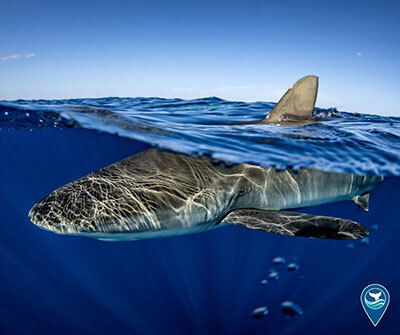
Tharks: mindless killers? 🦈
Think again! Sharks are more than their scary reputation and play important roles in sanctuary habitats from coral reefs to the deep seas. As predators, sharks help keep food webs in balance. Your National Marine Sanctuary System is home to a variety of amazing sharks. Learn more about them in the links below.
Photo: Leighton Lum (2022 GIYS Photo Contest Honorable Mention)

Tharks: mindless killers? 🦈
Think again! Sharks are more than their scary reputation and play important roles in sanctuary habitats from coral reefs to the deep seas. As predators, sharks help keep food webs in balance. Your National Marine Sanctuary System is home to a variety of amazing sharks. Learn more about them in the links below.
Photo: Leighton Lum (2022 GIYS Photo Contest Honorable Mention)
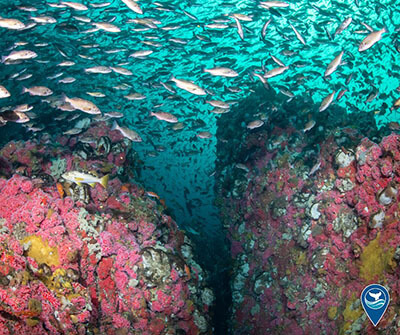
This is Cordell Bank National Marine Sanctuary, a 1,286 square-mile protected area located offshore about 42 miles north of San Francisco. NOAA has just released the latest condition report outlining that while overall the condition of water quality, habitats, and living resources are favorable, this offshore oasis is not immune to human impacts such as climate change and marine debris.
Photo: Robert Lee/BAUE

Go on an adventure.
Connect with the outdoors.
Try a new activity.
Embrace the country’s natural beauty.
Photo: Douglas Croft

Perfect end to a Sunday well spent in Hawaiian Islands Humpback Whale National Marine Sanctuary. Have you caught a wave in any of your national marine sanctuaries?
Photo: Matt McIntosh/NOAA

"We don't stop playing because we grow old; we grow old because we stop playing."
Today is Be a Kid Again Day! Make sure to get out and play.
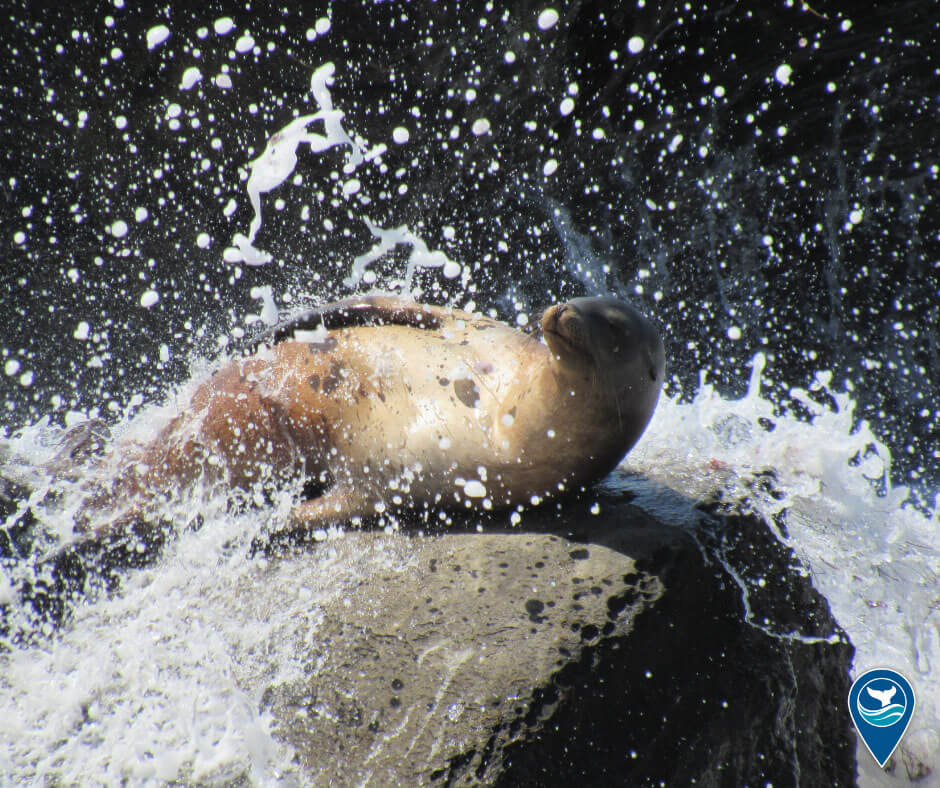
Did you take an amazing marine life photo outside of the National Marine Sanctuary System?
Submit your pics to “Sanctuaries Around the World” category of our photo contest! This new category of our photo contest is for marine-focused photos taken anywhere in the world, as long as they're outside of the National Marine Sanctuary System.
Photo: Olivia Becker (2022 GIYS Photo Contest Submission)

You don’t have to be a scuba diver to enjoy the kelp forests of NOAA Channel Islands National Marine Sanctuary!
Kayak tours are one way to adventure around the sanctuary, where you can paddle around sea caves and above the giant kelp forests with a birds-eye view of the underwater world beneath you.
Photo: Anna Jacobson

We’re celebrating stars (and stripes) today!
#IndependenceDay is one of the most popular beach days of the year, but litter also follows large crowds onto our shores. Luckily, you can enjoy the salt, sand, and sun while being a steward of your local marine environment. By reducing your use of single-use plastics and leaving no trace when packing up for the day, you can help preserve our beaches and ocean for marine life, and make your visit a more enjoyable one! Bonus points if you set aside some time to clean up other parts of the beach.
What beach are you visiting today?
Photo: Nancy Sefton

This week is Clean Beaches Week, the perfect time to think about how the plastic you use impacts the ocean and other ecosystems.
The trash we discard here on land can make its way into the sea, where it travels into distant ecosystems. By refusing, reducing, reusing, repurposing, and recycling, you can help reduce marine debris and negative impacts on wildlife throughout the ocean.
Photo: Douglas Croft

It's finally summer! So let's have some fun ☀️
Join us for a tour across the National Marine Sanctuary System in an interactive map showcasing some of the work happening on a summer day in national marine sanctuaries.

Have you seen any cool nudibranchs lately, like this Spanish shawl nudibranch in NOAA Channel Islands National Marine Sanctuary?
Photo: Cindy Shaw (Get Into Your Sanctuary Photo Contest submission)

Your next summer adventure awaits! ☀️
When you think of your next great adventure, what sort of things come to mind? The beautiful thing about adventure, is that feeling you get leading up to and anticipating the event, and the other feeling you get when you finally get to do that thing you’ve been looking forward to for so long.
Being adventurous is all about embracing the unknown, in whichever form that is for you. Whether you’re up for a surf trip, a weekend of fishing, scuba diving in a new place, taking the family camping, or having a peaceful retreat along the coast while exploring tide pools - no matter how you define a good adventure, there’s something for you in a national marine sanctuary.

…46…47…48…49… oh we give up! How many spots can you count on this spotted eagle ray in NOAA Florida Keys National Marine Sanctuary?
Photo: Olivia Williamson

Underwater selfies > regular selfies 📸
Let's see your recreation submissions for our #GetIntoYourSanctuary Photo Contest! This photo was snapped by a snorkeler at Alligator Reef in NOAA Florida Keys National Marine Sanctuary. The lighthouse pictured above is now a monument to protect the aquatic life below. It is one of the more recognizable snorkeling structures in the Upper Keys.
Photo: Michael Sipos (2022 GIYS Photo Contest Submission)

Ready to sprawl out on the beach this season? You’re in good company!
This harp seal is sprawled out on the beach at Race Point, near NOAA's Stellwagen Bank National Marine Sanctuary. If you see any seals or sea lions on your beach trips this summer, be sure to give them plenty of space.
While it may seem harmless to snap a quick seal selfie while you’re on the beach with our animal friends, approaching wild animals can cause significant harm to both you and them. Keep your eye out and help keep animals healthy by giving them plenty of room. They deserve relaxing days on the beach too!
Photo: Peter Flood

Show us the National Marine Sanctuary System through your camera lens!
Our #GetIntoYourSanctuary Photo Contest is now open! Submit your photos today
Photo: Allison Formica (2022 Get Into Your Sanctuary Photo Contest Submission)

Photo: Susan Bryan (2022 Get Into Your Sanctuary Photo Contest Submission)

Public meetings for Proposed Lake Erie Quadrangle National Marine Sanctuary begin tomorrow!
Photo: VisitErie

Happy Father’s Day from your National Marine Sanctuary System!
The animal kingdom is filled with exemplary father figures — the seaweed blennies at NOAA Gray's Reef National Marine Sanctuary are no exception! Female blennies deposit their eggs in the nooks and crannies of the reef. Then, males keep an eye on the eggs until they hatch!
Photo: Greg McFall/NOAA

Strange but true: leather sea stars, like this one in NOAA Olympic Coast National Marine Sanctuary, smell like garlic!
That’s why they’re also sometimes known as garlic stars. Have you ever gotten a whiff of one in your national marine sanctuaries?
Photo: David J. Ruck/NOAA

Don’t forget your camera when you’re out on the water this weekend! 📸
Our #GetIntoYourSanctuary Photo Contest is now open! Show us how you #RecreateResponsibly by submitting your photos to our “Sanctuary Recreation” category.
Photo: Kim Beaver (2022 GIYS Photo Contest Submission)

Don’t forget your camera when you’re out on the water this weekend! 📸
Our #GetIntoYourSanctuary Photo Contest is now open! Show us how you #RecreateResponsibly by submitting your photos to our “Sanctuary Recreation” category.
Photo: Jessica Connell (2022 GIYS Photo Contest Submission)

Getting off of work at 4:30pm after a long weekend…
This little goby was spotted in NOAA's Monterey Bay National Marine Sanctuary hiding in the shadows. Check out more incredible wildlife photography like this from around the sanctuary system by visiting our #GetIntoYourSanctuary Photo Contest submissions!
Photo: Bruce Sudweeks (2021 Get Into Your Sanctuary Photo Contest submission)

Today, for Memorial Day, we honor the many men and women who gave their lives in service to our nation.
In addition to protecting important ecosystems and habitats, your National Marine Sanctuary System also protects maritime heritage resources that tell the story of our maritime nation. Papahānaumokuākea Marine National Monument, for example, protects the waters around Midway Atoll, which are the resting place for at least 31 sunken aircraft that are considered war graves. The Battle of Midway was one of the most decisive U.S. victories of WWII and is referred to as the turning point of the war in the Pacific. Here, a diver documents the wing section of a F4U Corsair.
Photo: Tane Casserley/NOAA

Come sail away with these Velella velellas in NOAA's Monterey Bay National Marine Sanctuary!
Vellela vellela, or the by-the-wind sailor, is a small, unique, jelly-like species that has a vertical sail atop its float, helping it to travel. This sail is oriented at a diagonal to the animal’s body axis, allowing it to take advantage of prevailing wind currents that push the animal across the sea.
Scientists have found that populations along the California coast tend to have sails oriented to the right, while populations farther west in the Pacific tend to have sails oriented to the left, reflecting differing wind patterns in their respective regions!
Photo: Douglas Croft

Come sail away with these Velella velellas in NOAA's Monterey Bay National Marine Sanctuary!
Vellela vellela, or the by-the-wind sailor, is a small, unique, jelly-like species that has a vertical sail atop its float, helping it to travel. This sail is oriented at a diagonal to the animal’s body axis, allowing it to take advantage of prevailing wind currents that push the animal across the sea.
Scientists have found that populations along the California coast tend to have sails oriented to the right, while populations farther west in the Pacific tend to have sails oriented to the left, reflecting differing wind patterns in their respective regions!
Photo: Douglas Croft

Come sail away with these Velella velellas in NOAA's Monterey Bay National Marine Sanctuary!
Vellela vellela, or the by-the-wind sailor, is a small, unique, jelly-like species that has a vertical sail atop its float, helping it to travel. This sail is oriented at a diagonal to the animal’s body axis, allowing it to take advantage of prevailing wind currents that push the animal across the sea.
Scientists have found that populations along the California coast tend to have sails oriented to the right, while populations farther west in the Pacific tend to have sails oriented to the left, reflecting differing wind patterns in their respective regions!
Photo: Douglas Croft

Come sail away with these Velella velellas in NOAA's Monterey Bay National Marine Sanctuary!
Vellela vellela, or the by-the-wind sailor, is a small, unique, jelly-like species that has a vertical sail atop its float, helping it to travel. This sail is oriented at a diagonal to the animal’s body axis, allowing it to take advantage of prevailing wind currents that push the animal across the sea.
Scientists have found that populations along the California coast tend to have sails oriented to the right, while populations farther west in the Pacific tend to have sails oriented to the left, reflecting differing wind patterns in their respective regions!
Photo: Douglas Croft

Read the inspiring stories of women lighthouse keepers of national marine sanctuaries in our newest release “Beacons of History.”
Photo: Robert Schwemmer/NOAA

This #NationalMaritimeDay, check out our newest release about the maritime cultural landscape of American Samoa!
American Samoa has a long and continuous history of maritime activities and connection to the ocean, from the initial voyaging discovery by Pacific navigators thousands of years ago to the long-range fishing fleets and modern fautasi racing craft of today. This storymap, FOLAUGA FAIFAIPEA I LUGA O LE VASA: A Voyage by Sea Through Time, presents the maritime cultural landscape of Amerika Samoa, highlighting marine locations and events and resources that have shaped us from the past and continue to define who we are today.
Photo: David Herdrich

This #NationalMaritimeDay, check out our newest release about the maritime cultural landscape of American Samoa!
American Samoa has a long and continuous history of maritime activities and connection to the ocean, from the initial voyaging discovery by Pacific navigators thousands of years ago to the long-range fishing fleets and modern fautasi racing craft of today. This storymap, FOLAUGA FAIFAIPEA I LUGA O LE VASA: A Voyage by Sea Through Time, presents the maritime cultural landscape of Amerika Samoa, highlighting marine locations and events and resources that have shaped us from the past and continue to define who we are today.
Photo: Hans Van Tilburg/NOAA

This #NationalMaritimeDay, check out our newest release about the maritime cultural landscape of American Samoa!
American Samoa has a long and continuous history of maritime activities and connection to the ocean, from the initial voyaging discovery by Pacific navigators thousands of years ago to the long-range fishing fleets and modern fautasi racing craft of today. This storymap, FOLAUGA FAIFAIPEA I LUGA O LE VASA: A Voyage by Sea Through Time, presents the maritime cultural landscape of Amerika Samoa, highlighting marine locations and events and resources that have shaped us from the past and continue to define who we are today.
Photo: Hans Van Tilburg/NOAA

This #NationalMaritimeDay, check out our newest release about the maritime cultural landscape of American Samoa!
American Samoa has a long and continuous history of maritime activities and connection to the ocean, from the initial voyaging discovery by Pacific navigators thousands of years ago to the long-range fishing fleets and modern fautasi racing craft of today. This storymap, FOLAUGA FAIFAIPEA I LUGA O LE VASA: A Voyage by Sea Through Time, presents the maritime cultural landscape of Amerika Samoa, highlighting marine locations and events and resources that have shaped us from the past and continue to define who we are today.
Photo: Hans Van Tilburg/NOAA

This #NationalMaritimeDay, check out our newest release about the maritime cultural landscape of American Samoa!
American Samoa has a long and continuous history of maritime activities and connection to the ocean, from the initial voyaging discovery by Pacific navigators thousands of years ago to the long-range fishing fleets and modern fautasi racing craft of today. This storymap, FOLAUGA FAIFAIPEA I LUGA O LE VASA: A Voyage by Sea Through Time, presents the maritime cultural landscape of Amerika Samoa, highlighting marine locations and events and resources that have shaped us from the past and continue to define who we are today.
Photo: Hans Van Tilburg/NOAA

#NEW: Just in time for #EndangeredSpeciesDay, NOAA’s Office of Law Enforcement partnered with federal and state partners to protect turtles in Florida Keys National Marine Sanctuary.
NOAA’s Office of Law Enforcement recently conducted a joint operation aimed at protecting sea turtle species in and around Florida Keys National Marine Sanctuary—a key protected area in the Southeastern United States. The operation, TED TALK, brought together partners from NOAA’s Gear Monitoring Team and the Florida Fish and Wildlife Conservation Commission to protect sea turtles by enhancing our turtle excluder device (TED) inspections aboard fishing vessels.

#BreakingNews: National Oceanic and Atmospheric Administration (NOAA) is considering designating a new national marine sanctuary in Lake Erie, adjacent to Pennsylvania, and the public is invited to participate in the first step of the process.
A sanctuary designation would recognize the national significance of the area’s maritime history and cultural resources, as well as expand upon existing local and state efforts to create educational, scientific and recreational opportunities for visitors, residents, teachers and students.
The public can comment on the proposed action May 19, 2023 to July 18, 2023.
Photo: Jeremy Bannister Photography

Duunnn dun… duunnn dun… wait a second, that’s no shark – it’s a mola mola!
Also known as ocean sunfish, mola mola are the heaviest bony fish in the ocean. These ocean giants roam the seas in search of their favorite food, jellyfish. This one was spotted impersonating a shark in Greater Farallones National Marine Sanctuary.
Photo: Sara Heintzelman/NOAA

Happy Mother’s Day from your National Marine Sanctuary System! This harbor seal mom is checking in on her pup in NOAA's Monterey Bay National Marine Sanctuary.
If you see a harbor seal pup alone on a beach, it’s not abandoned – its mother is just out feeding so she can continue to sustain her pup. Stay back 100 yards if possible, and keep any dogs on a leash. If you approach the pup, you may spook its mother and she may not come back – keeping your distance helps keep mother and pup safe!
Photo: Clarice Soleil

Sunk by a German U-boat during World War II about 25 years after its construction, the wreck of the tanker Ashkhabad now rests in the Graveyard of the Atlantic. Sitting in 55 feet of water, the wreck is home to a vibrant community of marine life - like this loggerhead sea turtle!

Rare sighting in NOAA Olympic Coast National Marine Sanctuary: the sea lions of Olympic Coast appear to engage in a lively chat with none other than Chewbacca, one of our favorite intergalactic visitors to sanctuaries.
Happy Star Wars Day from our blue planet!
May the 4th be with you.
Photo: Carey Floyd/NOAA

When a hurricane hits the coast, it can spark tragedy, leaving flooding and destruction in its wake. But national marine sanctuaries help ensure our coasts are resilient. During storms, healthy coral reefs can help buffer the coastline from storm surge, minimizing damage. And after a storm, sanctuaries and our partners help assess damage to natural resources and assist coastal communities in recovery efforts.

Is it a plant? A coral? An extraterrestrial life form?
If you said none of the above, you’re correct! This crinoid in Cordell Bank National Marine Sanctuary is a marine animal related to sea stars and sea urchins. Attaching to rocks, sponges, or corals, these animals feed on microorganisms in the water column by trapping them in their sticky, raised feathery arms!
Photo: Michael Carver/NOAA
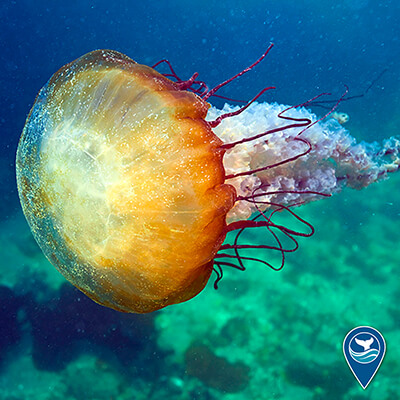
Just go with the flow 😌
Though they can “swim” through the ocean by contracting their bell, jellies like this sea nettle in NOAA's Monterey Bay National Marine Sanctuary often simply float through the ocean, riding along currents. Sometimes, smaller organisms like fish or shrimp even hitch a ride on the bell as the sea nettle drifts through the water.
Photo: NOAA

*Hearing a strange noise in the house when you're the only one home* 😳
What was that noise? Oh. It was probably just a male oyster toadfish looking for a mate! Found in NOAA Gray's Reef National Marine Sanctuary, oyster toadfish may not be known for their attractiveness, but rather the loud foghorn-like calls males produce during mating season. Male toadfish do this by vibrating their swim bladder muscles. This call can be heard over long distances, beckoning female toadfish to come say hello. Have you ever heard their calls?
Photo: Greg McFall/NOAA

Over the past 14 years, tens of thousands of students have been immersed in environmental stewardship projects across the country in an effort to protect their local watersheds, the world's ocean, and special areas like national marine sanctuaries.
In celebration of #EarthMonth, we interviewed two veteran Ocean Guardian educators who have been dedicated to investing in our planet for over a decade.

🚨 Attention PreK-12 teachers and schools 🚨
The 2023 - 2024 Ocean Guardian School application is now available on the Ocean Guardian School website! The Ocean Guardian School program funds stewardship projects focused on current issue(s) impacting local watersheds and/or the ocean while promoting best environmental practices. Through a school- or community-based project, schools work to make a difference in the health and protection of their local watersheds, ocean and/or special ocean areas like national marine sanctuaries.
The deadline to submit an application is June 1, 2023. If you have any questions, please contact alyssa.leadingham@noaa.gov.
Photo: Claire Fackler/NOAA

#NationalVolunteerWeek Feature: Jeep Dunning (Visitor Center Docent, Outreach Specialist, Sanctuary Lecturer)
“I joined the Hawaiian Islands Humpback Whale National Marine Sanctuary Volunteer Team in 2008 and have participated in a myriad of activities, including working with school groups, presenting 45 Ton Talks, acting as a visitor center docent, joining outreach events, writing for the newsletter, assisting office staff, and endless other opportunities. What I love about volunteering for the sanctuary is that I learn something new every single day I participate and also feel privileged to have access to cutting edge NOAA marine science experts. I especially enjoy interacting with the public and sharing what I have learned with others.”

BREAKING NEWS: NOAA considers sanctuary in waters around Pacific Remote Islands
Today, National Oceanic and Atmospheric Administration (NOAA) announced it is starting the process to potentially designate a new national marine sanctuary in the Pacific Remote Islands area under the Biden-Harris Administration. The proposed area in the central Pacific Ocean includes marine areas within the existing Pacific Remote Islands Marine National Monument, as well as currently unprotected submerged lands and waters, an area totaling about 770,000 square miles.
A sanctuary designation would help conserve the atolls, shoals, seamounts, banks and reefs surrounding the Pacific Remote Islands. This area is home to some of the most diverse and remarkable tropical marine ecosystems on the planet, and provides a haven for a host of wildlife, including corals, sharks, fish, marine mammals, seabirds and invertebrates.

BREAKING NEWS: NOAA considers sanctuary in waters around Pacific Remote Islands
Today, National Oceanic and Atmospheric Administration (NOAA) announced it is starting the process to potentially designate a new national marine sanctuary in the Pacific Remote Islands area under the Biden-Harris Administration. The proposed area in the central Pacific Ocean includes marine areas within the existing Pacific Remote Islands Marine National Monument, as well as currently unprotected submerged lands and waters, an area totaling about 770,000 square miles.
A sanctuary designation would help conserve the atolls, shoals, seamounts, banks and reefs surrounding the Pacific Remote Islands. This area is home to some of the most diverse and remarkable tropical marine ecosystems on the planet, and provides a haven for a host of wildlife, including corals, sharks, fish, marine mammals, seabirds and invertebrates.

BREAKING NEWS: NOAA considers sanctuary in waters around Pacific Remote Islands
Today, National Oceanic and Atmospheric Administration (NOAA) announced it is starting the process to potentially designate a new national marine sanctuary in the Pacific Remote Islands area under the Biden-Harris Administration. The proposed area in the central Pacific Ocean includes marine areas within the existing Pacific Remote Islands Marine National Monument, as well as currently unprotected submerged lands and waters, an area totaling about 770,000 square miles.
A sanctuary designation would help conserve the atolls, shoals, seamounts, banks and reefs surrounding the Pacific Remote Islands. This area is home to some of the most diverse and remarkable tropical marine ecosystems on the planet, and provides a haven for a host of wildlife, including corals, sharks, fish, marine mammals, seabirds and invertebrates.

BREAKING NEWS: NOAA considers sanctuary in waters around Pacific Remote Islands
Today, National Oceanic and Atmospheric Administration (NOAA) announced it is starting the process to potentially designate a new national marine sanctuary in the Pacific Remote Islands area under the Biden-Harris Administration. The proposed area in the central Pacific Ocean includes marine areas within the existing Pacific Remote Islands Marine National Monument, as well as currently unprotected submerged lands and waters, an area totaling about 770,000 square miles.
A sanctuary designation would help conserve the atolls, shoals, seamounts, banks and reefs surrounding the Pacific Remote Islands. This area is home to some of the most diverse and remarkable tropical marine ecosystems on the planet, and provides a haven for a host of wildlife, including corals, sharks, fish, marine mammals, seabirds and invertebrates.

BREAKING NEWS: NOAA considers sanctuary in waters around Pacific Remote Islands
Today, National Oceanic and Atmospheric Administration (NOAA) announced it is starting the process to potentially designate a new national marine sanctuary in the Pacific Remote Islands area under the Biden-Harris Administration. The proposed area in the central Pacific Ocean includes marine areas within the existing Pacific Remote Islands Marine National Monument, as well as currently unprotected submerged lands and waters, an area totaling about 770,000 square miles.
A sanctuary designation would help conserve the atolls, shoals, seamounts, banks and reefs surrounding the Pacific Remote Islands. This area is home to some of the most diverse and remarkable tropical marine ecosystems on the planet, and provides a haven for a host of wildlife, including corals, sharks, fish, marine mammals, seabirds and invertebrates.

BREAKING NEWS: NOAA considers sanctuary in waters around Pacific Remote Islands
Today, National Oceanic and Atmospheric Administration (NOAA) announced it is starting the process to potentially designate a new national marine sanctuary in the Pacific Remote Islands area under the Biden-Harris Administration. The proposed area in the central Pacific Ocean includes marine areas within the existing Pacific Remote Islands Marine National Monument, as well as currently unprotected submerged lands and waters, an area totaling about 770,000 square miles.
A sanctuary designation would help conserve the atolls, shoals, seamounts, banks and reefs surrounding the Pacific Remote Islands. This area is home to some of the most diverse and remarkable tropical marine ecosystems on the planet, and provides a haven for a host of wildlife, including corals, sharks, fish, marine mammals, seabirds and invertebrates.

BREAKING NEWS: NOAA considers sanctuary in waters around Pacific Remote Islands
Today, National Oceanic and Atmospheric Administration (NOAA) announced it is starting the process to potentially designate a new national marine sanctuary in the Pacific Remote Islands area under the Biden-Harris Administration. The proposed area in the central Pacific Ocean includes marine areas within the existing Pacific Remote Islands Marine National Monument, as well as currently unprotected submerged lands and waters, an area totaling about 770,000 square miles.
A sanctuary designation would help conserve the atolls, shoals, seamounts, banks and reefs surrounding the Pacific Remote Islands. This area is home to some of the most diverse and remarkable tropical marine ecosystems on the planet, and provides a haven for a host of wildlife, including corals, sharks, fish, marine mammals, seabirds and invertebrates.
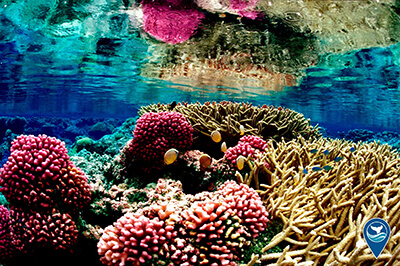
BREAKING NEWS: NOAA considers sanctuary in waters around Pacific Remote Islands
Today, National Oceanic and Atmospheric Administration (NOAA) announced it is starting the process to potentially designate a new national marine sanctuary in the Pacific Remote Islands area under the Biden-Harris Administration. The proposed area in the central Pacific Ocean includes marine areas within the existing Pacific Remote Islands Marine National Monument, as well as currently unprotected submerged lands and waters, an area totaling about 770,000 square miles.
A sanctuary designation would help conserve the atolls, shoals, seamounts, banks and reefs surrounding the Pacific Remote Islands. This area is home to some of the most diverse and remarkable tropical marine ecosystems on the planet, and provides a haven for a host of wildlife, including corals, sharks, fish, marine mammals, seabirds and invertebrates.

Looking for inspiration for your next art project? Head to your National Marine Sanctuary System!

Ride the waves into the weekend in Greater Farallones National Marine Sanctuary! Which beach are you visiting this weekend?
Photo: Jennifer Stock/NOAA

Looking for inspiration for your next art project? Head to your National Marine Sanctuary System!

Ride the waves into the weekend in Greater Farallones National Marine Sanctuary! Which beach are you visiting this weekend?
Photo: Jennifer Stock/NOAA

Sharing your love for the ocean with the ones closest to you- what could be better?
This couple had the chance to experience NOAA Olympic Coast National Marine Sanctuary's stunning sunsets and tide pools while honeymooning in Washington.
Photo: Carlton Thompson (2022 Get Into Your Sanctuary Photo Contest Submission)

Kiss the weekend hello like this smooth trunkfish! These spotted beauties can be seen on the reef at Flower Garden Banks National Marine Sanctuary.
Photo: G.P. Schmahl/NOAA

Play on #WorldHealthDay!
Play is important, with experts now understanding that outside play, including water-based recreation, is crucial for children’s development, for our continuing physical, mental, and emotional health as adults, and as a growing segment of our national economy.
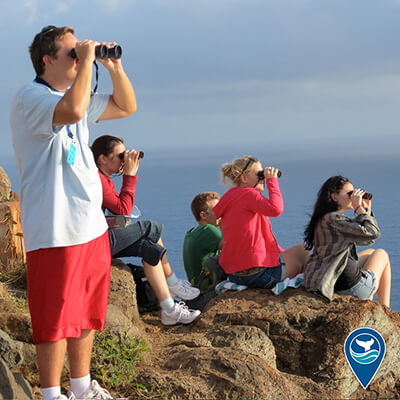
National marine sanctuaries rely on volunteers like you!
Volunteering is one way to explore our nation's underwater treasures while doing your part to ensure a healthy ocean and Great Lakes. Whether once a week or once a year, meaningful opportunities abound for visitors and locals alike with all levels of knowledge and commitment to contribute to marine conservation and stewardship.

New Release: Marine Debris Resource Collection
Marine debris threatens the ocean and its resources, the economy, and safe navigation. Animals like birds, turtles, marine mammals, and other creatures can die when they accidentally swallow or get tangled up in marine debris.
All national marine sanctuaries face the challenges of marine debris and the harmful impacts that come along with managing this problem. The Marine Debris Resource Collection features resources related to the problem of marine debris, NOAA and sanctuary system programs, and the solution to pollution.

New Release: Marine Debris Resource Collection
Marine debris threatens the ocean and its resources, the economy, and safe navigation. Animals like birds, turtles, marine mammals, and other creatures can die when they accidentally swallow or get tangled up in marine debris.
All national marine sanctuaries face the challenges of marine debris and the harmful impacts that come along with managing this problem. The Marine Debris Resource Collection features resources related to the problem of marine debris, NOAA and sanctuary system programs, and the solution to pollution.
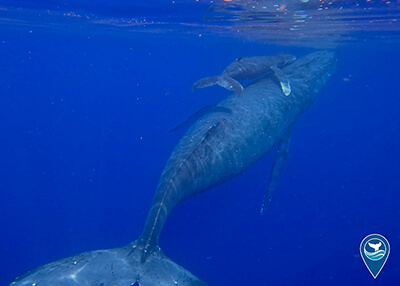
Watch out for whales! It's still humpback whale season in Hawaiian Islands Humpback Whale National Marine Sanctuary. Every winter, koholā (humpback whales) travel to the warm, shallow waters of Hawai‘i to mate, give birth, and raise their young. Keep a sharp lookout, watch your speed, and remember to give these beautiful animals their space.
Sightings of the colossal marine mammals peak between the months of January and March, then gradually decline until humpback season ends in early May. Each year provides opportunities for whale watching, research, citizen science, and the need for entanglement response.
This image was taken last month in Hawaiian Islands Humpback Whale National Marine Sanctuary by Ed Lyman/NOAA under NOAA permit #25754.

Explore your National Marine Sanctuary System at your fingertips 📲
Did you know the National Park Trust allows you to collect badges for visits to your favorite local, state, and federal parks? This includes your National Marine Sanctuaries and Marine National Monuments!
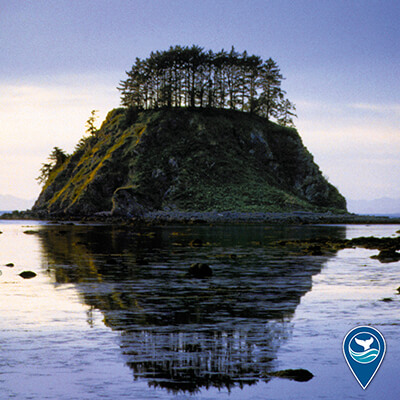
Wanting to get out this weekend, but don’t want to get wet?
You don’t have to be a diver to enjoy a national marine sanctuary! Landlubbers visiting Olympic Coast National Marine Sanctuary can hike along beachside cliffs, enjoy marine life from the shore, and spot nearshore islands like Cannonball Island.
Photo: Robert Steelquist/NOAA
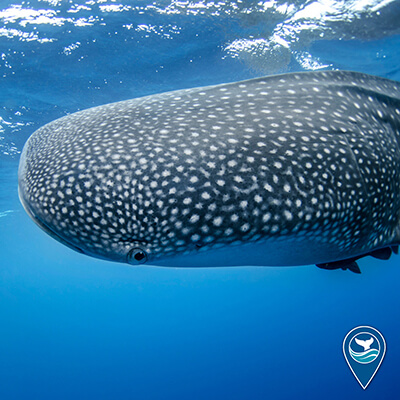
Fun fact: Did you know whale sharks are actually whales?
April fools! These gentle behemoths are actually the largest fish in the ocean! Whale sharks eat mostly small organisms like plankton, schooling fish, and squid, which they strain from the water as they swim with their meter-long mouths and specialized teeth.
Photo: Sam Farkas
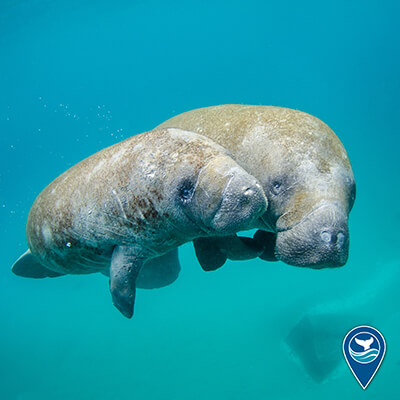
Time to spill the mana-tea!
While not great at gossip, these large, air-breathing herbivores are found in shallow waters where seagrass beds or vegetation flourish. Manatees are slow-moving and therefore unable to swim quickly away from boats; this often results in collisions that may cause injury or death to the creatures. In areas that are known manatee habitats, boaters should slow down and produce only minimal wake.
Have you seen a manatee floating beneath the surface in NOAA Florida Keys National Marine Sanctuary?
Photo: Sam Farkas

Nothing hits the spot like a midday nap, especially for sea otters! 🦦
Due to their high metabolism, sea otters – like this one in NOAA's Monterey Bay National Marine Sanctuary – have to eat and rest a lot as part of their daily routine.
As otterly adorable as they are, it’s important to keep a safe viewing distance when coming across a sea otter in the wild so you don’t interrupt the time they need to take care of themselves. Keep sea otters safe and undisturbed by respecting their space, and their naps!
Photo: Cat Harper

The garden-like coral and sponge habitats of Cordell Bank National Marine Sanctuary are a great spot for our octopus friends to stretch out a leg… or eight.
What is your favorite octopus fact? Ours is that they have three hearts, just enough to be fully octo-pied with a love for the bank!
Photo: NOAA

The stewardship of our spectacular ocean is informed by brilliant scientists, researchers, and budding scholars. NOAA’s Dr. Nancy Foster scholars represent a new generation that works to find solutions to the complex obstacles faced in marine management.
Photo: Ed Lyman/NOAA

The stewardship of our spectacular ocean is informed by brilliant scientists, researchers, and budding scholars. NOAA’s Dr. Nancy Foster scholars represent a new generation that works to find solutions to the complex obstacles faced in marine management.
Photo: Ed Lyman/NOAA

It's humpback whale season in Hawai'i and our research vessel is on the move! 🛥
Check out this 360 view as Hawaiian Islands Humpback Whale National Marine Sanctuary researchers search for humpbacks off Maui. The team on this vessel conducts health and risk assessments on humpback whales in sanctuary waters.
Photo: Ed Lyman/NOAA

St. Patrick's Day weekend calls for a trip to the Green Room cave, offshore of Santa Cruz Island in NOAA Channel Islands National Marine Sanctuary. Immense wind and waves have carved out this cave, but on a calm day the light flourishes from below to create a beautiful glow.
Photo: Dustin Harris (2022 GIYS Photo Contest Submission)
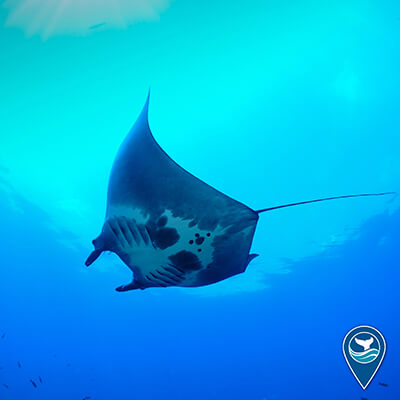
Our Earth Is Blue campaign was launched to bring the treasures of the ocean and Great Lakes directly to you through beautiful imagery and videos.
It serves as a tangible reminder that no matter where you are, the ocean and Great Lakes are in your hands, and we hope to inspire you to spread the word that earth isn’t green–it’s blue.
What are some wildlife you want to see featured in our Earth Is Blue campaign?
Photo: G.P. Schmahl/NOAA

Green sea turtles are always ready for St. Patrick’s Day! 🍀
Adult green turtles are unique among sea turtles in that they eat only plants; they primarily feed on on seagrasses and algae. This diet is thought to give them greenish-colored fat, from which they take their name. This one was spotted by a snorkeler in Hawaiian Islands Humpback Whale National Marine Sanctuary.
Have you seen anything green when you were in a national marine sanctuary?
Photo: Bruce Sudweeks (2022 GIYS Photo Contest Submission)

Wednesday is hump(back) day! 🐋
Have you heard about the humpback whales in Papahānaumokuākea Marine National Monument? New research reveals an abundance of koholā (humpback whales) in Papahānaumokuākea Marine National Monument! Now, nearly the entire Hawaiian archipelago is visited by humpback whales during the winter and early spring months.
Photo: Jason Moore/NOAA under Permit #14682

Happy Pi Day! 🥧
This sea anemone in NOAA Channel Islands National Marine Sanctuary isn’t a pie and we definitely wouldn’t recommend eating it. BUT, sea anemones do exhibit radial symmetry, meaning they’re symmetrical around a center point, like a pie, and you could measure their circumference using pi.
Photo: Evan Barba
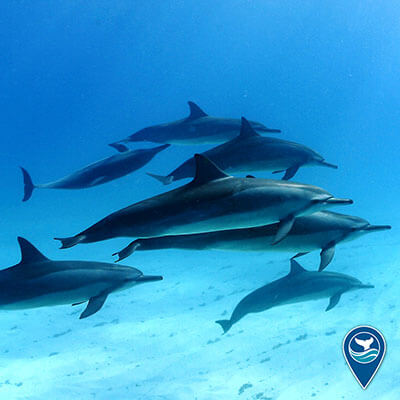
It's #DolphinAwarenessMonth! Spinner dolphins like this fancy crew in Papahānaumokuākea Marine National Monument practice what is called a “fission fusion social pattern.” This means that the dolphins “fuse” to form large social groups of more than 100 individuals to hunt at night and then separate into much smaller groups – with as few as 12 individuals – to socialize and rest during the day.
Our national marine sanctuaries and marine national monuments are teeming with organisms that display radial symmetry. Can you name any other radially symmetrical marine organisms?
Photo: James Watt/NOAA

Happy International Women’s Day! Today we’re celebrating all the women who make the National Marine Sanctuary System possible and who dedicate themselves to protecting and understanding marine species and ecosystems. Learn about the inspirational women of sanctuaries in these images.
Dr. Nancy Foster Scholar Sarah Kienle uses hair dye to mark the fur of an elephant seal to aid later identification in her research. Photo courtesy of Sarah Kienle, under NMFS permit #19108.

Happy International Women’s Day! Today we’re celebrating all the women who make the National Marine Sanctuary System possible and who dedicate themselves to protecting and understanding marine species and ecosystems. Learn about the inspirational women of sanctuaries in these images.
Here, Dr. Michelle Johnston, research ecologist at NOAA's Flower Garden Banks National Marine Sanctuary, dives through sanctuary waters amongst hundreds of fish and other sea critters! Michelle manages the sanctuary’s long-term coral monitoring project and helps fight the spread of invasive lionfish in the sanctuary.

Happy International Women’s Day! Today we’re celebrating all the women who make the National Marine Sanctuary System possible and who dedicate themselves to protecting and understanding marine species and ecosystems. Learn about the inspirational women of sanctuaries in these images.
Here, Dr. Nancy Foster Scholar Carina Fish pauses during a research expedition in NOAA's Greater Farallones and Cordell Bank National Marine Sanctuaries. The Foster Scholarship supports women and members of minoritized groups in graduate school for ocean-related sciences.

Happy International Women’s Day! Today we’re celebrating all the women who make the National Marine Sanctuary System possible and who dedicate themselves to protecting and understanding marine species and ecosystems. Learn about the inspirational women of sanctuaries in these images.
This is Jessica Hale, a Dr. Nancy Foster Scholar who studies sea otters in NOAA Olympic Coast National Marine Sanctuary. Thanks to her research, the sanctuary is learning more about sea otters’ role in this Pacific Northwest area.

“Hey, I have a whaley funny joke for ya. What do you call a pod of musical orcas?"
…
“An orca-stra! *buh dum tss!*”
When they aren’t splashing around dad jokes, orcas can be sighted sporadically along North America’s West Coast, including in NOAA's Monterey Bay National Marine Sanctuary. The best time to spot an orca in this sanctuary is from April until June, when they feed on migrating gray whales.
Photo: Douglas Croft

Today we celebrate Women’s History Month by celebrating the generations of women who have contributed to and continue to contribute to incredible advancements in science, technology, engineering and math (STEM) fields.
Many accomplished woman scientists have participated in the Dr. Nancy Foster Scholarship Program, which provides support for master’s and doctoral studies in disciplines involving ocean and coastal areas. While she was a Foster Scholar, Andrea Quattrini, PhD (pictured on the left here) studied the genetic connectivity of deepwater gorgonians in NOAA's Flower Garden Banks National Marine Sanctuary and beyond. Learn more about the Nancy Foster Scholarship and these amazing students’ accomplishments – and how you can apply!

Connect to national marine sanctuaries no matter where you are in the world by enjoying the outdoors near your home. Congratulations to Patel Darpan Manharbhai for receiving an honorable mention in our Sanctuaries at Home category of our photo contest. This image was taken at Dandi Beach, Navsari, in India.

Congratulations to Michael Sipos for receiving an honorable mention in our 2022 Get Into Your Sanctuary Photo Contest!
This photo was snapped while hiking in the Ten Thousand Islands National Wildlife Refuge located in the western portion of the Florida Everglades. Pictured is an American alligator resting in the marsh near a clump of red mangroves. These are two iconic Florida species!

A sunset so beautiful, it makes you want to wave your hands in the air! 🌅
Congratulations to Patrick Stoll for receiving an honorable mention in the Sanctuary Views category of our 2022 Get Into Your Sanctuary Photo Contest! This picture-perfect moment was captured of a father and son in Monterey Bay National Marine Sanctuary. Have you ever seen a sunset this perfect?

Since 2009, Greater Farallones Association and researchers have been working with volunteers to remove these invasive European green crabs from Seadrift and Bolinas Lagoons. Thanks to this project, Seadrift Lagoon’s biodiversity has rebounded, while green crab numbers in Bolinas Lagoon remain low.
Help us keep unwanted visitors away by practicing wildlife stewardship on the water. Clean, drain, and dry your hull and equipment and dispose of unwanted bait in the trash to prevent the spread of invasive species. Only use live bait that are native to your fishing ground.

Congratulations to Jeff Lindsay for receiving an honorable mention in the Sanctuary Views category of our 2022 Get Into Your Sanctuary Photo Contest! Pictured here, the S.S. Ohio rests below Lake Huron in NOAA Thunder Bay National Marine Sanctuary.

Just in time for Valentine’s Day, we’re highlighting some of our favorite examples of courtship, reproduction, and other fascinating animal interactions in your national marine sanctuaries! 💕
Not all animals pair up solely for reproductive purposes. Many marine species participate in mutualistic relationships, which occur when two different animals form a partnership that benefits them both. Giant manta rays, some of Flower Garden Banks National Marine Sanctuary’s most famous residents, are frequently spotted with fish attached to their head or undersides. These fish are known as remoras, suckerfish, or sharksuckers. While it may appear that the remoras are harming the ray, the two partake in a mutually beneficial relationship. Some of the perks of latching onto a manta ray for a remora include protection from predators, easy transportation, and feeding on the scraps of the manta’s meal. In return, the remora keeps the manta healthy by feeding on any bacteria or parasites attached to the ray’s skin.

Just in time for Valentine’s Day, we’re highlighting some of our favorite examples of courtship, reproduction, and other fascinating animal interactions in your national marine sanctuaries! 💕
Some of the most fascinating examples of reproduction in the National Marine Sanctuary System come from corals and sponges. Corals can reproduce both sexually – which requires both male and female gametes – and asexually, which requires only one parent coral

Just in time for Valentine’s Day, we’re highlighting some of our favorite examples of courtship, reproduction, and other fascinating animal interactions in your national marine sanctuaries! 💕
Did you know that only male humpback whales sing? As whales begin to arrive in sanctuary waters in November and the breeding season kicks off, the males really crank up the volume. They sing to locate other whales nearby, compete with other males for females and space, and, most importantly, to attract a mate.

Just in time for Valentine’s Day, we’re highlighting some of our favorite examples of courtship, reproduction, and other fascinating animal interactions in your national marine sanctuaries! 💕
Love is a battlefield for northern elephant seals– literally! Though northern elephant seals spend the majority of the year at sea, they come ashore during breeding season in December. These animals are polygamous, and males will challenge competitors for dominance over a group of females.

Kamau Sadiki Dives With a Purpose
Read his interview containing impactful stories of diving at shipwrecks from the Trans-Atlantic Era of African Enslavement.
Register for tomorrow’s webinar as we hear Kamau Sadiki talk about Diving With a Purpose, a non-profit organization of divers whose mission is to share stories of shipwrecks involved in the commodification and enslavement of Black bodies.

This beautiful pteropod, or sea butterfly, was spotted during a dive in NOAA Channel Islands National Marine Sanctuary! Pteropods are tiny creatures, only about an inch in size, but their utility as an indicator species for ocean acidification is huge.
When we burn fossil fuels like oil and gas, we release carbon dioxide into our atmosphere. Some of that rampant carbon dioxide is absorbed by the ocean, where it changes the ocean’s chemistry and makes the water more acidic.
These changes in ocean chemistry are making it harder for pteropods to build their shells. By tracking pteropod populations and keeping an eye on the health of their shells, we can gain information about the rate of ocean acidification and better analyze how chemical changes in the ocean will impact other shelled organisms and whole ecosystems over time.
Photo: Chelsea Mathieson (2022 GIYS Photo Contest Submission)

A hop, skip, and a jump away from the weekend!
This Risso’s dolphin was spotted leaping through the waves in NOAA's Monterey Bay National Marine Sanctuary. Risso’s dolphins are easily identifiable by their white scars, which may be made by other Risso’s dolphins or by squid, their preferred prey. The gold pigmentation is caused by diatoms on the dolphin.
Photo: Chelsea Mathieson (2022 GIYS Photo Contest Submission)

Today is #NationalPlanAVacationDay and we are inviting you to explore the wonders of America's underwater parks!
National marine sanctuaries are fun for everyone! Check out https://sanctuaries.noaa.gov/visit/ to prepare for your visit, plan a recreational activity, and research the unique creatures that call the National Marine Sanctuary System home.
Photo: Jack Louden

California Bay Watershed Education and Training (NOAA B-WET) grants are available now!
The Fiscal Year 2023 Notice of Funding Opportunity is now open. The deadline for submissions is February 23, 2023 at 11:59 PM Eastern. If you have any questions, please contact Seaberry.Nachbar@noaa.gov.

As the National Marine Sanctuary System emerges from the disruption of regular workflow due to the COVID-19 pandemic, many research efforts that were paused are resuming with renewed energy. National marine sanctuaries across the country are revamping projects that were stalled during the early months of the pandemic, and are engaging with diverse communities to establish the foundation for long-term partnerships and community science initiatives.

As the National Marine Sanctuary System emerges from the disruption of regular workflow due to the COVID-19 pandemic, many research efforts that were paused are resuming with renewed energy. National marine sanctuaries across the country are revamping projects that were stalled during the early months of the pandemic, and are engaging with diverse communities to establish the foundation for long-term partnerships and community science initiatives.

As the National Marine Sanctuary System emerges from the disruption of regular workflow due to the COVID-19 pandemic, many research efforts that were paused are resuming with renewed energy. National marine sanctuaries across the country are revamping projects that were stalled during the early months of the pandemic, and are engaging with diverse communities to establish the foundation for long-term partnerships and community science initiatives.

#RecreateResponsibly in national marine sanctuaries! 🤿💦
Congratulations to Roger Veteto for receiving an honorable mention in the Sanctuary Recreation category of our 2022 Get Into Your Sanctuary Photo Contest.

A party wave is when everyone drops in! 🌊
Congratulations to Robert Weber for receiving an honorable mention in the Sanctuary Recreation category of our 2022 Get Into Your Sanctuary Photo Contest.

Are your spider senses tingling?
Perched carefully on the spines of an urchin, this yellowline arrow crab is one of many crustaceans that make their home in Gray's Reef National Marine Sanctuary. Found in the Atlantic from North Carolina to Brazil, these little, spidery crabs inhabit coral and rocky reefs, where they scavenge on small invertebrates.
Credit: Greg McFall/NOAA

Happy Martin Luther King, Jr. Day!
In honor of Dr. Martin Luther King, Jr., we would like to express our appreciation for the National Association of Black Scuba Divers. NABS members volunteer their time throughout the National Marine Sanctuary System, and we’re so grateful for the work that they do. Here, NABS members map the City of Washington shipwreck in NOAA Florida Keys National Marine Sanctuary.
Credit: Tane Casserley/NOAA

Blenny for your thoughts? What do you think this blenny fish in Flower Garden Banks National Marine Sanctuary is thinking? 🤔
Congratulations to Justin Wallace for receiving an honorable mention for his macro shot submission to the Sanctuary Life category of our 2022 Get Into Your Sanctuary Photo Contest.

Graceful Galapagos sharks (manō in Hawaiian) are a fairly common sight in the waters of Hawaiian Islands Humpback Whale National Marine Sanctuary. This species normally occurs in deeper coastal waters, but can be found in shallow near-shore reefs where food is abundant.
Congratulations to Leighton Lum for receiving an honorable mention for his fintastic submission to the Sanctuary Life category of our 2022 Get Into Your Sanctuary Photo Contest.

"Seeing the beauty and natural organization of the marine life and under-sea world is inspirational and makes one want to protect it.” -Daryl Duda
Natural outdoor spaces provide opportunities for people to get away from the hustle and bustle of their daily routines and connect with themselves, nature, loved ones, and their favorite hobbies—such as photography.
Credit: Daryl Duda

As part of our 50th anniversary campaign, we've launched the new Dolphin Resource Collection. Learn more about the intelligent mammals that inhabit our ocean, the problems they face, and their importance in the marine ecosystem. Read to explore NOAA’s efforts to protect dolphin populations and how national marine sanctuaries benefit dolphins.
Credit: Ed Lyman/NOAA
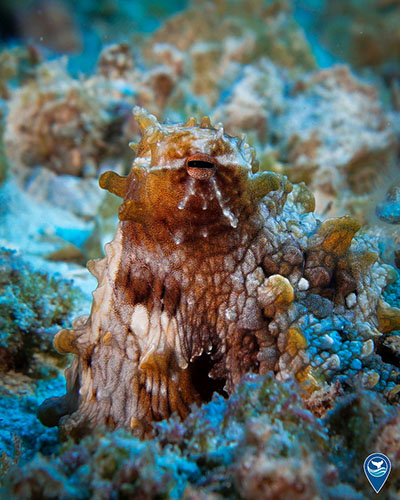
Hide-and-seek champion 🏆
Many cephalopods have special cells in their skin tissue called chromatophores that enable them to change color very rapidly. As a part of their neuromuscular system, these cells receive signals from the environment that an octopus can use to inform color change. Octopods of this particular species can change color almost instantly as they move over their environment, making them nearly invisible to predators!
Credit: Andrew Gray/NOAA

What's a coral, anyway -- animal, vegetable, or mineral?
Though they look like plants, corals are actually animals. Coral colonies are made up of hundreds or thousands of tiny creatures called polyps, which have tentacles that they use to capture food from the water. These polyps secrete a hard skeleton of limestone. Most corals also harbor an algae called zooxanthellae, which produce oxygen and food for the corals through photosynthesis. These zooxanthellae are also what give corals their vibrant colors. Look closely here and you can see the individual polyps on this coral in NOAA National Marine Sanctuary of American Samoa.

Using art to highlight our connection to national marine sanctuaries 🎨
Congratulations to the Sanctuaries at Home 1st Place Winner of the 2022 Get Into Your Sanctuary Photo Contest, Alison Hibbert!

The majestic views of your National Marine Sanctuary System 😍
Congratulations to our Sanctuary Views 1st place winner, Leighton Lum!

“Photographing and sharing moments from our national marine sanctuaries just feels right to me. These spaces are protected for the beauty they hold and the life they sustain, and everyone should have the opportunity to experience that–past, present, and future.” -Dustin Harris
Congratulations to our Sanctuary Recreation 1st place winner, Dustin Harris for capturing how to #RecreateResponsibly!

Flamingo tongue snails in NOAA Florida Keys National Marine Sanctuary are fashion icons. They wore leopard print before it was trendy! The patterns themselves aren't actually on the snail's shell. Instead the snail covers its white shell with a live tissue, which bears its distinctive color and markings.
Congratulations to our Sanctuary Life 1st place winner, Daryl Duda for capturing this awesome image of Florida Keys marine life!

The sun shines a little brighter when you're trying to wake up after vacation over the holidays 😴
Welcome to 2023! We hope you had a wonderful holiday season.

The morning has dawned on a new year! 🌄
January 1st is the time to make resolutions for the new year, so why not resolve to visit a national marine sanctuary? Hawaiian Islands Humpback Whale National Marine Sanctuary is filled with an abundance of marine life, breathtaking views, and gorgeous landscapes. Could this be the sanctuary to start your resolution with?
Credit: Susan Bryan (2022 GIYS Photo Contest Submission)

Have you ever attended one of our webinars?
The National Marine Sanctuaries Webinar Series provides educators, students, and the interested public with educational and scientific expertise, resources and training to support ocean and climate literacy.
Congratulations to our Submerged NC Webinar Series attendee and 2nd place Sanctuaries at Home winner, Mirjam P. Spaar! Mirjam captured the moment when Dr. John Broadwater was discussing the turret’s surfacing on that amazing day 20 years ago in NOAA Monitor National Marine Sanctuary.

One of the most beautiful meetings of land and sea 🌎
Our Sanctuary Views 2nd place winner is Rich Formica for capturing this gorgeous shot of NOAA's Monterey Bay National Marine Sanctuary!
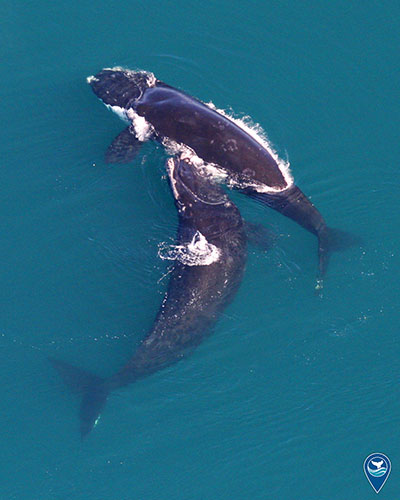
It’s a special anniversary today! 🎉
The National Marine Sanctuaries Act is not the only piece of legislation that’s important to your sanctuaries. On this day, December 28, the #EndangeredSpeciesAct was signed in 1973. Considered to be one of the world’s strongest conservation laws, the ESA provides a framework to conserve and protect endangered and threatened species and their habitats.

It’s a special anniversary today! 🎉
The National Marine Sanctuaries Act is not the only piece of legislation that’s important to your sanctuaries. On this day, December 28, the #EndangeredSpeciesAct was signed in 1973. Considered to be one of the world’s strongest conservation laws, the ESA provides a framework to conserve and protect endangered and threatened species and their habitats.

"Now that I have been here for about thirty years, I live to protect Monterey Bay, while photographing and spending as much time there as humanly possible. Monterey Bay changed my life forever.” -John F. Hunter
NOAA's Monterey Bay National Marine Sanctuary offers picturesque spots for memories you'll cherish forever. Join us in congratulating our Sanctuary Recreation 2nd place winner, John F. Hunter!

“As a photographer, I am so fortunate to see the beauty that surrounds us. We need to be much more aware of the delicate balance of life in this fragile environment. I hope my photographs will inspire others to appreciate our wonderful ecosystem, and become more involved in cherishing and preserving its breathtaking views!” -Jack Louden
Congratulations to our Sanctuary Life 2nd place winner, Jack Louden, for this incredible shot in NOAA Florida Keys National Marine Sanctuary!

Oh Christmas tree, oh Christmas tree…worms? 🎄
Christmas tree worms like these in NOAA's Flower Garden Banks National Marine Sanctuary burrow into coral, but leave two tree-like crowns protruding. These crowns are used for respiration and to catch a nice holiday dinner, in the form of microscopic phytoplankton.
Worm wishes this holiday season from your National Marine Sanctuary System!
Image credit: Steve Miller

NOAA is establishing an advisory council for the proposed Hudson Canyon National Marine Sanctuary. The council provides NOAA's Office of National Marine Sanctuaries with advice and recommendations on the management of the sanctuary. Council members also act as liaisons to their communities, building a strong connection between the sanctuary and stakeholders. The deadline for applications is January 31, 2023. Apply now!

Chinese migrants to America have made many contributions to American history in the West; the story of the transcontinental railroad being a well-known example. However, the history of fisheries and maritime past is often more difficult to grasp, being less well-documented and sometimes unseen from shore. Many Chinese sailors and fishermen crossed the Pacific and continued their traditional lifestyles—fishing from coastal villages amidst California’s wealth of marine resources. This Chinese fishing heritage is remembered by families and descendants today.
Credit: Lisa Carpenter, Get Into Your Sanctuary Photo Contest 2018 entry

Last call for Dr. Nancy Foster Scholarship applications! 📝
The Dr. Nancy Foster Scholarship Program provides support for advanced degrees in ocean and coastal studies and particularly encourages women and members of minority groups to apply.
Complete applications are due Thursday, December 22, 2022 at 11:59 pm Eastern

Congratulations to our Sanctuaries at Home 3rd Place Winner, Bruce Sudweeks, for showing us how beautiful artwork allows us to connect with national marine sanctuaries from afar.

A unique perspective of Olympic Coast National Marine Sanctuary 😍
Congratulations to the Sanctuary Views 3rd Place Winner of the 2022 Get Into Your Sanctuary Photo Contest, Allison Formica.

“I try to bring people out on the boat who are not familiar with the beauty of the islands and the wildlife. We collect trash while we are out there and I feel as if I can model respect for nature and get them excited about taking care of our planet. The more people I can introduce to the idea of conservation and appreciation for the beauty right off of our coast, the more people may think twice before littering, buying single-use plastic, or balloons. Seeing the look of joy in the faces of my friends when we see cetaceans or pick up trash never gets old.” -Jessie Simon
Congratulations to the Sanctuary Recreation 3rd Place Winner of the 2022 Get Into Your Sanctuary Photo Contest, Jessie Simon.

It is time to show off the 2022 Get Into Your Sanctuary Photo Contest winners! 📸
Our Sanctuary Life category 3rd place spot goes to this lunge feeding humpback whale photographed by Douglas Croft in NOAA's Monterey Bay National Marine Sanctuary.

A tropical paradise in the Pacific—NOAA National Marine Sanctuary of American Samoa—offers a unique opportunity for researchers to observe ocean and coral reef ecosystems that are largely considered to be remote, yet still experience pressure from humans.
National Oceanic and Atmospheric Administration (NOAA) has just released the first condition report for the sanctuary since it was expanded a decade ago. In the report, NOAA states that the overall condition of sanctuary resources is good, however there is evidence that climate change effects, such as coral bleaching and coastal erosion, are threatening habitats, resources, and ecosystem services.
Credit: Wendy Cover/NOAA
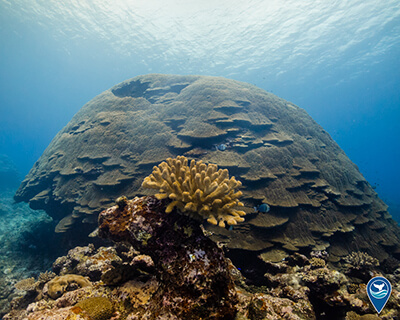
A tropical paradise in the Pacific—NOAA National Marine Sanctuary of American Samoa—offers a unique opportunity for researchers to observe ocean and coral reef ecosystems that are largely considered to be remote, yet still experience pressure from humans.
National Oceanic and Atmospheric Administration (NOAA) has just released the first condition report for the sanctuary since it was expanded a decade ago. In the report, NOAA states that the overall condition of sanctuary resources is good, however there is evidence that climate change effects, such as coral bleaching and coastal erosion, are threatening habitats, resources, and ecosystem services.
Credit: Nerelle Que Moffitt

Apply now! NOAA is seeking applications to fill 20 seats for the Marine and Coastal Area-based Management Advisory Committee.
This new committee will advise NOAA on science-based approaches to area-based protection, conservation, restoration, and management in coastal and marine areas, including the Great Lakes. The Advisory Committee’s scope will also include NOAA’s implementation of the Biden-Harris Administration’s America the Beautiful Initiative.

For nine years, NOAA’s Office of National Marine Sanctuaries has recognized outstanding achievement by presenting the Sea to Shining Sea Award for Excellence in Interpretation and Education. The award recognizes success in advancing ocean and climate literacy and conservation through national marine sanctuaries. It also recognizes innovation and creative solutions to raising public awareness and appreciation of the National Marine Sanctuary System.
This year, the award is presented to Justin Umholtz, Coral Check-Up Lesson Series and Climate Change Resilience Workshop. Congratulations Justin!
Credit: Justin Umholtz

Celebrate the start of #CoralsWeek by diving into an undersea rainbow! 🤿💦
This beautiful coral reef, known as Fagatele Bay, is located within NOAA National Marine Sanctuary of American Samoa. Here in Fagatele Bay, you'll find at least 271 species of fishes, 168 species of coral, and at least 1,400 species of algae and invertebrates -- all in 0.25 square mile!

Shallow-water corals aren't the only corals in the sea! In deep waters, specially-adapted species of coral thrive. In turn, these corals provide habitat for other organisms, like shrimp, crabs, and fish. This bubblegum coral was spotted supporting a brittle star in Papahānaumokuākea Marine National Monument by the NOAA Office of Ocean Exploration and Research.
Credit: NOAA Office of Ocean Exploration and Research

This amazing, vibrant community of tunicates in NOAA Gray's Reef National Marine Sanctuary has an interesting tie to humans. Though they're invertebrates, tunicates are more closely related to vertebrates than most other invertebrate species.
Credit: Greg McFall/NOAA

How do you like your eggs? 🍳
For us, we prefer them swimming in NOAA's Monterey Bay National Marine Sanctuary!
This image isn't an actual swimming egg, it's an egg-yolk jelly, also known as the fried egg jellyfish. That yellow yolk-ish mass in the center is actually the jelly's reproductive tissue. Its thin white tentacles can hang up to 20 feet below the jelly’s bell, creating a drift net that can capture its prey. We recommend sticking to regular eggs for breakfast.
Credit: Josh Pederson/NOAA

A whale of a tale – or a tail of a whale? 🐋
Humpback whale tails, or flukes, can be up to 5 meters across! That’s about as wide as a double-decker bus is tall.
Every humpback whale has a distinctive pattern on its fluke. These patterns are so unique that they can be used to identify individual whales, just like a human fingerprint.
Credit: NOAA

Did someone say... more food?! 😱
We hope you had a wonderful Thanksgiving yesterday and continue to enjoy this holiday weekend with your loved ones and favorite family meals- like this Southern sea otter enjoying a red rock crab. YUM!
Credit: Douglas Croft

Did someone say... more food?! 😱
We hope you had a wonderful Thanksgiving yesterday and continue to enjoy this holiday weekend with your loved ones and favorite family meals- like this Southern sea otter enjoying a red rock crab. YUM!
Credit: "Mike" Michael L. Baird

When I'm telling a really good story at the dinner table and a family member interrupts me #HappyThanksgiving #WildSanctuaries
Credit: Mike Baird/NOAA

My siblings and I rushing to the dinner table when we hear someone say, "Dinner's ready!" #HappyThanksgiving #WildSanctuaries
Photo taken under NOAA permit #20519. Credit: Douglas Croft

Happy Thanksgiving from your National Marine Sanctuary System!
From our amazing volunteers to the incredible biodiversity of species, recreational opportunities on the ocean and Great Lakes, to ongoing research and conservation efforts, we have so much to be thankful for this year. It’s only with your support that we can successfully protect our nation’s precious marine ecosystems, and we are thankful for you. What are you thankful for?
Credit: Greg McFall/NOAA
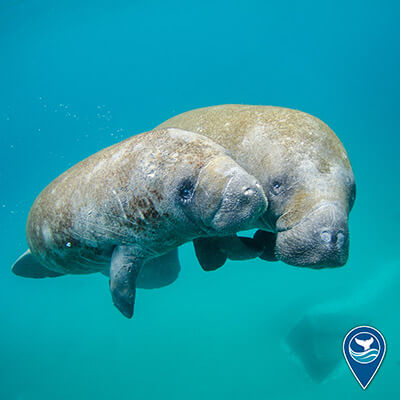
Celebrate #ManateeAwarenessMonth with us by showing these gentle friends some love. In the winter months, these mammals can be found grazing in the shallow waters of NOAA Florida Keys National Marine Sanctuary. Manatees are slow-moving and therefore unable to swim quickly away from boats, resulting in collisions. In areas that are known manatee habitats, be sure to slow down and keep an eye out!
Encountering wildlife can be a once-in-a lifetime opportunity! For their safety as well as yours, please follow these guidelines, give wildlife plenty of space, be aware of local regulations and use your zoom lens or binoculars if you want that close-up view!
Credit: Sam Farkas

A main character moment ✨
We are excited to welcome @flowergardenbanksNMS to Instagram! Visit their page for more information and stunning photography from this marine oasis located 80-125 miles from the Texas and Louisiana coastlines.
Credit: Kevin Lino/NOAA

A main character moment ✨
We are excited to welcome @flowergardenbanksNMS to Instagram! Visit their page for more information and stunning photography from this marine oasis located 80-125 miles from the Texas and Louisiana coastlines.
Credit: G.P. Schmahl/NOAA

A main character moment ✨
We are excited to welcome @flowergardenbanksNMS to Instagram! Visit their page for more information and stunning photography from this marine oasis located 80-125 miles from the Texas and Louisiana coastlines.
Credit: G.P. Schmahl/NOAA

A main character moment ✨
We are excited to welcome @flowergardenbanksNMS to Instagram! Visit their page for more information and stunning photography from this marine oasis located 80-125 miles from the Texas and Louisiana coastlines.
Credit: Greg McFall/NOAA

Sundays are for sleeping in 💤
Wishing you a wonderful weekend from NOAA's Office of National Marine Sanctuaries!
Photo credit: Matt McIntosh/NOAA

We're sharing some of our favorite American Indian/Alaska Native Heritage Month features from recent years. Last year's web story "Elevating Chumash Values and Traditional Ecological Knowledge at Channel Islands National Marine Sanctuary" features an interview with Alicia Cordero, First Nations Program Officer of the Wishtoyo Chumash Foundation. Pictured here, the Limuw community onshore prays and sings for the safety of the paddlers and the health of the ocean. For paddlers, every pull of the paddle through the waters is a prayer.
Photo credit: Robert Schwemmer/NOAA

Today, we honor and celebrate our Veterans.
The National Marine Sanctuary System connects with our nation’s wartime past through maritime history and preservation of wrecks from the USS Conestoga to the ironclad USS Monitor. The National Marine Sanctuary System also provides a place for volunteers, employees, and community members who have served our country to recreate and enjoy. We want to thank service members, and their families, for their dedication to our nation.
Photo credit: Lisa Uttal/NOAA

Today, we honor and celebrate our Veterans.
The National Marine Sanctuary System connects with our nation’s wartime past through maritime history and preservation of wrecks from the USS Conestoga to the ironclad USS Monitor. The National Marine Sanctuary System also provides a place for volunteers, employees, and community members who have served our country to recreate and enjoy. We want to thank service members, and their families, for their dedication to our nation.
Photo credit: Karen Grimmer/NOAA

Did you know that jellies, like this one swimming in NOAA Gray's Reef National Marine Sanctuary, are 95% water? Lacking brains, jellies have only an elementary nervous system, known as a nerve net, that allows them to smell, detect light and respond to other stimuli.
Photo credit: Greg McFall/NOAA

How do sea stars get around? With tube feet! In this close-up of a sunflower star in NOAA's Monterey Bay National Marine Sanctuary, you can see how it uses its tube feet to explore the world around it. In addition to locomotion, sea stars use their tube feet to pass food toward their mouth.
Photo credit: Steve Lonhart/NOAA

Each winter, thousands of humpback whales travel to Hawaiian Islands Humpback Whale National Marine Sanctuary to find mates, calve, and nurse their young. Scientists estimate that up to 12,000 whales—more than half of the North Pacific humpback population—return to Hawaiian waters from November through May. Mothers can be seen breaching alongside their calves and males can be seen competing with one another for females in fierce head-to-head battles.
Photo credit: Ed Lyman/NOAA, under NOAA permit #774-1714

Who are we? Let's start the next 50 years of sanctuaries by re-introducing ourselves! NOAA Office of National Marine Sanctuaries is the official government trustee for the spectacular network of our nation’s underwater parks that makes up the National Marine Sanctuary System. This includes 15 national marine sanctuaries and two marine monuments, encompassing over 620,000 square miles of marine and Great Lakes waters. Learn more at sanctuaries.noaa.gov.
We work closely with National Marine Sanctuary Foundation, the only national #nonprofit that directly supports conservation, research, and education projects in the National Marine Sanctuary System. Learn more at marinesanctuary.org.

Who are we? Let's start the next 50 years of sanctuaries by re-introducing ourselves! NOAA Office of National Marine Sanctuaries is the official government trustee for the spectacular network of our nation’s underwater parks that makes up the National Marine Sanctuary System. This includes 15 national marine sanctuaries and two marine monuments, encompassing over 620,000 square miles of marine and Great Lakes waters. Learn more at sanctuaries.noaa.gov.
We work closely with National Marine Sanctuary Foundation, the only national #nonprofit that directly supports conservation, research, and education projects in the National Marine Sanctuary System. Learn more at marinesanctuary.org.

Dangerously low oxygen levels are killing Dungeness crabs off the Pacific Northwest Coast, including NOAA Olympic Coast National Marine Sanctuary. Scientists are undertaking a collaborative project to understand the impacts and relationships of the multiple stressors involved in order to shape the future of ocean science and fisheries management in the region.
Credit: Wendy Cover/NOAA

Coral bleaching events are currently occurring worldwide. It's up to all of us to work together to reduce our fossil fuel usage so that we can protect corals and other ocean inhabitants. Together, we can support alternative energy initiatives, like solar solutions, that will help protect coral reefs.
What is coral bleaching?
Corals require specific temperature ranges, and when water temperatures become too high, stressed corals often expel the colorful algae they depend on to survive -- this is known as coral bleaching. Recently, our actions have led to warmer water temperatures across the globe. When we burn fossil fuels like oil and gas to power our homes and fuel our cars, we release carbon dioxide into the atmosphere. This carbon dioxide builds up and acts like a heat-trapping blanket, warming our planet, including the ocean.
Credit: Wendy Cover/NOAA

Join us for a voyage of time and tide, and explore the story of your National Marine Sanctuary System.
Credit: NOAA

Spread the coastal love 🌊
We're sharing 50 ways to love your ocean and coasts just in time for our 50th anniversary. Missed
any of our tips? Check out our Instagram Guide.
49. Take photos!
Help spread love for the coast by showcasing its beauty. You get to spend time outdoors and enjoy
sharing what you experienced with others.
50. Have fun.
From beach volleyball to meditation, the coast has a lot to offer, so get out there and enjoy it!
Those who love the beach are more likely to protect it, so invite others to join you as well.
Credit: Claire Fackler/NOAA

Celebrate a birthday, special occasion, or holiday more sustainably by following these tips:
45. Don’t buy products or food made from rare or endangered marine animals.
46. Make festive decorations out of reusable or natural materials.
47. Skip the store-bought wrapping paper.
48. Give gifts that don’t need to be wrapped.
Credit: Greg McFall/NOAA

Indigenous peoples have been relying on and stewarding ocean areas for millennia. Today, national marine sanctuaries work closely with Native American tribes and nations to protect our natural heritage.
In this image, members of the Chumash community journey from the California mainland to Limuw, or Santa Cruz Island. Paddlers, or pullers, voyage using a tomol, a traditionally-built redwood plank canoe. It has a six-person crew, and unique abalone inlay designs. Along their way, the pullers travel through Channel Islands National Marine Sanctuary. They are supported by the sanctuary’s Research Vessel Shearwater, which sets course, hosts resting paddlers, and helps protect the tomol and its pullers from vessel traffic.
Preserving and collaborating with indigenous cultures is a critical part of our mission: celebrating the great variety of human connections to the sea can help us all become better stewards of our ocean resources. Join us in celebrating the traditions and cultures of Indigenous communities across the country!
Credit: Robert Schwemmer/NOAA

We can't wait to celebrate our 50th anniversary on October 23, 2022! Leading up to the celebration,
we are sharing ways to love your ocean and coasts. Check out these five tips for supporting wildlife.
Follow along as we count up to 50 this month!
Supporting wildlife:
40. Put your stamp on conservation. Consider purchasing a Federal Duck Stamp to support migratory
birds and habitat conservation across the National Wildlife Refuge System.
41. Safeguard wildlife by purchasing a Save Vanishing Species Stamp.
42. Know how to report stranded or hurt marine mammals or sea turtles.
43. Adopt an animal symbolically.
44. Take the Wildlife Pledge by visiting
Credit: Douglas Croft

We're sharing some of our favorite #HispanicHeritageMonth features from recent years. 2017's web story "The Art of Playing Well: Celebrating National Hispanic Heritage Month in Sanctuaries" discusses how the National Marine Sanctuary System is trying to reach more diverse communities. Pictured here, several elementary school students point toward a surfacing humpback whale during a July 2017 whale watching trip.
Credit: NOAA

We're sharing some of our favorite #HispanicHeritageMonth features from recent years. 2017's web story "The Art of Playing Well: Celebrating National Hispanic Heritage Month in Sanctuaries" discusses how the National Marine Sanctuary System is trying to reach more diverse communities. Pictured here, several elementary school students point toward a surfacing humpback whale during a July 2017 whale watching trip.
Credit: Anne Smrcina/NOAA

This #WorldTeachersDay, we give recognition to the exceptional educators throughout the world that foster and inspire generations of scientists, experts, and lifelong learners. From all of us at NOAA's Office of National Marine Sanctuaries, thank you for everything you do!
Credit: Amity Wood/NOAA

Test your knowledge for #TwoTruthsTuesday! This photo was taken in Papahānaumokuākea Marine National Monument. Which statement about the red-footed booby isn't true? Type your answer in the comment section below.
- Red-footed boobies are pelagic birds that only coming ashore to breed.
- Red-footed boobies dive from the sky to feed on fish.
- Red-footed boobies are the largest booby.
Credit: Mark Sullivan/NOAA

As America's premier ocean park network, the National Marine Sanctuary System wants to make sure every American has access to and can enjoy their national marine sanctuaries and the other waters of the nation.
During #NationalDisabilityEmploymentAwarenessMonth, we recognize the efforts of our staff and partners to help ensure that ocean sports and recreation, and our facilities, programs, and information are available to all.
Credit: Presidio of Monterey

We're sharing some of our favorite Hispanic Heritage Month features from recent years. 2018's story map "National Hispanic Heritage Month in National Marine Sanctuaries" tells of Hispanic American leaders, caretakers, and inspirers associated with places that are protected as national marine sanctuaries. Pictured here, some young adventurous kayakers return from a trip organized by NOAA Channel Islands National Marine Sanctuary.
Credit: Claire Fackler/NOAA

Your National Marine Sanctuary System is filled with spectacular opportunities to play beside, above, on, in, and under the water.
#DidYouKnow that playing offers a variety of benefits other than just enjoyment? These benefits include learning social skills and bonding, developing physical coordination, strengthening creativity and other mental skills, practicing natural behaviors important as survival skills for adults, and managing stress.
Credit: Bruce Sudweeks - 2020 GIYS Photo Contest 1st Place Winner: Sanctuary Recreation

Look at that smile 😁 Do you know which of these three statements about sand tiger sharks isn't true?
- These large sharks may be toothy, but they’re actually quite docile.
- Sand tiger sharks are unique among sharks in that they often come to the ocean surface to gulp air.
- Sand tiger sharks are commonly found near coral reefs and in the open ocean.
Credit: Greg McFall/NOAA

Every week leading up to our 50th anniversary, we are sharing ways to love your ocean and coasts. Follow along as we count up to 50!
Volunteering:
14. Participate in a stream, river, or beach clean up.
15. Contribute your expertise and ideas.
16. Volunteer.
In the garden:
17. Plant native species in your garden.
18. Make your own compost.
19. Use green infrastructure wherever you can.
On vacation:
20. Vacation coast-smart.
21. Learn how to safely enjoy wildlife viewing at the ocean.
22. Lights out for turtles!
23. Leave seashells on the beach.
At play:
24. Explore recreational opportunities on public lands and waters.
25. Take up a new sport or pastime.
26. Play wisely.
27. Consider the impact of coast-dependent businesses.
28. Go on a virtual expeditions.
29. Go on a virtual dive.
30. Visit your local aquarium or nature center.
31. Visit a coastal park.
32. Familiarize yourself with coastal management laws and policies.
Stay tuned next week for more tips to give back to the planet. 🌎
Credit: Tane Casserly/NOAA

We're sharing some of our favorite #HispanicHeritageMonth features from recent years. Last year's web story "Ballena! Pescado! Santuario! Hispanic Communities Register High Interest in Marine Conservation and Access to the Ocean" shares the story of how Stellwagen Bank National Marine Sanctuary uses whale watching to help engage the Dominican communities of coastal Massachusetts in ocean stewardship.
Credit: Anne Smrcina/NOAA

Happy #SeaOtterAwarenessWeek! What better way to celebrate than with #TwoTruthsTuesday?
Do you know which of these three statements isn't true about the sea otter? Let us know in the comments!
- Sea otters are a keystone species.
- Sea otters have more fur per square inch than any other mammal.
- NOAA's Monterey Bay National Marine Sanctuary is the only national marine sanctuary sanctuary that sea otters inhabit.
Credit: Norbert Wu

We're sharing 50 ways to love your ocean and coasts! Whether you're at home, at work, or out and about- everyone can support ocean and coast conservation, with acts that are big and small.
At home and at work:
- Conserve energy
- Reduce water use at home.
- Reduce the use of paper products to help save trees.
- Reduce your commuting carbon footprint.
- Be careful when disposing of hazardous polluting materials.
- Maximize and reduce waste
- Plan for emergencies.
- >Reduce your plastics when you have the opportunity to do so.
Out and about:
- Shop local
- Consider buying sustainable seafood.
- Support the use of natural infrastructure in your community.
- Use a reusable water bottle instead of buying a single use one whenever possible.
- When shopping, bring your own reusable bags.
Stay tuned next week for more tips to give back to the planet. 🌎
Credit: Robert Schwemmer/NOAA

Today is the International Coastal Cleanup!
Whether you’re participating in an organized cleanup event today or not, head out to your favorite beach today and do what you can to fight marine debris.
Not near a beach? You can still help keep our ocean clean by keeping your local streams and rivers clear of trash, using reusable shopping bags and drink containers and spreading the word about the importance of maintaining a clean and healthy ocean
Credit: NOAA

Today is the International Coastal Cleanup!
Whether you’re participating in an organized cleanup event today or not, head out to your favorite beach today and do what you can to fight marine debris.
Not near a beach? You can still help keep our ocean clean by keeping your local streams and rivers clear of trash, using reusable shopping bags and drink containers and spreading the word about the importance of maintaining a clean and healthy ocean
Credit: Ryan Tabata/NOAA

Apply to be a member of the Wisconsin Shipwreck Coast National Marine Sanctuary Advisory Council!
In August of 2021, NOAA announced the designation of Wisconsin Shipwreck Coast National Marine Sanctuary, a 962-square-mile area of Wisconsin’s Lake Michigan, adjacent to the communities of Two Rivers, Manitowoc, Sheboygan, and Port Washington. This is our nation’s 15th and newest marine sanctuary.
Now, NOAA is establishing a Sanctuary Advisory Council to provide advice and recommendations for the new sanctuary. Applications for the council will be accepted through October 1, 2022.
Credit: Tamara Thomsen/Wisconsin Historical Society

Happy #TwoTruthsTuesday! Join us for this week's two truths and a lie game featuring species on the #NationalMarineSanctuariesStamps.
Do you know which of these three statements isn't true about the California sea lion? Let us know in the comments!
- California sea lion males bark like dogs to communicate with other males and females.
- The typical lifespan of a California sea lion is 45 years.
- Adult males are generally larger than females and are mostly dark brown to black in color.
Credit: Jeff Harris/NOAA

Headed #BackToSchool? Check out our newly released educational resources!
In celebration of the 50th anniversary of the National Marine Sanctuary System, we have some great educational material for teachers and students to incorporate ocean science, conservation, and stewardship throughout the upcoming school year. Engage your audience to help us #SaveSpectacular.
Credit: Claire Fackler/NOAA

Learn about the species featured on #NationalMarineSanctuariesStamps by playing #TwoTruthsTuesday!
Do you know which of these three statements isn't true about Atlantic sea nettles found in Gray's Reef National Marine Sanctuary? Let us know in the comments!
- Atlantic sea nettles only eat zooplankton.
- Atlantic sea nettles have stinging tentacles that can grow up to 20 inches long.
- Atlantic sea nettles have very few predators.
Credit: Michael Durham

How do you connect with your National Marine Sanctuary System from afar?
Submit your ocean-related photos, taken at home or anywhere else in the world, to the “Sanctuaries at Home” category of our Get Into Your Sanctuary Photo Contest. Our contest closes this Monday, September 5.
Credit: Zalak Ghanshyambhai Sabapara (2021 3rd Place - Sanctuaries at Home)

Ready for your next camping adventure? 🏕
Check out these tips to help plan camping and adventure itineraries in some of America’s most treasured land and sea places: national parks and national marine sanctuaries. The sample itineraries are based on a three-day primitive camping trip, with recommendations for things to do if you have more than three days to camp, learn, play, and explore.
Credit: Matt McIntosh/NOAA

Happy #SealWeek! What better way to celebrate than with a Hawaiian monk seal feature on #TwoTruthsTuesday.
Do you know which of these three statements isn't true about the Hawaiian monk seal? Let us know in the comments!
- The Hawaiian monk seal is one of the most endangered seal species in the world.
- Hawaiian monk seals can hold their breath for up to 20 minutes and dive more than 1,800 feet.
- Male Hawaiian monk seals are typically much larger than female Hawaiian monk seals, which makes them easy to distinguish. Check out the Hawaiian monk seal on the #NationalMarineSanctuariesStamps!
Check out the Hawaiian monk seal on the #NationalMarineSanctuariesStamps!
Credit: Ed Lyman/NOAA under NOAA permit 15240

Everything that you might need, we've got inside for you! 🎶🎒
Check out our topically-based resource collections, featuring NOAA videos, lesson plans, webinars, web stories, virtual reality, and much more.
Topics include:
- Whales
- Coral Reef Ecosystems
- Ocean Acidification
- Birds
- Kelp Forests
- Ocean Sound and Impact of Noise
- Shipwrecks
Credit: NOAA

Everything that you might need, we've got inside for you! 🎶🎒
Check out our topically-based resource collections, featuring NOAA videos, lesson plans, webinars, web stories, virtual reality, and much more.
Topics include:
- Whales
- Coral Reef Ecosystems
- Ocean Acidification
- Birds
- Kelp Forests
- Ocean Sound and Impact of Noise
- Shipwrecks
Credit: Claire Fackler/NOAA

Everything that you might need, we've got inside for you! 🎶🎒
Check out our topically-based resource collections, featuring NOAA videos, lesson plans, webinars, web stories, virtual reality, and much more.
Topics include:
- Whales
- Coral Reef Ecosystems
- Ocean Acidification
- Birds
- Kelp Forests
- Ocean Sound and Impact of Noise
- Shipwrecks

Everything that you might need, we've got inside for you! 🎶🎒
Check out our topically-based resource collections, featuring NOAA videos, lesson plans, webinars, web stories, virtual reality, and much more.
Topics include:
- Whales
- Coral Reef Ecosystems
- Ocean Acidification
- Birds
- Kelp Forests
- Ocean Sound and Impact of Noise
- Shipwrecks
Credit: Greg McFall/NOAA

Everything that you might need, we've got inside for you! 🎶🎒
Check out our topically-based resource collections, featuring NOAA videos, lesson plans, webinars, web stories, virtual reality, and much more.
Topics include:
- Whales
- Coral Reef Ecosystems
- Ocean Acidification
- Birds
- Kelp Forests
- Ocean Sound and Impact of Noise
- Shipwrecks
Credit: J. Moore/NOAA, under NOAA permit #15240

Everything that you might need, we've got inside for you! 🎶🎒
Check out our topically-based resource collections, featuring NOAA videos, lesson plans, webinars, web stories, virtual reality, and much more.
Topics include:
- Whales
- Coral Reef Ecosystems
- Ocean Acidification
- Birds
- Kelp Forests
- Ocean Sound and Impact of Noise
- Shipwrecks
Credit: Robert Schwemmer/NOAA

Show us your best views 😍
Credit: Douglas Croft (2021 3rd Place - Sanctuary Views)

You have 10 days left to submit your photos to our Get Into Your Sanctuary Photo Contest 📸
Credit: Mark Losavio (2021 3rd Place - Sanctuary Recreation)

Your National Marine Sanctuary System can be enjoyed by everyone—whether in person, virtually, or through your taste buds! 🐟
Get out on the water and try your hand at a sustainably caught fresh catch or simply stop in to one of the many locally-owned restaurants that serve up their local best from the waters in and around national marine sanctuaries.
Credit: NOAA Fisheries/Jeff McClean, GARFO

Happy #TwoTruthsTuesday! Join us by playing two truths and a lie, featuring species on the #NationalMarineSanctuariesStamps.
Do you know what national marine sanctuary the queen angelfish typically does not inhabit?
- NOAA's Flower Garden Banks National Marine Sanctuary
- NOAA Florida Keys National Marine Sanctuary
- NOAA's Monterey Bay National Marine sanctuary
Credit: G.P. Schmahl

🎶 I always feel like somebody’s watching me…
We are accepting submissions for this year's contest until September 5, 2022. Send us your best photos of sanctuary inhabitants like birds, fish, marine mammals, and other amazing ocean creatures by submitting photos in the “Sanctuary Life” category.
Credit: Kimberly Jeffries (2021 3rd Place - Sanctuary Life)

Photography is an amazing way to enjoy and preserve nature, and your national marine sanctuaries are the perfect place to experience the wildlife that lives around us. Taking photos is a special way to view Earth because it allows us to observe creatures or scenes in a much more detailed way through a still frame.
Celebrate #WorldPhotographyDay by going outside and taking advantage of all that our beautiful sanctuaries have to offer.
Credit: James Moskito

Photography is an amazing way to enjoy and preserve nature, and your national marine sanctuaries are the perfect place to experience the wildlife that lives around us. Taking photos is a special way to view Earth because it allows us to observe creatures or scenes in a much more detailed way through a still frame.
Celebrate #WorldPhotographyDay by going outside and taking advantage of all that our beautiful sanctuaries have to offer.
Credit: Dennis Segers

Photography is an amazing way to enjoy and preserve nature, and your national marine sanctuaries are the perfect place to experience the wildlife that lives around us. Taking photos is a special way to view Earth because it allows us to observe creatures or scenes in a much more detailed way through a still frame.
Celebrate #WorldPhotographyDay by going outside and taking advantage of all that our beautiful sanctuaries have to offer.
Credit: Russell Wilkins

Photography is an amazing way to enjoy and preserve nature, and your national marine sanctuaries are the perfect place to experience the wildlife that lives around us. Taking photos is a special way to view Earth because it allows us to observe creatures or scenes in a much more detailed way through a still frame.
Celebrate #WorldPhotographyDay by going outside and taking advantage of all that our beautiful sanctuaries have to offer.
Credit: Dustin Harris

Photography is an amazing way to enjoy and preserve nature, and your national marine sanctuaries are the perfect place to experience the wildlife that lives around us. Taking photos is a special way to view Earth because it allows us to observe creatures or scenes in a much more detailed way through a still frame.
Celebrate #WorldPhotographyDay by going outside and taking advantage of all that our beautiful sanctuaries have to offer.
Credit: Joyce Hsieh

Sail through the breathtaking scenery of the Channel Islands ⛵️
Close to the California mainland, yet worlds apart, NOAA Channel Islands National Marine Sanctuary and Channel Islands National Park encompass the ocean environment and five of the eight California Channel Islands (Anacapa, Santa Cruz, Santa Rosa, San Miguel, and Santa Barbara). The islands' remote, isolated position at the confluence of two major ocean currents creates remarkable biodiversity. The Channel Islands offer adventure and breathtaking scenery just 100 miles from Los Angeles.
Credit: Robert Schwemmer/NOAA

Sail through the breathtaking scenery of the Channel Islands ⛵️
Close to the California mainland, yet worlds apart, NOAA Channel Islands National Marine Sanctuary and Channel Islands National Park encompass the ocean environment and five of the eight California Channel Islands (Anacapa, Santa Cruz, Santa Rosa, San Miguel, and Santa Barbara). The islands' remote, isolated position at the confluence of two major ocean currents creates remarkable biodiversity. The Channel Islands offer adventure and breathtaking scenery just 100 miles from Los Angeles.
Credit: Claire Fackler/NOAA

Sail through the breathtaking scenery of the Channel Islands ⛵️
Close to the California mainland, yet worlds apart, NOAA Channel Islands National Marine Sanctuary and Channel Islands National Park encompass the ocean environment and five of the eight California Channel Islands (Anacapa, Santa Cruz, Santa Rosa, San Miguel, and Santa Barbara). The islands' remote, isolated position at the confluence of two major ocean currents creates remarkable biodiversity. The Channel Islands offer adventure and breathtaking scenery just 100 miles from Los Angeles.
Credit: Keith Berson

When I grow up, I want to be a marine scientist 🔬
Are you interested in studying marine science?
National marine sanctuaries are living classrooms that can be explored in person or through interactive digital labs and activities. Visit our education website for species profiles, games, online story books, information on marine careers, activities, free materials and other cool ocean education materials.
Credit: NOAA

Beauty above and below the surface 🌊
Credit: Matt McIntosh/NOAA

Just your neighborhood diver 🤿
Show us how you’re connecting to your National Marine Sanctuary System from home by submitting your pics to the “Sanctuaries at Home” category of our Get Into Your Sanctuary Photo Contest. Submissions to this category can include photos of stewardship activities from your home or neighborhood, or sanctuary-related artwork.
Credit: Jill Brown (2021 2nd Place - Sanctuaries at Home)

Smile! It's #TwoTruthsTuesday featuring species on #NationalMarineSanctuariesStamps!
Do you know which of these three statements isn't true about the balloonfish? Let us know in the comments!
- The dazzling smile of a balloonfish hides a set of powerful teeth that can crush the shells of snails, urchins, and crabs.
- Balloonfish are often encountered on night dives.
- Balloonfish swell up like a balloon when trying to attract a mate.
Credit: Daryl Duda

A Saturday well spent in your National Marine Sanctuary System ☀️
This summer, we will be featuring previous Get Into Your Sanctuary Photo Contest winners. Enter your best images of people responsibly enjoying national marine sanctuaries, whether they’re fishing, surfing, boating, kayaking, diving, swimming, conducting research, or just hanging out on the beach. Photos should be taken following CDC and local guidance. Submit these pics into the “Sanctuary Recreation” category.
Credit: Makerita Gebauer (2021 2nd Place Winner - Sanctuary Recreation)

Patiently waiting for the weekend 🙂
No weekend plans? Check out our 50th Anniversary events happening all summer long!
Credit: Emma Hickerson/NOAA

New Release: Bird Resource Collection
Birds are a vital part of marine ecosystems and valuable indicators of ecosystem health. The protected areas of the National Marine Sanctuary System serve as pit stops for many species of migratory bird, offering rest and food along their travels. Explore this new collection of NOAA videos, lesson plans, webinars, web stories, and much more.
Credit: NOAA

An open water diver’s paradise 😍
Gray’s Reef National Marine Sanctuary is one of the most popular spots off the Georgia coast for experienced diving. Encompassing one of the largest “live-bottom” reefs in the southeastern United States, Gray’s Reef is teeming with marine life - from the loggerhead turtles that rest at the reef, to the more than 200 fish species identified by scientists. Additionally, sea stars, octopuses, crabs, lobsters, soft corals, sharks, whelks, dolphins and thousands of other animals live among the ledges and slopes of Gray’s Reef.
Looking for the perfect place for an open water dive trip? This is the perfect opportunity to Get Into Your Sanctuary this summer.
Credit: Greg McFall/NOAA

An open water diver’s paradise 😍
Gray’s Reef National Marine Sanctuary is one of the most popular spots off the Georgia coast for experienced diving. Encompassing one of the largest “live-bottom” reefs in the southeastern United States, Gray’s Reef is teeming with marine life - from the loggerhead turtles that rest at the reef, to the more than 200 fish species identified by scientists. Additionally, sea stars, octopuses, crabs, lobsters, soft corals, sharks, whelks, dolphins and thousands of other animals live among the ledges and slopes of Gray’s Reef.
Looking for the perfect place for an open water dive trip? This is the perfect opportunity to Get Into Your Sanctuary this summer.
Credit: Greg McFall/NOAA

An open water diver’s paradise 😍
Gray’s Reef National Marine Sanctuary is one of the most popular spots off the Georgia coast for experienced diving. Encompassing one of the largest “live-bottom” reefs in the southeastern United States, Gray’s Reef is teeming with marine life - from the loggerhead turtles that rest at the reef, to the more than 200 fish species identified by scientists. Additionally, sea stars, octopuses, crabs, lobsters, soft corals, sharks, whelks, dolphins and thousands of other animals live among the ledges and slopes of Gray’s Reef.
Looking for the perfect place for an open water dive trip? This is the perfect opportunity to Get Into Your Sanctuary this summer.
Credit: Greg McFall/NOAA

An open water diver’s paradise 😍
Gray’s Reef National Marine Sanctuary is one of the most popular spots off the Georgia coast for experienced diving. Encompassing one of the largest “live-bottom” reefs in the southeastern United States, Gray’s Reef is teeming with marine life - from the loggerhead turtles that rest at the reef, to the more than 200 fish species identified by scientists. Additionally, sea stars, octopuses, crabs, lobsters, soft corals, sharks, whelks, dolphins and thousands of other animals live among the ledges and slopes of Gray’s Reef.
Looking for the perfect place for an open water dive trip? This is the perfect opportunity to Get Into Your Sanctuary this summer.
Credit: Greg McFall/NOAA

Explore national marine sanctuaries with your class!
Science in the middle grades should provide students with opportunities to enrich their growing knowledge of biodiversity. In this lesson, students will learn about the national marine sanctuaries found in the Pacific and Atlantic oceans and off the coast of American Samoa. They include breeding and feeding grounds of whales, sea lions, sharks, and sea turtles; significant coral reefs and kelp forest habitats; and the remains of the U.S.S. Monitor, a Civil War ironclad that sank off the coast of North Carolina. By learning about the biodiversity, ecological integrity, and cultural legacy of these marine sanctuaries, students can place into context what they are learning about the interdependence of living things on our planet.
Credit: Ellie Burck, Ocean for Life

“While I often think of our National Marine Sanctuaries as special underwater places, this sunset
heron reminded us that our sanctuaries are important habitats for species both on land and under the
water.”
-Michael Schilling
Credit: Michael Schilling (2021 2nd Place - Sanctuary Views)

How many outdoor games do you remember from your youth?
Tag, hide-and-seek, hopscotch, blind-man's bluff, Marco Polo... The list goes on! We thought it was all just fun—and it was—but we were also preparing ourselves for maturity, for being healthy, sociable, engaged adults.
Play is important, with experts now understanding that outside play, including water-based recreation, is crucial for children's development, for our continuing physical, mental, and emotional health as adults, and as a growing segment of our national economy.
Read on to learn more about how outside play, and the places where we play, shape us starting in our very earliest years.
Credit: David J. Ruck/NOAA

Looking for an impactful way to Get Into Your Sanctuary? Show our ocean and Great Lakes some love by leaving no trace when visiting, and helping out with a beach clean-up if you can!
Not near a beach? You can still help keep the ocean and Great Lakes clean by using reusable shopping bags and drink containers, and spreading the word about the importance of maintaining clean and healthy bodies of water.
No matter where you are, show us of how you #LeaveNoTrace and #RecreateResponsibly by submitting your photos to our Get Into Your Sanctuary Photo Contest.
Credit: NOAA

Test your knowledge about the animals found in your National Marine Sanctuary System 🌊
This week's #TwoTruthsTuesday feature is the brown pelican. Do you know which of these statements isn’t true about this beautiful bird?
- The brown pelican is the only species of pelican that dives for prey.
- >Brown pelicans can only be found on the west coast of the continental US, such as the one in this photo, taken in Monterey Bay National Marine Sanctuary.
- The brown pelican's distensible pouch can hold up to three gallons of water.
Credit: Douglas Croft

Sharks have been around for a long, long time – they evolved before the dinosaurs did, and their time on Earth even predates trees! Over these hundreds of millions of years, they’ve adapted key features that enable them to thrive in a variety of habitats.
Credit: Koa Matsuoka

Take only pictures 📸 Leave only bubbles 🤿
Snorkeling over a colorful coral reef is an amazing experience, so do your part to keep it that way for both people and wildlife!
Touching corals can remove their outer protective layer, spread infectious diseases, and expose them to foreign bacteria and oils on your fingers, which negatively impacts their health and can kill them.
And watch your flippers! Fragile, hard-bodied corals can break and die at the slightest touch, and stirred-up sediment can smother them. Coral reefs are home to some of the most venomous creatures on earth, including many that are known to produce toxins that can irritate, kill, or paralyze humans. Touching them could give you anything from a rash to a trip to the hospital. Help to protect yourself and preserve this fragile ecosystem for future generations by keeping your hands to yourself.
Credit: Greg McFall/NOAA

Take only pictures 📸 Leave only bubbles 🤿
Snorkeling over a colorful coral reef is an amazing experience, so do your part to keep it that way for both people and wildlife!
Touching corals can remove their outer protective layer, spread infectious diseases, and expose them to foreign bacteria and oils on your fingers, which negatively impacts their health and can kill them.
And watch your flippers! Fragile, hard-bodied corals can break and die at the slightest touch, and stirred-up sediment can smother them. Coral reefs are home to some of the most venomous creatures on earth, including many that are known to produce toxins that can irritate, kill, or paralyze humans. Touching them could give you anything from a rash to a trip to the hospital. Help to protect yourself and preserve this fragile ecosystem for future generations by keeping your hands to yourself.
Credit: Greg McFall/NOAA

Take only pictures 📸 Leave only bubbles 🤿
Snorkeling over a colorful coral reef is an amazing experience, so do your part to keep it that way for both people and wildlife!
Touching corals can remove their outer protective layer, spread infectious diseases, and expose them to foreign bacteria and oils on your fingers, which negatively impacts their health and can kill them.
And watch your flippers! Fragile, hard-bodied corals can break and die at the slightest touch, and stirred-up sediment can smother them. Coral reefs are home to some of the most venomous creatures on earth, including many that are known to produce toxins that can irritate, kill, or paralyze humans. Touching them could give you anything from a rash to a trip to the hospital. Help to protect yourself and preserve this fragile ecosystem for future generations by keeping your hands to yourself.
Credit: Wendy Cover/NOAA

Take only pictures 📸 Leave only bubbles 🤿
Snorkeling over a colorful coral reef is an amazing experience, so do your part to keep it that way for both people and wildlife!
Touching corals can remove their outer protective layer, spread infectious diseases, and expose them to foreign bacteria and oils on your fingers, which negatively impacts their health and can kill them.
And watch your flippers! Fragile, hard-bodied corals can break and die at the slightest touch, and stirred-up sediment can smother them. Coral reefs are home to some of the most venomous creatures on earth, including many that are known to produce toxins that can irritate, kill, or paralyze humans. Touching them could give you anything from a rash to a trip to the hospital. Help to protect yourself and preserve this fragile ecosystem for future generations by keeping your hands to yourself.
Credit: Greg McFall/NOAA

You know what day it is... It's #TwoTruthsTuesday!
Every Tuesday, we will provide you with two truths and one lie. Which of these three statements isn’t true about the northern elephant seal, found in NOAA's Greater Farallones National Marine Sanctuary?
- The northern elephant seal is the largest of the “true” seals in the Northern Hemisphere.
- >Northern elephant seals can reach weights of 2.5 tons. li>Northern elephant seals spend half their life in the ocean, and half on land.
Credit: Sara Heintzelman/NOAA

Dive deep with us during #HabitatMonth!
Explore the fascinating world of deep-sea corals and sponges and learn how national marine sanctuaries throughout the West Coast are working to protect these important deep-water communities for future generations.
Credit: NOAA

When someone asks me what time my alarm is set for tomorrow... 😖
Credit: Douglas Croft

The perfect photo doesn't exi- wait I think we found it.
This summer, we will be featuring previous Get Into Your Sanctuary Photo Contest winners. Enter your best images of people responsibly enjoying national marine sanctuaries, whether they’re surfing, boating, kayaking, diving, swimming, conducting research, or just hanging out on the beach. Photos should be taken following CDC and local guidance. Submit these pics into the “Sanctuary Recreation” category.
Credit: Anna Baker Mikkelsen (2021 1st Place Winner - Sanctuary Recreation)

Close your eyes and picture a shark. Any shark. What do you see? What do you hear?
Odds are, the first sound that comes to mind is dun dun, dun dun, the building strings of the Jaws theme song making the hairs on your arms stand on end. Perhaps the shark you picture is an enormous white shark coming toward you.
But the truth is, sharks are so, so much more than their scary reputation. These ancient ocean creatures began their evolutionary journey some 400 million years ago. All that time has given them plenty of opportunities to evolve into diverse animals that play key roles in ecosystems in your National Marine Sanctuary System and beyond. From tiny, five-inch pocket sharks to 40-foot whale sharks, sharks are as varied as they are amazing. And the truth is, we pose a whole lot more threat to them than they do to us.
Photo: George T. Probst

Okay I like it, Picasso. 🎨
Time to start planning what you're going to do in a national marine sanctuary this weekend! Need something to do? Check out our Get Into Your Sanctuary events for fun activities all summer long.
Photo: Christina Ford

The backbone of marine ecosystems on a fingertip 🌊
Krill may be tiny in stature, but they play a giant role in the ocean. At Cordell Bank National Marine Sanctuary, huge swarms of these little crustaceans provide a key source of food for many marine animals. Booming populations of krill are the backbone of many ocean ecosystems because they are a vital prey source of many larger species such as seals, whales, fish, and seabirds.
Photo: Sophie Webb/NOAA.
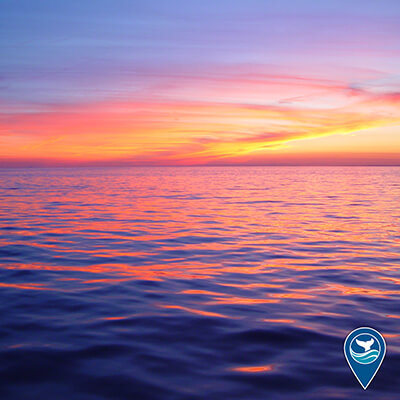
Sunday sunsets 🌅
There is something so satisfying about ending a weekend with this view over Stellwagen Bank National Marine Sanctuary. Is it the calmness of the water, the beautiful colors in the sky, the cool summer breeze? Find out by planning a trip to your National Marine Sanctuary System.
Photo: Anne Smrcina/NOAA

Staring contest... 3, 2, 1, GO!
This summer, we will be featuring previous Get Into Your Sanctuary Photo Contest winners. We are accepting submissions for this year's contest until September 5, 2022. Send us your best photos of sanctuary inhabitants like birds, fish, marine mammals, and other amazing ocean creatures by submitting photos in the “Sanctuary Life” category.
Photo: Yvonne P Wright (2021 1st Place Winner - Sanctuary Life)

There’s no need to fear, the superhero kids are here! 🌟
Superheroes are all around us, but they aren’t wearing capes or running at super speed. Instead, they’re passionate kids, using their voices and demanding to be heard, especially when it comes to sparking environmental change. This #CleanBeachesWeek (July 1-7), we’re sharing examples of how kids are making a difference in their communities (and beyond) as evidenced through research by Dr. Nancy Foster Scholar, Jenna Hartley.
Photo: Hank Carter

Your next summer adventure awaits! ☀️
When you think of your next great adventure, what sort of things come to mind? The beautiful thing about adventure, is that feeling you get leading up to and anticipating the event, and the other feeling you get when you finally get to do that thing you’ve been looking forward to for so long.
Being adventurous is all about embracing the unknown, in whichever form that is for you. Whether you're up for a surf trip, a weekend of fishing, scuba diving in a new place, taking the family camping, or having a peaceful retreat along the coast while exploring tide pools - no matter how you define a good adventure, there’s something for you in a national marine sanctuary.
Photo: Crystal Dombrow/NOAA - 2019 Get Into Your Sanctuary Photo

Our country is filled with magnificent adventures, breathtaking beauty, and special outdoor places ready to be explored. The ocean connects us in so many ways, from a food source to a recreation spot, to a learning opportunity. We take this time to appreciate our country's natural wonders and your connection not just to the ocean, but to each other.
We encourage you to spend some time outside today with loved ones and reconnect with your local waters- the positive physical and mental health benefits are endless. Gratitude, mindfulness, and focus on positivity are important practices that remind us to appreciate what we have and can contribute to a positive outlook on our life and our future.
From all of us at NOAA's Office of National Marine Sanctuaries, have a safe and wonderful Independence Day.
Photo: Sierra Rose Garcia - 2019 Get Into Your Sanctuary Photo

Out on the water this holiday weekend?
Part of the excitement of recreational fishing is not knowing what you will encounter. Keep these best practices in mind so you can be well-prepared for any situation.
Photo: RBFF

Now, that's what we call a view! 📸
This summer, we will be featuring previous Get Into Your Sanctuary Photo Contest winners. We are accepting submissions for this year's contest until September 5, 2022.
Photo: James Moskito (2021 1st Place Winner - Sanctuary Views)

Holy mola! It's the mola mola!
We are excited to announce our new series, #TwoTruthsTuesday. Every Tuesday, we will provide you with two truths and one lie. Can you guess which of these three statements isn’t true about the mola mola?
- Mola mola are the heaviest bony fish in the sea.
- As adults, mola mola are always found in a group, called a school of mola molas.
- "Mola mola" is the scientific name for this fish, commonly referred to as the ocean sunfish.
Let us know in the comments!
Photo: Marybeth Head/NOAA

Everyone remain calm.... it's #InternationalYogaDay!
Looking for more events to fill your summer with outdoor fun? Visit our 50th Anniversary Events webpage to hear what's happening in a national marine sanctuary near you.
Photo: Karlyn Langjahr/NOAA

Release the tent-sion with an amazing camping trip in your national marine sanctuaries ⛺️
Photo: David Ruck

Happy Father's Day!
#DidYouKnow: Seahorses and their close relatives are the only species in which the male gets pregnant and gives birth.
Photo: Patrick Malloy

Happy #NaturePhotographyDay! 📸
Looking for a place to take the perfect photo? National marine sanctuaries are a photographer's dream! Here, a photographer takes in the sunset at Olympic Coast National Marine Sanctuary. Thank you all for celebrating the natural beauty and wonder of your national marine sanctuaries!
Submit your photos to our Get Into Your Sanctuary Photo Contest until September 5, 2022.
Photo: Matt McIntosh/NOAA

Happy Flag Day!
#ThisDayInHistory: On June 14, 1777, the Continental Congress approved the design of a national flag. Since 1916, when President Woodrow Wilson issued a presidential proclamation establishing a national Flag Day on June 14, Americans have commemorated the adoption of the Stars and Stripes in many ways– displaying the flag in the front of their homes, parades, and other patriotic observances.
Photo: NOAA

Running through waves with your loved ones, what could be better?
Our public lands and waters are treasures for all to enjoy, and it is critical that our youth stay connected to the natural world. Reconnecting our children to nature is vitally important to developing tomorrow's leaders and stewards.
So, here is your daily reminder to take advantage of every opportunity to experience the outdoors, even just for a moment, and inspire your loved ones to do the same. Happy #GreatOutdoorsMonth! Celebrate with us by getting into your sanctuary this summer.
Photo: David J. Ruck/NOAA
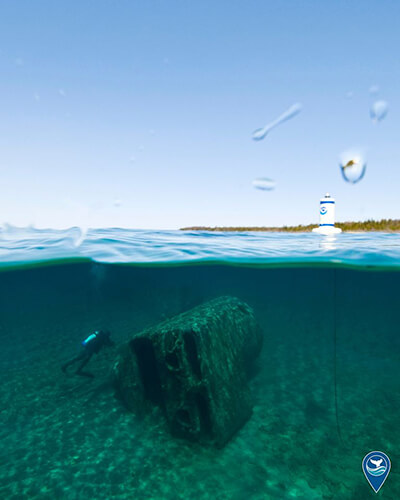
What type of photography do you prefer? Above water, underwater, or over-under shots? We love them all! 📸
Put your photography skills to the test during this year’s Get Into Your Sanctuary Photo Contest. From May 27 to September 5, 2022, the floor is yours to show us your experience visiting your national marine sanctuary system. Winning photographs will be announced in October 2022 as we celebrate our 50th anniversary. For more information visit sanctuaries.noaa.gov/photo-contest.html.
Photo: NOAA

Photo: Paulo Maurin/NOAA

Photo: Chuck Graham/GIYS Photo Contest 2020

It’s o-fish-ially #NationalFishingandBoatingWeek! This annual event is held the first full week of June to celebrate America’s love of fishing and boating. Tuna in this week as we share how NOAA Fisheries Service and NOAA's Office of National Marine Sanctuaries support sustainable recreational fisheries for the benefit and enjoyment of the nation.
Photo: Matt McIntosh/NOAA

We're sharing some of our favorite Asian American and Pacific Islander American Heritage Month features from recent years. 2017's web story is a personal reflection on the ocean by Peter Taliva'a, the captain of the research vessel for NOAA National Marine Sanctuary of American Samoa. In this photo, Peter is talking to guests about the history of Aunu'u.
Photo: Nerelle Que/NOAA

We're sharing some of our favorite Asian American and Pacific Islander American Heritage Month features from recent years. 2017's web story "Celebrating Asian-Pacific American Heritage Month in Sanctuaries" discusses the three sites in the sanctuary system with deep ties to Polynesian culture.
In this photo, Nihoa is seen from aboard the Polynesian voyaging canoe Hikianalia.
Photo: Brad Ka‘aleleo Wong/Office of Hawaiian Affairs

Happy birthday Cordell Bank National Marine Sanctuary! 🎉 NOAA's Cordell Bank National Marine Sanctuary was established in 1989. Within its 1,286 square miles, the sanctuary protects soft seafloor habitat, a rocky bank, deep sea canyons, and communities of wildlife throughout.
Celebrate with us by learning about the sanctuary. Read "5 Awesome Things You Might Not Know About Cordell Bank National Marine Sanctuary"
Photo: Joe Hoyt/NOAA

We're sharing some of our favorite Asian American and Pacific Islander American Heritage Month features from recent years. 2018's story map "Pacific Islander/Asian American Heritage Month in National Marine Sanctuaries" features some of the Asian and Pacific Islander people, history, customs, and culture from around the sanctuary system. In this photo, some children enjoy diving in National Marine Sanctuary of American Samoa.
Photo: David J. Ruck/NOAA

New Release: Ocean Acidification Resource Collection
What is Ocean Acidification?
The ocean absorbs the extra carbon dioxide we emit into the atmosphere when we burn fossil fuels, like coal, oil, and methane gas, and that changes the chemistry of the ocean. We call this “ocean acidification.” The change in chemistry is reducing the amount of calcium carbonate in the ocean. Just as humans need calcium to build their bones, sea creatures need calcium carbonate to build strong skeletons and shells. Ocean acidification changes the chemistry of the ocean and causes “osteoporosis of the sea,” which prevents animals at the bottom of the food chain from building and maintaining the protective shells they need to survive.
Explore this new collection of NOAA videos, lesson plans, webinars, web stories, virtual reality, and much more.
Photo: Wendy Cover/NOAA

Take a virtual field trip to NOAA Channel Islands National Marine Sanctuary!
In celebration of Kids to Parks Day, join staff from the National Oceanic and Atmospheric Administration (NOAA) on a virtual outdoor adventure from Ventura Harbor in California across the Santa Barbara Channel in NOAA Channel Islands National Marine Sanctuary to Anacapa and Santa Cruz Islands. The channel crossing will be full of marine life experiences, such as humpback whales breaching, common dolphins surfing the wake of the Island Packers vessel, and sea lions darting in and out of kelp forests.
May 18, 2022 at 1 pm Hawai`i / 4 pm Pacific / 6pm Central / 7 pm Eastern
Photo: Claire Fackler/NOAA

Are you as excited for the Valor in the Atlantic mission as we are?
Tomorrow we will be returning to the resting place of the USS Monitor, America’s first national marine sanctuary, as we celebrate the upcoming 50th Anniversary of the National Marine Sanctuary System. The Civil War vessel, which sank 160 years ago, will be visited with state-of-the-art technology and systematically surveyed for the first time since Monitor’s turret was recovered in 2002.
Photo: Tane Casserley/NOAA
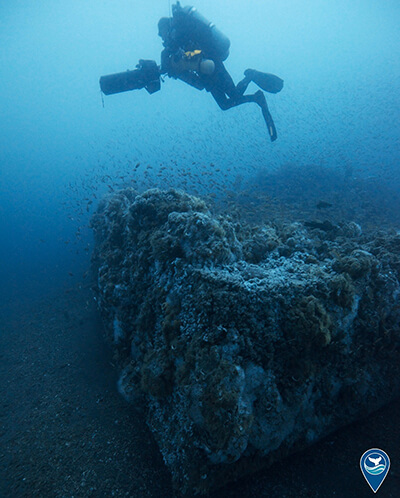
Announcing: Valor in the Atlantic Expedition
Beginning May 15, the public can join NOAA scientists and partner researchers as they explore the shipwreck of USS Monitor, natural reefs, and the maritime cultural landscape off the North Carolina coast.
The two week mission–titled Valor in the Atlantic–will use state-of-the-art underwater drones and other technologies to explore notable sites surrounding America’s first National Marine Sanctuary. The Global Foundation for Ocean Exploration is providing much of the technology for the mission, which will be live streamed in real-time to the public from NOAA Ship Nancy Foster.
Collaborating with dozens of museums, aquariums, educators, and other organizations, the broadcast will showcase nationally significant sites located in the waters off the North Carolina coast and their biological communities to students, educators, scientists and the public, literally bringing the wonders of these ocean treasures to life.
The mission will run May 15 through May 25, 2022 as weather and dive conditions permit.
Photo: NOAA
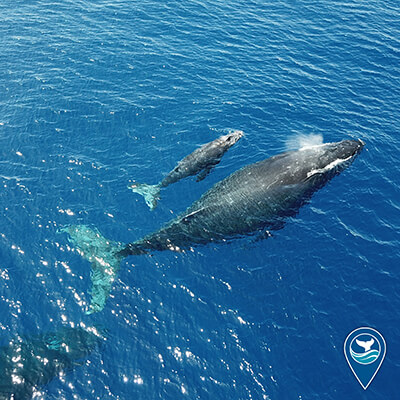
Keep your friends close and your mother closer 🐋
Did you know humpback whale calves stay near their mothers for up to one year before weaning? Mothers are protective of their calves, swimming closely and often touching them with their flippers. In the long-term, calves are likely to be found in the same feeding and breeding areas as their mothers.
Happy Mother's Day from your National Marine Sanctuary System!
Photo: J. Moore/NOAA, under MMHSRP permit #18786-02

This #HurricanePreparednessWeek, take a look back at last year's webinar to learn how to correctly interpret the National Hurricane Center forecasts and apply it to your plan to stay safe during hurricane season.
Join Andy Latto, Hurricane Specialist at the National Hurricane Center, as he discusses the main impacts of hurricanes on the Carolinas and the mid-Atlantic region. Learn how these destructive storms form and when to expect the biggest threats to the area. Andy will also discuss the National Hurricane Center’s forecast process, including tracking a storm and determining its intensity. He will illustrate some of the challenges and uncertainties faced each time they issue a forecast package. Be sure to register for this webinar to learn how to correctly interpret the National Hurricane Center forecasts and apply it to your plan to stay safe during hurricane season.
Photo: NASA

Happy National Travel and Tourism Week! Travel plays a very important role in creating jobs, helping communities thrive, and reconnecting America. This week, join thousands of travel and tourism professionals in celebrating what makes our industry so special and how together, we are building the #FutureOfTravel.
Photo: Matt McIntosh/NOAA
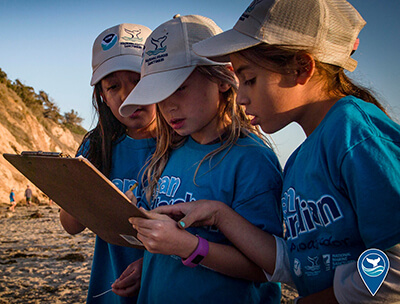
Happy #NationalTeachersDay to the talented leaders of education in the United States! We are especially appreciative of all the incredible teachers and instructors that incorporate marine science, conservation, and exploration into their yearly curriculums.
The NOAA Office of National Marine Sanctuaries aims to provide teachers with resources and training to support ocean literacy in America's classrooms. Interested in incorporating our resources into your curriculum?
Looking for other ways to engage students or schools? The 2022-2023 Ocean Guardian School application is now available on the Ocean Guardian School website! Deadline to apply is June 1st.
Photo: Nick Zachar/NOAA

#WorldTunaDay, created by the United Nations, gives us the opportunity to highlight the uniqueness of this fish and the global importance of sustainably managed fish stocks.
Bluefin tuna (pictured) are the largest tunas and can live up to 40 years. There are three species of bluefin tuna: Atlantic, Pacific, and Southern. The Atlantic Bluefin is the largest of the three, and all species are considered to be some of the largest bony fish in the world. This important ocean predator is also known for its speed and beauty.
Tunas are some of the most valuable fish in the Atlantic. To keep tuna stocks sustainable despite the high demand, @noaafisheries has put into effect a range of science-based restrictions and requirements, which was originally initiated in the 1990s. Together with international fishery management organizations and trade monitoring programs, these measures form one of the most comprehensive and responsive fishery management systems in the world.
Photo: NOAA

The first week of May is always very special to our team at NOAA's Office of National Marine Sanctuaries. This week, we celebrate #PublicServiceRecognitionWeek, which honors the contributions of federal, state, county, and local government employees throughout the United States.
NOAA's Office of National Marine Sanctuaries serves as the trustee for a network of underwater parks encompassing more than 600,000 square miles of marine and Great Lakes waters. The network includes a system of 15 national marine sanctuaries and Papahānaumokuākea and Rose Atoll marine national monuments.
Our team is made up of a dedicated and diverse group of scientists, researchers, divers, communicators, conservation specialists, administrative workers, sanctuary employees, and so many more talented professionals. Thank you to all of those who have made, and continue to make, @NOAA’s Office of National Marine Sanctuaries the notable and resourceful system it is today. Happy #PublicServiceRecognitionWeek!
Photo: Tane Casserley/NOAA

Saturday snoozin' or soakin' up the sun? ☀️
These California sea lions really know how to do both!
We are wishing you a beautiful Spring weekend from all of us at NOAA Office of National Marine Sanctuaries. How are you spending your Saturday? Let us know in the comments.
Photo: Claire Fackler/NOAA

Are you interested in learning about Our Blue Legacy?
The Marine Protection, Research, and Sanctuaries Act was signed on October 23, 1972, creating one of the oldest and largest networks of underwater parks in the world. Today the National Marine Sanctuary System covers more than 620,000 square miles of protected ocean and Great Lakes waters in 15 national marine sanctuaries and two marine national monuments. On October 23, 2022, the sanctuary system celebrates its 50th anniversary and is using the opportunity to, among other things, issue the Our Blue Legacy report summarizing its impacts and accomplishments as it looks forward to the next 50 years.
Photo: Matt McIntosh/NOAA

Whaling stretches far back in human history, with evidence dating back to the Middle Ages, to Indigenous and cultural uses over the last several thousand years, to the emergence of a global commercial whaling industry over the last two centuries. Commercial whaling in American waters came to an end on Dec. 31, 1971, and the last whale to be taken for commercial harvest was a sperm whale taken near San Francisco Bay, in what is today Cordell Bank National Marine Sanctuary. Thanks to the Endangered Species Act, Marine Mammal Protection Act, National Marine Sanctuaries Act, and other legislation, many of the waters that were once killing grounds for whales are now a haven for wildlife of all kinds.
Photo: Scot Anderson
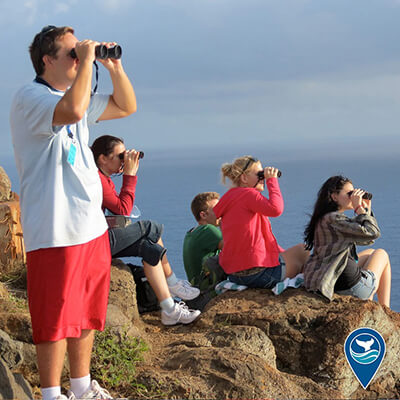
We're sharing some of our favorite National Volunteer Month features from recent years. 2017's two-part web story how citizen science and other volunteer programs help engage the public in the care of their national marine sanctuaries.
These volunteers are involved in NOAA's Hawaiian Islands Humpback Whale National Marine Sanctuary's Sanctuary Ocean Count, which offers the community a chance to monitor humpback whales from the shores of Oʻahu, Hawaiʻi and Kauaʻi.
Photo: Paul Wong/NOAA

Conservation and appreciation of Earth isn't limited to one day. What did you do to celebrate #EarthDay that can be continued in your daily life? How are you continuing to celebrate #EarthDay this weekend?
Photo: Claire Fackler/NOAA

How's your #NationalVolunteerWeek going?
Volunteers help to ensure national marine sanctuaries remain America's underwater treasures for future generations. These volunteers participate in a wide variety of activities including diving, whale identification, beach cleanups, water quality monitoring, collecting field observations and surveys, acting as visitor center docents, and wildlife monitoring.
Although we think #NationalVolunteerWeek should be every week, this week we are especially appreciative of all our incredible sanctuary volunteers!
Photo: Daryl Duda

Whether you live near or far from our magnificent ocean, we can all celebrate the gift of the sea! From feeding us to providing oxygen, regulating our climate and more, there are myriad ways the ocean impacts our daily life.
We can't wait to celebrate Earth Day this Friday!
Have you made any plans to celebrate on April 22nd?
Photo: Matt McIntosh/NOAA

It's officially #NationalParkWeek and #NationalVolunteerWeek!
sPark Collaboration with Channel Islands Naturalist Corps (CINC), a group of specially trained volunteers dedicated to educating passengers on board whale watch vessels visiting NOAA Channel Islands National Marine Sanctuary and Channel Islands National Park. Volunteers are also trained to lead island hikes within the national park, participate in local outreach events and to conduct citizen science, including the collection of valuable research on marine mammals and other important sanctuary and park resources.
Photo: Robert Perry

This #NationalParkWeek, sPark Discovery at Olympic National Park, neighboring NOAA Olympic Coast National Marine Sanctuary.
National Park Week kicks off today with a fee-free day to encourage everyone to find something new by visiting a national park, especially one that may be close to home, a park you haven't considered visiting, or one you never realized is a national park! What new national park will you discover? #sParkDiscovery
Photo: Nick Zachar

Sinkholes are like a time capsule, taking us back to how Earth may have appeared approximately 2.5 billion years ago, at the beginning of the Proterozoic Eon.
Since the sinkholes were discovered in 2002, scientists from around the world have collaborated with NOAA Thunder Bay National Marine Sanctuary to research this time capsule.
Photo: David J. Ruck/NOAA

Paddling through history 🚣♂️
Can you envision what it would be like to kayak through the remains of over 100 wooden WWI steamships in Mallows Bay-Potomac River National Marine Sanctuary?
Photo: Matt McIntosh/NOAA

Today is National Submarine Day! What popular song does this photo remind you of?
This brightly colored submersible, called Delta, has performed more than 7,000 deep-water dives, many of which were in and around NOAA Channel Islands National Marine Sanctuary. It’s also nicknamed “the Jeep of the Seas”!
Photo: Robert Schwemmer/NOAA

🚨 Invasive species alert 🚨
This large, golden-brown kelp species, Undaria, is native to Japan, Korea, and China. So, how did it end up in NOAA's Monterey Bay National Marine Sanctuary? Undaria frequently catches a ride around the world on boat hulls or in ballast water. Upon arrival to a new area, if weather conditions are right, it can cling to new boat hulls, clog docks, smother fishing gear, disrupt marine farming, or even alter marine ecosystems. Due to its catastrophic affects, Undaria is considered one of the world's worst invasive species.
Photo: Steve Lonhart/NOAA

Today is the last day of #WorldWildlifeWeek and our final #WorldWildlifeWeek two truths and a lie game. Can you guess which of these three statements isn’t true about the West Indian manatee found in NOAA Florida Keys National Marine Sanctuary?
- Full grown manatees typically weigh between 400 and 500 pounds.
- Manatees eat up to 150 pounds of plants each day.
- Manatees are mammals.
Photo: Bob Bonde/USGS
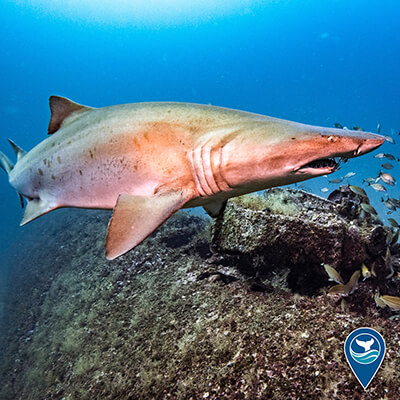
NOAA Monitor National Marine Sanctuary is home to the sand tiger shark. Our #WorldWildlifeWeek two truths and a lie game continues- can you guess which of these three statements is not true?
- Sand tiger sharks are only found in shallow depths (less than 100 feet).
- Sand tiger sharks are migratory within their region.
- Sand tiger sharks can be found in warm and temperate seas around the globe.
Photo: Tane Casserley/NOAA

Today's World Wildlife Week feature is the gray seal found in NOAA's Stellwagen Bank National Marine Sanctuary. Can you guess the two true facts about the gray seal?
- In US waters, there is only one stock of gray seals.
- Gray seals can dive to 1,560 feet for as long as one hour.
- Gray seals’ life span is 70-80 years old.
Which one of these statements isn’t true? Tell us your guesses in the comments!
Photo: Anne Smrcina/NOAA
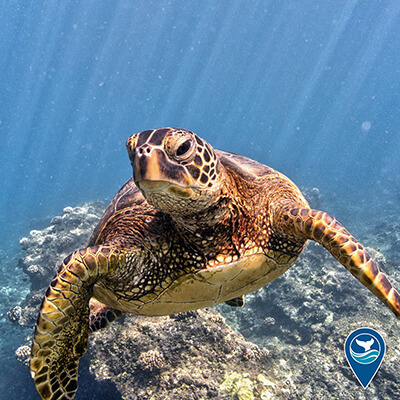
It’s World Wildlife Week! Each day of World Wildlife Week, we will provide you with two truths and a lie. What are the two true facts about the green sea turtle found in Papahānaumokuākea Marine National Monument?
- The green sea turtle is the largest hard-shelled sea turtle.
- The green sea turtle is only found in the United States.
- The green sea turtle is the only herbivorous species of sea turtle.
Can you guess the lie?
Photo: John Burns/NOAA

Raise your fin if you love whales! 🐋
Humpback whales are protected by national marine sanctuaries from the Atlantic to the Pacific. Humpback whales like this one can be found in protected waters of NOAA's Hawaiian Islands Humpback Whale National Marine Sanctuary and NOAA's Stellwagen Bank National Marine Sanctuary in Massachusetts.
Photo: Ed Lyman/NOAA Permit #15240
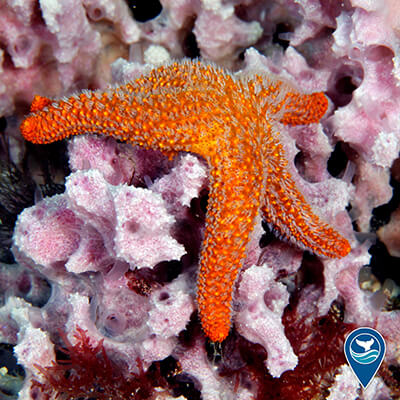
Have a great STARt to your weekend from all of us at NOAA Sanctuaries ⭐️
Invertebrates may lack a spine, but they are the backbone of ocean communities along the coasts of the southeast U.S. Sea stars are an important part of the live-bottom habitat at NOAA Gray's Reef National Marine Sanctuary.
Photo: Greg McFall/NOAA

A multi-year study by National Oceanic and Atmospheric Administration (NOAA), the U.S. Navy, and partners used sound monitoring tools to study the overlap in time and space between humpback whale signals (song) and Navy signals (sonar) in Hawaiian waters. This study is part of a collaborative effort to ensure that impacts to humpback whales are minimized in this important shared acoustic space.
Photo: Ed Lyman/NOAA under NOAA Permit 774-1714

Today is National Take a Walk in the Park Day 🏞 Celebrated annually, National Take a Walk in the Park Day encourages people to get outside and reconnect with nature. What better way to do that than with your favorite park activity? Here are a few of our favorites:
Paddleboarding in National Marine Sanctuary of American Samoa (pictured)
Diving in Grays Reef National Marine Sanctuary
Swimming in Florida Keys National Marine Sanctuary Bird watching in Stellwagen Bank National Marine Sanctuary
Let us know how you're celebrating National Take a Walk Day in the comments
Photo: Ropate Delana/NOAA
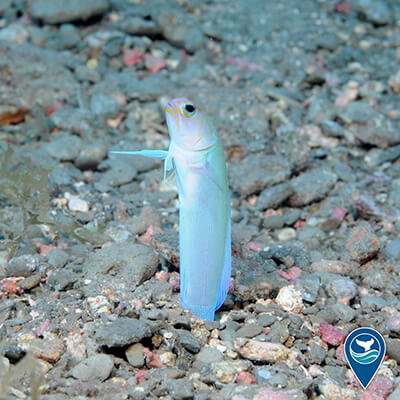
Yellowheaded jawfish come out of their burrows and gracefully “dance” around waiting for food. When threatened, they quickly retreat to their burrows and will poke their head out slowly to see if the coast is clear 👀
Photo: G.P. Schmahl/NOAA

On May 9, 1942, German U-boat U-352 became the first U-boat sunk by the U.S. Coast Guard off the U.S. East Coast during World War II. Resting at 115 feet in depth, the wreck is now covered in coralline algae, sea anemones, and corals. Those small blurs to the right of the divers are red barbier baitfish and amberjack. They're so common in the area that they make an appearance in nearly every photo- good thing those divers have their cameras out! 📸
Photo: NOAA

This airborne cetacean can whale-ly jump 🐳!
Despite weighing several tons and reaching up to fifty feet in length, humpback whales can be surprisingly agile. This whale is exhibiting a behavior known as breaching. Using its powerful tail for thrust, a humpback leaps gracefully out of the water and spins in mid-air, before crashing back into the sea.
Humpbacks can be spotted in several sanctuaries, including Stellwagen Bank National Marine Sanctuary and Hawaiian Islands Humpback Whale National Marine Sanctuary.
Photo: Dr. Brandon Southall, NMFS/OPR

On this International Day of Forests, let’s recognize the seaweed "trees" beneath the seas!
Dense forests of giant kelp weave a labyrinth of underwater habitats within Channel Islands National Marine Sanctuary. This amazing autotroph grows to enormous lengths and is the largest marine algae in the world. Kelp forest ecosystems are some of the most biodiverse areas of the ocean, providing shelter, food, and protection to an array of marine species. Climate change, pollution, commercial harvesting, and overgrazing by animals like urchins are threatening the stability of these environments.
Photo: Claire Fackler/NOAA

When is it possible to have too many muscles?
When they are invasive species!
Zebra and quagga mussels have infiltrated freshwater environments like Thunder Bay National Marine Sanctuary. These bothersome bivalves disrupt natural food webs, compete with other species for resources, cause damage to underwater structures like buoys and docks, and degrade historic sites like shipwrecks. It’s likely that the mussels were introduced to the Great Lakes by ocean vessels dumping ballast water. When visiting, do your part to protect sanctuary waters from invasive species and don’t be shellfish!
Photo: David J. Ruck/NOAA

I get the inkling 🦑 that the weekend is here!
This ex-squid-site specimen was found during a survey in NOAA's Greater Farallones National Marine Sanctuary waters. Squids differ from their relatives, octopuses, by having six arms instead of eight, and also two long feeding tentacles. Octopuses have round heads, while squids have pointy, cone-shaped heads with fins protruding on each side.
Photo: Maps for Good -- NOAA/Point Blue/ACCESS

Eelgrass grows where many dwell,
And turns the sea into an emerald realm.
So, on this day when thoughts are green,
Let us not forget the habitat marine.
🍀Happy St. Patrick’s Day from under the swell!
Photo: Stephanie Flax

Wormholes aren’t just in science fiction! This feather duster worm may not be able to distort space-time, but did you know this invertebrate can collapse into a thick, protective tube made of sediment particles, and mucus? The ornate feathers of this worm’s head emerge to comb through the ocean water of Grays Reef National Marine Sanctuary in search of food (tiny plankton).
Photo: Greg McFall/NOAA

It’s morning already? Seal-iously?
This northern elephant seal pup may someday weigh more than two tons and use its massive size to viciously defend its stretch of sand against competitors. For now, it prefers to spend mornings hauled out on the beaches of NOAA's Monterey Bay National Marine Sanctuary.
Photo: Matt McIntosh/NOAA

🤔 Wait a minute--something looks different about these dolphins. Can you spot what it is?
Northern right whale dolphins are one of the only species of dolphin in the North Pacific Ocean without a dorsal fin!
p>These dolphins are considered very acrobatic swimmers and are sometimes seen leaping 20 feet out of the water!
p>Other common cetaceans observed in Cordell Bank National Marine Sanctuary include Pacific white-sided dolphins and Dall's porpoises.
Photo: Jan Roletto/NOAA
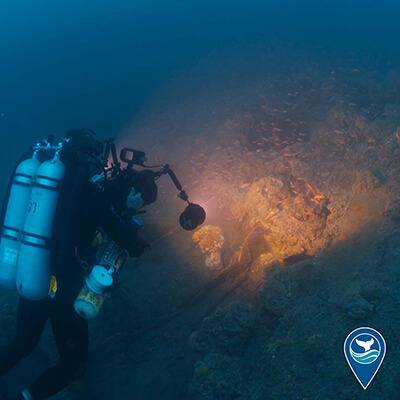
The Battle of Hampton Roads from March 8-9, 1862 was the first engagement of ironclad warships during the Civil War.
The USS Monitor arrived in Hampton Roads with orders to protect the Minnesots, which had run aground during an earlier confrontation with the CSS Virginia. Though the battle ultimately ended in a draw, the clash between these two ironclads would go down as one of the most consequential battles in naval history.
Photo: NOAA

It's International Women's Day!
And we think it's a great day to read up on some of our favorite heroes from around the sanctuary system! We're sharing our favorite Women's History Month features from recent years. Check out last year's profiles that feature ten dynamic women at work all over the sanctuary system.
Photo: NOAA

Since 2009, Greater Farallones Association and researchers have been working with volunteers to remove these invasive European green crabs from Seadrift and Bolinas Lagoons. Thanks to this project, Seadrift Lagoon’s biodiversity has rebounded, while green crab numbers in Bolinas Lagoon remain low.
Photo: Kate Bimrose/NOAA

We're sharing some of our favorite Women's History Month features from recent years. Last year's web story ""Women of the Water"" shares the story of past, present, and pioneering female ocean scientists.
Photo: Scientists from the Sea Turtle Lab at the NOAA Galveston Facility

Educator Alert! 🧑🏫
As part of our 50th anniversary campaign, we have been launching a series of new resource collections. In this new era of ocean conservation, we encourage formal and informal educators and other interested people to take advantage of the robust educational materials available in each topically-based collection.
This month, we have launched a collection covering SHIPWRECKS. NOAA’s Office of National Marine Sanctuaries staff study, interpret, and protect shipwrecks as places to explore, discover, and appreciate our country’s maritime legacy. Shipwrecks are a key aspect in understanding the maritime heritage of the United States and can help us learn more about our past. These shipwrecks not only help Americans learn more about our country’s past, but provide education, tourism, and recreational opportunities as well.
Photo: Steve Sellers/NOAA

Field trip!
Your national marine sanctuaries are a living classroom, a perfect opportunity to explore the marine environment. Here, a student examines a water sample after a plankton tow in NOAA Channel Islands National Marine Sanctuary . Check out our website to learn new ways to get you student engaged in their national marine sanctuary!
Photo: Claire Fackler/NOAA

Listen up!🎤
Researchers under the SanctSound project are listening closely to dolphins and whales in NOAA's Stellwagen Bank National Marine Sanctuary . Visual observations of the varied species from the whale watch fleet provide important data for cetacean researchers during whale watching season, but these contributions fall off in the winter (November-March). Acoustic monitoring technology fills this “black hole” of whale data by recording the calls (and presence) of visiting marine mammals year-round.
Photo: NOAA under NOAA research permit #18059

It’s National Dog Biscuit Day!
While they may look the part please do not try to give a harbor seal any dog treats. Not only will it not perform tricks for you, but the components of a dog treat are likely not part of a healthy seal diet!
Photo: Chad King.NOAA
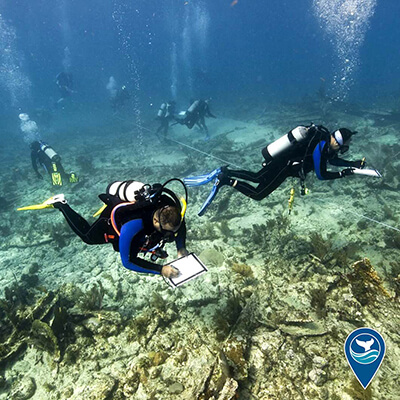
We're sharing some of our favorite Black History Month features from recent years. 2020's article by journalist and author Michael Cottman shares his experience in helping place a memorial plaque on the seabed where the slave ship Henrietta Marie sunk in June 1700.
Photo: Tane Casserley/NOAA
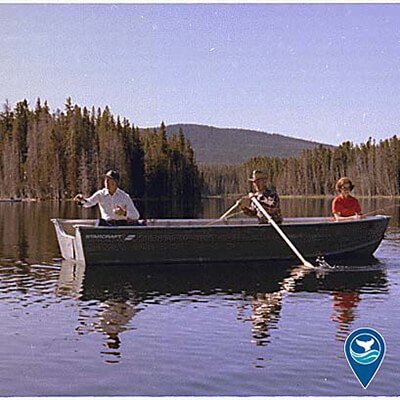
How about a president’s day quiz?
Which US president oversaw the addition of NOAA Gray's Reef National Marine Sanctuary to the sanctuary system? This the final of four sanctuaries added during this president’s term, right before the following president added what is now known as the NOAA National Marine Sanctuary of American Samoa! Read our sanctuary series article to learn about our presidents and their relationship with America's most treasured places!
Photo: White House Photographer, courtesy of the National Archives.

How about a smile for World Whale Day?
Humpback whales might not have the same pearly whites but their majestic grin still makes for a nice photo! Instead of hard teeth, the smile of a humpback whale and many others is composed of baleen, long strands of keratin design to filter tasty meals out of a big gulp of water. What do you think this whale caught in NOAA's Stellwagen Bank National Marine Sanctuary ?
Photo: NOAA

Ready to dive in?
As you navigate the waters of Wisconsin Shipwreck Coast National Marine Sanctuary, you glide over a lakebed that is rich with maritime history. Galliniper was built in 1833 and sank in mid Lake Michigan near Sheboygan in 1851. This vessel is the oldest documented shipwreck in Wisconsin and is on the National Register of Historic Places.
Photo: Wisconsin Historical Society

Humpback whale season is underway in Hawaiian Islands Humpback Whale National Marine Sanctuary
Sightings of the colossal marine mammals peak between the months of January and March, then gradually decline until humpback season ends in early May. Each year provides opportunities for whale watching, research, and citizen science, and the need for entanglement response. Read our latest webstory about this year’s especially eventful season!
Photo: Ed Lyman/NOAA under MMHSRP Permit # 18786-06

There’s a lot of buzz about whales lately!🐝
Want to stay in the loop and stay informed about our planet’s largest mammals? Check out our handy whale resource collection! Explore a collection of NOAA videos, lesson plans, posters, webinars, web stories, virtual reality, and more to gain a deeper understanding of whale species and NOAA's efforts within the sanctuary system to protect and understand them.
Photo: Anne Smrcina/NOAA

It's Whale Week!
Whale entanglements are a big problem that a number of our sanctuaries are investigating. But what's the best way to cut a whale free when the line is embedded in the blubber? Check out one innovative idea from Hawaii that stems from bamboo!
Photo: Michael Griffin/USCG, under NOAA Marine Mammal Health and Stranding Response Program Permit # 932-1905-1

Do you hear that? 🐳🔊
Every winter, thousands of humpback whales travel to the warm, shallow waters of Hawai‘i to mate, give birth, and raise their young. These whales are famous for their vocalizations, which are important for communication, orientation and navigation, hunting prey, and avoiding predators.
Photo: Ed Lyman/NOAA taken under NOAA permit #14682
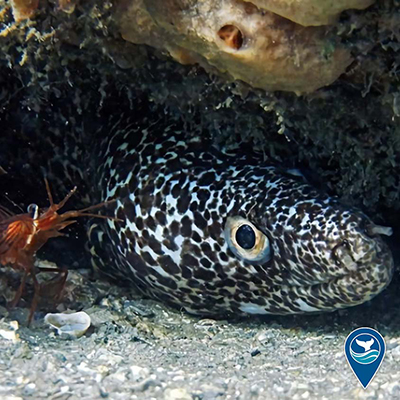
Head over heels? More like head over eels!💗
For #ValentinesDay we're sharing some of our favorite examples of courtship, reproduction, and other fascinating animal interactions in your national marine sanctuaries! There might even be some good ideas for your big day.Photo: Rachel Plunkett/NOAA

Ehem! Will you be my valentine?
When the great frigatebird wants to attract a mate, it inflates a red gular sac on its throat. Talk about wearing your heart on your sleeve! Frigatebirds breed and nest on the remote atolls and islands northwest of the main Hawaiian islands.
Photo: Robert Schwemmer/NOAA

#OTD the USS Macon crashes into the sea.
One of the Navy's two state-of-the-art "flying aircraft carriers” Macon was an engineering marvel at the time. It’s remains weren’t located for 55 years when it was discovered in the deep waters of Monterey Bay National Marine Sanctuary.
Photo: NOAAMBNMS/ MBARI 2006

Talk about camouflage!
Can you spot the spotted scorpionfish staring right at you? If you have keen eyes, you might come across this fish while diving on NOAA's Flower Garden Banks National Marine Sanctuary in the Gulf of Mexico. Their mottled coloring and odd texture help them blend in with the reef so they can sneak up on prey like small fish and crustaceans, then swallow them in one fast gulp!
Photo: Emma Hickerson/NOAA

Time for some #MondayMotivation!
And there's nothing more motivating than one of the ocean’s most marvelous and breathtaking animals: The Sea Cucumber! Seen here striking a provocative pose in the NOAA National Marine Sanctuary of American Samoa there really is no other creature that embodies drive and energy quite like a sea cucumber.
Are you motivated yet?
Photo: Greg McFall/NOAA

Spa Day!
The green sea turtle has a unique way of getting clean after a long ocean trek. They can visit special areas on the reef called a cleaning station where fish and invertebrates clean parasites off the turtle's shell (and eat them).
Talk about pampering!
Photo: Matt McIntosh/NOAA

The common dolphins of NOAA Channel Islands National Marine Sanctuary are very athletic!
If they participated in the winter games what sport do you think they would compete for? Since swimming and gymnastics are summer only maybe they’d try curling. What do you think?
Photo: Robert Schwemmer/NOAA

Beauty is in the eye of the beholder!
Discover firsthand what our spectacular sanctuaries have to offer, and how these educational materials bring the ocean and Great Lakes into your classroom, home, facility, or wherever you learn best.
Photo: Mark Losavio/NOAA

Ready, set, time to get wet! It's #WorldWetlandsDay!
Wetlands, such as swamps, marshes, and mangrove forests, provide a buffer to America's coasts and clean the water that flows through them. They also provide important habitat that supports biodiversity, and can protect communities from extreme weather events.
Here, educators from the Atlanta metro area are following Georgia's rivers and streams that lead to NOAA Gray's Reef National Marine Sanctuary as part of the annual "Rivers to Reefs" workshop.
Photo: Gail Krueger/NOAA

Attention Educators!🦸♀️
Coral reefs are one of the most important ecosystems on our planet that protect and foster biodiversity. Explore this collection of NOAA webinars, lesson plans, posters, videos, infographics, virtual reality, and more learn about coral reef ecosystems and NOAA Office of National Marine Sanctuaries’ efforts within the sanctuary system to preserve them and limit the impacts they face.
As part of our 50th anniversary campaign, we will launch a new resource collection each month through September 2022. We introduce you to the new Coral Reef Ecosystems Resource Collection. In this new era of ocean conservation, we encourage formal and informal educators and other interested people to take advantage of the robust educational materials available in each topically-based collection.
Photo: Joe Hoyt/NOAA

This year is already zooming!
Tomorrow begins a month of learning and celebrating black history and all month we will be sharing some of our favorite stories! Check out this month’s signature series article that includes stories of courage and heroism in your sanctuaries. The first story is a little known story of bravery surrounding the NOAA Monitor National Marine Sanctuary!
Photo: NOAA

Sundays are for snoozing!
Take a cue from these cuddle buddies and take it easy today! Papahānaumokuākea Marine National Monument grants protection to thousands of marine organisms and many critical habitats - including endangered species like these two. You'll need to be well rested to help us spread the word about how we can keep their populations healthy!
Photo: Mark Sullivan/NOAA

Does someone need a hug?
This colorful kelp crab might be able to help with that! Kelp crabs like this one can be found in NOAA's Monterey Bay National Marine Sanctuary , often called the “Serengeti of the Sea."
Photo: Chad King/NOAA

It's National Daisy Day!
There aren't any daisies underwater at NOAA Gray's Reef National Marine Sanctuary, but this anemone sure does look like it could be a flower. The sanctuary is one of the largest near shore "live-bottom" reefs in the southeastern United States. The hard bottom is blanketed with benthic(bottom dwelling) algae and invertebrates such as anemones, sponges, tunicates, and more!
Photo: Greg McFall/NOAA

Let's take a trip beneath the surface of Wisconsin Shipwreck Coast National Marine Sanctuary!
Trading vessels like the 95-foot long schooner Gallinipper linked Wisconsin coastal cities with distant markets in the 1830s and 1840s, fueling local and regional economies.
Photo: Wisconsin Historical Society

It’s Wildlife Wednesday!
Mallows Bay-Potomac River National Marine Sanctuary protects the remnants of more than 100 World War I-era wooden steamships – known as the "Ghost Fleet". While the service of these vessels ended here in Mallows Bay they serve a new role as a unique habitat for fish, bird and plants species. Check out these Osprey frolicking on the border posts installed to keep the boats from floating away long ago.
Photo: Matt McIntosh/NOAA

It's National Plan a Vacation Day AND National Florida Day! So why not plan your vacation in NOAA Florida Keys National Marine Sanctuary?
Florida Keys National Marine Sanctuary is proud to partner with dive, snorkel, and fishing charters and captains that are committed to encouraging responsible recreation and stewardship of their unique and fragile ecosystem. Blue Star operators voluntarily go the extra step to educate their customers about the South Florida ecosystem, Florida Keys National Marine Sanctuary, and responsible diving and fishing.
Photo: Nick Zachar/NOAA

It’s National Compliment Day!
And we think you all look wonderful today! Just as wonderful as the beautiful waters of NOAA Olympic Coast National Marine Sanctuary . It’s in these beautiful waters that the once locally extinct sea otter now thrives! Growing from double digits in 1970 to more than 1,800 in 2016 this species is one of our favorite success stories!
Photo: Greg McFall/NOAA

Sea Slug Sunday!
Let this clown nudibranch put a pep in your step this week! Found amongst the algae in NOAA's Cordell Bank National Marine Sanctuary, this goofy creature is a gastropod like its snail cousins but loses it's shell as a larva. This particular species is known for its acrobatic ability to crawl along the underside of the surface of tidepools!
Photo: Greg McFall/NOAA

🎶If he’s green and so shy, with two jaws and two eyes, that’s a moray!
A green moray eel at NOAA's Flower Garden Banks National Marine Sanctuary to be exact. Did you know that the green moray eel is actually brown in color? They have a yellow mucus covering their bodies, which blends together to make that beautiful vibrant green we all know and love!
Photo: G.P. Schmahl/NOAA

The future is now!
Remotely operated vehicles (ROVs) are important research tools in sanctuaries: they allow researchers to get up close to underwater resources like shipwrecks. Here, an ROV investigates the boiler and condenser of the wooden steam barge Montana, which sank in 1914 in what is now NOAA Thunder Bay National Marine Sanctuary.
Photo: Tane Casserley/NOAA

Gloomy day? Check out this view!
The stunning scenery throughout your National Marine Sanctuary System will surely take your breath away. This beautiful rainbow was captured from a beach in NOAA National Marine Sanctuary of American Samoa. What sanctuary scenery is your favorite?
Photo: Apulu Veronika Molio'o Mata'utia Mortenson/NOAA

Wishing you a crabulous Wednesday!
Hermit crabs can be found in many of your national marine sanctuaries, including Hawaiian Islands Humpback Whale National Marine Sanctuary! These wee crustaceans use empty shells to protect themselves. As they get bigger, they move into larger, more accommodating shells (or whatever they can find). Genius!
Photo: NOAA

Waking up early after a long weekend isn't easy.
Researchers came across this grumpy customer in deep waters during a research expedition aboard E/V Nautilus in NOAA Channel Islands National Marine Sanctuary. Scorpionfishes have venomous spines for protection that they will erect if they feel threatened. A master of camouflage, this animal can blend into the rocks and corals, which helps to find prey and avoid predators.
When it's not yelling at you of course.
Photo: OET/NOAA

Today is NOAA's Flower Garden Banks National Marine Sanctuary Anniversary!
And since today is all about service we want to thank and acknowledge those who help our sanctuaries shine bright! Flower Garden Banks NMS in particular has grown a lot over the last 30 years and a huge part of that success comes from volunteers! The divers here go through strict training but are essential to the monitoring, research, and protection of these beautiful waters. From outreach activities to beach clean ups every sanctuary leans on their volunteers one way or another.
Photo: FGBNMS/Jimmy MacMillan

Getting nice and cozy on World Snow Day?❄️
This American lobster has found a cozy home inside a shipwreck at NOAA's Stellwagen Bank National Marine Sanctuary. Located just off Cape Cod, MA, the sanctuary is home to rich collections of both marine life and historical resources.
Photo: Matthew Lawrence/NOAA

Hats off to you! 🎩👀
This red turban snail from NOAA's Monterey Bay National Marine Sanctuary looks like it's celebrating #NationalHatDay! This animal gets its name from the top spiraling shell which resembles a hat. This species is often found amongst the giant kelp on which it grazes.
Photo: Steve Lonhart/NOAA

Ready for your closeup? 📸
Flounder are flat fish that like to hide on the sandy seafloor in NOAA Gray's Reef National Marine Sanctuary . They can bury themselves in the sediment to avoid predators, but have bulging eyes to look for prey. They have a similar color to the sediment on the ocean floor, and some can even alter their appearance to blend in with their environment. During this animal's development their eyes will migrate to one side of their head. Suddenly high school doesn't sound so bad!
Photo: Greg McFall

In the sunlit waters of Hawaii, this unique trio forges their way across the reef.
Papahānaumokuākea Marine National Monument encompasses 582,578 square miles of the Pacific Ocean--an area larger than all the country's national parks combined. With so much space it can be hard to go it alone! What are some of your favorite animal teams?
Learn more about the wrecks of Monitor National Marine Sanctuary here: monitor.noaa.gov
Photo: Greg McFall/NOAA

People come from far and wide to learn about the USS Monitor.
But people aren’t the only ones who like to visit the magnificent wrecks in and around the NOAA Monitor National Marine Sanctuary. These Atlantic spotted dolphins were seen in the sanctuary during a research trip last summer. They love to play in the wake of moving vessels and sometimes it seems like they show off just for the cameras…🤔
Learn more about the wrecks of Monitor National Marine Sanctuary here: monitor.noaa.gov
Photo: Mark Losavio/ NOAA

Meet the Bull Kelp!
Bull kelp, which can be found in NOAA's Greater Farallones National Marine Sanctuary , is a large brown kelp can attach itself to rocks with a holdfast made of many finger-like projections. The kelp may be anchored to the seafloor, but it towers to the surface thanks to a gas filled float. The common name "bull kelp" came about because of its resemblance to a bull whip but they can also be known as a "mermaid's bladder"!
Photo: Steve Lonhart/NOAA

Once considered one of the most elegant vessels on the Great Lakes, the steamer 𝘝𝘦𝘳𝘯𝘰𝘯 now rests about 200 feet deep on the floor of the newly designated Wisconsin Shipwreck Coast National Marine Sanctuary. The cold, fresh waters have kept the vessel and much of its cargo intact long after it sank in a gale storm in 1887.
Photo: Tamara Thomsen, Wisconsin Historical Society

A national treasure!
The bald eagle has become a conservation success story. In 1963, there were less than 500 nesting pairs of these regal birds remaining. Thanks to intense conservation and outreach efforts, the bald eagle was taken off the Endangered Species List in 2007. These majestic birds can be seen across the United States but appear to enjoy visiting the Ghost Fleet of Mallows Bay-Potomac River National Marine Sanctuary. Curious.
Photo: Paula Schiller

Ever had the feeling that someone was… watching you?👀
Green moray eels, like the one seen here staring into your soul from NOAA Florida Keys National Marine Sanctuary , actually have rather poor eyesight. Instead relying on their strong sense of smell to help feed their long slender bodies. This makes it easier for the eels to hunt at night making the green moray eel a popular night dive sight!
Photo: Greg McFall/NOAA

Fun Fact Friday!
Did you know that the gooseneck barnacle gets its name from a popular myth that they eventually grow into a goose? Due to similar color patterns the 𝘉𝘳𝘢𝘯𝘵𝘢 𝘭𝘦𝘶𝘤𝘰𝘱𝘴𝘪𝘴 (otherwise known as the Barnacle Goose) was believed to have developed underwater as a barnacle over the summer. In reality the gooseneck barnacle is a filter feeding crustacean that wouldn’t even begin to know how to fly.
Photo: Jenny Waddell

It’s time to shellebrate!🎉
Today is the anniversary of the presidential proclamation that designated Rose Atoll Marine National Monument! The monument covers over 13,000 square miles of pristine waters and reefs and is known for its pink encrusting coralline algae. This relatively undisturbed refuge allows many species the right conditions to bounce back from decline like the giant clam!
Photo: LTJG Brian Caldwell/NOAA Corps

Comin’ in hot!
This stunning sky denizen is a large mouth bass’ worst nightmare. The osprey, also known as a sea hawk is a fish eating raptor that can be spotted diving into the waters of Mallows Bay-Potomac River National Marine Sanctuary. This species, along with many others make Mallows Bay the perfect spot to visit for National Bird Day.
What are some of your favorite birds?
Photo: Matt McIntosh/NOAA

It's National Trivia Day! So here’s a question for you. Four of the five Great Lakes border Michigan. Can you name the one that doesn’t? This very special place also happens to be the smallest of the Great Lakes in terms of surface area but more than makes up for it in terms of depth and volume. This lake also happens to be the site of a newly proposed national marine sanctuary. Think of it yet? Check below for the answer!
✏️
.
.
.
Lake Ontario!
Photo: Jill Heinerth

Let’s start the year off with a splash!
Bet you can’t out-splash our friend here. Humpback whales (𝘔𝘦𝘨𝘢𝘱𝘵𝘦𝘳𝘢 𝘯𝘰𝘷𝘢𝘦𝘢𝘯𝘨𝘭𝘪𝘢𝘦) visit NOAA's Cordell Bank National Marine Sanctuary periodically to feed on krill and small schooling fishes. Cordell Bank’s unique upwelling-driven system makes for the perfect snack stop for today’s whale on the go.Photo: NOAA

The Venus flytrap anemone may look like its terrestrial counterpart – but this deep-sea dweller is actually an animal, not a plant!
Found in Flower Garden Banks National Marine Sanctuary, these anemones eat particles floating by in the water. When matter lands on the tentacles, the anemone closes to digest the food!
Photo: NOAA

The morning has dawned on a new year! 🌄
January 1st is the time to make resolutions for the coming year, so why not resolve to visit a marine sanctuary? NOAA Channel Islands National Marine Sanctuary's Anacapa Island has a total land area of about one square mile and it’s packed with gorgeous wildlife. From the sea lions on the rocky shores to the vibrant kelp forests below there’s never a dull moment! Could this be the sanctuary to start your year?
Photo: Robert Schwemmer

On this day the USS Monitor was lost off the coast of Cape Hatteras, North Carolina.
While Monitor’s role in helping preserve the Union ended on New Year’s Eve in 1862, its story continues. From its rediscovery in 1973, its designation as the nation’s 1st national marine sanctuary in 1975, to the recovery and conservation of its gun turret in 2002 the story of Monitor is far from over. Even now the vessel serves a new role as a “Living Shipwreck”, acting as an oasis for marine species in NOAA Monitor National Marine Sanctuary
Photo: NOAA

Ready to wave in the new year? 🌊
Proposed Lake Ontario National Marine Sanctuary, located in New York was nominated by the local community and stakeholders working together. Decades of maritime history and culture are hidden in these brisk waters waiting to be explored and their stories waiting to be shared. If they can accomplish this, imagine what you and your community could do in the new year!
Photo: Nick Zachar/NOAA
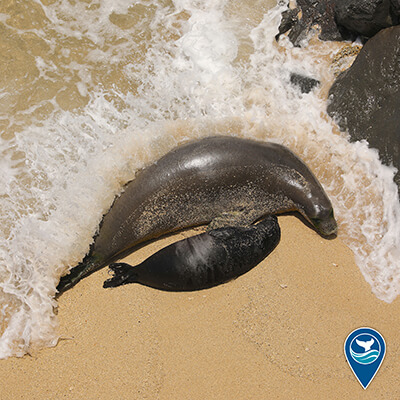
How about this cute pair for your #WallpaperWednesday?
Meet Kaiwi and her pup Lolii, a pair of Hawaiian monk seals enjoying the surf on Kaimana Beach near Hawaiian Islands Humpback Whale National Marine Sanctuary . These endangered animals can be found almost nowhere else in the world, which is why we work so hard to study and protect them. This brilliant photo was a submission for the 2021 Earth Is Blue photo contest.
Photo: Joyce Hsieh

It’s a special anniversary today!🎉
The National Marine Sanctuaries Act is not the only piece of legislation that's important to your sanctuaries. On this day, December 28, the Endangered Species Act was signed in 1973. Considered to be one of the world’s strongest conservation laws, the ESA provides a framework to conserve and protect endangered and threatened species and their habitats.
Photo: Allison Henry/NOAA, under MMPA Permit #17335

🥊Who will win this faceoff?
Two black-footed albatrosses battle over a delicious meal in the waters of NOAA's Monterey Bay National Marine Sanctuary . This albatross species likes to spend most of their time 20-30 kilometers from the coast. They make these long trips look easy thanks to their long slender wings (up to seven feet!). It seems they aren't big fans of sharing though.
Photo: Douglas Croft

🥗Got holiday leftovers? Not a problem for this school of parrot fish!
Named for their unique teeth, these fish like to crunch down on hard snacks, like the very reef itself. While it looks like these fish are eating rocks and coral, what they’re really after is the algae that grows on top! Luckily all of these things are safely managed in the waters of Rose Atoll Marine National Monument.
Photo: Ian Shive

🎄Don't look for presents under this tree.🎁
A common sight in NOAA's Flower Garden Banks National Marine Sanctuary, these “trees” are actually worms! The colorful “pine needles” of these animals are actually their gills which is why they are so quick to rush back into their holes when approached. We like to think that the fishmas tree worm (Spirobranchus giganteus) is just as excited about today as we are!
Photo: Steve Miller

Wishing you a cozy holiday with this Balloonfish!🎈
While this animal may have a goofy look it’s actually a formidable predator. It’s dazzling smile hides a set of powerful teeth that can crush the shells of snails, urchins, and crabs. If you’re visiting Molasses Reef in NOAA Florida Keys National Marine Sanctuary make sure to leave a plate of cookies for this big fellow! (But don’t actually they aren’t big cookie fans)
Photo: Daryl Duda

🎄It's time to get festive!🎄
This picture may look like a well lit holiday decoration, but it's actually a festive looking hydroid! The Christmas tree hydroid (𝘗𝘦𝘯𝘯𝘢𝘳𝘪𝘢 𝘥𝘪𝘴𝘵𝘪𝘤𝘩𝘢) is a polyp found in warm Atlantic waters. Each organism is only 3-5 inches, but can form colonies of thousands of polyps along reefs and rocks at NOAA Gray's Reef National Marine Sanctuary .While they are an asset to the Atlantic Ocean ecosystem, they have become an invasive species elsewhere.
Photo: Greg McFall/NOAA

Looking for a skinny role model for the New Year?
The snipe eel is one of the many odd and wonderful creatures found in the depths of NOAA Channel Islands National Marine Sanctuary . These eels can grow up to 5 feet in length, but only weigh a few ounces. They have long, birdlike beaks that are thought to be used to entangle the antennae of tiny, tasty shrimp.
Photo: NOAA

It's the Winter Solstice! ❄
Even on the shortest day of the year, it's still possible to take in the beauty of NOAA Thunder Bay National Marine Sanctuary. It's hard to tell but under these slabs of ice, there lies centuries of national maritime heritage and history. Almost 100 shipwrecks are preserved under the brisk waters of Lake Huron, making it one of the largest collections of shipwrecks in the United States.
Photo: Nick Zachar/NOAA

Say, do you remember the first modern Olympic games? No?
Don’t worry, head to NOAA's Cordell Bank National Marine Sanctuary and ask a yelloweye rockfish! This hefty fish can live to be up to 150 years old! That’s long enough to see 34 countries come into being. Since this fish lives so long that also means it takes a while to reach maturity, and this can make conservation of this species a challenge.
Photo: Matt Vieta/BAUE

Time for a Sunday splash! 🐬
Risso's dolphins (Grampus griseus) are a special sight at Noaa's Monterey Bay National Marine Sanctuary but can be found almost worldwide! While they are professional deep divers they can be quite active on the surface as well and display behaviors such as flipper-slapping, spyhopping, and breaching. Fun fact: a Risso's dolphin can hold its breath for up to 30 minutes!
Photo: Robin Agarwal

Gotta give credit where credit is blue!
The blue shark (Prionace glauca) can be found calmly patrolling the waters of NOAA's Stellwagen Bank National Marine Sanctuary. This shark has a striking dark blue color and very long, slender pectoral fins. Reaching a respectable size of up to 12.5 ft. this beautiful fish has all the makings of a successful supermodel! Think we should get an autograph next time?
Photo: Greg Skomal/Courtesy of MassDNF

If you think school lunches are hectic, imagine a school of ravenous surgeonfish!🐠
Members of the surgeonfish family, like those seen here in Papahānaumokuākea Marine National Monument , will often form schools to feed together. They can sometimes be seen roving across reefs like a colorful cloud of hungry snackers! Don’t worry divers, these fish are mostly vegetarian. Mostly…
Photo: Robert Schwemmer/NOAA
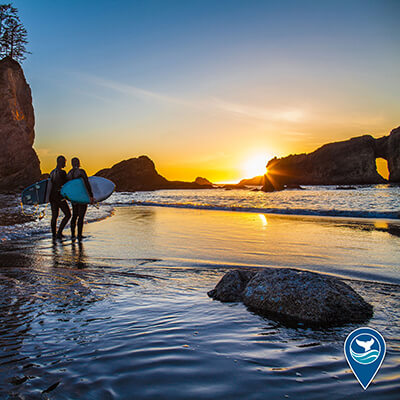
🏄Surf's up!
Know before you go out surfing in the winter by following the Recreate Responsibly Winter Edition and reading up on Recreate Responsibly ’s Winter Surfing blog by National Oceanic and Atmospheric Administration (NOAA) !
Photo: Matt McIntosh
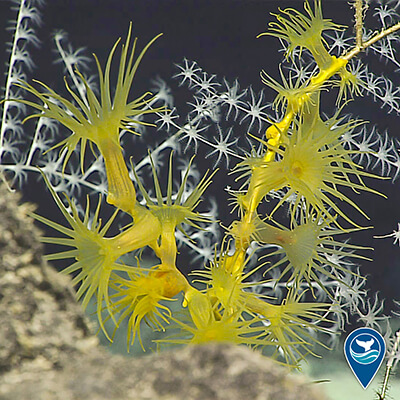
We've got everything in your Sanctuaries from A to Zoanthid!
The stunning beauty of NOAA National Marine Sanctuary of American Samoa does not end at the depth the light reaches. There is real beauty to be found in the deep. Take a look at this yellow zoanthid (a close relative to corals and anemones) found colonizing the skeleton of an octocoral in the deep blue waters of American Samoa.
Photo: Courtesy of the Office of Exploration and Research

A new perspective.
The stories of the vessels that lie in and around the NOAA Monitor National Marine Sanctuary don’t end when they arrive at the seafloor. Some wrecks take on a new role, serving as vitally important habitat for vulnerable and important marine species! These wrecks can even offer refuge for species under threat from climate change.
Photo: NOAA

It's Mangrove Monday!
Mature red, white, and black mangrove trees line over 1800 miles of shoreline in the NOAA Florida Keys National Marine Sanctuary . These unique trees can prevent erosion with their intricate root system by absorbing wave action. Their prop and drop roots don't just protect the coast, they are also home to several coastal species. In fact, many reef fish spend the earliest part of their lives in the safety of the mangroves before moving out onto the reefs.
Photo: Olivia Williamson

There's no swimming around this issue.
The Hawaiian monk seal is one of the most endangered species in the Hawaiian Islands Humpback Whale National Marine Sanctuary . With a total population of only around 1400 individuals they can be found in Hawaii and almost nowhere else in the world. Threats to this key species include marine debris, vessel strikes, and food availability.
Photo: Bill Pigot/NOAA

There's no swimming around this issue.
The Hawaiian monk seal is one of the most endangered species in the Hawaiian Islands Humpback Whale National Marine Sanctuary . With a total population of only around 1400 individuals they can be found in Hawaii and almost nowhere else in the world. Threats to this key species include marine debris, vessel strikes, and food availability.
Photo: Bill Pigot/NOAA

There's just something about an octopus that makes them so tenta-cool!
In honor of International Mountain Day (seamounts count, okay?), we bring to you this beautiful benthic octopus found at Davidson Seamount!
Photo: NOAA

Need a handsome face for Christmas Card Day?
NOAA's Greater Farallones National Marine Sanctuary is full of beautiful creatures, amazing habitats and exciting adventures. From a fun day at the beach, boating trips, tide pooling, and even virtual visits; there are many ways to enjoy your marine sanctuary!
Photo: Sara Heintzelman/NOAA

Did you know NOAA Florida Keys National Marine Sanctuary offers a boater education course to help protect the Keys?
A new free online boater education course developed specifically for the Florida Keys is available to those who want to protect themselves, their vessel, and the precious marine resources of the Florida Keys. This course is specific to boating within Florida Keys National Marine Sanctuary and was created to complement basic boater safety training.
Photo: Matt McIntosh/NOAA

There's no cash deposit here, but this squirrelfish is still right at home in NOAA's Flower Garden Banks National Marine Sanctuary .
These banks are located 80-125 miles from the Texas and Louisiana coastlines, which makes it a challenge to visit in person. Nevertheless, anglers have been visiting the sanctuary for over 100 years, while divers and researchers have been exploring there for over 50 years. You can visit too! All you need is a little planning.
Photo: Greg McFall/NOAA

Getting off of work at 4:30pm after day light savings...
This little goby fish was spotted in Monterey Bay National Marine Sanctuary hiding in the shadows. Check out incredible wildlife photography like this from around the sanctuary system by visiting our website!
Photo: Bruce Sudweeks

Did you know, NOAA Olympic Coast National Marine Sanctuary covers an area comparable to...
- Over one and half times larger than the entire Puget Sound?
- Almost two and a half times larger than Olympic National Park?
- The states of Delaware and Rhode Island combined?
That is 3,188 square miles of marine waters off the rugged Olympic Peninsula coastline.
Photo: Claire Fackler/NOAA
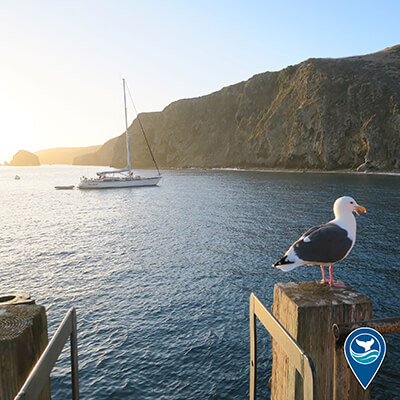
Gull on official business watching over the sanctuary, reporting for duty!
NOAA Channel Islands National Marine Sanctuary protects 1,470 square miles of ocean waters around the Northern Channel Islands: Anacapa, Santa Cruz, Santa Rosa, San Miguel, and Santa Barbara islands. A special place for endangered species, sensitive habitats, historic shipwrecks, and cultural resources, the sanctuary provides protection through research, education, conservation, and stewardship.
Photo: Claire Fackler/NOAA

NOAA Florida Keys National Marine Sanctuary protects the only barrier coral reef in the continental United States.
This fragile habitat is increasingly under threat from hurricanes, disease, boat groundings, rising ocean temperatures, pollution, human interactions, and more. In an effort to address these threats, the sanctuary has proposed Restoration Blueprint. This embodies what we have learned from nearly 30 years of cutting-edge science, technical experience, and local community involvement.
Photo: Nick Zachar/NOAA

Corals are the foundation of the reef ecosystem that is vital to the marine life, economy, and culture of American Samoa. These vibrant ecosystems provide habitat and prey for thousands of species. However, these corals face many threats.
Rising water temperatures are one of the greatest climate threat to corals.
Photo: NOAA

Today for Corals Week we are focusing in on education!
We have developed a Deep Coral Communities Curriculum which takes students into the deep sea to identify the soft corals, hard corals, invertebrates and fish found in these communities and to investigate the unique biology of deep-sea corals.
Photo: Greg McFall/NOAA

Celebrate of Corals Week with us by learning about deep sea corals!
Deep sea corals, or cold water corals, can grow for hundreds of thousands of years. They can form complex habitats that provide micro-niches for other marine life. Because of this, these communities are much higher in biomass and diversity than surrounding deep-sea areas!
Photo: OET/NOAA

Photo: GFOE/NOAA

Have you ever seen black coral before?
This species of coral is a colonial organism that produces a branched or unbranched skeletal axis that is similar in appearance to that of gorgonian corals. Species from both groups are commonly referred to as sea fans, sea bushes, sea feathers, or sea whips.
Photo: GFOE/NOAA

NOAA National Marine Sanctuary of American Samoa protects extensive coral reefs, including some of the oldest and largest Porites coral heads in the world. Look deeper and you will find deep-water reefs, hydrothermal vent communities, and rare marine archaeological resources.
Photo: NOAA

The sanctuaries and monuments of the national marine sanctuary system run along the shorelines and include the waters of many Native and Tribal Nations. We work in partnership with these communities to protect resources, shape policy, conduct research, and provide educational programs.
At NOAA Olympic Coast National Marine Sanctuary (pictured here), the Makah Tribe, Quileute Tribe, Hoh Tribe, and Quinault Indian Nation have a critical role in sanctuary management as active members of the Intergovernmental Policy Committee and the Sanctuary Advisory Council.
Join us in commemorating Native American Heritage Day, today, respecting and honoring the deep cultural ties of Indigenous people to the ocean.
Photo: NOAA

It is time to gather around the table coral!
It's only with your support that we can successfully protect our nation's precious marine ecosystems, and we are ever-thankful for you. To all of our friends, partners, and supporters, we wish you a Happy Thanksgiving, and a wonderful holiday season!
Let us know what you are thankful for!
Photo: Greg McFall/NOAA

This lettuce sea slug wants to be sure you have some greens on your plate tomorrow!
These mollusks eat green algae but not all of it is digested. Algae can live in these sea slug's fleshy appendages giving them photosynthetic energy and their green color.
Photo: Michael Schilling

Interested in history?
The USS Monitor Center, the official visitor center for NOAA Monitor National Marine Sanctuary, has over 50,000 square feet of interactive gallery exhibits, artifacts, and replicas that bring the story of Monitor and its crew to life!
Photo: The Mariners' Museum

Did you know Mallows Bay-Potomac River National Marine Sanctuary protects and interprets the remnants of more than 100 World War I-era wooden steamships? Known as the "Ghost Fleet," these remains provide a historical backdrop for kayak tours and bird watching visits. Whether you're walking the shore or paddling through history, the "Ghost Fleet" is your gateway to recreation and educational opportunities.
Photo: Kate Thompson/NOAA

Are you a life-long learner?
For students of all ages, NOAA's Stellwagen Bank National Marine Sanctuary staff and associates offer a variety of free programs throughout the year, some in-person and others virtually. Training sessions prepare volunteers for citizen science programs and to assist sanctuary researchers.
Photo: Nick Zachar/NOAA

The shipwrecks of NOAA Thunder Bay National Marine Sanctuary make up a collection that spans 200 years of Great Lakes shipping. They hold the stories of countless sailors and passengers who traveled the freshwater seas. The collection of sanctuary shipwrecks reflect the transition of ship architecture and construction. From wooden schooners to early steel-hulled steamers, there are still stories left to discover.
Learn more on #ShipwreckSaturday
Photo: Tane Casserley/NOAA

The shallow waters of Hawaiian Islands Humpback Whale National Marine Sanctuary provide great opportunities for diving, snorkeling, and exploring! Check out some of the world famous spots, including Hawai‘i Marine Life Conservation Districts like Hanauma Bay on O‘ahu and Molokini Crater on Maui.
Photo: Matt McIntosh/NOAA

Fancy a game of hide and seek? Make sure you aren't up against a master of disguise – an octopus!
Found in NOAA Gray's Reef National Marine Sanctuary , this octopus puts new meaning to a "live-bottom" reef. "Live bottom" is a term used to refer to a hard seafloor that typically supports high numbers of large invertebrates such as sponges, corals, and sea squirts.
Photo: Greg McFall/NOAA

When the adults say it's time to get out of the pool...
Interrupting your feed for this otter-ly adorable pair floating around NOAA Olympic Coast National Marine Sanctuary!
Photo: NOAA

Within the boundaries of NOAA Florida Keys National Marine Sanctuary lie spectacular, unique and nationally significant marine resources, including North America's only coral barrier reef, extensive seagrass beds, mangrove-fringed islands, and more than 6,000 species of marine life. Over the last 31 years, the sanctuary has worked tirelessly to protect the marine resources that support the economy and way of life in the Florida Keys.
Photo: Mike Johnson

It's masked booby Monday in Papahānaumokuākea Marine National Monument!
What makes a bird a seabird? There are a few characteristics that ornithologists and birdwatchers alike use to define them. Generally, seabirds are birds adapted for life in and around a marine environment. These adaptations can be exhibited in a variety of ways, but are often attributed to their behavior and physiology.
Photo: Brad Wong/OHA

Join us for sea cow Sunday!
In the winter season, visitors of NOAA Florida Keys National Marine Sanctuary may encounter West Indian manatees swimming along the shoreline. These large, air-breathing herbivores are found in shallow, slow-moving waters where seagrass beds flourish. Boaters, if you find yourself in known manatee habitat be sure to slow down and produce only minimal wake.
Photo: USGS

Saturdays are for the seals!
Gray seals are found throughout NOAA's Stellwagen Bank National Marine Sanctuary. Wondering what other species you can find in the sanctuary?
Photo: Anne Smrcina/NOAA

“As a volunteer helping to monitor western snowy plovers in Monterey Bay, I have learned a lot about these amazing little shorebirds and the challenges they face. Their survival and recovery depend on protecting and sharing our shores that they depend on.”
Congratulations to our Sanctuary Life first place winner, Yvonne P. Wright for snapping such a cute shot of this western snowy plover in NOAA's Monterey Bay National Marine Sanctuary!
Check out the rest of this year’s winners
Photo: Yvonne P Wright

On this Veterans Day, NOAA's Office of National Marine Sanctuaries is proud to remember the service and sacrifice of Alabama's Tuskegee Airmen of World War II -- the first African American fighter pilots for the U.S. Army Air Corps. Some of the pilots trained over the Great Lakes region and six Tuskegee Airmen and their aircraft were lost in Michigan waters, including five in Lake Huron.
On August 28, 2021, a memorial was dedicated in the International Flag Plaza in Port Huron, Michigan, to the memory of the pilots who perished in accidents during their training in Port Huron. The memorial was made possible through private and corporate donors, Diving With A Purpose, the City of Port Huron, and the State of Alabama.

Now that is an incredible view! Congratulations to our Sanctuary Views first place winner, James Moskito. Thank you for sharing your view of NOAA's Greater Farallones National Marine Sanctuary!
Check out the rest of this year’s winners
Photo: James Moskito

“I love coming here and watching the waves and feeling the wind. These powerful waves provide testament to the strength of nature, and beauty of the National Marine Sanctuaries.”
Congratulations to our Sanctuary Recreation 1st place winner, Anna Baker Mikkelsen! Taken on the shores of Hawaiian Islands Humpback Whale National Marine Sanctuary, this shot really inspires us to get out and catch a wave.
Check out the rest of this year’s winners
Photo: Anna Baker Mikkelsen

“Educating young minds about the beauty of nature and using art to showcase the importance of the ocean and its habitats for future generations.”
Our Sanctuaries at Home first place winner is Makerita Gebauer for showing us how they connected with national marine sanctuaries from afar!
Check out the rest of this year’s winners
Photo: Makerita Gebauer
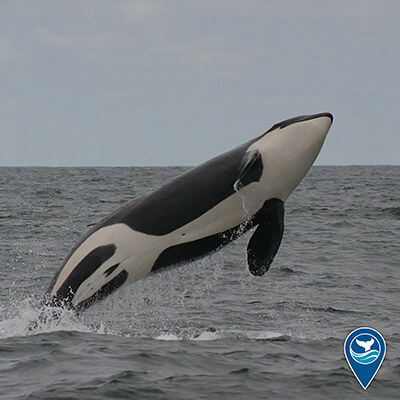
NOAA's Cordell Bank National Marine Sanctuary is not accessible to most people, but its importance in the marine ecosystem is emphasized through education and outreach programs!
The sanctuary staff works to get ocean literacy based programs into schools and informal programs, hosts radio programs, runs teacher workshops, and creates education exhibits to help teach the public about this special place.
Photo: Michael Richlen/NOAA

Have you ever seen the sun under the sea? Check out this sunstar sending you sunny vibes for your Saturday found in the depths of NOAA Channel Islands National Marine Sanctuary!
Photo: OET/NOAA

Dreaming of diving with the Goliath groupers that lurk in NOAA Florida Keys National Marine Sanctuary but stuck at home? Make some chalk art! Congratulations to our Sanctuaries at Home 2nd place winner Jill Brown for this creative shot!
Check out the rest of this year’s winners
Photo: Jill Brown

Today we are celebrating a big day for humpback whale conservation!
On November 4, 1992, two national marine sanctuaries were created that protect critical habitat for these majestic creatures: NOAA's Stellwagen Bank National Marine Sanctuary (above) is an important feeding ground for humpbacks and other endangered whales off Cape Cod, while Hawaiian Islands Humpback Whale National Marine Sanctuary (below) shelters humpbacks every winter as they breed and calve their young in the waters of Hawaii.
Photo: NOAA/MMHSRP Permit 20311

“While I often think of our National Marine Sanctuaries as special underwater places, this sunset heron reminded us that our sanctuaries are important habitats for species both on land and under the water.”
Congratulations to our Sanctuary Views 2nd place winner Michael Schilling for this great blue heron watching the sunset in NOAA Florida Keys National Marine Sanctuary!
Check out the rest of this year’s winners
Photo: Michael Schilling

Gone fishing? NOAA National Marine Sanctuary of American Samoa offers beautiful spots to recreate responsibly and enjoy the view. We want to congratulate our Sanctuary Recreation 2nd place winner, Makerita Gebauer!
Check out the rest of this year’s winners
Photo: Makerita Gebauer

“Mangroves are extremely important to our coastal ecosystems. They provide wave and wind protection, improve water quality, and provide habitats for all kinds of amazing animals like this seahorse.”
Our Sanctuary Life category 2nd place winner is Patrick Malloy! They weren’t horsing around with this shot, taken in NOAA Florida Keys National Marine Sanctuary.
Check out the rest of this year’s winners
Photo: Patrick Malloy

Happy Halloween!
Just like how you dress up for this spooky day, octopuses have the ability to put on a different disguise by changing shape, color, texture, and size. They can mimic other creatures, blend in among the rocks and corals, or even cover themselves in sand or shells. Tell us what costume you are wearing this year!
Photo: Greg McFall/NOAA
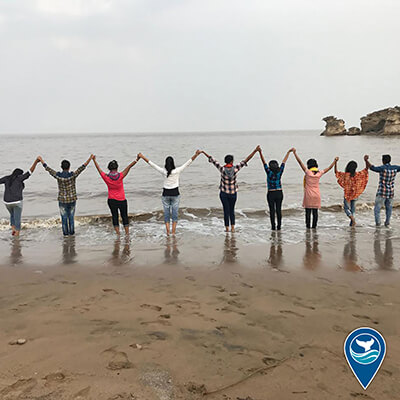
While it’s important to get outside, experience nature, and recreate responsibly, we know that many of us spent more time at home this year. In our Sanctuaries At Home category, photographers shared how they connected with national marine sanctuaries from afar.
Congratulations to Zalak Ghanshyambhai Sabapara for winning 3rd place with their entry “Chain of Happiness” at Bhavnagar coastal area in Gujarat, India.
Check out the rest of this year’s winners
Photo: Zalak Ghanshyambhai Sabapara

"NOAA's Monterey Bay National Marine Sanctuary has been a very special place for me for many years. This past year during the pandemic though, it was a place that brought a sense of normalcy...this ecosystem is one of the most vibrant on earth and it is a true privilege to spend time in and around it."
Congratulations to our Sanctuary Views category 3rd place winner Douglas Croft! We love seeing the sanctuary through your lens. 📸
Check out the rest of this year’s winners
Photo: Douglas Croft

“The views of NOAA Olympic Coast National Marine Sanctuary are so grand and beautiful that it feels like I’ve been transported to a movie set or something. Such surreal beauty is difficult to capture on camera but I love having a reminder of my time there.”
Congratulations to our Sanctuary Recreation category 3rd place winner, Mark Losavio. Over three million visitors discover the Olympic Peninsula each year, attracted by beautiful scenery, pristine wilderness, the spectacle of wildlife, and the opportunity to challenge themselves in a natural environment.
Check out the rest of this year’s winners
Photo: Mark Losavio

🎶 I always feel like somebody’s watching me…
It is time to show off the rest of the Get Into Your Sanctuary Photo Contest winners! Our Sanctuary Life category 3rd place spot goes to this curious giant trevally photographed by Kimberly Jeffries in Papahānaumokuākea Marine National Monument!
Photo: Kimberly Jeffries

🎓 Notice for students!
The application period for the 2022 Dr. Nancy Foster Scholarship Program has opened. The Scholarship Program provides support for master’s and doctoral degrees in oceanography, marine biology, maritime archaeology. Complete applications are due December 14, 2021.
Photo courtesy of Andrea Kealoha

Is it the ocean or outer space? This cosmic jellyfish combines the best of both worlds!
Researchers on the NOAA Ship Okeanos Explorer found this spectacular little jelly with a remotely operated vehicle while exploring the Utu Seamount in NOAA National Marine Sanctuary of American Samoa.
Photo: NOAA

Our Earth Is Blue campaign was created to bring attention to our planet, the ocean planet. The National Marine Sanctuary System protects some of the most iconic underwater places throughout the United States, but we can't do it without you. No matter where you are, the ocean and Great Lakes are in your hands. Earth Is Blue is meant to inspire you to #SaveSpectacular and care for our ocean. We want to spread the word that the Earth isn't green - it's blue.
Today we celebrate the launch anniversary of our campaign, tell us who you want to see featured this year!
Photo: Douglas Croft

Today is the 49th Anniversary of the National Marine Sanctuary System!
Starting from modest beginnings, this "good idea" has grown into a vibrant network of 15 national marine sanctuaries and two marine national monuments that protect some of our nation's most treasured seascapes, wildlife, and maritime heritage resources.
In partnership with the National Marine Sanctuary Foundation, we invite you to help us #SaveSpectacular as we celebrate, discover, explore, and enjoy the unique wonders of the National Marine Sanctuary System. Together we can ensure these special places are sustained as destinations for adventure, solace, and reflection for the next 50 years and beyond.
Photo: Greg McFall/NOAA

We are kicking off our 50th anniversary celebrations by taking you back to the beginning! Take a journey through time and learn about all the events that have unfolded over the past 50 years to create the national marine sanctuary system we have today! #SaveSpectacular

Celebrate 50 years of ocean conservation and stewardship with us and #SaveSpectacular! Nearly fifty years ago, a new era of ocean conservation was born by creating a system of national marine sanctuaries. Since then, the National Marine Sanctuary System has grown into a nationwide network of 15 national marine sanctuaries and two marine national monuments that conserve more than 620,000 square miles of spectacular ocean and Great Lakes waters.
Join us throughout the next year as we celebrate the history, accomplishments, and beauty of these incredible underwater parks across the United States!
Photo: NOAA

Ready for a quick kelp lesson?
Kelp forests, like this one in NOAA Channel Islands National Marine Sanctuary, are held down by holdfasts anchored to rocky substrates. Growing up towards the surface, gas bladders, called pneumatocysts, keep even the tallest kelp afloat. A giant kelp plant will have these bladders at the base of each blade, whereas bull kelp plants have only one that supports several blades near the surface.
Can you tell which kelp plant is featured here?
Photo: Robert Schwemmer/NOAA

Travel to the “Serengeti of the Sea” to see whales, seals, sharks, sea otters, and more all without getting wet! Check out what NOAA's Monterey Bay National Marine Sanctuary has to offer.
Photo: NOAA

Boop!
Just a curious little Hawaiian monk seal for your Monday. Seen swimming around Hawaiian Islands Humpback Whale National Marine Sanctuary, these monk seals are endemic to the Hawaiian Islands. One of the most endangered seal species in the world, they are protected under the Endangered Species Act, the Marine Mammal Protection Act, and State of Hawai'i law.
Photo: Ed Lyman/NOAA

What is a whale's favorite Bond film? License to Krill!
Krill martini, anyone? Found around NOAA's Cordell Bank National Marine Sanctuary, these small, shrimp-like crustaceans, known as krill, serve an important role in the sanctuary's food chain. Krill are referred to as "keystone" species because they are critical prey for so many other species on and around the bank. During the spring and summer, massive swarms of krill provide food for dominant species of the Cordell Bank ecosystem including seabirds, fishes, and whales.
Photo: Shannon Lyday/NOAA

Slow down today with NOAA Olympic Coast National Marine Sanctuary.
In addition to protecting important ecological resources, the sanctuary waters have a rich cultural and historical legacy, including two hundred shipwrecks are documented here. There are vibrant and contemporary communities of the Makah Tribe, Quileute Tribe, Hoh Tribe, and Quinault Indian Nation who have all forged strong ties to the ocean and surrounding environments.
The tribes work together with the sanctuary to protect resources, shape policy, conduct research, and provide educational programs. They also play a critical role in sanctuary management as active members of the Intergovernmental Policy Committee and the Sanctuary Advisory Council.
Photo: Adam Baus

Let us be your guide to NOAA's Greater Farallones National Marine Sanctuary!
Wildlife is often linked to specific seasons, places, and conditions. Learn about the best ways to explore this special place.
Photo: NOAA

Hard corals are the building blocks of coral reefs and the mainstay of the coral cap in NOAA's Flower Garden Banks National Marine Sanctuary.
These complex marine ecosystems include diverse collections of colorful fish and other sea creatures, but what is it that allows corals to grow and support so much wildlife?
Photo: G.P. Schmahl/NOAA

Sometimes life can be over-whale-ming, but just like this humpback whale in NOAA's Stellwagen Bank National Marine Sanctuary, you've gotta leap over those problems!
Get out to a national marine sanctuary for some well-deserved "vitamin-sea" and experience this beauty for yourself!
Photo: Ari Friedlaender
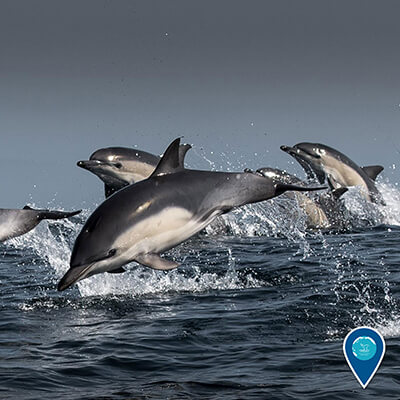
Did your morning commute get you down? You dolphinately need a pick-me-up!
Take some time today to explore NOAA's Monterey Bay National Marine Sanctuary virtually. Its diverse marine ecosystem also includes rugged rocky shores, wave-swept sandy beaches, and tranquil estuaries. These habitats are home to 36 species of marine mammals, more than 180 species of sea and shorebirds, at least 525 species of fishes, and an abundance of invertebrates and algae!
Photo: NOAA

Fancy fishing? Sanctuaries like NOAA Florida Keys National Marine Sanctuary are perfect places to go to enjoy recreational fishing and other activities. Reefs, seagrass beds, and mangrove-hugged islands support important fish habitat and provide visitors with unmatched experiences. The sanctuary works with anglers to ensure fishing activities don't harm sanctuary resources, and anglers help sanctuary managers keep an eye on changes to the marine environment.
Photo: Matt McIntosh/NOAA

What better way to celebrate Squid/Cuttlefish Day than with a stubby squid? In 2016, we teamed up with Nautilus Live to explore the deep ocean in and around NOAA Channel Islands National Marine Sanctuary, and spotted this little googly-eyed cephalopod!
Though they look like a cross between an octopus and a squid, stubby squid are actually closely related to cuttlefish. They spend their lives on the seafloor, coating themselves in a mucus jacket and burrowing into the sediment. Leaving just those big eyes peeking above the surface, they remain buried until prey items like shrimp or small fish - or a curious ROV - pass by.
Photo: OET/NOAA

Today begins #CephalopodAwarenessDays (and it is #OctopusDay)!
Cephalopods, a group of marine invertebrates with well-developed eyes and nervous systems, can be found throughout the national marine sanctuary system. These creatures include octopus, nautiluses, squids, and cuttlefish!
Photo: James Watt/NOAA
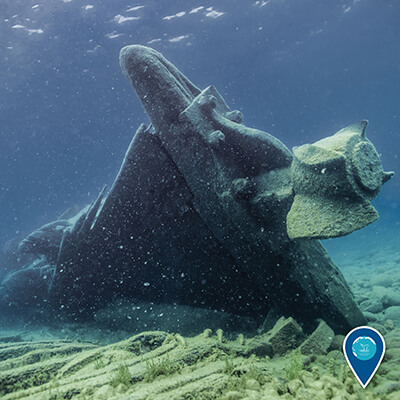
Help us celebrate Thunder Bay National Marine Sanctuary's anniversary today!
The sanctuary protects a nationally significant collection of nearly 100 historic shipwrecks in Lake Huron off the Michigan coast. Through research, education, and community involvement, the sanctuary works to ensure future generations can enjoy these underwater treasures. Take a walk along the Great Lakes Maritime Heritage Trail, hop on a glass bottom boat tour, paddle out on a kayak, or dive on a shipwreck, there is always plenty to explore!
Photo: Nick Zachar/NOAA

Are you ready for the spooky season?
This whale fall in NOAA's Monterey Bay National Marine Sanctuary was the life of the costume party, attracting all the creepy creatures from the deep! When a whale dies at sea, its body often sinks to the seafloor. There, its carcass becomes what is known as a whale fall. The whale’s body provides a sudden, concentrated food source — a bonanza for organisms in the deep sea for years to come.
Photo: OET/NOAA

There's a lot to see and do when you're in Hawaiian Islands Humpback Whale National Marine Sanctuary! Whether you are interested in whale watching, boating, fishing, or enjoying one of our visitor centers, there are so many different ways to recreate responsibly!
Photo: Matt McIntosh/NOAA

Today is World Habitat Day!
Found off the California coast, the waters within NOAA's Greater Farallones National Marine Sanctuary are home to nationally significant marine ecosystems and habitats, supporting an abundance of life. It provides breeding and feeding grounds for at least 25 endangered or threatened species; 36 marine mammal species; over a quarter-million breeding seabirds; and one of the most significant white shark populations on the planet!
Photo: Matt McIntosh/NOAA

Saddle up!
This mollusk is a horse conch, found in NOAA Gray's Reef National Marine Sanctuary! Horse conchs are the largest sea snail found in U.S. waters – they can grow up to two feet in length! They are predators, chowing down on other snails and mollusks.
Photo: NOAA

The most critically endangered of the great whales is the North Atlantic Right Whale. At the surface, this whale is identified by its V-shaped blow. They spend time in NOAA's Stellwagen Bank National Marine Sanctuary but laws prohibit close approaches so whale watch vessels avoid them; if boating, please stay at least 500 yards away from the animal.
Photo: Peter Flood

¡Encontrarse con la vida silvestre puede ser una oportunidad única en la vida! Para su seguridad y la de los demás, siga las pautas a continuación, manteniendo suficiente espacio entre usted y cualquier animal que encuentre, teniendo en cuenta las normativas locales; use sus binoculares o lentes zoom si quiere una vista más de cerca.
Encountering wildlife can be a once-in-a-lifetime opportunity! For their safety as well as yours, please follow the guidelines below, give wildlife plenty of space, be aware of local regulations and use your zoom lens or binoculars if you want that close-up view! Continue reading and take the pledge to have a memorable experience.
#HispanicHeritageMonth
Photo: Douglas Croft

On September 22, the NOAA Fisheries Pacific Islands Science Center’s Marine Debris Project team, joined by Papahānaumokuākea Marine Debris Project, marked the completion of their marine debris removal mission in Papahānaumokuākea Marine National Monument. The team arrived at Pearl Harbor aboard the charter vessel IMUA along with the nearly 124,000 pounds of marine debris removed during the 30-day mission.
Photo: NOAA

For centuries, the people of Samoa have lived with a very close connection to the ocean. Through outrigger canoes paddling, fautasi (traditional longboats), and now coastal rowing, Paula Stevenson McDonald has worked alongside NOAA National Marine Sanctuary of American Samoa to keep this relationship alive for future generations.
Check out her Story from the Blue
Photo: David Ruck/NOAA

A calm moment for your Tuesday...
NOAA Olympic Coast National Marine Sanctuary represents one of North America's most productive marine ecosystems and spectacular undeveloped coastlines. The sanctuary includes habitats as varied as broad sandy beaches, tide pools, rocky reefs, the open ocean surface, and deep sea canyons. These habitats provide for shelter, feeding, nesting, and other basic needs to sustain diverse and abundant marine wildlife populations!
Photo: Nick Zachar/NOAA

Happy #WorldTourismDay!
Whale Sense businesses use responsible ways to show you a flippin' great time while keeping the whales safe. Sustainable tourism practices can generate income for local communities while benefiting wildlife populations.
Photo: Ari Friedlaender
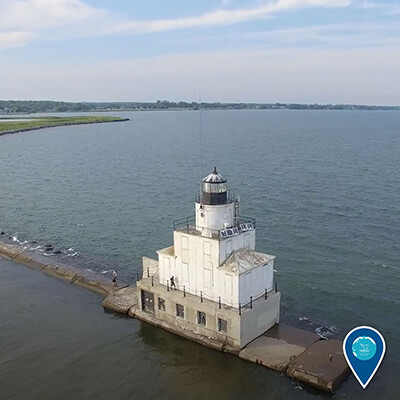
Your new Wisconsin Shipwreck Coast National Marine Sanctuary includes roughly 82 miles of shoreline and is entirely located within Wisconsin waters. The area includes a collection of nationally significant cultural resources, including 36 known shipwrecks and more than 50 suspected wrecks.
Photo: Ruck/NOAA

Today, while you are out celebrating #NationalPublicLandsDay, collect your ParkPassport badges!
Did you know National Park Trust allows you to collect badges for visits to your favorite local, state, and federal parks? This includes your National Marine Sanctuaries and Marine National Monuments!
Photo: Maria Brown/NOAA

This little red night shrimp has come to say hello!
NOAA's Flower Garden Banks National Marine Sanctuary is teeming with life. Take a virtual dive on the reefs of East and West Flower Garden Banks through a series of 360° photographs. Explore the beauty of our reefs without getting wet!
Photo: Frank Burek

Have no fear, the nurse shark is here!
Nurse sharks have nasal barbels used to find food and small teeth for crushing shellfish. You can find these sluggish bottom feeders in numerous sanctuaries, but this shark was spotted in NOAA Florida Keys National Marine Sanctuary.
Photo: Steve Miller

Close to the California coast, yet worlds apart. NOAA Channel Islands National Marine Sanctuary and Channel Islands National Park encompass the waters and five of the eight Channel Islands. A special place for endangered species, sensitive habitats, historic shipwrecks, and cultural resources, the sanctuary provides protection through research, education, conservation, and stewardship.
Photo: Chuck Graham

Sunset-tional!
The sunsets over Hawaiian Islands Humpback Whale National Marine Sanctuary never disappoint.
Photo: Tom Ayers

Can you guess what this creature is? Do you need a ~hint hint~?
A large bony fish, they can reach eight feet in length and primarily feed on jellyfish. This one was spotted in NOAA's Greater Farallones National Marine Sanctuary!
Photo: Sara Heintzelman/NOAA

While all of your sanctuaries and marine national monuments must face global effects of climate change, each is affected differently. By identifying direct threats to the sanctuary ecosystem, we can take steps to address problems facing the sanctuary today to best protect it for future generations.
Check out our Climate Change Impact Profiles
Photo: NOAA

Today is the 29th anniversary of NOAA's Monterey Bay National Marine Sanctuary and the International Coastal Cleanup Day! This year is a great opportunity to reconnect with family and friends in small, safe groups outdoors to collect and remove trash. Together we’ll make a difference in each of our communities to protect our ocean, coasts, and Great Lakes as we connect and collect. Help us ring in this special day by getting involved in a coastal cleanup near you.
Photo: Nathan Coy

Muh-muh-muh-ma-muh-muh-ma-muh-ma! Man(ta) Ray!
Today we are celebrating #WorldMantaDay! Manta rays are popular visitors to NOAA's Flower Garden Banks National Marine Sanctuary and can reach 22 feet from fin-tip to fin-tip.
Photo: Beata Lerman

The common snapping turtle is a species of freshwater turtle that spends most of its life in the water. This grumpy one was found swimming in the waters of NOAA Thunder Bay National Marine Sanctuary!
Their top jaw is curved and pointed, with force that can both intimidate and ward off potential predators and grasp their prey with ease. At the top of their snouts are two nostrils, which they use like snorkels to breathe without having to leave the water. We will be keeping our hands to ourselves!
Photo: James Garner

Snack time? Look closely and you will see this octopus in NOAA Gray's Reef National Marine Sanctuary is eating some shellfish!
But how do octopuses eat, anyway? An octopus's mouth is on its underside and contains a hard beak. The beak is made of chitin, a material similar to what's in your fingernails, and helps the octopus chow down on tough food!
Photo: P. Auster/NOAA/Beaufort Lab/University of Connecticut/Mystic Aquarium

This great shearwater from NOAA's Stellwagen Bank National Marine Sanctuary is on quite the journey!
All tracks started just east of Chatham, Massachusetts where the science team captured, sampled, tagged, and then released the birds. Tuskegee, pictured here, has been in a group targeting Georges Bank for feeding. You can check out all the bird's tracks and see whose tags are still reporting back.
This year's birds were named during our #NameThatShearwater event with The Black AF in STEM Collective.
Photo: Steve De Neef

Come sail away with this Velella velella in NOAA Olympic Coast National Marine Sanctuary!
Vellela vellela, or the by-the-wind sailor, is a small, unique species of jellyfish that has a vertical sail atop its float, helping it to travel. This sail is oriented at a diagonal to the animal’s body axis, allowing it to take advantage of prevailing wind currents that push the animal across the sea. Scientists have found that populations along the California coast tend to have sails oriented to the right, while populations farther west in the Pacific tend to have sails oriented to the left, reflecting differing wind patterns in their respective regions!
Photo: NPS

Today is National Day of Encouragement! This day is dedicated to uplifting people (or sea lions) around us and making a positive impact. California sea lions can be very social on land and in the water, setting a great example for today!
Photo: Douglas Croft

The shipwrecks of Mallows Bay-Potomac River National Marine Sanctuary provide prime nesting locations for many different bird species, including the iconic osprey. These distinctive hawks are at the top of the food chain in the Chesapeake Bay watershed and are talented fishers, often spotted plunging feet-first into the water to catch fish.
Photo: Matt McIntosh/NOAA

Whale would you look at that, it's already Friday! Are you leaping for joy like this humpback whale and sea lion in NOAA's Monterey Bay National Marine Sanctuary? Let us know how you plan to #RecreateResponsibly this weekend.
Photo: Douglas Croft
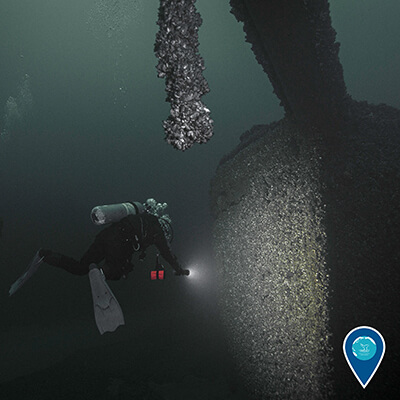
In April 2019, in response to a community-based sanctuary nomination, NOAA announced its intent to designate a new national marine sanctuary in New York's eastern Lake Ontario. The proposed sanctuary would celebrate the area's unique history and heritage and provide a national stage for promoting tourism and recreation.
NOAA welcomes your input about the proposal during the public comment period which ends tomorrow!
Photo: Nick Zachar/NOAA

Looking for a place filled with life and color?
Over 150 species of coral make up the centerpiece of marine life in NOAA National Marine Sanctuary of American Samoa. The sanctuary protects more than 1,400 species of other invertebrates and a wide variety of algae, several seagrasses, humpback whales and over a dozen other species of whales and dolphins, hundreds of fish species, over 30 seabird species, and hawksbill and green sea turtles. What are your favorite species to spot on a dive?
Photo: NOAA

San Francisco's most exclusive neighborhood is a rocky island group 27 miles offshore, at the Farallon Islands near NOAA's Greater Farallones National Marine Sanctuary!
This U.S. Fish & Wildlife Service refuge is the largest seabird rookery in the contiguous U.S. with over 300,000 seabirds, including Tufted Puffins. It's a B&B for seals and sea lions; surrounding sanctuary waters serve up a seafood feast for humpback and blue whales, white sharks, and giant sunfish.
Photo: Matt McIntosh/NOAA

Today is the last day of our Get Into Your Sanctuary photo contest! Submit your sanctuary photos and you could be featured in our yearly Earth Is Blue magazine, on our website, and in our Earth Is Blue campaign on social media.
Photo: Jon Anderson

Blue whales are the largest animals ever to live on our planet. They feed almost exclusively on krill, straining huge volumes of ocean water through their baleen plates (which hang from the roof of the mouth and work like a sieve). Found throughout the ocean, this one was spotted in NOAA Channel Islands National Marine Sanctuary taking a dive by a photographer.
Do you have a great photo, like this one, taken in a sanctuary? You have one day left to submit it to our annual Get Into Your Sanctuary photo contest!
Photo: Chuck Graham

It's National Wildlife Day and encountering wildlife can be a once-in-a-lifetime opportunity! For their safety as well as yours, check out our Wildlife Viewing Guidelines and take the pledge to protect your #WildSanctuaries!
Photo: Mark Sullivan/NOAA

Today we are celebrating the second anniversary of Mallows Bay-Potomac River National Marine Sanctuary! The resources are easily accessed by shore and water allowing this site to serve as is a living laboratory for people of all ages to learn about its history, heritage, and connected ecosystem.
Photo: Duke Marine Lab Marine Robotics and Remote Sensing

"Hands down, best fish taco I've ever had in my life." - Sydney Fife
While we wouldn't recommend eating this fish taco... there are other opportunities to find a good catch in NOAA Gray's Reef National Marine Sanctuary! Emerging technologies are making your trip to the sanctuary safer and more enjoyable for anglers and divers alike.
Photo: Greg McFall/NOAA

What's that hiding in the sand in NOAA Florida Keys National Marine Sanctuary? A southern stingray! During the day, these rays bury themselves in the sand to hide. At night, they graze the seafloor, using electroreceptors, touch, and smell to find their food. Southern stingrays are not aggressive toward humans, but watch out -- these stingrays have a barb at the base of their tail that will cause a painful laceration if stepped on.
Photo: David Ruck/NOAA

The wooden schooner Portland, one of the most accessible shipwrecks in NOAA Thunder Bay National Marine Sanctuary, lies a short swim away from shore, making it a great place to paddle or snorkel and experience the history.
This photo was submitted to our Get Into Your Sanctuary photo contest and was certainly a crowd favorite! Do you have a compelling photo from around the sanctuary system? Enter here
Photo: Bryan Dort

🚨 Alert! There is only one week left of our Get Into Your Sanctuary photo contest! We are looking for any photos of the sites, life, recreation, or stewardship in your sanctuary system or in your local watershed. Show us the sanctuary system through your lens!
Photo: Jason Jaskowiak
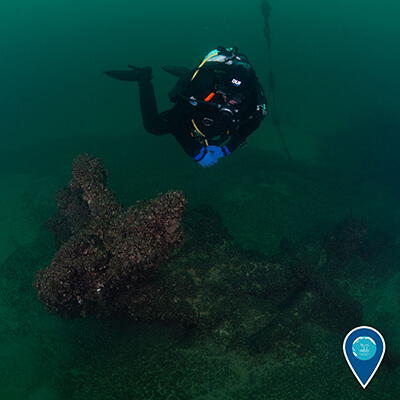
Diving in Wisconsin? Check out your newly designated Wisconsin Shipwreck Coast National Marine Sanctuary! There are so many incredible shipwrecks to explore, like this one, the wreck of the fish tug Henry Gust.
Photo: Joe Hoyt/NOAA

The garden-like coral and sponge habitats of Cordell Bank National Marine Sanctuary are a great spot for our octopus friends to stretch out a leg...or eight. What is your favorite octopus fact? Ours is that they have three hearts, just enough to be fully octo-pied with a love for the bank!
Photo: NOAA

Are you ready for the cutest staring contest? You otter practice, because this little friend is a pro!
This fluffy creature is a sea otter, a marine mammal found in several of your west coast national marine sanctuaries. Their population was drastically reduced in the 18th and 19th centuries due to hunting, but their numbers have been on the rise.
Photo: Douglas Croft

Happy 105th Birthday to the National Park Service! Did you know many of your National Marine Sanctuaries work alongside some of your favorite National Parks? Rialto Beach, pictured here and found near Olympic National Park, is located on the shores of NOAA Olympic Coast National Marine Sanctuary.
Photo: Karlyn Langjahr/NOAA

Giant barrel sponges are known as the "redwoods of the reef" for their large size (some can be up to six feet tall and three feet across), lifespan (up to 2000 years old), and provided habitat for many ocean creatures. If you find yourself diving in NOAA Florida Keys National Marine Sanctuary , be sure to check them out!
Photo: B. Goodwin/NOAA

Whalecome to minke whale Monday!
New England's own NOAA's Stellwagen Bank National Marine Sanctuary serves as an incredible whale watching destination. Planning a visit? Check out our whale watching tips to prepare for your next adventure!
Photo: Anna Smrcina/NOAA

ATTENTION. We are interrupting your scroll because...well, look at this young Risso's dolphin in NOAA's Monterey Bay National Marine Sanctuary!
These cetaceans generally prefer deeper offshore waters, especially near the continental shelf edge and slope, where they can dive to at least 1,000 feet and hold their breath for 30 minutes. If you see something cuter today, let us know because we won't believe it unless we see it...
Photo: Douglas Croft

Looking to get involved with Hawaiian Islands Humpback Whale National Marine Sanctuary? You can volunteer, participate in citizen science through our annual ocean count, intern with us, or participate in a beach clean up!
Photo: Robert Schwemmer/NOAA under NOAA Permit 774-1714

This green sea turtle is giving us the weekend mood.
The 1,350 mile stretch of Papahānaumokuākea Marine National Monument supports an incredible diversity of fish, corals, birds, marine mammals, and (most likely napping) sea turtles. Many of the creatures that call the monument home are unique to the Hawaiian Islands, and some, like the green sea turtle here, are listed as a threatened species.
Photo: Robert Schwemmer/NOAA

Feeling the stress of work? You must seek kelp!
Towering kelp forests, sea caves, and coves in the waters surrounding NOAA Channel Islands National Marine Sanctuary offer some incredible diving experiences! Variability in weather, underwater visibility, wildlife migration, and spawning cycles offer a new diving adventure every day.
Photo: Robert Schwemmer/NOAA

What is the most dishonest fish in the ocean?
The lionfish! Originally native to the Indo-Pacific, this species is invasive and found within Flower Garden Banks National Marine Sanctuary. While sustained removals of lionfish in shallow water can limit the impacts of these invasive species in certain locations, deep water control has been tricky. Two trap designs have been presented that can target lionfish in deep water and reduce negative effects on native species.
These traps have several benefits.
Photo: NOAA

"Splish splash I was takin a bath..."
This common murre must be taking a break from the crowded breeding colony. Did you know they nest in some of the densest colonies of all seabirds? Females lay one egg per season, holding the large egg between their legs to prevent predation and disturbance by eagles and gulls. You can find murres nesting around the islands of Greater Farallones National Marine Sanctuary!
Photo: Patrick Sysiong

Do you know what creatures you can find around shipwrecks near NOAA Monitor National Marine Sanctuary? When ships sink, they can sometimes help nurture life by creating a reef-like environment. Pictured here, USS Tarpon is heavily encrusted with coralline algae and supports an array of cnidarians, such as sea anemones and corals. Tarpon also typically has several sand tiger sharks on site, which can provide dramatic photographic subjects while enjoying this historic shipwreck dive.
Photo: Tane Casserley/NOAA

What are you lookin' at?
Anyone else feeling as grumpy as this fish looks as the weekend comes to a close? You can find this curmudgeon around NOAA Florida Keys National Marine Sanctuary, a great place to treat the Sunday scaries!
Photo: NOAA

Take a trip out to Mallows Bay-Potomac River National Marine Sanctuary and experience the Ghost Fleet! The sanctuary acts as a living laboratory for people of all ages to learn about the history, heritage, and connected ecosystem.
Photo: Matt McIntosh/NOAA

Meet Jemison! Since 2013, researchers at NOAA's Stellwagen Bank National Marine Sanctuary have been using satellite technology to study the movements, life cycle, and feeding and foraging habits of great shearwater seabirds in the Gulf of Maine ecosystem.
This year's great shearwaters were named during our #NameThatShearwater campaign with The Black AF in STEM Collective.
Photo: Steve De Neef

Today we are celebrating #InternationalYouthDay!
Educating our youth about the importance of a healthy ocean is crucial. Our Ocean Guardian School Program guides students to make a commitment to the protection and conservation of their local watersheds, the world's ocean, and special ocean areas, like national marine sanctuaries.
Photo: Nick Zachar/NOAA

Did you know today is #NationalLazyDay? Well, these sea lions certainly got the memo!
Found throughout Monterey Bay National Marine Sanctuary, California sea lions pack together on rocks, jetties, docks, or under wharves. You may even find them in the water resting in "rafts" of many animals, with heads and flippers poking out to absorb heat. Their piercing bark can be heard from quite a distance, so be sure to listen for these playful creatures next time you are near the sanctuary!
Photo: Robert Schwemmer/NOAA

“There’s nothing better than a beautiful day at the beach filled with sun, surf, and uh, diligent note-taking.” - Pam Beesly
The intertidal zone of Olympic Coast National Marine Sanctuary provides shelter, food, nesting, and more to countless creatures and critters. This creates an ideal environment for citizen science, exploration, research, or...office meetings...
Photo: The Ocean Agency

Who's ready for a whale of a time?
NOAA Channel Islands National Marine Sanctuary offers recreational opportunities year round! Variations in weather, underwater visibility, wildlife migration, spawning cycles, and more present a variety of experiences.
Photo: Bob Perry

If you are lost at sea, maybe this arrow crab can help to point you in the right direction?
Found in NOAA Gray's Reef National Marine Sanctuary, these creatures have long legs and cone-like bodies that give them a spider-like appearance. Not easily spooked, these crabs are often spotted by divers!
Photo: NOAA

Happy #NationalLighthouseDay! We are celebrating by highlighting the Point Conception Lighthouse near NOAA Channel Islands National Marine Sanctuary. For centuries, lighthouses have served as beacons, guiding mariners away from danger and marking the way to safe harbor.
Photo: Robert Schwemmer/NOAA

Looking for things to do when you Get Into Your Sanctuary? Tide pooling in NOAA Olympic Coast National Marine Sanctuary is great for the whole family!
Take a visit near the intertidal zone and you may be able to find sea stars, crabs, sea anemones, and more hiding in the cracks and crevices formed by the ocean.
Photo: Matt McIntosh/NOAA

This oyster toadfish would like everyone to know that today is #NationalOysterDay! The oyster toadfish counts, right?
Responsible recreation has kept NOAA Gray's Reef National Marine Sanctuary an ideal fishing destination for over 40 years. Join us as we introduce an online best fishing practices guide for you to make the most of your trip (we promise you will find more than toadfish...).
Photo: Allison Scott

Can anyone guess who this stEELy gaze belongs to? This wolf eel was found lurking in NOAA's Monterey Bay National Marine Sanctuary, so if you are diving in the area, be sure to keep your eyes pEELed!
Photo: James Watt/NOAA

Are you octo-pied with all our Get Into Your Sanctuary events this week? This day octopus found in Papahānaumokuākea Marine National Monument wants you to spend your days this week learning all about the ways you can recreate responsibly in your sanctuary system!
Photo: James Watt/NOAA

Surf's up!
Hawaiian Islands Humpback Whale National Marine Sanctuary offers incredible opportunities to get out and #RecreateResponsibly. During this week's Get Into Your Sanctuary events, take a virtual visit to the Waikiki Aquarium to explore some of the marine habitats and critters found in the sanctuary!
Photo: Bruce Sudweeks

Dip your toes in! The waters and coastline of national marine sanctuaries are waiting for you. NOAA’s National Marine Sanctuary System consists of 15 different national marine sanctuaries and two marine national monuments. Satisfy your taste for adventure while building a connection to these special ocean places.
Explore the many ways visitors like you enjoy their sanctuary by celebrating our seventh annual “Get Into Your Sanctuary” event August 2-8, 2021.
Photo: Douglas Croft

Looking for some summer plans? We've got you covered!
NOAA Channel Islands National Marine Sanctuary has year-round ways to Get Into Your Sanctuary! Dive, boat, paddle, fish, hike, and more while viewing some incredible wildlife.
Photo: Nick Zachar/NOAA
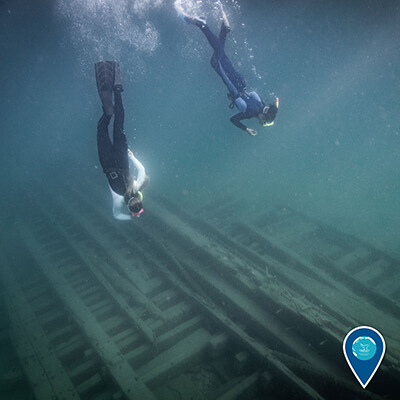
Celebrate International Day of Friendship by grabbing a friend or two and exploring one of your National Marine Sanctuaries! Let us know which sanctuary is your favorite to explore and how you get out and #RecreateResponsibly!
Photo: Nick Zachar/NOAA

Oh barnacles, did we miss hump day?
Every day is a good day to talk about humpback whales in Hawaiian Islands Humpback Whale National Marine Sanctuary! The sanctuary works with its partners and the community to monitor and reduce threats to humpback whales. The effort is aligned with education, research, and other resource protection efforts, such as enforcement.
Photo: Ed Lyman/NOAA under NOAA permit 14682

NOAA’s Office of National Marine Sanctuaries protects America's most iconic natural and cultural marine resources. This year, we are celebrating the seventh annual "Get into Your Sanctuary" event to continue to raise awareness about the value of our national marine sanctuaries. Join us from August 2-8 for a unique opportunity to experience all of NOAA's National Marine Sanctuary System from wherever you are, through virtual and in person opportunities!
Photo: Matt McIntosh/NOAA
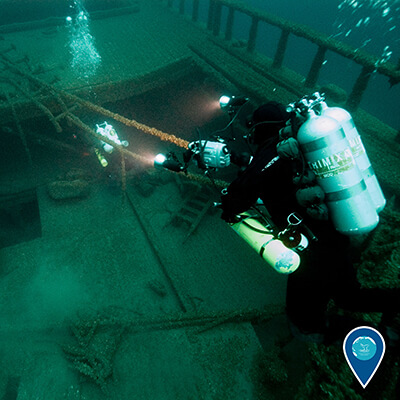
Grab your mask and fins!
The incredible shipwreck dive sites found in NOAA Thunder Bay National Marine Sanctuary are waiting for you. These wrecks sit at a wide range of depths in Lake Huron, appealing to a variety of dive skill levels. The sanctuary maintains seasonal moorings from May through September at many shipwreck sites allowing for safe and responsible access. Learn more about where you can find mooring buoys in the sanctuary.
Photo: Tane Casserly/NOAA

Did you know NOAA's Cordell Bank National Marine Sanctuary is entirely offshore? This underwater bank may be difficult to visit in person, but "investing" in its resources helps to protect some incredible ocean assets! You can learn more by checking out some great exhibits and visitor centers.
Photo: Robert Lee/BAUE/NOAA

These brittle stars in NOAA's Flower Garden Banks National Marine Sanctuary look like they're finishing up an intense game of twister!
Brittle stars are known as seafloor ecosystem engineers for their role in reshaping sediment on the ocean floor when they twist and coil their arms to move, which affects the distribution of other species. Brittle stars are also important in the food web providing nutrition to fish, sea stars, and crabs.
Photo: G.P. Schmahl/NOAA

Lettuce interrupt your feed with this beautiful sea slug!
This lettuce sea slug was photographed grazing its way through NOAA Florida Keys National Marine Sanctuary and was submitted to our annual Get Into Your Sanctuary Photo Contest. There is still time, submit your favorite sanctuary photos now through Labor Day!
Photo: Tiffany Duong

Lettuce interrupt your feed with this beautiful sea slug!
This lettuce sea slug was photographed grazing its way through NOAA Florida Keys National Marine Sanctuary and was submitted to our annual Get Into Your Sanctuary Photo Contest. There is still time, submit your favorite sanctuary photos now through Labor Day!
Photo: Tiffany Duong

Happy 27th Anniversary to NOAA Olympic Coast National Marine Sanctuary!
The sanctuary protects diverse wildlife from whales to seabirds to brilliantly colored sea slugs, but it is also rich in cultural resources, encompassing over 150 documented shipwrecks and fostering deep connections to the vibrant contemporary communities of the Makah Tribe, Quileute Tribe, Hoh Tribe, and Quinault Indian Nation.
What's your favorite way to experience Olympic Coast National Marine Sanctuary?
Photo: David Ruck/NOAA

The ocean connects us all! Humpback Whales, which feed in NOAA's Stellwagen Bank National Marine Sanctuary from April through December, migrate each winter to the Caribbean Sea near the Dominican Republic to mate and calve. To celebrate the geographic connection, Stellwagen Bank National Marine Sanctuary partnered with Hispanic Access Foundation and Massachusetts-based Iglesia de Dios Pentecostal to bring community members in Lawrence, Massachusetts on a whale watching trip to see these behemoth beauties up close! The fun-filled day during #LatinoConservationWeek was a whale of a time, bringing folks together and encouraging environmental stewardship.
Photo: Courtesy of Hispanic Access Foundation

There's no time for Tuesday snooze-day because we have some exciting research trips this year in Papahānaumokuākea Marine National Monument!
Learn more about the ongoing and future research projects. You can also check out the monument's Facebook page for updates from the field!
Photo: Robert Schwemmer/NOAA

Fagatele Bay is a .25 square mile coastal bay in NOAA National Marine Sanctuary of American Samoa. This special place is a naturally protected bay, formed by a collapsed volcanic crater and is surrounded by steep, forested cliffs. It is home to rich marine life and offers great recreational opportunities!
Photo: Greg McFall/NOAA

This week we are celebrating #LatinoConservationWeek! Created by the Hispanic Access Foundation, this week highlights the Latinx community's role in conserving the great outdoors and encourages continued protection into the future. For many, caring for the environment can be driven by shared positive experiences, check out Kevin Brannon's story about teaching his neighborhood to fish through the Reel Guppy Outdoors program.
Photo: Nick Zachar/NOAA

Do you know what spiracles are? Celebrate #SharkWeek by learning something new about sharks!
Photo: Nick Zachar/NOAA

*Cue the Jaws music*
This Laysan albatross, or mōlī, in Papahānaumokuākea Marine National Monument is in for a surprise. Tiger sharks like this one are voracious predators, much like their terrestrial namesake, and are known to take a bite out of just about anything that catches their attention. Though they can be frightening, sharks like the tiger shark are incredibly important animals in ocean environments. Sharks help remove dead or decaying debris from the ocean and thereby help keep our ocean clean, while also helping to keep ecosystems in balance.
Photo: Ilana Nimz/NOAA

"Ooooh, how many transects did you survey?"
This curious Galapagos shark is checking out these NOAA researchers in Papahānaumokuākea Marine National Monument after a 300-foot dive at Pioneer Bank!
Photo: NOAA & Richard Pyle-Bishop Museum

What's Shark Week without a Shark Awareness Day? Today we want to introduce you to the bluntnose sixgill shark!
As the name implies, sixgill sharks are distinguished by their six pairs of gills. They share very similar body characteristics to fossils from the Jurassic period millions of years ago! This friend was spotted in NOAA Channel Islands National Marine Sanctuary.
Photo: OET/NOAA

Did you just feel a chill down your spine? It may be from this ghost shark, also known as a chimera, swimming in the depths of the Gulf of Mexico. While related to sharks, these deep sea cartilaginous fish species genetically diverged from their shark relatives nearly 400 million years ago!
Photo: Hariotta Raleighana/NOAA

Shark Week, ooh ah ah!
We're kicking off shark week with this beautiful white shark! White sharks can be found in NOAA's Greater Farallones National Marine Sanctuary, where they depend on biologically and nutrient-rich waters. They play a vital role in maintaining a balanced ecosystem. Comment your biting shark questions below and we will answer them throughout the week!
Photo: Greg Skomal/MassDMF

Don't interrupt this very important meeting, it looks like they're about to *seal* the deal...
These Hawaiian monk seals may not be great at business but they can hold their breath for up to 20 minutes and dive more than 1,800 feet! Hawaiian monk seals are only found in the Hawaiian archipelago, endemic to these islands. They are protected under the Endangered Species Act, the Marine Mammal Protection Act, and State of Hawai'i law.
Photo: Paulo Maurin

Bird enthusiasts and watchers flock to NOAA's Greater Farallones National Marine Sanctuary for the diverse seabird populations and help support recreational businesses along the coast. The Seabird Protection Network was created to help reduce disturbances to these populations and other marine life. Join us in protecting the seabirds by letting them rest and sleep undisturbed. Seabirds react when people, boats, or aircraft get too close and interrupt natural behaviors, such as feeding, resting, or caring for chicks.
Photo: Ron LeValley

Make sure to get their good side! This queen angelfish was spotted swimming around NOAA Florida Keys National Marine Sanctuary and is ready for its photo-op. One of the most dynamic and beautiful reef residents, these fish are always a diving favorite!
Photo: Daryl Duda

Can you name this seabird?
You can spot them off the Pacific Coast, this one was seen in NOAA's Monterey Bay National Marine Sanctuary. Considered good luck by sailors, clumsy takeoffs and landings on nesting islands earned it the nickname, "gooney bird." Any guesses?
Photo: Robert Schwemmer/NOAA

Today is the last day of #CleanBeachesWeek, but we want to encourage you to keep your coastlines and waters clean all year round! Learn what microplastics are and actions you can take to keep them out of the ocean and off the beach by visiting:
Photo: Karlyn Langjahr/NOAA

It's time to get up close and personal with this anemone!
NOAA Gray's Reef National Marine Sanctuary is home to one of the largest live-bottom reefs in the southeastern United States. These live-bottom reefs are teeming with marine life, making this place a great destination for experienced divers.
Photo: NOAA

Enjoyed the beach for the 4th of July? Make sure you didn't leave trash behind! From little plastic bags that look like jellyfish snacks to sea turtles, to this mass of fishing nets that washed up in Papahānaumokuākea Marine National Monument, marine debris is a huge problem for wildlife in and beyond our sanctuary system. Do the ocean a favor and pack it out!
Photo: Koa Matsuoka

Don’t be in breach of Wildlife Viewing Guidelines! We are celebrating the red, white, and blue with Clean Beaches Week to protect and preserve our ocean and Great Lakes and all of their inhabitants, such as the humpback whales of NOAA's Monterey Bay National Marine Sanctuary. Due to their feeding methods, whales and other cetaceans are vulnerable to encounters with marine plastic floating through their habitats. By keeping our beaches trash-free and leaving no trace behind when we enjoy our shores, we’re also helping protect marine life down the line!
Photo: Douglas Croft

🍟 Who doesn't love a good beach snack? While it may seem helpful to share snacks with wildlife, feeding wild animals does much more harm than good and is illegal for many species. When you feed wild animals, they begin to associate people with food, which causes them to harass folks for more. These animals may become beggars and nuisances, causing property damage and harm to humans. They may also begin to lose their natural scavenging abilities, making them more susceptible to predators.
In the end, it’s the animal that often pays the price for our attempts to help. For the safety of people and wildlife please keep your snacks to yourself!
Learn how you can respect, protect, and enjoy your #WildSanctuaries.
Photo: Douglas Croft

Looking to bring Fido to the beach this weekend? Check local guidelines for restrictions before you go! Pets are not welcome everywhere. If pets are allowed, always keep them on a leash and away from wildlife. Wildlife and pets can cause stress, harm, and sickness to one another.
Learn how you can respect, protect, and enjoy your #WildSanctuaries.
Photo: James Roubal

This week is Clean Beaches Week, the perfect time to think about how the plastic you use impacts the ocean and other ecosystems. Trash we discard here on land can make its way into the sea, where it travels into distant ecosystems. By refusing, reducing, reusing, repurposing, and recycling, you can help reduce marine debris and negative impacts on wildlife throughout the ocean.
Photo: Douglas Croft

Do you have some incredible photos from around the sanctuary system? In celebration of national Get Into Your Sanctuary activities, we are hosting a photo contest running through Labor Day weekend! Winning photos will be featured in next year's Earth Is Blue Magazine and on the Earth Is Blue social media campaign.
Photo: Tiffany Duong

Stuck between a rockfish and a hard place? Yelloweye rockfish are among the longest-lived of rockfishes, with some reports of individuals living up to 150 years! This species also is very slow-growing and late to mature, but who's in any rush to grow up?
Photo: Matt Vieta/BAUE

A mola mola for your Monday Monday!
More commonly known as the ocean sunfish, these odd creatures get their name from their habit of laying their bodies on the surface of the water to warm themselves by the sun.
Photo: Linda Chaloupka

Lake Michigan, the second largest of the five Great Lakes, encompasses over 22,000 square miles. Locals and visitors alike are drawn to its beautiful waters, which are rich with maritime history and recreational opportunities. Your newly designated Wisconsin Shipwreck Coast National Marine Sanctuary is built on a strong community foundation forged by years of stakeholder collaboration.
Photo:NOAA/UNCW-UVP

Researchers at Stetson Bank in NOAA's Flower Garden Banks National Marine Sanctuary dolphinitely got a treat when these Atlantic spotted dolphins decided to investigate the remotely operated vehicle!
Photo:NOAA/UNCW-UVP

Manu-o-Kū, or white terns, like this one can be found around Papahānaumokuākea Marine National Monument. They are known by traditional Hawaiian navigators as one of the best indicators of land, as their flight patterns lead home every night. White terns are estimated to fly over 120 miles from shore to forage for food!
Photo: James Watt

You are in the presence of royalty! This colorful creature is a regal sea goddess nudibranch spotted in NOAA Gray's Reef National Marine Sanctuary. Nudibranchs are soft-bodied mollusks and are sometimes known as sea slugs. “Nudibranch” means “naked gills” – these mollusks carry their gills on their backs!
Photo: Greg McFall/NOAA

Gull: Have you been brushing and flossing? Say aaaah! Humpback whale: AAAAAAAH!
Humpback whales don't have teeth like humans, but feed on shrimp-like crustaceans and small fish, by straining huge volumes of ocean water through their baleen plates, which act like a sieve!
Photo: Jeremy Winn
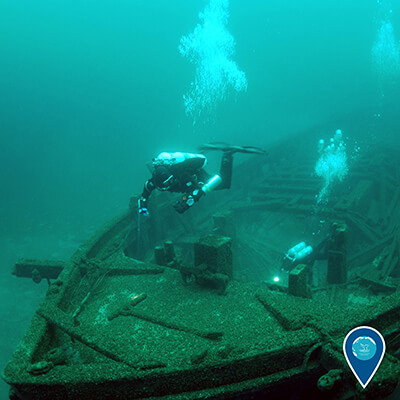
🚨 Your sanctuary system is growing! Preserved for centuries by the cold, fresh water of Lake Michigan, 36 historically significant shipwrecks are now protected within the newly designated Wisconsin Shipwreck Coast National Marine Sanctuary. The sanctuary will provide a national stage for local communities to promote heritage tourism and recreation, attract new partners and resources, and bring attention and action to broader Lake Michigan conservation issues. Join us in celebrating and welcoming Wisconsin Shipwreck Coast to the National Marine Sanctuary System!
Photo: Tamara Thomsen/Wisconsin Historical Society

You may have seen these colors in your garden at home, but the deep-sea "gardens" of coral in NOAA Channel Islands National Marine Sanctuary can be just as vibrant! What creatures can you spot?
Photo: Adam Obaza

Sound the horns! This trumpetfish, found in NOAA Florida Keys National Marine Sanctuary, is here to play the high C's!
Trumpetfishes are strict carnivores that feed on smaller fish and invertebrates. The exact composition of their diet depends on where in the ocean they live, but they don’t seem to be picky, going for whatever is easiest to catch and eat.
Photo: Greg McFall/NOAA

Today we are commemorating Juneteenth, the day (June 19, 1865) when enslaved people in Galveston, Texas, were informed of their freedom -- two and a half years after President Abraham Lincoln issued the Emancipation Proclamation. This day promotes and cultivates knowledge and appreciation of African American history and culture across our nation.
NOAA Monitor National Marine Sanctuary is home to USS Monitor, an ironclad ship built to lead the Union Navy during the Civil War. As important as it is to learn about the technical marvel this vessel came to be, it is vital to honor those that served aboard USS Monitor during some of our Nation's most historic hours. The men of the USS Monitor served with distinction and only by working together could this crew survive the horrors of war. Among the 62 man crew, we know of eight African American men who worked aboard USS Monitor. Their names were William Nichols, Siah Hulett Carter, William Scott, Robert Howard, Robert Cook, Edward Cann, Daniel Moore, and William Jeffrey.
Photo: NOAA

NOAA Olympic Coast National Marine Sanctuary is known for big charismatic animals like orcas and sea otters, but how much do you know about the smaller animals, like sea stars, that dwell here?
Photo: Matt McIntosh/NOAA

It is time to go into the depths and back in time!
NOAA Thunder Bay National Marine Sanctuary has incredible maritime history beneath the surface waiting to be explored. Wrecked in 1897, the wreck of Florida rests at a depth of 206 feet.
Photo: Keith Flood

Help us celebrate World Sea Turtle Day!
The green sea turtle, or honu, in Hawaiian culture represents the navigator, one who finds their way home time after time. They are abundant in legends and have been depicted in petroglyphs.
This species is currently listed as endangered, but conservation efforts are showing a promising increase in the population. What is your favorite species of sea turtle?.
Photo: Nick Zachar/NOAA

What is an octopus's favorite band? Ink Floyd!
Octopuses use several different strategies to evade predators—they camouflage themselves by quickly changing their skin color, they make colorful displays or eject ink to startle or confuse potential predators, they squeeze into small crevices to escape, and they quickly propel themselves through water.
Next time you're diving in NOAA's Greater Farallones National Marine Sanctuary, watch for a fleeting glimpse out of the corner of your eye!
Photo: Greg McFall/NOAA

Picturing yourself in this paradise? NOAA National Marine Sanctuary of American Samoa is the perfect place to escape to, even if it's just in your mind! This remote national marine sanctuary preserves incredible biodiversity, as well as rich cultural history.
Photo: NOAA

When planning a fishing trip within NOAA Florida Keys National Marine Sanctuary, book with a Blue Star recognized charter and know you are selecting an operator dedicated to education and habitat conservation. #TheWaterIsOpen
Photo: Matt McIntosh/NOAA

Get your fish on!
Hawaiian Islands Humpback Whale National Marine Sanctuary offers great recreational fishing opportunities. Learning about sustainable recreational fishing offers an opportunity for young people to gain knowledge about the ocean while instilling a life-long ocean stewardship practice.
Photo: Matt McIntosh/NOAA

Total eclipse of the jellyfish!
This beautiful shot was captured in NOAA's Monterey Bay National Marine Sanctuary and submitted to last year's Get Into Your Sanctuary photo contest. Our contest this year is open now through Labor Day Weekend and we want to see the sanctuary system through your lens!
Photo: Bruce Sudweeks

Getting out on the water can be great for your physical and mental health. National Marine Sanctuaries, like NOAA's Flower Garden Banks National Marine Sanctuary, were created to provide the public with opportunities to responsibly enjoy these special places while protecting their unique beauty, biodiversity, and historical significance for future generations.
How do you #RecreateResponsibly for National Fishing and Boating Week?
Photo: Sepp Haukebo

Today is World Ocean Day!
Our planet is an ocean planet: Earth Is Blue. The National Marine Sanctuary System protects some of the most iconic underwater places throughout the United States, but we can't do it without you. No matter where you are, the ocean and Great Lakes are in your hands. From the air we breathe, climate regulation, providing food, and economic benefits, the ocean supports life on our planet.
Tell us what your favorite thing about the ocean is!
Photo: Matt McIntosh/NOAA

Try to head outside this week if you can and take time to enjoy the outdoors safely! Mallows Bay-Potomac River National Marine Sanctuary in Maryland offers great views of wildlife and remnants of WWI-era wooden steam ships. Where do you #RecreateResponsibly?
Photo: Matt McIntosh/NOAA

It's time to kick off National Fishing and Boating Week!
In NOAA Channel Islands National Marine Sanctuary, a comprehensive ecosystem-based management approach is used to promote the long term conservation of sanctuary waters, wildlife, habitats, and cultural resources, while allowing for responsible recreation. Come celebrate with us all week! #TheWaterIsOpen #ILoveMySanctuary
Photo: Ramona Lisa McFadyen

Today is the day we #NameThatShearwater! Since 2013, researchers at NOAA's Stellwagen Bank National Marine Sanctuary have been using satellite technology to study the movements, life cycle, and feeding and foraging habits of great shearwater seabirds in the Gulf of Maine ecosystem. This year, birds will be fitted with the transmitters, and we needed help naming 14 of them!
Tune in to The Black AF in STEM Collective's #BlackBirdersWeek2021 Facebook Live at 1 pm EDT to hear more about the tagging project and find out the new names for this year's great shearwaters. Follow along and stay connected all summer as we track the birds around the Atlantic!
Photo: David Wiley/NOAA

These regal-looking fluffballs are white terns, or manu-o-kū in Hawaiian. White terns are found throughout Papahānaumokuākea Marine National Monument, where instead of building nests, they lay their singled speckled egg on a small depression on a branch, roof or other surface. Such minimalism!
Photo: Melody Bentz

The birds that visit and reside in the National Marine Sanctuary System connect our country's ocean, Great Lakes, and coasts. #BlackBirdersWeek2021 is continuing to inspire new generations of birders and nature-lovers. This week is highlighting Black nature enthusiasts while increasing the visibility of Black birders and reinforces that the outdoors are for everyone. Head over to The Black AF in STEM Collective to learn more!
Photo: NOAA

We peli-can't wait till we are soaring into the weekend! Did you know your National Marine Sanctuary System has great opportunities to go bird watching? Check out some of the incredible and sometimes goofy birds that call the sanctuary system home.
Photo: Peter Flood

There's no need to fight, let's have a fair contest!
For #BlackBirdersWeek2021, help us name 14 great shearwaters tagged in Stellwagen Bank National Marine Sanctuary!
Submit your best name ideas by commenting below or posting on Twitter, Instagram, or email us at stellwagen@noaa.gov with your suggestions, from May 28 to June 4 with #NameThatShearwater and tag us, The Black AF in STEM Collective, and NOAA's Stellwagen Bank National Marine Sanctuary.
Tune in to The Black AF in STEM Collective's Facebook Live event to hear the winning names on June 5th at 1:00 p.m. EDT!
Photo: Peter Flood

Today, for Memorial Day, we honor the many people who gave their lives in service to our nation. In addition to protecting important ecosystems and habitats, your National Marine Sanctuary System also protects maritime heritage resources that tell the story of our maritime nation.
Papahānaumokuākea Marine National Monument, for example, protects the waters around Midway Atoll, which are the resting place for at least 31 sunken aircraft that are considered war graves. The Battle of Midway was one of the most decisive U.S. victories of WWII and is referred to as the turning point of the war in the Pacific. Here, a diver documents the wing section of a F4U Corsair.
Find out more about an expedition to explore these aircraft and honor the legacy of the brave men who helped to turn the tide in the Pacific.
Photo: Tane Casserley/NOAA

Looking to Get Into Your Sanctuary? If you find yourself near NOAA's Greater Farallones National Marine Sanctuary, be sure to check out Duxbury Reef!
This area is home to a large diversity of marine invertebrates and algae and is among the largest shale reefs in North America. Pebbles of all shapes and sizes sparkle in the sun and surf, but be sure to check the tides before you go!
Photo: NOAA

What do corals keep up with? Current events! ...get it?
Tune into the current events in NOAA National Marine Sanctuary of American Samoa and learn more about the educational resources for teachers and students!
Photo: Greg McFall/NOAA

Are you ready to Get Into Your Sanctuary? There are a few things you should know before you go!
Encountering wildlife can be a once-in-a lifetime opportunity. For their safety as well as yours, please follow a few guidelines to ensure a positive and memorable experience:
🦦 Keep your hands to yourself and keep wildlife safe and healthy.
🐢 Report wildlife that seems sick or abandoned and leave it to the experts!
🐕 Keep pets home or on a leash.
🥤 Lend a hand with trash removal and keep their home clean.
🍟 Keep your snacks to yourself and let wildlife find their own food!
🏅 Lead by example and help others become responsible wildlife watchers.
🌅 Hang back and enjoy the view!
Take the pledge to respect, protect, and enjoy your #WildSanctuaries!
Photo: Bruce Sudweek

Hawaiʻi, the most isolated archipelago in the world, was globally connected in the 19th century due to the efforts of King David Kalākaua of the Hawaiian Kingdom, who reigned from 1874 to 1891. An educated and charismatic leader, he is the first head of state to circumnavigate the globe. His intellectual and artistic pursuits included science, law, music composition, military strategy, history, and new technology. Kalākaua, an avid inventor, met Thomas Edison in New York in 1881. By 1887, his home ʻIolani Palace boasted 325 incandescent bulbs four years before the White House acquired electric lights. His leadership inspired his people to take pride in their intellectual and cultural heritage. Kalākauaʻs vision of a vibrant nation is embodied and expressed by the cultural practitioners and artists at the annual Merrie Monarch Festival held in Hilo, said to be the “Superbowl” of hula and Hawaiian culture.
Photo: J.J. Williams/Hawai‘i State Archives

Peek-a-boo!
Did you know one third of southern California's kelp forests are found within NOAA Channel Islands National Marine Sanctuary and Channel Islands National Park? These forests host and support invertebrates, fish, marine mammals, and seabirds through shelter, food, and habitat!
Photo: Claire Fackler/NOAA

Can you guess what species of dolphin this is spotted in NOAA's Stellwagen Bank National Marine Sanctuary?
It is an Atlantic white-sided dolphin! They are extremely social animals, often living in pods of over 50 animals, and sometimes in super-pods numbering up to 1,000.
Photo: Elliott Hazen, NOAA Fisheries permit #14245

Today we are celebrating the 32nd Anniversary of NOAA's Cordell Bank National Marine Sanctuary!
Cordell Bank is the centerpiece of the sanctuary, a bank that rises from the soft sediments on the edge of the continental shelf just 22 miles west of Point Reyes. The combination of ocean conditions and topography create a rich and diverse marine community around the bank. This supports all kinds of fish, invertebrates, marine mammals, and incredible seabirds. Join us in celebrating your Cordell Bank National Marine Sanctuary!
Photo: Greg McFall/NOAA

Happy World Turtle Day!
Check out this endangered Hawksbill sea turtle found in NOAA Florida Keys National Marine Sanctuary. Hawksbills get their name from their unique beak-like mouth, which resembles that of a hawk and is perfect for finding food sources in hard-to-reach places. Fun fact: they are the only species of sea turtle that can survive on a diet of mainly sponges!
What is your favorite species of turtle?
Photo: Alexander Nuefeld

We have an inkling this is the cutest squid you've seen today!
NOAA Gray's Reef National Marine Sanctuary is teeming with life of all sizes, from whales and dolphins to squid and sponges.
Photo: Greg McFall/NOAA

Today is Endangered Species Day and we are honoring none other than Laysan ducks. As the world's most endangered duck, they're considered the rarest native waterfowl in the United States: while once found throughout the Hawaiian Islands, today they only reside in the Northwestern Hawaiian Islands. There, they're protected by Papahānaumokuākea Marine National Monument. In recent years, Pacific Islands: U.S. Fish and Wildlife Service has relocated some Laysan ducks from Laysan Island to Midway Atoll and Kure Atoll, in order to increase their chance of survival!
Let us know which endangered species you want to learn more about!
Photo: Andrew Sullivan-Haskins

...46...47...48...49...oh we give up! How many spots can you count on this spotted eagle ray in NOAA Florida Keys National Marine Sanctuary?
Photo: Olivia Williamson

Dr. Isabella Kauakea Aiona Abbott has been called “the First Lady of Limu.” She was the first Native Hawaiian to earn a doctorate in science, the first female biology professor at Stanford University, and an internationally recognized authority on marine algae, or limu in Hawaiian, bringing unique ancient Hawaiian knowledge to her studies and teachings. She was the author of eight books and more than 150 scientific papers. She named more than 200 species, as well as naming NOAA’s research vessel, Hiʻialakai, which in Hawaiian means “embracing pathways to the sea.” Isabella was a towering inspiration to generations of students and colleagues due to her achievements, connections to people, and a lifelong passion for limu. She was a member of the Reserve Advisory Council from 2001 until her passing in 2010. In a fitting tribute, researchers at Papahānaumokuākea Marine National Monument named a recently discovered species of limu from Papahānaumokuākea after Isabella: Martensia abbottiae.
Photo: Celia Smith/University of Hawaiʻi

"And IIIIIIIIIIIII-e-IIIIIIIII will always love you!"
Today feels like the perfect day to sing a love ballad for this common murre in NOAA's Monterey Bay National Marine Sanctuary. The common murre is a wing-propelled diving seabird, capable of diving to depths exceeding 650 feet. Murres rarely come to shore, except to breed on offshore islands such as the Farallon Islands in NOAA's Greater Farallones National Marine Sanctuary and islets off Point Reyes National Seashore!
Photo: Douglas Croft

Fronting the Hawaiian Islands Humpback Whale National Marine Sanctuary Visitor Center on Maui lies a Hawaiian cultural landmark: the Ko`ie`ie Loko I`a. The Ko`ie`ie is a three-acre ancient fishpond – one of the last remaining along the south Maui coast. Fishponds are a unique form of marine aquaculture and they continue to play an important role in the Hawaiian culture.
Typically built between 1200 and 1600, fishponds were used by native Hawaiians to ensure that their local communities had enough fish to eat and were also considered an important place of trade and wealth. The community would come together to build the rock wall, purposely built higher than the year’s highest tides, extending out into the ocean. The addition of sluice gates in the wall allowed the movement of smaller fish in and out of the pond, trapping the larger fish inside. They would even line the shoreline with rocks from nearby stream beds and valleys to inhibit sand and sediment from entering the pond and to help control water levels.
Photo: NOAA

Spikes! We wouldn't want to be caught off-guard by this crown-of-thorns sea star!
These venomous sea stars are abundant in NOAA National Marine Sanctuary of American Samoa and are hungry coral hunters. Although they are a native species, in large numbers, these creatures can have a negative impact on reefs across the Indo-Pacific. These "outbreaks" can be caused by hurricanes, rising temperatures, and other events cause by climate change. Here, NOAA diver Dr. Kelly Gleason injects ox bile into the central disk of a crown-of-thorns sea star. This natural substance kills the animal but does no harm to the reef.
Photo: Greg McFall/NOAA

Is Shark Saturday a thing? Because we think it's a fin-tastic idea!
NOAA Monitor National Marine Sanctuary is the perfect place for a diver to not only come face to face with history, but also to swim with the ocean's magnificent creatures, offering an experience to remember!
Photo: Greg McFall/NOAA

Did you know that open-ocean wayfinding has been an important aspect of Hawaiian culture for thousands of years? The Pacific Ocean, larger than all the earth's continents combined, was a maritime highway for ancestral Polynesians who utilized the sky as a map. Before modern instruments were invented, such as the compass, sextant, and GPS, Pacific Island navigators relied on their extensive knowledge of astronomy, wind patterns, ocean swells, cloud formations, and other natural phenomenons of nature as signs to guide them toward their destination. They sailed double hulled voyaging canoes stocked with supplies, plants, and animals over thousands of miles of open ocean. This ancestral knowledge and skill set made the exploration and settlement of the far flung islands and archipelagos of the Pacific Ocean possible.
Traditional Polynesian wayfinding practices were in danger of being forgotten due to technological advances and Western influence, however, it is currently making a comeback thanks to many people including Nainoa Thompson who is the first modern-day Native Hawaiian to learn and use wayfinding for long- distance, open sea voyaging. Nainoa Thompson (pictured here) and other contributors, including the Polynesian Voyaging Society, play a huge role in keeping these traditional methods and techniques preserved for future generations to come.
Photo: James Watt/NOWRAMP

Located in NOAA's Monterey Bay National Marine Sanctuary and protected by the National Estuarine Research Reserve, Elkhorn Slough is one of California's great coastal wetlands. Its waterways, mudflats, and marsh support a wide diversity of wildlife, hosting more than 340 species of birds, including several endangered species, making the slough one of our nation's premier bird watching sites!
All of May is American Wetlands Month, let us know where your favorite wetlands are!
Photo: USGS

Hawaiian names are given to remember historical events, ancestors, geographical features, and moʻolelo (stories/histories). These are commemorated in many ways like mele (songs), hula (dances), moʻolelo and inoa (names). A name given to a person or place to commemorate a certain event or to honor a certain chief was called an inoa hoʻomanaʻo- literally translating to "remembering name."
Genealogies were extremely important and central to identity whether related to ancestry or a genealogy of practice and play a central role in the naming process. Hawaiian knowledge was passed on orally from one generation to the next and from an early age, children were taught how to acquire and apply Hawaiian knowledge systems throughout their lives. These lived experiences were committed to memory and Hawaiian knowledge could be retrieved because of intimate relationships among people and place over time. Inoa kūpuna (ancestral names) are precious in Hawaiian culture and valuable for intergenerational connections which is why some Hawaiian children are given ancestral names to honor their ancestors.
Subsequently, inoa ʻāina (place names) were held in equally high regard. Often, inoa ʻāina act as inoa hoʻomanaʻo in the sense that the names are given to memorialize a certain chief or deity in Hawaiian or to remember important events from among the countless moʻolelo that are told. Other inoa ʻāina give insight into environmental features of the area such as climate, topography, or vegetation. The island of Nihoa (pictured here) in Papahānaumokuākea Marine National Monument, meaning toothed or jagged, is one such inoa ʻāina. It clearly paints a picture of the jagged, unstable terrain that makes up this island. The geographical features of Papahānaumokuākea have more recently been given names, however, there are ancient names for those places spread throughout mele and moʻolelo that have yet to be uncovered.
Photo: Brad Ka‘aleleo Wong/Office of Hawaiian Affairs

It is American Wetlands Month!
Meet Tomales Bay, located in NOAA's Greater Farallones National Marine Sanctuary! This bay was designated as a wetland of international importance under The Ramsar Convention on Wetlands in 2002. Tomales Bay is a marine-coastal wetland consisting of estuaries, eelgrass beds, sand dune systems, and tidal marshes. These diverse habitats support eel, sturgeon, halibut, endangered Coho salmon, and Pacific herring that rely on its creeks and extensive eelgrass beds to spawn.
Photo: Robert Schwemmer/NOAA

Enjoy the natural and cultural resources in NOAA National Marine Sanctuary of American Samoa! These "foaga" (grinding stone holes or bait cups) found at Fagatele Bay are indicative of early Samoan settlement. Carved into the shoreline along the reef edge, the stone holes may have been used to sharpen basalt stone tools or for collecting sea water to make sea salt, creating the bowl shapes over time.
Photo: Nerelle Que/NOAA

To all the mothers out there who keep us afloat, Happy Mother's Day!
This sea otter is cuddling up with it's pup in NOAA's Monterey Bay National Marine Sanctuary. Mother sea otters will hold their babies on their bellies as they float at the surface to rest and nurse until they grow old enough to fend for themselves. You otter call your mom!
Photo: Douglas Croft

We will never get tired of seeing all this color!
NOAA's Cordell Bank National Marine Sanctuary is a popular study site for scientists to collaborate with universities, non-governmental organizations, and federal agencies because of the unique and high diversity on the bank!
nterested in learning more about projects conducted in the sanctuary? Check out our Conservation Science Program
Photo: Joe Hoyt/NOAA

Mokumanamana, an island with Hawaiian cultural significance in Papahānaumokuākea Marine National Monument, sits near the Tropic of Cancer, a circle of latitude around the Earth that marks the northernmost position where the sun is observed at the zenith, the point directly above the observer, on the summer solstice, the longest day of the year in the Northern Hemisphere.
This has significance in Hawaiian cosmology, non-instrument navigation, and traditional cultural ceremonies. In Hawaiian, the path of the sun along the Tropic of Cancer is called "ke alanui polohiwa a Kāne," or "the black shining road of Kāne” (the god associated with the sun). This boundary divides the Hawaiian Archipelago into two realms known as Pō and Ao, which literally means night and day. According to the Hawaiian creation chant Kumulipo, Pō is the realm of spirits and gods and Ao is the realm of the living. As the westernmost place in the Hawaiian Archipelago, many believe the islands and seas of Papahānaumokuākea are the pathway that spirits travel after death, returning to Pō.
Photo: Kekuewa Kikilo

Time to spill the mana-tea!
While not great at gossip, these large, air-breathing herbivores are found in shallow, slow-moving waters where seagrass beds or vegetation flourish. Manatees are listed as a federally endangered species, largely due to human activity. Manatees are slow-moving and therefore unable to swim quickly away from boats; this often results in collisions that may cause injury or death to the creatures. In areas that are known manatee habitats, boaters should slow down and produce only minimal wake.
Have you seen a manatee floating beneath the surface in NOAA Florida Keys National Marine Sanctuary?
Photo: Sam Farkas

Can you guess what kind of bird this is spotted in NOAA's Stellwagen Bank National Marine Sanctuary?
Here are some hints: A very small gull of northern and offshore waters, spending most of their time at sea, and named for their nasal callnotes.
Photo: Peter Flood

That's no moon...it's an urchin.
These invertebrates are looking for love in Alderaan places, as this death...we mean sea star tries to make this sea urchin their next meal in NOAA Gray's Reef National Marine Sanctuary.
May the 4th be with you. Keep an eye out for the sequel, The Urchin Strikes Back!
Photo: Greg McFall/NOAA

All of May we are celebrating Asian/Pacific American Heritage Month and our sanctuaries’ unique historic and cultural identities!
The Kumulipo (Source of Deep Darkness), is one of the most renowned Native Hawaiian chants chronicling the birth of the natural world in and from Pō (the darkness), beginning with the first known form of life, the coral polyp, and progressing to more complex forms such as seaweed, fish, birds, and islands. The Kumulipo emphasizes Native Hawaiian cosmology through one of their most revered beliefs--the direct genealogical relationship between humans and the natural environment. This concept is perpetuated today through the restoration of habitats and continued preservation of the natural and cultural environment as evidenced in Papahānaumokuākea.
The name Papahānaumokuākea was inspired by a story in the Kumulipo of Papahānaumoku (a mother figure personified by the earth) and Wākea (a father figure personified by the expansive sky). These two deified ancestors are revered by Native Hawaiians, as their union and others along their family line resulted in the creation, or birthing, of the entire Hawaiian Archipelago and the Native Hawaiian people themselves.
Because of this, Papahānaumokuākea is a ‘āina akua (sacred region) to Native Hawaiians. The naming of the monument as Papahānaumokuākea honors and preserves these beliefs, strengthening the cultural foundation of Hawaiʻi and connecting Hawaiians to an important part of their history.
Photo: Solomon Enos

How does that saying go? Keep your friends close and your anemones closer!
This beautiful anemone was spotted in NOAA's Greater Farallones National Marine Sanctuary. Though anemones look rather like flowers, they’re actually animals. Their “petals” are stinging tentacles that they use to gather food like small fish and crabs toward their mouth.
Photo: Nick Zachar/NOAA

This bird is a real stud puffin!
Nicknamed "parrots of the sea" for their tricolored bills, Atlantic puffins are regular visitors to NOAA's Stellwagen Bank National Marine Sanctuary and the waters off Massachusetts from October to mid-winter.
Photo: Peter Flood

Whale, whale, whale...what do we have here?
Melon-headed whales are found primarily in deeps waters throughout tropical areas, like Hawaiian Islands Humpback Whale National Marine Sanctuary. They make fast, low leaps from the water as they swim and tend to rest in the morning, socialize in the afternoon, and forage for food at night.
Photo: Laura Morse/NOAA

On this day 35 years ago, Fagatele Bay was designated as the first site of NOAA National Marine Sanctuary of American Samoa!
In 2012, NOAA expanded the sanctuary to cover a total of 13,581 square miles of nearshore coral reef and offshore open ocean waters across the Samoan Archipelago!
Take a virtual tour of the bay.
Photo: Greg McFall/NOAA

Can you guess what this is? Alien from another planet? Close-up of a flower? If you guessed banded sea urchin from Papahānaumokuākea Marine National Monument you are correct!
Urchins do not have brains, eyes, or noses but can respond to changes in light, chemistry, and other environmental factors using sensory molecules that cover their bodies!
Photo: Greg McFall/NOAA

Our Earth Is Blue campaign was launched to bring the treasures of the ocean and Great Lakes directly to you through beautiful imagery and videos. It serves as a tangible reminder that no matter where you are, the ocean and Great Lakes are in your hands, and we hope to inspire you to spread the word that earth isn't green--it's blue.
What are some wildlife you want to see featured in our Earth Is Blue campaign?
Photo: G.P. Schmahl/NOAA

Did you know the Farallon Islands of NOAA's Greater Farallones National Marine Sanctuary were once called "Devil's Teeth" by 19th-century sailors who feared their jagged rocks and unpredictable weather?.
Photo: Matt McIntosh/NOAA

Interested in living shipwrecks?
Monitor National Marine Sanctuary is located near a high number of productive shipwrecks, like the wreck of an old tugboat off Cape Lookout, North Carolina surrounded by schools of fish! Virtually explore these living shipwrecks.
Photo: Bruce Sudweeks

Ready to lend a hand? Check out these trained volunteers outplanting staghorn corals in NOAA Florida Keys National Marine Sanctuary for National Volunteer Week!
In response to the decline in coral reef health, the Florida Keys region has become a world leader in coral reef restoration. Together, we can make a difference in reversing decades of decline in these critical ecosystems. Our expanding network of world-renowned scientists, federal and state agencies, local restoration partners, and community stakeholders will promote a collaborative effort, so that everyone can make a meaningful contribution to Mission: Iconic Reefs.
Photo: Nick Zachar/NOAA

Help us celebrate National Environmental Education Week!
Environmental Education is critical in guiding an understanding, awareness, and appreciation for the well being of our planet and community while shining light on ways to incorporate environmentally conscious decisions into our everyday lives.
Your national marine sanctuary system provides excellent resources for students, teachers, and the public.
Photo: Matt McIntosh/NOAA

Earth is an ocean planet, and our ocean connects us all and sustains vibrant ecosystems. Your national marine sanctuary system protects creatures large and small from whales to krill, and habitats from kelp forests to coral reefs. Today is an opportunity to celebrate our blue planet and its wild diversity, and to ask ourselves what we can do to conserve it for future generations. How are you celebrating Earth Day today?
Photo: J. Moore

Help us celebrate National Volunteer Week! Volunteer with NOAA's Stellwagen Bank National Marine Sanctuary and significantly contribute to their ongoing education and conservation efforts. Visit https://stellwagen.noaa.gov/involved/volunteers.html to learn more.
Photo: Nick Zachar/NOAA

Who's ready for a walk along the beach? NOAA Olympic Coast National Marine Sanctuary protects a productive marine ecosystem and borders spectacular coastlines. There is always something new to discover!
Photo: Matt McIntosh/NOAA

It is one of our favorite weeks of the year, Volunteer Week!
Our amazing volunteers contribute significantly to the success of our sanctuaries and take time from their daily life to be incredible ocean stewards. We want to send a big THANK YOU to all our volunteers over the years for their dedication and support of the National Marine Sanctuary System.
Photo: Nick Zachar/NOAA

How crab-tivating is this star-eyed hermit crab found in NOAA Gray's Reef National Marine Sanctuary?
Photo: NOAA

Nananananananana bat ray!
Happy Bat Appreciation Day! This bat ray in NOAA Channel Islands National Marine Sanctuary is searayiously cool. Their ""wings"" help them gracefully swim through the water and churn up sand to expose small mollusks, shrimp, crabs, and other animals to eat.
Photo: Robert Schwemmer/NOAA

Urban runoff is one of the leading sources of pollution into coastal waters. Urban Watch citizen science volunteers collect water samples and conduct basic field analysis to detect pollutants. These citizen scientists in NOAA's Monterey Bay National Marine Sanctuary work with staff to collect important data during a trash assessment.
In celebration of National Citizen Science Month, consider joining an effort in your local community to help NOAA scientists answer real-world questions to help with resource protection!
Photo: Lisa Emanuelson/NOAA

Take a closer look and see the shipwreck of Joseph S. Fay resting beneath this paddle boarder!
With over 200 wrecks protected by NOAA Thunder Bay National Marine Sanctuary, you'll be sure to spot some hidden history beneath the surface.
Photo: Bryan Dort

Just diving by to say Happy National Dolphin Day! Bottlenose dolphins, like this one leaping in NOAA Channel Islands National Marine Sanctuary, are found in temperate and tropical waters around the world. Interested in continuing your dolphin knowledge? Watch our video.
Photo: Douglas Croft

*When you try to act tough in front of your parent*
Mother harbor seals raise their pups in nurseries—groups of mothers and their young—that help protect the seals from predators. Pups can swim at birth, even diving for up to two minutes when they are only two to three days old. If you are out on the beach near NOAA's Monterey Bay National Marine Sanctuary, keep an eye out for harbor seals!
Photo: Meg McWhinney

We don't know about you, but this school of yellow tangs sure brighten our day up! You can find these fish flashing around the reef in Hawaiian Islands Humpback Whale National Marine Sanctuary!
Photo: Claire Fackler/NOAA

🎶 We all live in a sunken submarine... 🎶
hull of ex-USS Tarpon sits upright with a slight tilt to port near Monitor National Marine Sanctuary. Sea life at the submarine is prolific and typical of a sub-tropical marine ecosystem. The site is heavily encrusted with algae and supports an array of marine life. Looks like our friends are all aboard!
Photo: Tane Casserley/NOAA

Expert birders (or those interested in learning) help collect data on migratory seabirds in the Northeast as Stellwagen Bank Seabird Stewards. The citizen science data collected is used to compare the relative abundance of seabirds over time to help understand populations, their possible impacts on local ecosystems, and detect changes in the environment, particularly in NOAA's Stellwagen Bank National Marine Sanctuary.
In celebration of Citizen Science Month, learn more about how you can get involved in your community!
Photo: Evelyn Ganson/NOAA

School is out (for the weekend)!
NOAA's Cordell Bank National Marine Sanctuary is entirely offshore. Within its boundaries, the sanctuary protects soft seafloor habitat, a rocky bank, deep sea canyons, and communities of marine life throughout the water column.
Photo: NOAA

Looking for a great place to catch the sunset? Paddle out to the Ghost Fleet protected in Mallows Bay-Potomac River National Marine Sanctuary for a view that will not disappoint!
Photo: Peter Turci

Have you checked out the tide pools near NOAA Olympic Coast National Marine Sanctuary yet? The high energy shoreline creates diverse communities of intertidal marine life. Cue the ooo's and ahh's!
Photo: Andy Collins/NOAA

How many sea lions does it take from NOAA Channel Islands National Marine Sanctuary to brighten your day? Asking for this group of curious pinnipeds serving as the welcoming committee...
Photo: Patrick Smith

Diving into the week like...
This leaping friend is a false killer whale, a large member of the dolphin family! Social animals found globally in tropical and subtropical oceans, this one was found playing around in Papahānaumokuākea Marine National Monument.
Photo: Jim Cotton/NOAA

A floof for your Sunday!
Have you always wanted to visit NOAA National Marine Sanctuary of American Samoa? You can do so in the comfort of your own home right now! Dive into NationalMarine Sanctuary of American Samoa's website to explore the science and research, marine life, and cultural heritage going on in this special place.
Photo: Jeff Moore

"Somewhere over the rainbow, skies are blue, and the dreams that you dare to dream really do come true."
Today is National Find A Rainbow Day! Use this colorful arch in Hawaiian Islands Humpback Whale National Marine Sanctuary as motivation to get out there and see if you can find one.
Photo: Jeff Moore

Coral spawning! Check out this cauliflower coral in the midst of spawning in Papahānaumokuākea Marine National Monument.
Along many reefs, coral spawning occurs as a synchronized event, when many coral species release their gametes around the same time. This allows for more genetic diversity among coral species and leads to a better chance that at least some of the new corals have gene combinations that will help them survive extreme temperatures or diseases.
Photo: Lindsey Kramer/USFWS

Fun fact: Did you know whale sharks are actually whales? April fools! These gentle behemoths are actually the largest fish in the ocean! Whale sharks eat mostly small organisms like plankton, schooling fish, and squid, which they strain from the water as they swim with their meter-long mouths and specialized teeth. Give us your best ocean joke below!
Photo: Sam Farkas

Looking to hitch a ride? This shrimp is taking advantage of jellyfish transport in NOAA Gray's Reef National Marine Sanctuary!
Photo: Greg McFall/NOAA

Going for a walk can help to relieve the stresses of everyday life. Take some time today on National Take a Walk in a Park Day to stroll through a local green space!
Photo: NOAA

In a forest of bull kelp, don't be afraid to be an anemone! This beauty was found in NOAA Olympic Coast National Marine Sanctuary playing an important role in its ecosystem. High biodiversity is key to the survival of your living sanctuaries!
Photo: Paul Chetirkin/NOAA

Spooked by this one-eyed wolf-eel? Bet you didn't notice the even bigger one behind them! Though these unusually long fish may seem intimidating, they are actually quite docile. Found in NOAA's Monterey Bay National Marine Sanctuary, the wolf-eel is part of the wolffish family and not actually an eel at all!
Photo: Chad King/NOAA

Holy mola! These unique fish are known as mola mola and they're found in NOAA's Cordell Bank National Marine Sanctuary. Massive bony fish, they have the ability to grow 14 feet wide, 10 feet long, and can weigh in around 5,000 pounds! Their vertical fins are sometimes mistaken for shark fins, but despite their size, they are gentle ocean creatures preferring jellyfish snacks and an afternoon basking in the sun at the surface.
Photo: NOAA

Looks like this loggerhead sea turtle is ready to give these divers a tour of the wreck near NOAA Monitor National Marine Sanctuary!
Ashkhabad was a 55-foot tanker lost in 1942 as a casualty of World War II's Battle of the Atlantic. Interested in learning more about the wrecks found near the sanctuary? Dive into history.
Photo: NOAA

White sharks are some of the most impressive eaters in the ocean. The high nutrient upwelling found in NOAA's Greater Farallones National Marine Sanctuary creates an ideal environment for these prolific hunters and as apex predators, they play a key role in maintaining a balanced ecosystem.
Photo: NOAA

"👉👈 Any squid to spare?"
These bashful eyes belong to a gray seal that calls NOAA's Stellwagen Bank National Marine Sanctuary home! Snacking on crustaceans, fish, squid, and eels, some gray seals have learned that humans can be coerced into throwing them a treat. Feeding (or trying to feed) them is harmful and illegal. It changes their natural behaviors and makes them less wary of people and vessels. Be sure not to give into that puppy-dog stare!
Photo: Anne Smrcina/NOAA

Spring is in the air! Midway Atoll in Papahānaumokuākea Marine National Monument recently welcomed a very special Laysan albatross chick. This little floof is the newest chick hatched by Wisdom, the world's oldest known, wild banded bird! Wisdom is over 70 years old, and has hatched 30-36 chicks in her lifetime.
Photo: Jon Brack/Friends of Midway Atoll National Wildlife Refuge

Celebrate #WorldWaterDay with us! Water is vital, and connects us all in a global ecosystem. It provides habitat, deep cultural significance, and sustains life. Take a moment today to reflect on how you connect to your local waterways and share what they mean to you!
Photo: Matt McIntosh/NOAA

Today is International Day of Forests and that means we are celebrating our kelp forests!
Kelp forests, like this beauty in NOAA's Monterey Bay National Marine Sanctuary, serve important functions for our planet similar to forests on land! Kelp forests support wildlife, protect our coastlines, and take up carbon dioxide from the atmosphere. Kelp even has the ability to grow up to two feet per day!
Photo: Nathan Coy/NOAA

Hooray, happy first day of Spring!
Our Spring celebrations are brought to you by this elephant seal near NOAA's Monterey Bay National Marine Sanctuary.
Photo: NOAA

Feeling clammy on the last day of winter? This giant clam found near Rose Atoll in NOAA National Marine Sanctuary of American Samoa knows just how you feel.
Photo: NOAA

Have you called a loved one today just to say hi? This mom and pup are sharing a nice moment near NOAA's Monterey Bay National Marine Sanctuary as a reminder!
Photo: NOAA

Someone is feeling lucky this St. Patrick's Day!
Planning a fishing trip to NOAA Florida Keys National Marine Sanctuary? Coral reefs and shallow water habitats are under increased pressures globally. Through practicing responsible fishing, you can help to lessen local stress on the ecosystems while still partaking in its beauty. Book with a Blue Star recognized operator today and learn more about the wonders of the sanctuary and the ecosystems of the Florida Keys.
Photo: NOAA

You want a piece of this? These highly sought-after blue crabs can be found crab walking around NOAA Gray's Reef National Marine Sanctuary. Their scientific name, Callinectes sapidus, means 'beautiful savory swimmer' in Latin!
Photo: NOAA

"Mondays, am I right?"
Today has us feeling like this brittle seastar tangled up in a deep sea pink coral found in Papahānaumokuākea Marine National Monument!
Photo: NOAA

Today, we are celebrating International Day of Action for Rivers!
Mallows Bay-Potomac River National Marine Sanctuary protects and interprets the remnants of more than 100 World War I-era wooden steamships – known as the ""Ghost Fleet"" - and other maritime resources and cultural heritage dating back nearly 12,000 years. This site is a living laboratory for people of all ages to learn about its history, heritage, and connected ecosystem.
Photo: Matt McIntosh/NOAA

Pop quiz! Can you name the bright orange state marine fish of California? This fish was spotted exploring the beautiful kelp forests of NOAA Channel Islands National Marine Sanctuary!
Photo: Kelly Teich

What are you looking at?
Stocky hawkfish are known as po‘opa‘a in Hawaiian. This tough looking fish was spotted around the coral reefs of Papahānaumokuākea Marine National Monument. As an added level of protection, a stocky hawkfish’s pectoral fins are resistant to the stinging cells of fire corals, which normally harm other organisms upon contact. Well played, hawkfish. Well played.
Photo: James Watt/NOAA

This sea star may not be able to grant wishes but we think they're just as beautiful to look at! You can find this shining star in the tide pools of NOAA Olympic Coast National Marine Sanctuary.
Photo: NOAA

This loggerhead sea turtle was found in NOAA Gray's Reef National Marine Sanctuary resting. These friends are the most abundant sea turtle species found in U.S. Atlantic coastal waters.
Photo: Greg McFall/NOAA

On March 9, 1862, the USS Monitor entered into one of the most important naval battles in American history: the Battle of Hampton Roads. This battle represented the first U.S. battle in which two ironclad ships went head to head, and while the battle was a draw, it made abundantly clear that the era of wooden warships was coming to a close. Today, the resting place of the USS Monitor is protected by NOAA Monitor National Marine Sanctuary! Visitors to the area can view artifacts recovered from the ship and a full scale replica of the Monitor's turret at The Mariners' Museum and Park in Newport News, Virginia.
Photo: Library of Congres

Today is International Women's Day! We're celebrating the women of our National Marine Sanctuary System and the amazing contributions they make to ocean conservation!
Meet Tamara Russell! She is one of our Nancy Foster Scholars pursuing a Ph.D. in biological oceanography. Tamara's research will focus on seabird habitat use within the California Current, specifically understanding how West Coast national marine sanctuaries are important for seabird foraging.
Photo: Tamara Russell

*Secret Agent Man plays in the background*
While this scorpionfish may not be a secret agent on a special mission, lurking in the seagrass allows them to camouflage from predators. During Seagrass Awareness Month, take some time to learn about all that this environment has to offer!
Photo: NOAA

Orange you sad to see these orange cup corals in NOAA Florida Keys National Marine Sanctuary? We sure are. These corals are invasive to the area and can quickly reproduce and displace native corals and sponges. Also found in NOAA's Flower Garden Banks National Marine Sanctuary, staff have worked to remove orange cup coral from the reef to keep it from getting too established.
Photo: David Ruck/NOAA

Sinkholes are like a time capsule, taking us back to how Earth may have appeared approximately 2.5 billion years ago, at the beginning of the Proterozoic Eon.
Since the sinkholes were discovered in 2002, scientists from around the world have collaborated with NOAA Thunder Bay National Marine Sanctuary to research this time capsule.
Photo: David Ruck/NOAA

"How does that song go? Baby squid, do do do do do do..."
This little friend is covered in little speckles called chromatophores! They are special pigmented cells that enable squid, octopuses, and cuttlefish to rapidly change color and texture. This color-changing skill helps them camouflage themselves with their surroundings, and also assists with communication (like singing baby shark covers for all their ocean pals)!
Photo: Ryan Anderson/NOAA/Point Blue Conservation Science/ACCESS Oceans

Happy World Wildlife Day! Take some time today to appreciate all the amazing wildlife supported by our incredible ocean and Great Lakes.
Photo: Michelle Johnston/NOAA

Tiny but mighty! Krill are small, shrimp-like crustaceans that are found throughout national marine sanctuaries, including NOAA's Cordell Bank National Marine Sanctuary. Despite their size, these little critters are an important food source for fish, seabirds, and whales. During feeding season, blue whales eat two to four TONS of krill each day!
Photo: Sophie Webb/NOAA

It's officially #DolphinAwarenessMonth! These two pals are Risso's dolphins found near NOAA's Monterey Bay National Marine Sanctuary. They can dive to at least 1,000 feet and stay below water for around 30 minutes while feeding on fish, krill, and cephalopods. Have you seen a Risso's dolphin splashing near the surface before?
Photo: Douglas Croft

Today, on the last day of Invasive Species Awareness Week, we are featuring Sargassum horneri, non-native algae found in NOAA Channel Islands National Marine Sanctuary. Found in 2009, this species outcompetes native algae while offering poor habitat and less nutrition for other marine life.
Photo: Robert Schwemmer/NOAA

Anyone recognize this alga? This is Undaria pinnatifida, also known as Wakame. First reported in 2001, this invasive species can be found in Greater Farallones National Marine Sanctuary and Monterey Bay National Marine Sanctuary. Native to Japan, this fast growing, dense organism has the ability to alter ecosystems drastically by blocking out light and restricting water flow.
Thanks to a little kelp from sanctuary scientists and volunteers, wakame removal and research efforts are well underway! Studying wakame will help improve management practices of the invasive species while improving understanding of how it impacts local ecosystems.
Photo: Steve Lonhart/NOAA

We are feeling crabby about the invasive European green crab that has made its way into NOAA's Greater Farallones National Marine Sanctuary! First appearing along the West Coast in 1989, likely through the ballast water of cargo ships, these highly adaptable predators feast on shrimp, oysters, clams, and small Dungeness crabs. This takes important food sources away from local shorebirds and migratory seabirds.
Photo: NOAA

Today for National Invasive Species Awareness Week we are highlighting the red invasive bryozoan Watersipora subtorquata. Watersipora subtorquata is a filter-feeding invertebrate that grows on hard surfaces like rocks, pier pilings, and ship hulls. It's a problem along the West Coast, where it can harm native invertebrate species by smothering them or outcompeting them for space. NOAA's Monterey Bay National Marine Sanctuary researchers continue to study Watersipora to understand how it is impacting the health of the sanctuary.
Photo: Steve Lonhart/NOAA

Meet the lionfish! This invasive species can be found in NOAA's Flower Garden Banks National Marine Sanctuary. Due to its 18 venomous spines, indiscriminate appetite, and reproductive success, lionfish are a fierce competitor for resources in the sanctuary. Lionfish aren't recognized by other marine life as predators. This is known as prey naivete and results in native fish and invertebrates not knowing to avoid lionfish to keep from being eaten.
Photo: Travis Sterne

This week is #NationalInvasiveSpeciesAwarenessWeek and we will be using this time to highlight different invasive species around the sanctuary system. An invasive species, like these quagga mussels, are animals or plants living outside their native distributional range, having arrived by human activity either deliberately or accidentally. These can affect the diversity or abundance of native species; the ecological stability of invaded waters; the quality of archaeological resources or the agriculture, aquaculture, or recreational activities in the vicinity.
At NOAA Thunder Bay National Marine Sanctuary, quagga mussels overtake and can threaten the archaeological integrity of shipwrecks like this anchor from the wreck of Kyle Spangler. Take some time this week to learn more about invasive species in your area and learn how you can help!
Photo: NOAA

Well now, aren't they just otterly adorable? Found in NOAA's Monterey Bay National Marine Sanctuary, sea otters do more than cuddle and play in the waves, they also play a crucial role in structuring nearshore rocky communities.
Photo: Douglas Croft

Happy #WorldWhaleDay from the whales of your National Marine Sanctuary System! How many different species of whale do you know?
Photo: Douglas Croft

"Hello, I am here to interview for the role of 'cutest elephant seal' in NOAA's Monterey Bay National Marine Sanctuary! Will there be squid provided?"
Photo: Steve Lonhart/NOAA

Today for #WhaleWeek we are talking about entanglement. This global problem affects many marine mammals and can be fatal. Large whales, like humpback whales, can typically pull gear, or parts of it, off the ocean floor for months at a time and for thousands of miles and may result in starvation or drowning due to restricted movement, physical trauma, and infections.
Hawaiian Islands Humpback Whale National Marine Sanctuary coordinates the community-based Hawaiian Islands Large Whale Entanglement Response Network. Whale rescue is complex and dangerous for the whale rescuers as well as the animal. Do not try to disentangle a whale yourself.
Photo: Tasia Blough/NOAA NOAA MMHSRP Permit #18786

From coral spawning events, to manta rays and hammerhead sharks, diving in NOAA's Flower Garden Banks National Marine Sanctuary is never dull! Learn more about some of the amazing sites you could see.
Photo: Steve Miller

"Alright, now all in a line!" This whale might not be the best at conducting synchronized bird flying, but at least they're trying. Can any guess what species of whale this high-fiving friend is by its fin? Hint: This marine mammal can be found in NOAA Channel Islands National Marine Sanctuary!
Photo: Dustin Harris

What a beautiful day for some fresh water near NOAA Olympic Coast National Marine Sanctuary! Did you know coho salmon are anadromous? That means they hatch in freshwater streams spending about a year there before migrating out to the ocean to feed and grow! They will return to the same stream areas to spawn later in life.
Photo: Adam Baus

The sky is red, the ocean is blue, we're sending love like Laysan Albatross do
(By dancing that is...) Laysans are monogamous, often mating for life, and will engage in elaborate dances to attract partners. This species exhibits a behavior called “nest site fidelity,” which means that a mating pair will return to the same nesting site year after year. How are you showing love to those around you today?
Photo: NOAA

Can you guess what this is? Don't get too close! This is a crown-of-thorns sea star found in Papahānaumokuākea Marine National Monument. This nocturnal creature has venomous spines for predators nearby. The spines deliver a painful sting and may also embed in the unwary intruder.
Photo: NOAA

The control car of the airship USS Macon was once a magnificent place to see the world below. In 1935, Macon and its four onboard Sparrowhawk F9C-2 biplanes crashed into the Pacific Ocean and were lost until the wreck was discovered in NOAA's Monterey Bay National Marine Sanctuary in 1990. The sanctuary completed the first archeological survey of the site in 2006.
Photo: Wiley Collection, Museum of Monterey

Today we are celebrating International Day of Women and Girls in Science!
This day provides an opportunity to recognize the critical role women play in science and technology, and promotes full and equal access to and participation in science for women and girls. Tell us about a woman or girl in science who has inspired you! #WomenInScience
Photo: Nick Zachar/NOAA

Interrupting your feed with this beautiful rock hind! These spotted beauties can be found in NOAA's Flower Garden Banks National Marine Sanctuary catching a diver's eye.
Photo: Joyce Burek

Just day dreaming of warm summer days in Hawaiian Islands Humpback Whale National Marine Sanctuary! Hawaiian monk seals are endemic to the Hawaiian archipelago which includes the Northwestern Hawaiian Islands. These sleepy friends are mostly solitary and don't live in colonies like sea lions or other seals. They usually sleep on beaches, sometimes for days at a time.
Photo: Matt McIntosh/NOAA

"Excuse me, just need to sneak past ya there..."
Looks like quite the jam was spotted near NOAA's Greater Farallones National Marine Sanctuary between this rockfish and flapjack octopus!
Photo: OET/NOAA

Have you ever been out on the water near NOAA's Stellwagen Bank National Marine Sanctuary and heard a cricket like call? That might be a common tern! They nest on quiet, sandy beaches in large colonies that are very sensitive to the presence of humans. Throughout the day clouds of common terns can be found following the course of large predatory fish, taking advantage of the small fish driven to the surface.
Photo: USFWS

"What did the shark eat with its peanut butter sandwich? ...a jellyfish!"
This clown triggerfish was spotted in NOAA National Marine Sanctuary of American Samoa and is named after the patterns around its mouth. Although they are usually shy and solitary, some may charge predators if provoked. Now that is some-fin to keep an eye out for...we're sorry for all the fish puns. We feel so GILL-ty!
Photo: Julie Bedford

Feeling mesmerized by this sea anemone?
NOAA Olympic Coast National Marine Sanctuary protects a productive upwelling zone home to marine mammals, seabirds, kelp, intertidal algae, and thriving invertebrate communities. Have you ever explored near the sanctuary?
Photo: Katy Laveck Foster

Manatee-ing you up for a great day! Manatees are a key resident in NOAA Florida Keys National Marine Sanctuary. These slow-moving grazers can eat up to 150 pounds of plants each day, weighing in up to 1,200 pounds!
Photo: Robert Schwemmer/NOAA

Even with hundreds of years of exploration, there is still so much to learn and discover beneath the waters of Papahānaumokuākea Marine National Monument. Interested in learning about the USS Macaw wreck from the Battle at Midway?
Photo: NOAA

Today is World Wetlands Day! There are numerous kinds of wetlands that connect to your national marine sanctuaries, including mangroves! This type of wetland habitat serves essential functions like filtering water, providing flood and erosion control, and providing food and shelter for wildlife.
What is your favorite wetland habitat?
Photo: David Ruck/NOAA

Who's ready for nap time? These elephant seals would highly recommend the shores near NOAA's Monterey Bay National Marine Sanctuary!
Photo: Katy Laveck Foster

It's hard to feel crabby diving in a place as beautiful as NOAA National Marine Sanctuary of American Samoa! With hundreds of different coral and marine species, this unique hotspot is a must see.
Photo: NOAA

Today we are shining light on the 46th anniversary of NOAA Monitor National Marine Sanctuary! As the first national marine sanctuary ever designated, this special place protects the historic shipwreck of the Civil War era USS Monitor. Its designation highlighted the importance of conserving the biodiversity, ecological integrity, and cultural legacy of special marine areas across the country. Happy Birthday, Monitor!
Photo: NOAA

This is not a creature of your nightmares, but one found in NOAA's Stellwagen Bank National Marine Sanctuary! This spooky looking friend is an Atlantic wolffish, and sports six large conical canine tusks in its upper jaws, with additional teeth behind them and crushing teeth in the roof of their mouths. All the better for chomping on mollusks and other crunchy creatures!
Photo: NOAA

Caption this! Looks to us like this California deep sea star certainly has a leg up on the splitnose rockfish in NOAA's Greater Farallones National Marine Sanctuary!
Photo: OET/NOAA

Who's ready to race? These Pacific white-sided dolphin are swimming through NOAA's Monterey Bay National Marine Sanctuary showing off their speed. This species can often be seen "bow riding" along the front of a boat jumping, somersaulting, or even spinning through the air!
Photo: Douglas Croft

Today is #PlanForVacationDay and we are here to help you plan the trip of your dreams! Interested in seeing a whale breach? Want to work on your cardio while paddling on the water? How about a stroll along a sandy beach at sunrise? A big history buff? Fishing enthusiast? There is something for everyone when you plan a trip to your national marine sanctuaries! Let us know how you #RecreateResponsibly when you're on vacation below!
Photo: Matt McIntosh/NOAA

Make way for royalty! These stunning purple hydrocoral could inspire a queen and are found right in your NOAA Channel Islands National Marine Sanctuary. Do you have a favorite purple sea critter?
Photo: Adam Obaza

Just a California sea lion swimming up to say hello! These pinnipeds are playful, intelligent, and very vocal (the sound like barking dogs). This friend was found enjoying the waters of NOAA's Cordell Bank National Marine Sanctuary.
Photo: NOAA

Practicing your handstands? Take some notes from this dolphin in Hawaiian Islands Humpback Whale National Marine Sanctuary! Now you just have to get the hair flip right...
Visitors to the sanctuary have amazing opportunities to see wildlife and we rely on every visitor to be stewards of these waters and #RecreateResponsibly. What are some ways you practice responsible recreation?
Photo: Ed Lyman/NOAA | NOAA Permit #14097

Bundle up for a winter visit to NOAA Thunder Bay National Marine Sanctuary! The Alpena shoreline of Lake Huron can get partially frozen when temperatures get low enough. Make sure to pack some extra layers and your warmest mittens!
Photo: Nick Zachar/NOAA

Whale it must be time to eat! Check out this hungry humpback whale in NOAA's Stellwagen Bank National Marine Sanctuary breaking the surface with an open mouth. These whales filter-feed on small crustaceans and small fish, consuming up to 2,000 pounds of food per day. Sounds like there's always room for dessert!
Photo: NOAA

Anyone else think this sponge looks like a mini volcano? If you're planning a dive in NOAA Florida Keys National Marine Sanctuaryy be sure to check out our Blue Star Program! This unique program encourages sustainable and responsible diving in the Florida Keys. Come check out the beauty in person!
Photo: Greg McFall/NOAA

Martin Luther King, Jr. Day is not just a day off from school or work, but a day to give back. Cleaning up your local shoreline or even just your neighborhood can help prevent trash from becoming marine debris and can help to create a healthy ocean that we can all enjoy. Pictured here is debris cleaned up by the NOAA Marine Debris team from the shores of Midway Atoll cleaning the waters of Papahānaumokuākea Marine National Monument!
Photo: CREP/NOAA

Happy 29th anniversary to NOAA's Flower Garden Banks National Marine Sanctuary! Since it's designation in the 90's, Flower Garden Banks has become an important site for research, discovery and biodiversity. With flourishing coral colonies and incredible salt dome formations, this site is a treasure in the Gulf of Mexico!
Photo: G.P. Schmahl/NOAA

It's the big 4-0! Today we are celebrating two of our sanctuaries' 40th anniversaries! Both NOAA's Greater Farallones National Marine Sanctuary and NOAA Gray's Reef National Marine Sanctuary were designated on this day in 1981. Located on opposite sides of the country, both sites host incredible biodiversity and are home to globally significant research sites. Whether it's white sharks and blue whales or North Atlantic right whales and loggerhead sea turtles, the last four decades of protection and research help make these places so special. We want to say thank you to all the amazing staff and volunteers who help our sanctuaries thrive. Here's to the next 40!
Photos: (top) Greg McFall/NOAA (bottom) Douglas Croft

Pop of color for your Friday? This giant clam from NOAA National Marine Sanctuary of American Samoa should do the trick! The beautiful, bright colors of giant clams are actually a result of symbiotic algae!
Photo: NOAA

The Business Advisory Council represents a wide variety of ocean and coastal interests including recreation, tourism, inclusive access, commercial and recreational fishing, natural and cultural resource management, marketing, and conservation.
Under the new charter, the initial focus of the council will be on sustainable recreation and tourism within sanctuaries.
Photo: Matt McIntosh/NOAA

You're invited! The first Business Advisory Council meeting will take place virtually tomorrow, January 14, 2021, from 12 to 3pm ET. In 2021, the council will focus on sustainable recreation and tourism within the National Marine Sanctuary System.
Photo: Matt McIntosh/NOAA

Dreaming of a warm summer adventure? Today is #ShopForTravelDay, and it's an excellent time to start planning for a trip to your national marine sanctuaries (virtually or in person)!
Photo: Matt McIntosh/NOAA

Introducing Taishya Adams, newly appointed Business Advisory Council member!
Taishya builds awareness and understanding of environmental issues from our backyards to the wilderness and engages with policymakers at the federal, state, and local levels to reconnect and reimagine Blackness in the outdoors.

This sheep crab may not have hooves but it does have some neat spine-like points above its eyes! This scavenger can be found in NOAA's Monterey Bay National Marine Sanctuary.
Photo: Michael Alyono

Great shearwaters, one of the many bird species found in NOAA's Stellwagen Bank National Marine Sanctuary, forage for fish by plunging underwater from the air or by seizing items while swimming on the surface. These birds rely on the sand lance as a major food source in the sanctuary.
Photo: Peter Flood

Check out this green sea turtle swimming away over the reef. Where do you think they are headed?
Photo: Liah McPherson

Working on those New Year's Resolutions?
Take a few tips from this black-footed albatross in NOAA's Greater Farallones National Marine Sanctuary! Be sure to stay hydrated while you work. Did you know the black-footed albatross drinks seawater and excretes excess salt through glands above the eyes?
Photo: Sara Heintzelman/NOAA

Today we're celebrating #NationalBirdDay!
Can anyone guess this species? They feed by plunging into the water, stunning small fish with the impact of their bodies and scooping them up in their expandable throat pouches. *Bonus points if you can guess the plumage stage in this photo!*
Photo: Douglas Croft

Waking up on Monday like...
Did you know Papahānaumokuākea Marine National Monument is the largest contiguous fully protected conservation area in the United States of America? This special place is home to incredible wildlife like this endangered Hawaiian monk seal!
Photo: Robert Schwemmer/NOAA

Hiding from Monday? Take a few tips from this stingray in NOAA Gray's Reef National Marine Sanctuary!
Photo: Greg McFall/NOAA

From rich kelp forests to deep sea coral gardens, learn more about NOAA Channel Islands National Marine Sanctuary and their education programs.
Photo: Claire Fackler/NOAA

Entering the new year in style!
On behalf of your National Marine Sanctuary System, we want to wish you a happy and safe New Year. What are you looking forward to?
Photo: Nick Zachar/NOAA

Today is the 158th anniversary of the sinking of the USS Monitor. The vessel was constructed almost exclusively of iron and was heavily armored, preparing the vessel for battle with Confederate ironclad, Virginia, in the Battle of Hampton Roads. Shortly after midnight on December 31, 1862, Monitor sank in a gale off Cape Hatteras. This later became NOAA Monitor National Marine Sanctuary, our nation's first National Marine Sanctuary.
Photo: NOAA

Orcas are short term visitors to NOAA's Monterey Bay National Marine Sanctuary, likely moving continuously along the coast of western North America. This pod was spotted in the sanctuary enjoying the beautiful day!
8Photo: Douglas Croft

Did you miss the Full Moon Watch Party hosted by NOAA Ocean Today highlighting shipwrecks in your National Marine Sanctuaries? Earlier this year, our maritime archaeologists guest-starred in a webinar discussing an expedition that deployed robots and lasers to explore sunken warships. It's as cool as it sounds!
Don't worry, you can still catch a recording.
Photo: Barbara Billand/NOAA

Today we celebrate the anniversary of the Endangered Species Act!
Forty-seven years ago today, the Endangered Species Act was signed into law, recognizing our nation's rich natural heritage. Hawaiian monk seals and green sea turtles -- found in Hawaiian Islands Humpback Whale National Marine Sanctuary and Papahānaumokuākea Marine National Monument -- are two species that have been given vital protection under this piece of legislation. The productivity of our ocean and coastal communities depend on the health and diversity of marine species.
Photo: Barbara Billand/NOAA

Oh deer, what an incredible view overlooking NOAA's Greater Farallones National Marine Sanctuary! How are you spending your Sunday?
Photo: Matt McIntosh/NOAA

Happy #NationalCandyCaneDay!
This pair of banded coral shrimp, sometimes called candy cane shrimp, can be found near NOAA's Flower Garden Banks National Marine Sanctuary. How many candy canes have you eaten today?
Photo: G.P. Schmahl/NOAA

"Oh Christmas tree worm, oh Christmas tree worm..."
Things are certainly festive in Flower Garden Banks National Marine Sanctuary with these Christmas tree worms! Now if only we could find a cookie cutter shark...
Photo: Steve Miller

Hip hip mor-ay!
This red pencil urchin and blackspot moray eel are popping in from Hawaiian Islands Humpback Whale National Marine Sanctuary to cheer you on. Just the boost you need to grab that extra holiday treat!
Photo: Mike Rineer

Have you always wanted to see a whale breach in front of you? Consider stopping by NOAA's Stellwagen Bank National Marine Sanctuary for a whale of a time!
Photo: Matt McIntosh/NOAA

Swim aside, fireworm coming through!
Bearded fireworms are lined with hollow, venom-filled bristles that can puncture skin, causing an intense burning irritation-yikes! Keep an eye out for this little stinger in NOAA Florida Keys National Marine Sanctuary.
Photo: Greg McFall/NOAA

Someone is in a hurry...
California sea lions can be found in some of our west coast sanctuaries, like these ones spotted swimming through NOAA's Monterey Bay National Marine Sanctuary!
Photo: Robert Schwemmer/NOAA

Perfect end to a Sunday well spent at Hawaiian Islands Humpback Whale National Marine Sanctuary. Have you caught a wave in any of your National Marine Sanctuaries?
Photo: Matt McIntosh/NOAA

Strawberry, anyone?
This strawberry anemone is not a great snack, but they do love a snack themselves! Did you know these anemones can stretch their starry crowns of tentacles to catch prey from the nutrient-rich currents of NOAA's Cordell Bank National Marine Sanctuary?
Photo: Matt Vieta/BAUE

Home is where the anemone is!
NOAA National Marine Sanctuary of American Samoa protects lush coral reefs throughout the region, providing shelter and habitat for all kinds of marine species!
Photo: NOAA

Happy #WreckWednesday!
NOAA Gray's Reef National Marine Sanctuary is Georgia's amazing underwater park! The natural "live-bottom" reef is teeming with marine life for divers to discover.
Photo: Greg McFall/NOAA

Happy #WreckWednesday!
Meet City of Washington, an iron-hulled steamer launched in 1877. On July 10th, 1917, the ship ran aground on Elbow Reef sinking in what is now NOAA Florida Keys National Marine Sanctuary. City of Washington has been a favorite dive site for decades. It is part of the Florida Keys National Marine Sanctuary Shipwreck Trail, which consists of nine shipwrecks scattered from Key West to Key Largo representing America’s maritime history.
Photo: Bill Goodwin/NOAA

Pop of color for your Tuesday? Check out these nudibranchs found in NOAA Channel Islands National Marine Sanctuary! This photo was submitted to our Get Into Your Sanctuary Photo Contest for 2020.
Photo: Bruce Sudweeks

No need to remind this sculpin to look both ways before crossing! An ambush predator, this fish patiently waits in the kelp of NOAA Olympic Coast National Marine Sanctuary for passing prey, then lunges to engulf its prey with its large mouth.
Photo: Mike Kesl

*Tangled Up in Me plays in the background*
Meet the basket star! This organism is often found curled up in a web of twisted arms. At night, they move to a high point on a reef and unravel their many arms to trap small prey with their sharp hooks! This neat creature was found near Flower Garden Banks National Marine Sanctuary.
Photo: GFOE/NOAA

Anchored down at home today? Learn more about the New Bedford whaler Parker, lost near Kure Atoll in Papahānaumokuākea Marine National Monument during a fierce storm in 1842.
Photo: Robert Schwemmer/NOAA

Today is International Mountain Day and we are celebrating our seamounts!
Seamounts are underwater mountains formed by volcanic activity. Scientists recognize these structures as biodiversity hotspots that support an array of marine life.
Pictured here is an octopus found at Davidson Seamount in NOAA's Monterey Bay National Marine Sanctuary. Standing at 7,480 feet tall this seamount is still 4,101 feet below the sea surface!
Photo: NOAA

Enjoy a clear night by the Anacapa Island Lighthouse near NOAA Channel Islands National Marine Sanctuary to begin your festival of lights with our best wishes for a wonderful Hanukkah. Hanukkah Sameach!
Photo: Nick Zachar/NOAA

If you happen to find yourself near NOAA's Greater Farallones National Marine Sanctuary, check out this page for some places to explore! Always remember to #RecreateResponsibly.
Photo: Greg McFall/NOAA

Interrupting your feed for this green moray eel from NOAA Florida Keys National Marine Sanctuary to scowl at you! Did you know these eels are actually brown? They secrete a yellowish layer of mucus that makes them look green and helps ward off predators.
Photo: Greg McFall/NOAA

Take a peek inside the "Valley of the Giants" to see "Big Momma" a coral head that is protected within NOAA National Marine Sanctuary of American Samoa on Ta'u. Big Momma is more than 500 years old and over 6 meters high, and has a circumference of 41 meters. This Porites coral may be the largest one in the world! How large is the biggest coral head you've ever seen?
Photo: Wendy Cover/NOAA

When you try to hit that high note...
This elephant seal from NOAA's Monterey Bay National Marine Sanctuary should probably leave the singing to the professionals!
Photo: Matt McIntosh/NOAA

Looking to "wreck" your Saturday? Dive into NOAA Thunder Bay National Marine Sanctuary!
Photo: David Ruck/NOAA

Now is not the time to be star struck! Sea stars like these ones are a common site near NOAA Olympic Coast National Marine Sanctuary. Here you can find a diverse variety of life, from the sea stars of the tide pools to breaching orcas and sea birds! Anyone else ready for a trip to Olympic Coast?
Photo: NOAA

With over four decades of protecting and preserving our nation's maritime heritage, NOAA Monitor National Marine Sanctuary and partners began in 2008 to document and survey the wrecks surrounding the sanctuary. Here, divers are observing the Ashkhabad tanker remains from the Battle of the Atlantic.
Photo: NOAA

Today for #CoralsWeek, visit NOAA National Marine Sanctuary of American Samoa!
This sanctuary works with local partners to conduct long-term monitoring of the surrounding coral reef ecosystem. NOAA is working to improve our understanding of the impacts of ocean acidification on reefs and the species that depend on them.
Learn about the research being conducted.
Photo: Wendy Cover

NOAA's Stellwagen Bank National Marine Sanctuary is known for magnificent whale watching – but it's also home to a host of historic shipwrecks! Learn more about the wreck of the passenger steamship Portland.
Photo: NOAA

Check out those colors! Did you know NOAA's Cordell Bank National Marine Sanctuary is entirely offshore? A dense cover of benthic invertebrates carpets the shallower rock surfaces of Cordell Bank. The abundant food supply of plankton drifting over the bank, combined with a hard surface for larvae to settle out and attach provides ideal conditions where space is a limiting factor. Happy #CoralsWeek!
Photo: Joe Hoyt/NOAA

In turtle awe of the wildlife in Hawaiian Islands Humpback Whale National Marine Sanctuary. Always keep a safe distance and #RecreateResponsibly to ensure both you and the wildlife have a positive experience!
Photo: Nick Zachar/NOAA

Trying to figure out exactly how many calories were consumed over Thanksgiving...
These two divers are actually collecting data in NOAA National Marine Sanctuary of American Samoa. Research plays an integral role in the sanctuary system by providing the information we need to protect ocean wildlife, habitats, and other resources.
Photo: Wendy Cover/NOAA

Today is #OptOutsideDay!
Stuffed from all that Thanksgiving food? Opt outside today and immerse yourself in the outdoors while you #RecreateResponsibly.
Learn how you can opt outside at a sanctuary near you
Photo: Bryan Dort

Happy Thanksgiving from your National Marine Sanctuary System!
From our amazing volunteers to the incredible biodiversity of species, recreational opportunities on the ocean and Great Lakes, to ongoing research and conservation efforts, we have so much to be thankful for this year.
It's only with your support that we can successfully protect our nation's precious marine ecosystems, and we are thankful for you. What are you thankful for?
Photo: Robert Schwemmer/NOAA

Teamwork makes the dream work!
These young stewards are part of our Ocean Guardian School Program. An Ocean Guardian School makes a commitment to the protection and conservation of its local watersheds, the world's ocean, and special ocean areas, like national marine sanctuaries. Does your school have what it takes to help protect the ocean for the future?
Photo: Nick Zachar/NOAA

These mangrove forests in NOAA Florida Keys National Marine Sanctuary serve an important role in this ecosystem. Their tangled roots help reduce erosion from storm surges, currents, and waves in addition to sequestering carbon and providing habitat for other species!
Photo: NOAA

Beautiful day for a swim! This black-footed albatross is enjoying the day in Papahānaumokuākea Marine National Monument. This is just one of some 14 million seabirds representing 22 species that breed and nest in the Northwestern Hawaiian Islands.
Photo: Koa Matsuoka

NOAA Olympic Coast National Marine Sanctuary works closely with the Quinault Indian Nation, the Hoh Tribe, the Quileute Tribe, and the Makah Tribe in areas of mutual interest. We recognize and respect the long-standing relationship that the tribes have with the marine environment they depend on. These communities play a crucial role in working with the sanctuary to shape policy, research, and education programs.
Photo: NOAA

We will never get tired of diving on these shipwrecks!
NOAA Thunder Bay National Marine Sanctuary is near one of the most treacherous stretches of water within the Great Lakes system. Unpredictable weather, murky fog banks, sudden gales, and rocky shoals earned the area the name "Shipwreck Alley."
Photo: David Ruck/NOAA

Hitching a free ride into the weekend like...
Remoras and manta rays have what scientists call a mutualistic relationship, where both organisms benefit from each other. Remoras cling to the body of the ray, catching a free ride, food scraps, and increased protection. All the while, the manta ray enjoys a spa treatment as the remoras clean its skin of parasites and bacteria. Talk about giving new meaning to, "I've got your back!"
Photo: Beata Lerman

Is it officially turtle-neck sweater season? This loggerhead sea turtle in NOAA Gray's Reef National Marine Sanctuary certainly thinks so!
Photo: Peter Auster/NOAA

Are you ready for a whale of a time? NOAA's Stellwagen Bank National Marine Sanctuary is one of the top whale watching destinations in the world! What species do you think you would see in the sanctuary?
Photo: Peter Flood

Have you met the Hawaiian monk seal? Endemic to the Hawaiian Islands, they are one of the most endangered seal species in the world. This smiling friend was spotted near Papahānaumokuākea Marine National Monument!
Photo: NOAA

There is some-fin special about today...it's the anniversary of NOAA Florida Keys National Marine Sanctuary! This sanctuary is a special place, with spectacular and unique resources like coral reefs, shipwrecks, seagrass beds, and fisheries that are the source of commercial and recreational activities like diving, fishing, and boating.
Learn more about this jaw-some place.
Photo: Tiffany Duong

A weekend well spent exploring NOAA's Greater Farallones National Marine Sanctuary. What's your favorite way to #RecreateResponsibly on weekends?
Photo: NOAA

Tribal culture is an integral piece of the history and heritage at Mallows Bay-Potomac River National Marine Sanctuary. This section of the Potomac River forms part of the traditional homeland and cultural landscape of the Piscataway Conoy Confederacy and Sub-Tribes and the Piscataway Indian Nation of Maryland, as well as the Patawomeck Indian Tribe of Virginia.
Photo: Matt McIntosh/NOAA

On Friday the 13th in June 1930, the coal schooner, Paul Palmer, started its last voyage. In travel, the vessel caught fire and sank off Race Point, Massachusetts near NOAA's Stellwagen Bank National Marine Sanctuary. Although luck did not favor the schooner, the wreck is now home to a variety of marine life forming an artificial reef over time. Historic wrecks like Paul Palmer are time capsules that hold our stories from the past.
Learn more in this Earth Is Blue
Photo: Nick Zachar/NOAA

Just cruisin' by! Spotted in NOAA's Flower Garden Banks National Marine Sanctuary, whale sharks are gentle giants. Even with their massive size (sometimes even growing up to 40 feet long!) these creatures eat mostly small organisms like plankton, schooling fish, and squid. While it is still uncertain how long they can live, scientists predict a lifespan from 60 to 100 years!
Photo: Sam Farkas

Today, we honor and celebrate our Veterans. The National Marine Sanctuary System connects with our nation's wartime past through maritime history and preservation of wrecks from the USS Conestoga to the ironclad USS Monitor. The National Marine Sanctuary System also provides a place for volunteers, employees, and community members who have served our country to recreate and enjoy. We want to thank service members, and their families, for their dedication to our nation.
Photo: Karen Grimmer/NOAA

Woah, Momma! Have you met the famous coral head, Big Momma? Located in NOAA National Marine Sanctuary of American Samoa in "Valley of the Giants," this coral head is one of the largest in the world at six meters high and over 500 years old!
Learn more by checking out this #EarthIsBlue video
Photo: Wendy Cover/NOAA

Happy Monday from this elephant seal in NOAA's Monterey Bay National Marine Sanctuary! Obviously very hard at work watching a bird in the morning commute, what else do you think this guy has planned for today?
Photo: Robert Schwemmer/NOAA

Who isn't ready for the weekend to end? Whale neither are we!
Was the pun too much? Sorry, whale try again later....Okay fine, now whale stop...
Photo: Rudy Wallen/NOAA

Celebrate Manatee Awareness Month with us by showing this gentle friend some love. In the winter months, these mammals can be found grazing in the shallow waters of NOAA Florida Keys National Marine Sanctuary. Unfortunately, they are endangered largely due to human activity. Manatees are slow-moving and therefore unable to swim quickly away from boats, resulting in collisions. In areas that are known manatee habitats, be sure to slow down and keep an eye out!
Photo: Bob Bonde/USGS

November is Native American Heritage Month and we would like to thank tribal communities across the country for sharing their cultural connections to national marine sanctuaries. These amazing places in our oceans and Great Lakes have been used and valued by tribes for centuries. Together, we can conserve them for generations to come.
Photo: Tribal Journeys 2002/NOAA

Life beneath the surface is always busy in NOAA National Marine Sanctuary of American Samoa! The sanctuary protects extensive coral reefs, along with deep-water reefs, hydrothermal vent communities, and rare marine archaeological resources.
Photo: Greg McFall/NOAA

What better way to celebrate the 28th anniversary of Hawaiian Islands Humpback Whale National Marine Sanctuary than to announce our final Get Into Your Sanctuary photo contest winner!
Surfing straight into first place for our Sanctuary Recreation category is Bruce Sudweeks! Thank you for capturing this beautiful photo of your granddaughter learning to enjoy and respect the ocean in your sanctuary.
Check out the other photo contest winners
Photo: Bruce Sudweeks

Now those are some eyebrows! Congratulations to the Sanctuary Life 1st Place winner, Jon Anderson! This beautiful yellowfin fringehead lives amongst the reefs in NOAA's Monterey Bay National Marine Sanctuary adding to the vibrancy and diversity of this special place.
Check out the other photo contest winners
Photo: Jon Anderson

“Duuuuudee!” Jill Brown rolls to first place in the Sanctuaries at Home Category! Inspired by NOAA Florida Keys National Marine Sanctuary, this sea turtle and tropical fish make a big splash as delightful works of sidewalk art. Congrats, Jill!
Check out the other photo contest winners
Photo: Jill Brown

“Visibility varies a lot in Monterey, both above and below the water, but days like this where the sun is out and water is clear are about as breathtaking as anywhere on Earth that I have experienced.”
Perfectly said and perfectly captured. Congratulations to Jon Anderson on winning first place in the Sanctuary Views Category! You can find this kelp forest teeming with life in NOAA's Monterey Bay National Marine Sanctuary.
Check out the other photo contest winners
Photo: Jon Anderson

“Usually quite businesslike and methodical, this group of Risso’s dolphins was very playful and energetic while we were on our post-quarantine shakedown cruise in NOAA's Monterey Bay National Marine Sanctuary. It seemed like they had missed us. We had certainly missed them!”
Douglas Croft cruised right into second place for the Sanctuary Life Category of our Get Into Your Sanctuary Photo Contest! Is it just us, or do these Risso's dolphins look a little ghost-like? Happy Halloween!
Check out the other photo contest winners
Photo: Douglas Croft

Sit back and take it all in... Congratulations to Christina Ford for winning second place in the Sanctuary Recreation category! If you’re looking for some artistic inspiration, be sure to stop by Lighthouse State Beach in NOAA's Monterey Bay National Marine Sanctuary to take in this beautiful view.
Check out the other photo contest winners
Photo: Christina Ford

“When the pandemic forced us out of the water, we still discovered the wonder of our undersea world with paint nights featuring some of our favorite reef creatures from the NOAA Florida Keys National Marine Sanctuary. Here, funds from our paintings even supported critical reef restoration efforts.”
Congratulations to Tiffany Duong for not only making the best out of these challenging times but also winning second place in the Sanctuaries at Home Category!
Check out the other photo contest winners
Photo: Tiffany Duong

The sun sets on another beautiful day in NOAA's Monterey Bay National Marine Sanctuary and we’re pretty shore we will never get tired of this view. The second place winner for the Sanctuary Views Category of our Get Into Your Sanctuary Photo Contest goes to Steve Zmak! Congrats, Steve!
Check out the other photo contest winners
Photo: Steve Zmak

Our third place winner in the Sanctuary Recreation category is Bruce Sudweeks! Sand tiger sharks can be found gliding around near NOAA Monitor National Marine Sanctuary, making this place a hot spot for divers. Thank you, Bruce, for capturing this beautifully!
Check out the other photo contest winners
Photo: Bruce Sudweeksn

Third place winner for the Sanctuaries at Home Category goes to Kristine Ellefson! These folks are enjoying the beauty of Salt Creek Recreation Area in Port Angeles, Washington, just 50 miles from NOAA Olympic Coast National Marine Sanctuary! Where are some of your favorite places to get some fresh air?
Check out the other photo contest winners
Photo: Kristine Ellefson

Our third place winner for the Sanctuary Life category goes to… Stan Schone!
We love a quick snack on the go, this french angelfish was photographed snacking on a sponge in NOAA's Flower Garden Banks National Marine Sanctuary. Congratulations to Stan Schone for your amazing photograph!
Check out the other photo contest winners
Photo: Stan Schone

“NOAA Channel Islands National Marine Sanctuary can change wildly from one day to the next. This photo embodies a sense of peace and calm alongside a sea arch that takes immense force to create.”
There’s light at the end of the tunnel! Congratulations to Dustin Harris for winning third place in our Sanctuary Views Category!
Check out the other photo contest winners
Photo: Dustin Harris

Today, we are announcing the winners of our annual Get Into Your Sanctuary photo contest!
We want to celebrate all the photographers who submitted over 200 photos this year to four categories highlighting the diversity of your National Marine Sanctuary System. Keep an eye out over the next few weeks as we highlight our winners over social media!
Congratulations to our 1st place winners!
Sanctuary Views: Jon Anderson
Sanctuary Recreation: Bruce Sudweeks
Sanctuary Life: Jon Anderson
Sanctuaries at Home: Jill brown

There are countless ways you can make a difference in your environment! Whether it's spreading awareness, picking up debris, or making more sustainable choices, no act is too small. What are some things you do to be a good steward in your local watershed?
Photo: NOAA

Happy 48th anniversary to the Marine Mammal Protection Act!
Marine mammals are vital to the balance of marine ecosystems and are key indicators of the overall health of the ocean. First enacted in 1972, the act has since played a role in preventing marine mammal populations from declining to a point where they are no longer a functioning element in their ecosystems.
Photo: Ed Lyman/NOAA

It's turtle-y Tuesday!
Do you know what kind of turtle this is?
If you guessed hawksbill sea turtle, you would be correct! Hawksbills get their name from their unique beak-like mouths. Their head comes to a point and their lower jaw is v-shaped, giving it a hawk-like appearance. This friend was found cruising in NOAA National Marine Sanctuary of American Samoa!
Photo: Ed Lyman/NOAA

How about some humpback whales from Hawaiian Islands Humpback Whale National Marine Sanctuary to start off your week?
Photo: Ed Lyman/NOAA

Sunflower or anemone?
If you are interested in diving into NOAA's Monterey Bay National Marine Sanctuary, but can't leave home, check out their gallery to watch educational videos and interact with 360° images that immerse you underneath the surface!
Photo: Chad King/NOAA

Can anyone guess what these are? Beaks? Claws?
These are gooseneck barnacles, found in NOAA Olympic Coast National Marine Sanctuary!
Barnacles adhere to the underside of vessels, other sea life, each other...pretty much anything they come in contact with! They do this by secreting a fast-curing cement that is among the most powerful natural glues known.
Photo: Jenny Wadell/NOAA

Nature doing its thing and showing off!
This special place near NOAA's Greater Farallones National Marine Sanctuary is called bowling ball beach, can you guess why?
Photo: Matt McIntosh/NOAA

Brightening up your Thursday with this colorful turban snail!
Photo: Pete Naylor

Swim aside, sunfish passing through!
Ocean sunfish, also called Mola mola, are the heaviest of all bony fish, weighing nearly 5,000 pounds! These clumsy swimmers are harmless to humans but are often mistaken for sharks when their massive dorsal fin emerges from the water.
Photo: Matthew Lawrence/NOAA

Tuesday after a long weekend mood!
California sea lions are the most abundant pinniped in NOAA's Monterey Bay National Marine Sanctuary with a minimum of around 12,000 individuals present at any given time. They often haul-out on shore to rest, breed, or give birth in areas aways from predators or human interference.
Photo: Douglas Croft

Did you know today is #NationalOnlineBankDay? Anyone else think this is a great time to highlight our #SanctuaryBanks?
NOAA's Cordell Bank National Marine Sanctuary, NOAA's Flower Garden Banks National Marine Sanctuary, and NOAA's Stellwagen Bank National Marine Sanctuary are our three bank sanctuaries that protect areas such as soft seafloor habitats, rocky banks, salt domes, deep sea canyons, and communities of wildlife throughout! Their surface waters are feeding areas for a wide variety of local and migratory seabirds and marine mammals. Spanning offshore of California's Coast, to the waters off the tip of Cape Cod, to the Northwest Gulf of Mexico, our banks deserve a little extra love today!
Photo: NOAA/BAUE

Anyone else think this shark is smiling?
At NOAA's Greater Farallones National Marine Sanctuary, white shark educational tourism is very important. We strive to help the public better understand and appreciate the value and beauty of these creatures within the sanctuary!
Photo: NOAA

Are you really going to scroll by without wishing this stubby squid a happy Squid and Cuttlefish Day? These cephalopods spend their lives on the seafloor, coating themselves in a mucus jacket and burrowing into the sediment. Leaving just those big eyes peeking above the surface, they remain buried until prey items like shrimp or small fish (or a curious ROV) pass by! How are you celebrating today?
Photo: OET/NOAA

The waters surrounding NOAA Channel Islands National Marine Sanctuary provide a window into local heritage. Pictured here is a tomol, a traditionally-built redwood plank canoe of indigenous Chumash design. The tomol is central to Chumash heritage as a traditional way of traveling around the Channel Islands.
“As with other coastal indigenous nations, Chumash people are restoring our heritage of intimacy with the sea for the dual purpose of protecting her and as a means of rediscovering our dignity and identity as a people sprung from this place.” -Roberta R. Cordero Member and co-founder of the Chumash Maritime Association.
Photo: Robert Schwemmer/NOAA

Today on #WorldOctopusDay, we think you should 'octopi' your thoughts with our three hearted friends!
Photo: NOAA

Happy Anniversary to NOAA Thunder Bay National Marine Sanctuary-our Great Lakes sanctuary turns 20 today!
Located in northwestern Lake Huron, Thunder Bay is adjacent to one of the most treacherous stretches of water within the Great Lakes system. Unpredictable weather, murky fog banks, sudden gales, and rocky shoals earned the area the name "Shipwreck Alley." Today, the 4300-square-mile Sanctuary protects one of America's best-preserved and nationally-significant collections of shipwrecks-over 200 vessels. Bring out your party hats for this one, folks!
Photo: Bryan Dort

What kind of creatures would you expect to see in the tide pools of Hawaiian Islands Humpback Whale National Marine Sanctuary? Helmet urchins and red slate pencil urchins, seen here, are just two creatures that are sturdy enough to thrive in this intertidal zone!
Photo: Matt McIntosh/NOAA

Check out this black sea bass giving the camera a side profile! Found in NOAA Gray's Reef National Marine Sanctuary, black sea bass play an important role as predators, keeping populations of crabs, shrimp, and small fish in check.
Photo: NOAA

Oh my sea stars! This fantastic creature is rightfully called a blue sea star. Have you ever seen an echinoderm so blue?
Photo: NOAA

Although recreational diving is not recommended in NOAA's Cordell Bank National Marine Sanctuary, there are still ways to explore this special place above and below the surface in our video galleries!
Photo: BAUE

You know what they say... "keep your friends close and your anemones closer..."
Clownfish rarely stray away from sea anemones, receiving protection from predators. In return, clownfish clean algae buildup on anemones in a beautiful act of symbiosis.
Photo: Mark Manuel

It's the first day of October and that means it is time for spooky season! Check out this whale fall found by researchers aboard E/V Nautilus last year in NOAA's Monterey Bay National Marine Sanctuary. When a whale dies at sea, its body sinks to the seafloor and begins to decompose. First, scavengers consume the whale’s soft tissue. Then, invertebrates colonize the skeleton and microbes feed on sulfides from the bones. If that doesn't put you in a spooky mood, we don't know what will!
Make sure you tune in October 3rd-15th when exploration resumes with Nautilus Live in the sanctuary!
Photo: OET/NOAA

"Here, I brought you another stick..."
These osprey in Mallows Bay-Potomac River National Marine Sanctuary are collecting sticks to build up their nest. Osprey construct their nests on top of dead trees, power poles, on manmade nesting platforms, and sometimes on buoys, chimneys, or other structures. The nests are often used year after year and can become up to 10 feet high as more nesting materials are added each breeding season.
Photo: Matt McIntosh/NOAA

NOAA's Greater Farallones National Marine Sanctuary is full of amazing habitats and a variety of adventures. Whether you are up for a beach day, hiking, or a virtual visit, this sanctuary has got you covered!
Photo: Matt McIntosh/NOAA

Did you know the Giant Pacific Octopus is the largest species of octopus in the world? The can often weigh more than 50 pounds! Now that is a creature who earns its name!
Photo: Katy Foster

Happy World Tourism Day! With interpretation and a deep appreciation for nature, ecotourism provides an enriching personal experience and promotes environmental awareness. Respect and protection of these special places ensure we have access to #RecreateResponsibly for generations to come!
When planning a dive or fishing trip within NOAA Florida Keys National Marine Sanctuary, book with a Blue Star recognized charter and know you are selecting an operator dedicated to education and habitat conservation.
Photo: David J. Ruck/NOAA

This year, National Public Lands Day is going virtual! As the nation's largest, single-day volunteer event for public lands, the event brings out thousands of volunteers to help restore and improve public lands around the country. If you are looking for a way to get involved, join us for a virtual visit to your national marine sanctuary with a 360° dive!
Photo: Robert Schwemmer/NOAA

Look at that scowl..what do you think is making this largemouth bass so grumpy? Swimming through 'shipwreck alley' in NOAA Thunder Bay National Marine Sanctuary, you can run into a collection of over 100 documented historical shipwrecks hiding beneath the surface of Lake Huron. Maybe this little friend got lost in the history!
Photo: James Garner

Look at this otterly adorable smile! This week is Sea Otter Awareness Week, and we can't get enough. These fluffy marine mammals can be found in several of your national marine sanctuaries on the West Coast, including NOAA Olympic Coast National Marine Sanctuary, NOAA's Monterey Bay National Marine Sanctuary, and NOAA's Greater Farallones National Marine Sanctuary. Let us know where you've seen a sea otter!
Photo: Mike Baird

Elkhorn Slough is one of California's great coastal wetlands. Flushed by ocean tides, its waterways, mudflats, and marsh support more than 340 species of birds, like these willets! Not only is the slough part of NOAA's Monterey Bay National Marine Sanctuary, but a portion of it is also protected as a National Estuarine Research Reserve. The reserve offers miles of hiking trails—a great way to celebrate #NationalEstuariesWeek!
Photo: Lisa Carpenter

Alert! NOAA Channel Islands National Marine Sanctuary turns 40 today! A special place for endangered species, sensitive habitats, historic shipwrecks, and cultural resources, the sanctuary provides protection through research, education, conservation, and stewardship. We hope you celebrate by having a day as bright as this Spanish shawl nudibranch because this little friend sure knows how to liven things up!
Photo: Claire Fackler/NOAA

How many balls of fluff can you count! These fluffs are actually Laysan duck chicks, endemic to Hawaiʻi and found in Papahānaumokuākea Marine National Monument. Once on the brink of extinction (with only 11 individuals left), these ducks are considered one of the most critically endangered waterfowl. Now, thanks to conservation efforts, there is a recovering population on their native Laysan Island and a relocated population living on Midway Atoll National Wildlife Refuge.
Photo: Naomi Worchester/Hawaiʻi DLNR

It's National Estuaries Week! This week is a celebration of these incredible ecosystems and the benefits estuaries provide. Estuaries are home to unique plant and animal communities that have adapted to brackish water—a mixture of fresh water draining from the land and salty seawater.
Here, educators from the Atlanta metro area literally follow Georgia's rivers and streams that lead to NOAA Gray's Reef National Marine Sanctuary as part of a "Rivers to Reefs" workshop. How do you celebrate estuaries week?
Photo: Gail Krueger/NOAA

Today is International Coastal Cleanup Day! Tons of our trash flows into our ocean, waterways, and Great Lakes every year. As we all focus on staying safe and healthy, we are asking ocean lovers everywhere to do an individual, family, or small-scale, socially distant cleanup in your community, when and where it is safe.
Check out this story by NOAA Marine Debris to learn how you can get involved this year
Photo: NOAA

What better way to celebrate the 28th anniversary of NOAA's Monterey Bay National Marine Sanctuary than with a beautiful jelly! This iconic sanctuary protects 36 species of marine mammals, more than 180 species of seabirds and shorebirds, 525 species of fish, and a multitude of invertebrates and algae. Now that is a party!
Photo: Douglas Croft

Coming through! Sand tiger sharks love to cruise around shipwrecks near NOAA Monitor National Marine Sanctuary, making it a popular site for divers! Explore wrecks along with marine life on your next visit to the waters around the sanctuary!
Photo: Tane Casserley/NOAA

Someone get this Hawaiian monk seal some shades! Around Hawaiian Islands Humpback Whale National Marine Sanctuary, it's natural for monk seals to come ashore or haul out on the beach for long periods of time. Please give them the space they need to rest.
Photo: Melody Bentz

Can you spot any creatures hiding in the tangled kelp? See if you can find two red-gilled nudibranchs! Nudibranchs are soft-bodied mollusks closely related to sea slugs. "Nudibranch" means "naked gills" referring to the gills on their back!
Photo: James Garner

Queen triggerfish are some of the most distinguishable fish on the reef in NOAA's Flower Garden Banks National Marine Sanctuary. These beautifully colored fish can actually change their shade from light to dark depending on their environment!
Photo: G.P. Schmahl/NOAA

Not only does NOAA Olympic Coast National Marine Sanctuary protect upwelling zones, intertidal communities, and deep sea coral (just to name a few), this sanctuary also has a rich historical and cultural legacy! Find out more about this beautiful place.
Photo: Keith C. Flood

Sitting in on a virtual meeting like...
This little fish is called a Garibaldi, found at NOAA Channel Islands National Marine Sanctuary! This fish gets its name from the 19th-century Italian leader of the same name whose famous army wore flashy red/orange colors into battle.
Photo: Keith C. Flood

Just passing through! Did you know mangroves line more than 1,800 miles of shoreline within Florida Keys National Marine Sanctuary? Mangrove forests stabilize the coastline, reducing erosion from storm surges, currents, waves, and tides. Many of these forests can be recognized by their dense tangles of prop roots that make these trees look like they are standing on stilts above the water.
Photo: David Ruck/NOAA

Looking for some adventure? Paddleboarding provides a unique, interactive way to experience wrecks around Thunder Bay National Marine Sanctuary. Paddle over the wreck of Loretta, to see a steam barge that sunk in 1896!
Photo: Nick Zachar/NOAA

Bummed you just missed this humpback breach? Whale aren't you in luck! Monterey Bay National Marine Sanctuary offers some of the world's best year-round marine mammal sightings. Although some species stop by seasonally, such as grey whales, humpback whales, and blue whales, others can be seen year-round, like minke whales, orca, and a variety of dolphins and porpoises!
Photo: Nicole Capps/NOAA

The waters of Gray's Reef National Marine Sanctuary are filled with life! Home to the largest near-shore "live-bottom" reef of the southeastern United States, divers can see all kinds of creatures from large invertebrates, like sponges and corals, to sharks! Take a virtual dive and see what you can spot!
Photo: Greg McFall/NOAA

Cordell Bank National Marine Sanctuary is a unique wildlife watching destination at any time! The late summer and fall are the best time of the year to head offshore because of the better sea conditions and diverse seabird and marine mammal viewing opportunities. This attracts birders and whale watchers from around the world, to see species rarely seen so close to shore! Plan your future trip.
Photo: Dru Devlin/NOAA

Alert! There is just one more day to submit your sanctuary photos to our Get Into Your Sanctuary photo contest! Send us your best photos of the National Marine Sanctuary System and help us celebrate the beauty and importance of these special places.
Winning photos will be featured in next year's Earth Is Blue Magazine and on our Earth Is Blue social media campaign.
Photo: Michael Beattie, 1st Place Sanctuaries View Category 2019

"2, 4, 6, 8, who do we appreciate!"
We consider this pom pom crab to be Hawaiian Islands Humpback Whale National Marine Sanctuary's personal cheerleader! Although they are festive, its pom-poms are actually small anemones that it carries around for defense.
Photo: NOAA

Today is National Wildlife Day and we want to celebrate the amazing biodiversity of your #WildSanctuaries! How many different species can you identify?
Photo: Peter Turcik

On September 3, 2019, NOAA made history by designating Mallows Bay-Potomac River National Marine Sanctuary, the first national marine sanctuary in almost two decades. The sanctuary protects the remnants of 118 World War I-era wooden steamships, collectively known as the Ghost Fleet.
The new sanctuary also protects heritage sites of the Piscataway-Conoy and other Indigenous peoples, as well as remains of historical fishing operations and Revolutionary and Civil War battlescapes. Plan your visit to paddle, fish, watch wildlife, and learn about the culture and history that live in this special place. Join us in wishing our newest sanctuary a happy 1st birthday!
Photo: Peter Turcik

In need of a mid-week tropical escape? Let us take you to the beautiful shores and seas of NOAA National Marine Sanctuary of American Samoa! Learn all the ways you can get into this sanctuary and plan your future trip.
Photo: Greg McFall/NOAA

Caption this! What do you think this Red Grouper from Florida Keys National Marine Sanctuary is thinking as it swims past the reef?
Photo: Greg McFall/NOAA

What remains of U-85, a German U-boat from WWII's Battle of the Atlantic, can be found 90 feet below the surface near NOAA Monitor National Marine Sanctuary. Lost on April 14, 1942, this vessel is now acting as an artificial reef supporting an ecosystem from small invertebrates to sharks!
Photo: Steve Sellers/NOAA

Did you know that a tufted puffin, like these two spotted in Olympic Coast National Marine Sanctuary, can hold around a dozen fish on average in its bill to carry back to its chicks? These skilled divers have no troubles filling up as they use their wings to swim underwater to catch fish!
Photo: Mary Sue Brancato/NOAA

This pink siphonophore is a great example of teamwork at play. While this may appear to be one organism, it is actually comprised of many zooids directly connected to each other by tissue. The interaction between the individual zooids is so strong that, together, they assume the function of a single, larger organism! This is just one example of the fascinating creatures that inhabit Channel Islands National Marine Sanctuary!
Photo: NOAA

Have you ever heard a shrill whistling wheep-wheep carrying across the surf of one of your West Coast national marine sanctuaries? Chances are you've heard a black oystercatcher before you've spotted it. Check out these two shorebirds surveying for mussels and other shellfish in Greater Farallones National Marine Sanctuary!
Photo: Beach Watch/NOAA

If we were a tiny juvenile fish, the tentacles of a jellyfish in NOAA Gray's Reef National Marine Sanctuary would definitely act as a killer hideout! What would you name the color of this jellyfish?
Photo: Greg McFall/NOAA

"That cloud looks just like a fish!" More than just cloud watchers, the red-footed booby breeds and nests on the islands of Papahānaumokuākea Marine National Monument. Their lack of predators and the protection offered by the monument makes this area one of the safest places for many of these vulnerable seabirds.
Photo: Mark Sullivan/NOAA

Every August, seven to 10 days after the full moon, the reef-building corals of NOAA's Flower Garden Banks National Marine Sanctuary put on a fantastic spawning display! Most scientists agree that these mass spawning events are designed to allow genetic mixing and dispersal of offspring over large distances. Plus, the sheer volume of the events allows for the fertilization and survival of a significant number of larvae despite the best efforts of predators!
Photo: G.P. Schmahl/NOAA

This friend doesn't appear to be giving a seal of approval to Monday arriving...
Guadalupe fur seals, like this one in Monterey Bay National Marine Sanctuary, are known to be generally solitary and non-social at sea. After being heavily hunted to near extinction, their population is slowly recovering due to protections throughout their range. Don't worry, buddy, Monday will be over soon!
Photo: Tane Casserly/NOAA

If you're the helm (steering wheel) on a shipwreck, you're not exactly a wheel of fortune. However, this particular wheel is lucky to be so intact. While some wrecks found in NOAA Thunder Bay National Marine Sanctuary are in better shape than others, Lake Huron's cold, fresh waters help preserve these invaluable artifacts of nautical history. Have you seen a shipwreck before?
Photo: Tane Casserly/NOAA

Interrupting your feed today with a beautiful coral crest in Flower Garden Banks National Marine Sanctuary! We hope these colors brighten your Saturday just as they did for us!
Photo: Greg McFall/NOAA

Stellwagen Bank National Marine Sanctuary is working with Marine Imaging Technologies and Woods Hole Oceanographic Institution (WHOI) in its 2020 expedition to document and collect samples from the seafloor! With the help of Pixel, a cinema-class remotely operated vehicle (ROV), the team will continue building 3D photogrammetric models to understand the condition of shipwrecks in the sanctuary and create 360° virtual underwater tours of these unique and historic sites. By collecting samples, Pixel will aid scientists in studying the diversity of marine species, such as anemones and sea stars, that call the sanctuary’s shipwrecks home. You can join in LIVE, August 25th-27th, for this expedition and learn all about this mission and see the seafloor in real-time!
As a leader in ocean science and exploration, WHOI is committed to carrying out its mission while following all relevant local, state, and federal guidelines to ensure the health and safety of its staff and research partners. Telepresence technology is one way that NOAA and its partners are able to continue conducting research in national marine sanctuaries safely. Scientists are able to connect to the vessel from shore while expanding participation in oceanographic research in real-time.
Learn more about the expedition and how to tune in.
Photo: Marine Imaging Technologies/NOAA

Pop quiz: What is the largest terrestrial invertebrate?
This species can grow up to one meter from leg to leg and weigh as much as 30 pounds. Found in NOAA National Marine Sanctuary of American Samoa, this creature makes for a tasty treat! Have you guessed it yet? Stay tuned for the answer!
Photo: Wendy Cover/NOAA

What do you know about Florida Keys National Marine Sanctuary? Learn how you can become an underwater explorer, and what you can do to protect this special place this Friday, August 21st in a live interaction! Hear from Florida Keys dive experts on their experiences inside the sanctuaries stunning reefs. Learn more and register for the event.
Photo: David Ruck/NOAA

Have you met the star of the tide pool? The organisms living within tide pools are repeatedly covered and abandoned by shifting tides, leaving them to cope with extreme physical, chemical, and biological changes. Sea stars, like this one in Olympic Coast National Marine Sanctuary, use tiny tube feet on each arm to grip onto rocks. Make sure to step lightly while exploring tide pools in order to protect these inhabitants!
Photo: Matt McIntosh/NOAA

Watch out, fishes! This bright sea anemone is known as a fish-eating anemone, and for good reason. Found in places like Cordell Bank National Marine Sanctuary, its large, sturdy tentacles are capable of bringing down shrimps and small fishes.
Photo: Michael Carver

How did the hammerhead shark do on their test? They nailed it!
As Shark Week comes to a close, we had to show off this hammerhead shark in NOAA Gray's Reef National Marine Sanctuary (and share a dad joke). Sharks are magnificent creatures, but often misunderstood: we seem to be a far greater threat to them than they are to us, as sharks are frequently caught as bycatch, while they provide a crucial ecosystem service by keeping marine food webs in check.
Photo: Mitchell Tartt/NOAA.

We have a tricky quiz question for folks today: How many gills does this bluntnose sixgill shark in NOAA Channel Islands National Marine Sanctuary have? Okay, we'll give you a hint: it's more than 5...
You can bring this and tons of other fintastic sharks to life on the page by downloading our free sharks and rays coloring book.
Photo: NOAA

Pop quiz: Is a whale shark a whale or a shark?
Correct Answer: A shark! While whales are mammals, whale sharks, like this one in NOAA's Flower Garden Banks National Marine Sanctuary, are actually cartilaginous fish. They get their name from their enormous size, sometimes stretching to around 40 feet long. Despite being the largest shark in the ocean, whale sharks are gentle giants, feeding primarily on plankton.
*Bonus fact*: Notice those white spots? Those are unique to each individual, just like a human fingerprint!
Photo: Ryan Eckert

Incoming! Looks like this white shark in NOAA's Monterey Bay National Marine Sanctuary wanted to get in on the body surfing. White sharks are found in Monterey Bay year-round, but some of the larger migratory sharks show up around October every year. Do you know on average how far a white shark can travel in one day?
Photo: Jim Bryan

Like this blacktip reef shark in NOAA National Marine Sanctuary of American Samoa, sharks help maintain balanced prey populations by eating sick and weaker individuals. Often found living in nearshore waters, the presence of these friends can indicate a healthy ecosystem and are a welcome sight on the reef!
Photo: Mark Nadon/NOAA

Great white sharks, like this one in NOAA's Greater Farallones National Marine Sanctuary, are one of the most respected predators on earth. These behemoth beauties can grow to 20 feet in length and can weigh up to 5,000 pounds. Some great whites have been known to launch themselves completely out of the water to catch unsuspecting seals off guard. They're called "great" for a reason!
Photo: David McGuire

Dunnn dun...dunnnn dun... WOAH! #SharkWeek has snuck up on us once again, just like this tiger shark catching an albatross by surprise in Papahānaumokuākea Marine National Monument. We will be sharing some fintastic content about these jawsome predators all week long so make sure you have a big boat ready! Which species of shark are you most excited to see?
Photo: Ilana Nimz/NOAA

Shelfie time! The camera loves this green sea turtle in Hawaiian Islands Humpback Whale National Marine Sanctuary, but that doesn't mean the turtle loves the camera. When encountering wildlife, always remember to give the animals plenty of room to ensure you both stay happy and safe.
Photo: Matt McIntosh/NOAA

In honor of National Lighthouse Day, we are celebrating the sentinels of our sanctuary system! Lighthouses, like this one in NOAA Channel Islands National Marine Sanctuary, have helped guide sailors away from danger and into safe harbors for centuries. Learn about a few of our sentinels here.
Photo: Robert Schwemmer/NOAA

Have you explored our newest sanctuary yet? Mallows Bay-Potomac River National Marine Sanctuary protects more than 100 sunken World War I wooden steamships. One of the best ways to visit this "Ghost Fleet" is by hopping in a kayak and heading out to the wrecks.
Photo: Kate Thompson/NOAA

What big eyes you have… what big teeth you have! This spotted moray eel in NOAA's Flower Garden Banks National Marine Sanctuary looks like it might just huff and puff and blow your house down!
Photo: Steve Miller

What do the ocean and Great Lakes mean to you? For many of our visitors, like these surfers in NOAA Olympic Coast National Marine Sanctuary, the outdoors is a source of both physical and mental wellness. You can find connections with nature, history, and culture in the sanctuary system, which is why it is so important to be a steward and protect these treasures for future generations.
Photo: Matt McIntosh/NOAA

Adventure awaits! These anglers in NOAA Florida Keys National Marine Sanctuary are taking full advantage of the sunshine and fresh air that nature has to offer. Few places in the world can compare to the beauty of the National Marine Sanctuary System, and this weekend is a perfect opportunity to get out there and take advantage of its wonders. Our sanctuaries are open to diving, surfing, swimming, kayaking, bird and wildlife watching, recreational fishing, virtual events and more! How will you Get Into Your Sanctuary this weekend?
Photo: Matt McIntosh/NOAA

Adventure awaits! These anglers in NOAA Florida Keys National Marine Sanctuary are taking full advantage of the sunshine and fresh air that nature has to offer. Few places in the world can compare to the beauty of the National Marine Sanctuary System, and this weekend is a perfect opportunity to get out there and take advantage of its wonders. Our sanctuaries are open to diving, surfing, swimming, kayaking, bird and wildlife watching, recreational fishing, virtual events and more! How will you Get Into Your Sanctuary this weekend?
Photo: Matt McIntosh/NOAA

Looking to connect with the outdoors? All weekend long (starting today at 3pm EDT!) we are bringing the best of nature right to your fingertips with 24 virtual opportunities to Get Into Your Sanctuary! Find out which birds call NOAA's Stellwagen Bank National Marine Sanctuary home, or take a wildlife cruise through NOAA's Greater Farallones National Marine Sanctuary, there is so much to explore!
Photo: Matt McIntosh/NOAA

Calling all ocean lovers! Show us how you get into your sanctuary by submitting photos to our Get Into Your Sanctuary Photo Contest! Now through Labor Day, send us your best photos of your sanctuary and you may be featured on our website and social media!
This year we are introducing a new category, "Sanctuaries at Home," where you can show us your drawings, stewardship activities, attendance at virtual sanctuary events, or any other ways you're connecting to your sanctuaries from home.
Photo: Joya Wang

Incoming! Today is International Tiger Day, and this tiger shark in Hawaiian Islands Humpback Whale National Marine Sanctuary is making sure you know it. Tiger sharks are one of the most impressive predators in the sea. With their rows of serrated teeth, these sharks pack a bite powerful enough to chomp through the shells of sea turtles! These graceful hunters are sure to inspire you to celebrate today.
Photo: Ed Lyman/NOAA

What happens to a shipwreck on the ocean floor? The City of Atlanta, pictured here, sank on January 19, 1942 in what is now known as the Graveyard of the Atlantic near NOAA Monitor National Marine Sanctuary. Before becoming the artificial reef it is today, this vessel lived a dynamic life, traveling the East Coast of the United States for decades.
Photo: NOAA

"Look! I can fly!" This Pacific white sided dolphin in NOAA's Cordell Bank National Marine Sanctuary has been hanging out with the gulls a little too often. Have you ever seen a breach in action?
Photo: Sage Tezak/NOAA

In NOAA Channel Islands National Marine Sanctuary, home is where the kelp is! Kelp forests provide food and shelter to this California sheephead protecting it from predators and rough storms. These hotspots of biodiversity are the foundation of a complex food web and are of incredible importance to the health of our marine ecosystems.
Photo: Robert Schwemmer/NOAA

In NOAA Channel Islands National Marine Sanctuary, home is where the kelp is! Kelp forests provide food and shelter to this California sheephead protecting it from predators and rough storms. These hotspots of biodiversity are the foundation of a complex food web and are of incredible importance to the health of our marine ecosystems.
Photo: Robert Schwemmer/NOAA

"Remember, rip it, roll it and punch it!" These little squirts are green sea turtles riding the waves in Papahānaumokuākea Marine National Monument. Use them as a reminder to go with the flow today.
Photo: Koa Matsuoka

Check out these Hawaiian spinner dolphins enjoying the blue waters of Hawaiian Islands Humpback Whale National Marine Sanctuary! This photo was taken by one of our Nancy Foster Scholars, Alexandra Avila. Alexandra’s work has focused on the effects of oceanographic processes on the dispersal of larval rockfish, and the effectiveness of marine protected areas in Oregon and Washington.
NOAA’s Dr. Nancy Foster Scholarship Program supports master’s and doctoral degrees in a variety of maritime-related disciplines. We encourage women and members of minority groups to apply!
Photo: Alexandra Avila

Are these two singing a duet? While it may seem that way, these juvenile elephant seals are actually play fighting. Once these seals reach maturity, their fights become more and more serious. For now, though, it's all in good fun!
Photo: Matt McIntosh/NOAA

Join us in shellebrating NOAA Olympic Coast National Marine Sanctuary's 26th birthday! Protecting over 3,000 square miles of ocean, this sanctuary is home to a wide diversity of marine life, including this orange sea anemone, orcas, sea otters, and many more of our favorite ocean critters. In addition to important ecological resources, the sanctuary has a rich cultural and historical legacy. The vibrant contemporary communities of the Makah Tribe, Quileute Tribe, Hoh Tribe, and Quinault Nation have forged inseparable ties to the ocean environment along the Olympic Coast. There are even shipwrecks, their remains broken by the intense natural forces of the coastline or concealed from us in deeper parts of the Sanctuary. There is definitely a lot to celebrate here!
Photo: David Katy Laveck Foster

The ocean connects us all! Humpback Whales, which feed in Stellwagen Bank National Marine Sanctuary from April through December, migrate each winter to the Caribbean Sea near the Dominican Republic to mate and calve. To celebrate the geographic connection, Stellwagen Bank National Marine Sanctuary partnered with Hispanic Access Foundation and Massachusetts-based Iglesia de Dios Pentecostal last summer to bring community members in Lawrence, Massachusetts on a whale watching trip to see these behemoth beauties up close! The fun-filled day during #LatinoConservationWeek was a whale of a time, bringing folks together and encouraging environmental stewardship.
Photo: Courtesy of Hispanic Access Foundation

What would you call this shade of lipgloss? This giant clam in National Marine Sanctuary of American Samoa is making us think that maybe we should change the saying from "happy as a clam" to "glam as a clam!"
Photo: NOAA

Who's ready for second breakfast? Check out this greedy southern sea otter snacking on a red rock crab while holding on to a second one for later! Maybe they've been getting into meal prep?
Photo: Douglas Croft

This week we are celebrating Latino Conservation Week! Created by the Hispanic Access Foundation, this week celebrates the Latinx community's role in conserving the great outdoors and encourages continued protection into the future. For many, caring for the environment can be driven by shared positive experiences. We are hosting a virtual live interaction with the Hispanic Access Foundation on Wednesday, July 22nd at 4pm. Tune in to learn more about Latino Conservation Week and the fun events you can get involved in, and how you can enjoy everything the outdoors has to offer from your home!
Photo: Anne Smrcina/NOAA

Earlier this year, NOAA Florida Keys National Marine Sanctuary teamed up with Leave No Trace Center for Outdoor Ethics. They teach principles of responsible recreation, aiming to create sustainable and healthy ecosystems for everyone to enjoy. Through workshops, outreach, and service projects, trainers taught "The Seven Principles of Leave No Trace." These principles emphasize the best ways to recover and preserve this beautiful sanctuary.
Photo: Matt McIntosh/NOAA

Diving can be a great way to explore our beautiful sanctuaries! This diver in NOAA Thunder Bay National Marine Sanctuary reminds us of an underwater Dorothy, though with ruby flippers instead of slippers. When diving, make sure you have your courage, brains, and heart all ready so you can have a grand adventure!
Photo: David Ruck/NOAA

Shipwreck central! Lying beneath the waves in Papahānaumokuākea Marine National Monument is the Dunnottar Castle shipwreck. Built in Glasgow in 1874, this three-masted British ship got lost on its way to California due to a malfunctioning chronometer, and crashed into the reef. The crew abandoned ship, leaving the wreck to disappear under the surface until it was discovered by Kure Atoll refuge staff many years later. Today, this well-preserved artifact is home to a wide variety of marine life, and provides skilled divers with a window into the past.
Photo: Robert Schwemmer/NOAA

Today is #SharkAwarenessDay! Meet the basking shark. Basking sharks are the second largest sharks in the world, sometimes growing to the length of a school bus! These gentle giants filter feed on dense clumps of copepods, tiny crustaceans about the size of a grain of rice.
Our friends at NOAA Channel Islands National Marine Sanctuary recently published a free Sharks and Rays coloring book.
Print it out and share a photo with us showing how you make these fintastic predators come to life on the page by submitting to our Get Into Your Sanctuary photo contest in the "Sanctuaries at Home" category!
Photo: Kristin Campbell/Newport Coastal Adventure

Did you know that NOAA Gray's Reef National Marine Sanctuary off the coast of Georgia is one of the largest near-shore "live-bottom" reefs of the southeastern United States? "Live bottom" is a term used to refer to hard or rocky seafloor that typically supports high numbers of large invertebrates such as sponges, corals and sea squirts. These spineless creatures thrive in rocky areas, as many are able to attach themselves more firmly to the hard substrate, as compared to sandy or muddy "soft" bottom habitats. How many different creatures can you spot in this live-bottom reef?
Photo: Greg McFall/NOAA

Feeling crabby that it's already Sunday? Maybe some new food will help! Did you know this clawsome kelp crab in Monterey Bay National Marine Sanctuary changes its diets with the season? During the summer, when algae are plentiful, kelp crabs are mainly herbivores. However, when the algae diminish in winter, these crabs switch to a carnivorous diet, eating mussels, barnacles, and hydroids. Now that is eating seasonally!
Photo: Chad King/NOAA

We know that the first rule of fight club is that you don't talk about fight club...but have you heard about the brawls going on in the depths of NOAA's Greater Farallones National Marine Sanctuary? Surprisingly, the fighters are none other than bat stars! When bat stars meet, they often "arm-wrestle" each other trying to get an arm on top of the other's. If you're able to catch a skirmish, we recommend some popcorn!
Photo: Dwayne Meadows/NOAA

Biiiiig mood. We've made it through another work week, and for some of us (like this northern elephant seal in NOAA Channel Islands National Marine Sanctuary) that means it's time for a nap! How are you relaxing this weekend?!
Photo: Robert Schwemmer/NOAA

"Okay on the count of three we'll all jump in. One, two..." These tufted puffins in NOAA Olympic Coast National Marine Sanctuary look a little wary about that first dive into the cold water below. Don't worry, the water is just fine!
Photo: Mary Sue Brancato/NOAA

Let's add a pop of color to your day! The vibrant reefscapes in NOAA National Marine Sanctuary of American Samoa never cease to amaze us. The colors of these fish remind us of pink lemonade and sunsets! What do they remind you of?
Photo: Wendy Cover/NOAA

Students can make a big impact when it comes to reducing marine debris, like this ocean guardian near NOAA Channel Islands National Marine Sanctuary! An Ocean Guardian School makes a commitment to the protection and conservation of its local watersheds, the world's ocean, and special ocean areas, like national marine sanctuaries.
Photo: Nick Zachar/NOAA

How do you keep your local waters clean? We work with the NOAA Marine Debris Program to bring you information about marine debris, how it affects you and the ocean, and even better -- how you can prevent it. By working together, like these two volunteers in NOAA Olympic Coast National Marine Sanctuary, we can help make the ocean a cleaner, better place! Learn how you can help.
Photo: Karlyn Langjahr/NOAA

It's time for trash talk! One of our least favorite things to see in our sanctuaries is trash, whether it's plastic bottles, broken glass, or a lost balloon. Simply put, we'd give you the option to dislike this photo from Hawaiian Islands Humpback Whale National Marine Sanctuary if we could.
Learn more about where marine debris comes from, its impact on ocean ecosystems, and all the ways it can ruin a perfect beach day.
Photo: Matt McIntosh/NOAA

It's Independence Day! Our planet is an ocean planet. The National Marine Sanctuary System protects some of the most iconic underwater places throughout the United States, but we can't do it without you. No matter where you are, the ocean and Great Lakes are in your hands. Today, just as any day, it is important that we continue to protect our marine habitats and ensure future generations can enjoy the wonders of the sea, like these Ocean Guardians in NOAA's Monterey Bay National Marine Sanctuary. What do national marine sanctuaries mean to you?
Photo: Nick Zachar/NOAA

This Laysan albatross chick in Papahānaumokuākea Marine National Monument is one of the species whose wellbeing is threatened by marine debris on the shore. Reducing your plastic footprint is a great first step. Commit to changing your habits by reducing your use of disposable and single-use plastic items, reusing items, and/or recycling them. Be sure that any trash you do bring with you to the beach this weekend is packed out. The only thing that should be left behind is footsteps!
Photo: Ryan Tabata/NOAA

This ocean steward is taking responsible recreation to a whole new level! Trash and debris can unfortunately be found in all of our national marine sanctuaries, and it is up to each of us to do our part to reduce marine debris. This kayaker in NOAA Florida Keys National Marine Sanctuary shows just how much of a difference one person can make in this battle. When you visit your national marine sanctuaries, make sure to follow their lead and pick up any pieces of trash you safely can!
Photo: Robert Keeley/NOAA

It's Clean Beaches Week! We are going to take this time to highlight the importance of keeping our coasts clean and the different ways you can be an ocean steward in your own backyard! Beaches, like this one in NOAA's Monterey Bay National Marine Sanctuary, rely on stewardship throughout the watershed to keep it looking this pristine for you and our marine friends! How do you help keep your local beaches clean?
Photo: Lisa Carpenter

Don't be distracted by the orca-batics, this NOAA Olympic Coast National Marine Sanctuary visitor can propel through the water at great speeds with large, paddle-like flippers and a muscular tail! The record-holder is a male timed at 34.5 miles per hour in 1958. With the fastest human swimmers averaging just over 5 miles per hour, there's no competition!
Photo: NWFSC

Now that has to be the world's largest (and deepest) strawberry! Although there isn't enough light (and maybe too much salt?) to grow strawberries on Craine's Point in NOAA's Cordell Bank National Marine Sanctuary, these strawberry anemones, and orange hydroids are doing their best to brighten up these deep waters.
This photo is from a technical expedition in 2010. The mission was the first technical dive in Cordell Bank's waters since the sanctuary's designation in 1989. This dive contributed greatly to our knowledge of ocean communities living at the upper reaches of Cordell Bank.
Photo: Joe Hoyt/NOAA

Notice anyfin different about this reef? It's actually a sunken tanker from World War II hidden near NOAA Monitor National Marine Sanctuary! Today, Dixie Arrow acts as a lively ecosystem for all types of marine life. With all this company, there are no lone sharks here!
Photo: Tane Casserley/NOAA

Are you enjoying your Saturday as much as these Risso's dolphins in NOAA's Monterey Bay National Marine Sanctuary? Typically, these dolphins are found in deep waters offshore, diving nearly 1,000 feet by the continental shelf edge. Lucky for us these Risso's dolphins decided to have some fun in the sun!
Photo: Douglas Croft, under NOAA permit #20519

The North Atlantic right whale is one of the most critically endangered populations of large whales in the world. Each year, right whales travel to NOAA's Stellwagen Bank National Marine Sanctuary to feed. To protect these whales, we're working closely with NOAA Fisheries Service and other partners to reduce human impacts, like collisions with vessels and entanglements in fishing gear. You can help protect right whales, too, by supporting your regional stranding network and by working to reduce marine debris!
This right whale is known as Scoop. He's an adult male who was first sighted in 1956. Here, he's feeding near Atlantic white-sided dolphins -- images like these give a sense of just how big whales like Scoop are!
Photo: Allison Henry/NOAA, under MMPA Permit #17335

I don't think you're ready for this jelly(fish)! Atlantic sea nettles can be found in NOAA Gray's Reef National Marine Sanctuary, and are known to pack quite a punch. The sting from their tentacles comes from a toxin that is mild to humans but paralyzes prey like zooplankton. We definitely won't be getting too close, though!
Photo: Greg McFall/NOAA

Someone call Dean Martin because that's a moray! Found in NOAA Florida Keys National Marine Sanctuary, moray eels are incredible nocturnal hunters. Besides the razor-sharp set of teeth in their mouth, moray eels also have another set of jaws in their throat to help swallow prey. These slippery animals commonly hide in rock crevices, remember to always give them plenty of space.
Photo: Steve Lonhart/NOAA

Did you know manta rays have the largest brains of any fish? Found in NOAA's Flower Garden Banks National Marine Sanctuary, these rays are sometimes called Einsteins of the sea, they can actually recognize themselves in the mirror. If you are planning a dive trip to see them, just be sure to leave your mirrors at home!
Photo: G.P. Schmal/NOAA

NOAA Thunder Bay National Marine Sanctuary is home to rare underwater sinkholes. These sinkholes host a unique bacterial community of microbes that scientists from around the world have studied for more than 15 years.
The R/V Storm, pictured here, is a NOAA research vessel that uses remotely operated vehicles to explore the sinkholes, and dive deeper (literally) into the history of Thunder Bay National Marine Sanctuary.
Photo: David J. Ruck/NOAA

Anyone else ready for a nap? This California sea hare was found in an eelgrass bed in NOAA Channel Islands National Marine Sanctuary. The horn-like structures seen on the head of the sea hare is called a rhinophore (“rhino” means nose, “phore” means carrier). Rhinophores allow these animals to pick up chemical cues in the water!
Photo: Robert Schwemmer/NOAA

Coming through! Sand tiger sharks, like this one in Monitor National Marine Sanctuary, may look scary, but this species is known to be rather docile. Interestingly, sand tiger sharks sometimes come to the surface and gulp down some air. No— they aren’t doing this to breathe, but rather to hunt. By storing this air in their bellies, sand tiger sharks are able to float motionless in the water and stalk prey. What do you think this technique should be called?
Photo: Greg McFall/NOAA

Did this sea star belly flop onto the sand? Is it tanning? Is it doing a split? Found in the rocky intertidal zone of NOAA Olympic Coast National Marine Sanctuary, sea stars like this actually use salt water to pump nutrients through their bodies. This fascinating feature is called a water vascular system, and is unique to echinoderms, like sea stars and sea urchins. Talk about feeling connected to the ocean!
Photo: Kate Thompson

It’s World Sea Turtle Day! This green sea turtle, or honu in Hawaiian, can be found in Hawaiian Islands Humpback Whale National Marine Sanctuary, eating mostly seagrasses and algae. These green beauties are protected under the endangered species act, due to such threats as bycatch, habitat loss, and entanglement.
You can help protect these turtley amazing animals by picking up trash at the beach, keeping a safe distance from adults and nests, and always practicing good ocean stewardship.
Photo: Nick Zachar/NOAA

Happy birthday to Papahānaumokuākea Marine National Monument! The monument is of great importance to Native Hawaiians, with significant cultural sites found on the islands of Nihoa and Mokumanamana. These fish in French Frigate Shoals are just a few of the millions of creatures that this monument protects, including sea turtles, monk seals, and 14 million seabirds. With so many inhabitants, this birthday party is going to need a lot of cake!
Photo: Greg McFall/NOAA

1, 2, 3… okay we give up trying to count! Despite what it looks like, those are not penguins in NOAA's Greater Farallones National Marine Sanctuary, but common murres. As you can see, these seabirds have the most densely packed nesting colonies of any type of bird.
Can you count how many common murres are in this pic? We figure there has to be at least 10.
Photo: Sandra Rhodes/USFWS

Good vibes and high tides! This boater in NOAA Thunder Bay National Marine Sanctuary certainly enjoyed an adventure-filled day! You can learn how to practice safe boating during National Fishing and Boating Week.
Photo: David J. Ruck/NOAA

Fishing is more than just a hobby! Anglers, like this one in NOAA's Monterey Bay National Marine Sanctuary, know that fishing helps maintain healthy ecosystems, benefits economies, and allows people to responsibly interact with nature. Besides, you can’t buy happiness, but you can buy a fishing pole!
Photo: Robert Schwemmer/NOAA

Today we honor King Kamehameha, a legendary figure in Hawaiian history. In 1810, Kamehameha united the Hawaiian Islands into one kingdom and became the first ruler. A fierce and determined warrior, Kamehameha spent decades navigating tricky alliances and battling powerful chiefs, all in the relentless pursuit to unite and rule the Hawaiian Islands. Called Kamehameha the Great, he established the “law of the splintered paddle,” or Ke Kānāwai Māmalahoe in Hawaiian, which was adapted in 1978 to become part of the Hawaii State Constitution. Today, this breathtaking environment is protected by Hawaiian Islands Humpback Whale National Marine Sanctuary.
Photo: Nick Zachar/NOAA

Boaters and anglers, like this fly fisherman in Flower Garden Banks National Marine Sanctuary, are cherished members of our sanctuary community. By recreating responsibly, following local regulations, and leaving our sanctuaries and sensitive wildlife unharmed, visitors can practice marine stewardship and ensure that future generations get to enjoy the wonders of the sea.
Learn more about how to interact with wildlife when you encounter them.
Photo: Sepp Haukebo

Eat, sleep, boat, repeat. We’d like to modify this excellent life motto just a tiny bit to eat, sleep, boat safely, repeat! It's important for both the health of our sanctuaries and the fun of our visitors that all boaters are operating safely. NOAA offers a wide range of free resources for safe recreational boating.
For boaters like these in NOAA Florida Keys National Marine Sanctuary, NOAA offers some extra assistance for smooth sailing with this free Boater Education Course.
Photo: Matt McIntosh/NOAA

It's World Oceans Day! Each year on this day, we celebrate the life-giving force that is our ocean. The ocean provides the oxygen we breathe, sustains an amazing array of animals and plants, and more. This year, we want to highlight the next generation of ocean scientists, like this adventurer in Hawaiian Islands Humpback Whale National Marine Sanctuary. Children are the future and will one day lead us in protecting our amazing ocean.
Photo: Matt McIntosh/NOAA

Planning your next trip? Where better to have some fun in the sun than our beautiful national marine sanctuaries? Fishing and boating offer amazing ways to connect intimately with nature and make unforgettable memories. With breathtaking views, calm seas, and a plethora of fish waiting just below the surface, people of all ages can enjoy a dose of vitamin sea.
Photo: Matt McIntosh/NOAA

It’s National Fishing and Boating Week! While our visitor centers are closed, the public waters within our national marine sanctuaries remain open for responsible recreation in accordance with CDC guidance and local regulations. Learn more
Photo: RBFF

Enjoyment and appreciation of the great outdoors is a fundamental American value. Like our iconic national parks, national marine sanctuaries are places of hope, inspiration, biodiversity, and resilience. But they are more than just ocean parks; they’re communities with diverse cultures, values, and ideas. By embracing and celebrating this diversity, we can ensure a bright future of our ocean and Great Lakes for current and future generations.
Whether you live on a coast or in a community far from the shore, we invite you to experience the power and beauty of America’s sanctuary system and form your own lasting memories.
Photo: NOAA

Is anyone else having a hard time figuring out where this common octopus ends and the habitat starts? Divers found this camouflaged friend in NOAA Gray's Reef National Marine Sanctuary blending into their surroundings! Using a network of pigment cells and specialized muscles in its skin, this invertebrate can almost instantaneously match the colors, patterns, and even textures of its surroundings. Predators swim by without even noticing it. Keep an eye out for creatures hiding in plain sight on your next trip!
Photo: Greg McFall/NOAA

We interrupt your regular feed for a seally good joke, inspired by this wide-eyed seal in NOAA's Cordell Bank National Marine Sanctuary. What do seals study in school? Answer: Art Art Art! Thank you, thank you, we'll be here all week!
Photo: Peter Pyle/SWFSC

Today is special because it is none otter than World Otter Day! Otters are one of the cutest inhabitants of our sanctuaries. I mean, look at this little friend in NOAA's Monterey Bay National Marine Sanctuary! Not only are otters adorable, they are keystone species. By feeding on sea urchins, otters help kelp forests flourish, which benefits the entire ecosystem. These fluffy chubsters can do no wrong!
Photo: Douglas Croft

Who else is ready to paddle into the weekend? Paddleboarding is a great way to explore NOAA National Marine Sanctuary of American Samoa and watch wildlife. Even if you're far away from American Samoa, you can check out this amazing sanctuary.
Photo:Ropate Delana/NOAA

Dr. Isabella Kauakea Aiona Abbott has been called “the First Lady of Limu.” She was the first Native Hawaiian to earn a doctorate in science, the first female biology professor at Stanford University, and an internationally recognized authority on marine algae, or limu in Hawaiian, bringing unique ancient Hawaiian knowledge to her studies and teachings. She was the author of eight books and more than 150 scientific papers. She named more than 200 species, as well as naming NOAA’s research vessel, Hiʻialakai, which in Hawaiian means “embracing pathways to the sea.” Isabella was a towering inspiration to generations of students and colleagues due to her achievements, connections to people, and a lifelong passion for limu. She was a member of the Reserve Advisory Council from 2001 until her passing in 2010. In a fitting tribute, researchers at Papahānaumokuākea Marine National Monument named a recently discovered species of limu from Papahānaumokuākea after Isabella: Martensia abbottiae.
Photo: Celia Smith/University of Hawaiʻi

This rose has a different kind of thorn! Found in NOAA Channel Islands National Marine Sanctuary, the white-spotted rose anemone has specialized stinging cells in the tentacles surrounding its mouth. When prey or predators swim by, a barbed poisonous hook is ejected that can paralyze or even kill the target. Have you seen one of these anemones when diving in your sanctuary?
Photo: Cindy Shaw

A beautiful undersea flower? No – this is a cockscomb nudibranch, a type of sea slug! Look closely and you can see its digestive tract through its translucent body.
This small nudibranch was photographed by Robin Agarwal at NOAA's Monterey Bay National Marine Sanctuary, and was a submission for the 2019 Get Into Your Sanctuary Photo Contest. The 2020 photo contest is now open!
Photo: Robin Agarwal

Hawaiʻi, the most isolated archipelago in the world, was globally connected in the 19th century due to the efforts of King David Kalākaua of the Hawaiian Kingdom, who reigned from 1874 to 1891. An educated and charismatic leader, he is the first head of state to circumnavigate the globe. His intellectual and artistic pursuits included science, law, music composition, military strategy, history, and new technology. Kalākaua, an avid inventor, met Thomas Edison in New York in 1881. By 1887, his home ʻIolani Palace boasted 325 incandescent bulbs four years before the White House acquired electric lights. His leadership inspired his people to take pride in their intellectual and cultural heritage. Kalākauaʻs vision of a vibrant nation is embodied and expressed by the cultural practitioners and artists at the annual Merrie Monarch Festival held in Hilo, said to be the “Superbowl” of hula and Hawaiian culture.
Photo: J.J. Williams/Hawai‘i State Archives

Time to celebrate! Today NOAA's Cordell Bank National Marine Sanctuary is recognizing 31 years in the National Marine Sanctuary System. Cordell Bank National Marine Sanctuary is an extremely productive marine area off the west coast of the United States in northern California, just north of NOAA's Greater Farallones National Marine Sanctuary. The sanctuary protects a rocky bank, home to a rich and diverse marine community. What species can you spot in this photo?
Photo: Joe Hoyt/NOAA

Crush, is that you? Today is the 20th anniversary of World Turtle Day, which was created to shell-ebrate and help protect turtles around the world. Our National Marine Sanctuary System is home to many species of turtles, including this green sea turtle, or honu, in Papahānaumokuākea Marine National Monument. They grow to 200 pounds or more and migrate once every two to five years across hundreds of miles of open ocean to mate and nest in the Northwestern Hawaiian Islands at French Frigate Shoals.!
Photo: John Burns/NOAA

Today is the International Day for Biological Diversity! Did you know that coral reefs are one of the most diverse ecosystems on the planet?
Sometimes called rainforests of the sea, coral reefs support more species per unit area than any other marine environment. Having high biodiversity helps make these ecosystems more resilient to change. Healthy and diverse reefs, like this one in NOAA Florida Keys National Marine Sanctuary, are key to discovering new medicines, contributing to local economies, and protecting shorelines. Always remember to practice responsible recreation to protect these beautiful biodiverse ecosystems!
Photo: Daryl Duda

Save the date! You're invited to Get Into Your Sanctuary over the long weekend of July 31-August 2. We'll be holding events–virtual dives, webinars, and more–in celebration of recreation in your National Marine Sanctuary System.
Plus, our Get Into Your Sanctuary Photo Contest kicks off this weekend and will run through Labor Day weekend! Submit your photos in the categories Sanctuary Views, Sanctuary Life, Sanctuary Recreation, and Sanctuaries at Home for a chance to win.
Photo: Bruce Sudweeks

The Hawaiian language was once on the verge of extinction. In 1984, there were less than 50 children that could speak fluently. It was then that the Hawaiian language revitalization movement began through the establishment of preschools that used immersion Hawaiian language-medium education. Today, Hawaiian language is an official language of the state of Hawaiʻi and Hawaiian language-medium education is present from preschool to Ph.D., an enormous accomplishment that has taken several decades. At the University of Hawaiʻi at Hilo the doctorate program in Hawaiian and Indigenous Language and Culture Revitalization is the first doctorate in the United States conducted in an Indigenous language and the first doctorate in the world to revitalize an Indigenous language.
To support the normalization of Hawaiian language and to accomplish the stewardship goals of Papahānaumokuākea Marine National Monument, the Mokupāpapa Discovery Center in Hilo provides bilingual interpretation for the growing number of Hawaiian language speakers.
Photo: Jamie Makasobe

Asian American/Pacific Islander Heritage Month is here, and we are celebrating our sanctuaries’ unique historic and cultural identities. The Siapo (or Tapa) is one of the oldest art forms in Polynesia, and each design motif is a symbol originating from Samoa’s natural environment. The Siapo shown here was created for NOAA National Marine Sanctuary of American Samoa by the Samoan artist Reggie Meredith, using a traditional Siapo mamanu form. The sanctuary's visitor center, the Tauese P.F. Sunia Ocean Center, is octagonal in shape to match this Siapo’s eight sections (or motifs).
Photo: Reggie Meredith

Manu-o-Kū, or white terns, are known by traditional Hawaiian navigators as one of the best indicators of land. Manu-o-Kū go out to sea in the morning to feed on fish, and return to land at night to rest. The flights of such birds are useful signs for those seeking landfall since they provide a fairly specific direction to the seafarer. Observing the daily flight patterns of these birds can indicate the direction of islands far out of the range of sight.
When foraging for food for their young, it is estimated that manu-o-Kū may forage as far as 120 miles from land. In Hawaiian culture, some seabirds are often referred to as extensions of land because of their connection to islands.
The meaning of manu-o-Kū is often interpreted as “bird of Kū." Kū is one of the four major Hawaiian gods and is associated with diverse aspects of the Hawaiian universe such as governance, certain types of fishing and crop production, carving of canoes, long life, and family. Some of the meanings of the word kū that are also associated to the god Kū are upright, to rise up, or to establish. As reliable patrons of navigation and wayfinding, manu-o-Kū embody the energy of Kū and his concern for the governance and prosperity of a rising nation like an island from out of the sea.
Photo: James Watt/NOAA

The white ibis certainly "fits the bill" as one of the most common wading birds in NOAA Florida Keys National Marine Sanctuary. Their long, red bills are used to stir up and catch prey in the sanctuary's shallow waters. White ibises are usually followed by other wading birds that attempt to catch the scraps.
Photo: David J. Ruck/NOAA

In 1980, Nainoa Thompson became the first Native Hawaiian in 600 years to use wayfinding – non-instrument navigation – to sail a traditional Hawaiian waʻa kaulua (double-hulled sailing canoe) to Tahiti and back. He learned this ancient skill from master navigator Mau Piailug of Satawal, Micronesia. The voyage of Hōkūleʻa and the crews that sailed it helped spark a renaissance of Hawaiian language and culture. Since then, Hōkūleʻa has sailed around the world, visiting over 150 ports across 18 nations to spread a message of Mālama Honua (caring for Island Earth). Nainoa and a small group of other master navigators continue to train new generations of wayfinders, using the islands of Nihoa and Mokumanamana in Papahānaumokuākea Marine National Monument as training grounds for apprentices readying themselves to lead crews on long, open ocean voyages beyond the Hawaiian archipelago.
Photo: Brad Ka‘aleleo Wong/Office of Hawaiian Affairs

The month of May is Asian American/Pacific Islander Heritage Month! In American Samoa, there is a mythological story called “Sina and the Eel” that tells the origin of the first coconut tree. Legend tells of a beautiful girl named Sina who befriended an eel. The eel grew large and fell in love with Sina, but this frightened her. The village chiefs saw her in anguish and rushed out to kill the eel. Before it died, the eel requested Sina to bury its head in the ground, and from its place, a “tree of life” known as the coconut tree would grow from it. This tree is the eel’s gift of love for her.
The coconut, with husks removed, has a facial resemblance of the eel, with its two eyes and a mouth. The legend suggests that by taking a drink from the coconut, it is a kiss for the eel. The coconut tree is a gift of life for the Samoan people. Every part of the tree is used in Samoan culture. It provides a source of food, shelter, clothing, cooking materials, and a wide range of useful products.
Photo: NOAA

It's time for a round of I Spy in NOAA Gray's Reef National Marine Sanctuary! Can you identify the creature hidden in this photo?
Photo: Greg McFall/NOAA

Whales, such as the humpback whale, are known as koholā in the Hawaiian language. They have long been revered for their connection to the native people of Hawai‘i and their history. Various oral traditions and written historical accounts describe the relationship between the early people of Hawaiʻi and koholā in Hawaiian waters and there are many other examples of this cultural heritage within legends, storied place names, and material culture. Here, a humpback whale swims in the warm waters of Hawaiian Islands Humpback Whale National Marine Sanctuary.
Photo: J. Moore/NOAA, under NOAA Permit #14682

The fautasi (meaning “built as one”) is a traditional Samoan longboat canoe, sometimes up to 100 feet long! The fautasi is significant as a living maritime cultural tradition in American Samoa. Long ago, fautasi were used primarily in warfare to transfer cargo and supplies, and as a mode of inter island transportation. Today, fautasi racing is the highlight of the annual American Samoa Flag Day festivities in April, with support from the entire village that trains several months prior.
Photo: Matt McIntosh/NOAA

So, Monday...we meet again. This sea lion in NOAA Channel Islands National Marine Sanctuary has a bad case of the Monday Blues. Let's put a smile on its face! Comment below with something you're looking forward to this week.
Photo: Robert Schwemmer/NOAA

Tiger sharks are one of many shark (manō) species in Hawai‘i and are important members of the coastal ecosystem. As apex predators, they help keep marine ecosystems in balance by removing injured and sick animals. Manō are an important part of Native Hawaiian culture. They are found in many stories and songs, where they appear as guardians, villains, navigators, and healers.
Photo: Koa Matsuoka
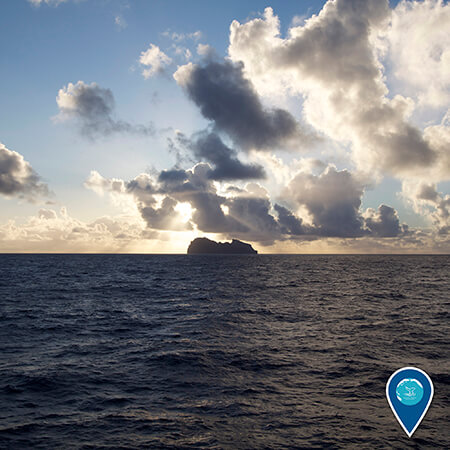
Have you ever wondered about the name of Papahānaumokuākea Marine National Monument? The name of Papahānaumokuākea acknowledges two prominent Native Hawaiian ancestors: Papahānaumoku, the broad expansive earth who gives birth to islands through the oceanic womb, and Wākea, sky father, the broad expanse that allows us to access time and space. Naming the monument for Papahānaumoku and Wākea is an acknowledgment of the ancestral connections of people and place. Throughout the Pacific, other island cultures acknowledge Papahānaumoku and Wākea by other names such as Papatūānuku and Ranginui in Aotearoa (New Zealand) and Fakahotuhenua and Ātea in Tahiti. These similarities tell us about a common origin among distant places throughout the Pacific Islands connected by one ocean.
Pictured here is Nihoa, one of the Northwestern Hawaiian Islands protected within the monument.
Learn how to pronounce the name Papahānaumokuākea
Photo: Kaleomanuiwa Wong

May is Asian American/Pacific Islander Heritage Month! The National Marine Sanctuary System has a long history of working closely with communities in American Samoa and Hawai‘i, and all month we'll be featuring information and stories about these collaborations.
Today, say talofa–hello–to NOAA National Marine Sanctuary of American Samoa! The phrase Fa‘a Samoa is often heard in American Samoa and refers to the traditional Samoan way of life. It is the foundation of Polynesia’s oldest culture, dating back about 3,000 years. Just like Fa‘a Samoa places great importance on the collective rather than the individual, the sanctuary is a hub of collaboration, striving together to preserve and protect our special underwater treasures.
Photo: Wendy Cover/NOAA

This week is National Travel and Tourism Week! This is a great time to explore our resources and plan your next adventure at a national marine sanctuary. Where do you dream of going next?
Photo: Bryan Dort

How do you make an octopus laugh? You give it ten-tickles! We hope these dad jokes are kraken you up. This giant Pacific octopus in NOAA Olympic Coast National Marine Sanctuary seems to think our puns are inkredible!
Photo: Katy Laveck Foster

That's no moon! It's a moon jelly, and it's being eaten by a swarm of Death Stars – er, bat stars – in NOAA's Monterey Bay National Marine Sanctuary. Happy Star Wars Day from your national marine sanctuaries, and May the Fourth be with you!
Photo: Chad King/NOAA

You might not expect to find strawberries and roses in NOAA's Cordell Bank National Marine Sanctuary, but they’re out there—they just look a little different. This rosy rockfish and these strawberry anemones really bring springtime to the reefscape.
Photo: Matt Vieta/BAUE

Time for your daily medit-ocean! Take a deep breath and enjoy the blue-green seas of French Frigate Shoals in Papahānaumokuākea Marine National Monument. Look closely and you can see terns flying above the water.
Photo: NOAA

What do you think this lizardfish in Hawaiian Islands Humpback Whale National Marine Sanctuary is thinking? Leave your caption in the comments!
Photo: Keith C. Flood

Our love for the ocean is manta be! Tag a friend you want to share this (manta) ray of light with.
Photo: G.P. Schmahl/NOAA

Happy anniversary to NOAA National Marine Sanctuary of American Samoa! This sanctuary was originally created to protect the tiny Fagatele Bay, a hotspot for coral biodiversity. In 2012, the sanctuary expanded to become one of our largest national marine sanctuaries. NOAA and the government of American Samoa co-manage this ocean treasure to not only protect its rich biodiversity, but also to support the cultural traditions and history of the region.
Photo: Greg McFall/NOAA

Dragon claws? A rocky bouquet? No – gooseneck barnacles! These barnacles are filter feeders, and attach to rocks in the intertidal zone so they can grab small particles of food from the surf. They can be found in many of your national marine sanctuaries, including NOAA's Monterey Bay National Marine Sanctuary and NOAA Olympic Coast National Marine Sanctuary.
Photo: Dayna McLaughlin/NOAA

Each tide pool of NOAA Olympic Coast National Marine Sanctuary and Olympic National Park is a microcosm, a window into the diversity of ocean life. Here, you'll find sponges, sea urchins, and more!
Photo: B. Bacchus/NPS
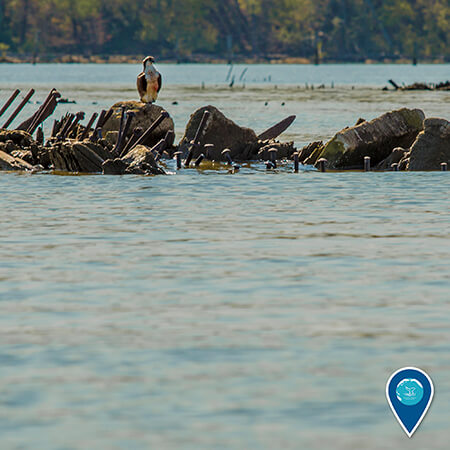
Our newest national marine sanctuary is Mallows Bay-Potomac River National Marine Sanctuary, located in Maryland's Potomac River. This site is most renowned for its “Ghost Fleet,” the partially submerged remains of more than 100 wooden steamships that were built in response to threats from World War I-era German U-boats that were sinking ships in the Atlantic. Today, in addition to serving as living museums, the shipwrecks serve as habitat for animals like ospreys.
Photo: David J. Ruck/NOAA

I believe I can fly! This adorable little floof is a white tern chick. Also known as fairy terns, or manu-o-kū in Hawaiian, these small birds breed throughout Papahānaumokuākea Marine National Monument in the Northwestern Hawaiian Islands. They're one of the 22 species of seabirds that breed and nest in the monument. Unlike most other seabirds, adult white terns don't build a nest; instead, they find a suitable spot on a tree branch, rock ledge, or other surface and lay their egg there.
Photo: Dan Clark/USFWS

It's National Environmental Education Week! From lessons on deep-sea corals to virtual dives into your national marine sanctuaries, we have educational resources for everyone.
Photo: NOAA

National Volunteer Week is a time to recognize our outstanding corps of volunteers who make a difference in their communities and help protect our ocean and Great Lakes. Our intrepid volunteers assist with a wide variety of activities, including beach cleanups, water quality monitoring, community outreach, and wildlife surveys. Here, a volunteer keeps a sharp eye out for whales in Hawaiian Islands Humpback Whale National Marine Sanctuary during last year's Sanctuary Ocean Count, a citizen science project to monitor whales. A warm thank you and mahalo to all our amazing volunteers!
Get to know some of our volunteers.
Photo: Kael Kattil

Happy Earth Day! Today we are celebrating Earth Day's 50th anniversary. Earth is an ocean planet, and our ocean connects us all and sustains vibrant ecosystems. Your national marine sanctuaries protect creatures great and small from whales to krill, and habitats from kelp forests to coral reefs. Today is an opportunity to celebrate our blue planet and its wild diversity, and to ask ourselves what we can do to conserve it for future generations. How are you celebrating Earth Day today?
Photo: Douglas Croft

What's up with this pelican's bill? American white pelicans are among the many birds that live in NOAA's Monterey Bay National Marine Sanctuary for at least part of the year. During the breeding season, adult white pelicans grow a distinctive horn on their upper bill. The horn's purpose isn't known for sure, but scientists think it may be part of courtship competition.
Photo: Douglas Croft

Caption this! What do you think this shrimp is thinking while hanging out in a deep-sea sponge in NOAA National Marine Sanctuary of American Samoa?
Photo: OET/NOAA

"WAIT FOR MEEEEE! I want to give you a hug! And a hug, and a hug, and a hug..."
This social octopus was spotted in the deep waters of Bodega Canyon in NOAA's Cordell Bank National Marine Sanctuary, during the 2019 expedition with Nautilus Live.
Photo: OET/NOAA

Take a second to close your eyes and imagine all the sounds of NOAA Thunder Bay National Marine Sanctuary. Do you hear the gulls squawking? The waves splashing against the rocks?
Photo: David J. Ruck/NOAA

Happy Bat (Star) Appreciation Day! Bat stars typically have five arms connected by webbing that gives them a bat-like look. This one in NOAA's Monterey Bay National Marine Sanctuary, though, has an extra one. Some species of sea stars can regenerate limbs after damage or predation, so it's likely that this sea star is growing a new arm after a narrow escape.
Photo: Steve Lonhart/NOAA

Timmmbbeerrrr!! This minke whale in NOAA's Stellwagen Bank National Marine Sanctuary is making a splash. Minke whales rarely exhibit breaching behavior, but every once in a while the mood seems to strike them. Can you blame them?
Photo: Anne Smrcina/NOAA

What do you call two barracuda? A pairacuda! This barracuda in NOAA Monitor National Marine Sanctuary seemed to like our pun. Just wait, we’ve got more fintastic jokes where that came from!
Photo: NOAA

Happy National Dolphin Day! 🐬 Your National Marine Sanctuary System is home to a huge variety of dolphin species. Here, a Risso's dolphin leaps out of the water in NOAA's Monterey Bay National Marine Sanctuary. What's your favorite kind of dolphin to see in your sanctuaries?
Photo: Douglas Croft Images.

Nananananananana bat ray! Rays like this bat ray in NOAA Channel Islands National Marine Sanctuary are searayiously cool. Their "wings" help them gracefully swim through the water and churn up sand to expose small mollusks, shrimp, crabs, and other animals to eat.
Photo: Robert Schwemmer/NOAA

Oh to be a California sea otter, floating on our backs and eating a snack. Sea otters have thick fur that traps air and allows them to float like this adorable little one in NOAA's Monterey Bay National Marine Sanctuary. The picture of relaxation!
Photo: Peter Flood

"Hi! Hi! What are you doing? Can you give me a ride? Can I grab this? What about this?"
This opportunistic octopus is celebrating National Submarine Day in style. Last fall it hopped aboard the remotely operated vehicle (ROV) Hercules while it was exploring a whale fall in the depths of NOAA's Monterey Bay National Marine Sanctuary with Nautilus Live. Check out footage of the whale fall .
Photo: OET/NOAA

We were hoping to add some more color to your day, and this pic from NOAA's Cordell Bank National Marine Sanctuary seems like it’ll add about a hundred! Cordell Bank is home to a wide variety of anemones, fish, and other species that all add their own pop of color to the reefscape. Which one catches your eye the most?
Photo: Greg McFall/NOAA

Seaside sandpiper silhouettes…try saying that 10 times fast! The vibrant colors of nature never cease to amaze us, and we hope this golden scene on the shores of NOAA's Greater Farallones National Marine Sanctuary does the same for you.
Photo: Anne Mary Schaefer

An algal bouquet? Send it my way! Low tides reveal a diverse array of algal species competing for space on a remote beach on the Makah tribal reservation on the Washington coast. NOAA Olympic Coast National Marine Sanctuary staff collaborate with Makah tribal staff to annually monitor seawater temperature and intertidal organisms, including the beautiful algae!
Photo: Jenny Waddell/NOAA

Have you taken a moment to unwind today? We’re relaxing by day-dreaming of rainbows over the beach in Hawaiian Islands Humpback Whale National Marine Sanctuary.
Photo: Jeff Moore

It may be Monday, but we've got your moment of calm. Unclench your jaw and imagine diving with these beautiful pyramid butterfly fish over the coral reefs of Papahānaumokuākea Marine National Monument.
Photo: Greg McFall/NOAA

Other mollusks: "Ugh, the giant clam is so shellfish for stealing attention."
Us: "Clam down, we love you all!"
Giant clams like this one can be spotted at Rose Atoll in NOAA National Marine Sanctuary of American Samoa. They're the largest bivalve mollusk in the world!
Photo: NOAA

Keep your chin up!" says the Garibaldi. The vibrant Garibaldi is the California state marine fish, and is known for its bright orange color. This one was photographed off Santa Cruz in NOAA Channel Islands National Marine Sanctuary.
Photo: Keith C. Flood

The red-footed booby is a seabird well known for its distinctive red feet, bodies well adapted for swimming and diving, and strong flying abilities. They live year-round in tropical and subtropical regions, including Papahānaumokuākea Marine National Monument. Red-footed boobies feed at sea, and are known to visit and rest on boats like this research vessel.
Photo: Eden Zang/NOAA

Sometimes you just need a photo of a baby squid.
This little squid-let was seen on a past research expedition in NOAA's Greater Farallones National Marine Sanctuary, off the coast of California. Have you ever seen anything so inkredible?
Photo: Greg Ryan Anderson/NOAA/Point Blue Conservation Science/ACCESS Oceans

Here's your daily reminder that the little things in life can be just as beautiful and mysterious as the big stuff. Greens and blacks swirl within the eye of a pufferfish in NOAA Gray's Reef National Marine Sanctuary off the Georgia coast, where a kaleidoscope of colorful creatures thrive on and around the sanctuary's living reef.
Photo: Greg McFall/NOAA

Here's a magic eye puzzle for you: can you spot the spotted scorpionfish? These masters of disguise are found (by those with keen eyes) in NOAA's Flower Garden Banks National Marine Sanctuary. Their textured skin and mottled coloring helps them sneak up on prey like small fish and crustaceans.
Photo: G.P. Schmahl/NOAA

"AAAAAAAAAA I am a Steller sea lion, hear me roar!" What do you think this sea lion in NOAA Olympic Coast National Marine Sanctuary has to say?
Photo: Katy Laveck Foster

Brilliant blue Brandt's beak – can you say that three times fast? Brandt's cormorants, like these two, are often spotted in NOAA's Monterey Bay National Marine Sanctuary. During breeding season, their throat patch and eyes turn a vivid blue – quite the fashion statement!
Photo: Douglas Croft

Brighten up your weekend with this view of NOAA's Cordell Bank National Marine Sanctuary! This sanctuary protects a rocky undersea feature 115 feet beneath the ocean surface at its tallest point. Despite its depth, though, Cordell Bank is host to a whole array of technicolor wildlife, from bright pink strawberry anemones to schools of juvenile rockfish. What other creatures can you spot here?
Photo: Joe Hoyt/NOAA

Time for your daily medit-ocean! Take a deep breath in, exhale, and enjoy the sunlight over NOAA Channel Islands National Marine Sanctuary.
Photo: Robert Schwemmer/NOAA

Time for a nudibranch break! This beauty in NOAA's Monterey Bay National Marine Sanctuary is a Hilton's aeolid. Though small (about 2 inches long), Hilton's aeolids aren't to be trifled with – they're known for picking fights with other nudibranchs!
Photo: Robin Agarwa

"Roar! Just kidding, I'm a whale."
Photo: NOAA

Your Tuesday moment of calm: take a deep breath and enjoy the sunset in Papahānaumokuākea Marine National Monument.
Photo: Robert Schwemmer/NOAA

This sea lion in NOAA Olympic Coast National Marine Sanctuary has its eye on you! Sea lions have a reflective membrane at the back of their eyes called the tapetum lucidum. This membrane acts as a mirror, bouncing light back through the eye to help sea lions see in murky and low-light conditions.
Photo: David J. Ruck/NOAA

Today is World Water Day! Wherever you are, you are connected to the ocean by your local waterways. The ocean creates the oxygen we breathe, influences our weather and climate, and harbors an astonishing diversity of life.
This photo of NOAA's Monterey Bay National Marine Sanctuary was taken with a GoPro that was launched to the edge of space via weather balloon. The balloon was launched from San Francisco, hit a maximum altitude of 91,470 feet, and landed in the Salinas Valley area. At this altitude, the camera is above 99.9% of the atmosphere, so it is able to capture the blackness of space above Earth's relatively thin atmosphere. Views like this remind us that Earth Is Blue
Photo: Bryan Chan

Today is the International Day of Forests – and did you know there are forests in the ocean? Kelp forests grow in many of your national marine sanctuaries along the West Coast, where they support lush, biodiverse communities. In NOAA's Monterey Bay National Marine Sanctuary, pictured here, giant kelp canopies tower above the ocean floor. Giant kelp can grow up to 18 inches per day! Among the many mammals and birds that use these forests as shelter or feeding grounds are seals, sea lions, whales, sea otters, gulls, cormorants, and more.
Photo: Nathan Coy

March is Dolphin Awareness Month! These charismatic ocean creatures are known for being sociable, intelligent, and acrobatic. What is your favorite species of dolphin?
Photo: Claire Fackler/NOAA

CAPTION THIS: What do you think these two California sea lions in NOAA's Monterey Bay National Marine Sanctuary are chatting about?
Photo: Peter Flood

Why have one sea star in NOAA Gray's Reef National Marine Sanctuary when you could have...er...eight? Nine? Ten?
Photo: Kim Roberson/NOAA

Happy St. Patrick's Day from this green moray eel in NOAA Florida Keys National Marine Sanctuary! Green moray eels are actually brownish, but they wear green in celebration of the holiday – or, rather, to protect themselves from parasites and disease. That is, these eels secrete a yellowish mucus that covers their skin, giving them a greenish tinge.
Photo: Olivia Williamson

Look, we get it. Not every day can be a good hair day. But cheer up, magnificent frigatebird – you're making an excellent fashion statement with that bright red throat pouch! The lady frigatebirds of Papahānaumokuākea Marine National Monument are sure to love you.
Robert Schwemmer/NOAA

On the water? Always keep an eye out for whales! At least nine instances of humpback whale/vessel collisions have been reported since December in Hawaiian Islands Humpback Whale National Marine Sanctuary, and whales are also at risk of collisions in other national marine sanctuaries. With recent reports of whales – often young whales – showing propeller injuries, please remember to keep a safe distance. Collisions with vessels are a risk to both the animals and humans.
Boaters can help prevent collisions by posting a lookout at all times throughout the year, not just when whales are most prevalent. An extra set of eyes scanning the waters ahead and to the side of a boat can prevent collisions with marine life, obstructions, divers, and other vessels. Slow down, too: slower speeds may help you avoid hitting a whale or other animals.
If you come across an injured or entangled marine mammal, please maintain the required safe and legal distance and notify your local stranding network.
Photo: J. Moore/NOAA, under NOAA Permit #15240

Happy Pi Day! This sea anemone in NOAA Olympic Coast National Marine Sanctuary isn't a pie and we definitely wouldn't recommend eating it. BUT, sea anemones do exhibit radial symmetry, meaning they're symmetrical around a center point, like a pie, and you could measure their circumference using pi.
Photo: Andy Collins/NOAA

unlit waters harbor a moment of unlikely friendship between a jelly and a fish in Papahānaumokuākea Marine National Monument.
Thank you for joining us this week to honor the memory of NOAA diver and staff member Greg McFall, and for sharing your memories with us.
Photo: Greg McFall/NOAA

With his macro lens, Greg McFall showed off parts of the ocean that many of us never get to see. This “forest” in NOAA Gray's Reef National Marine Sanctuary is a closeup of a Dendrodoris nudibranch’s gills.
This week, we’re honoring the memory of NOAA diver and staff member Greg McFall. If you knew Greg or his photography, we would love to hear your memories.
Photo: Greg McFall/NOAA

“We can stop finding Nemo!” With a sense of humor and an eye for beauty, Greg McFall captured all sorts of scenes through photography. Here, two anemonefish swim over a large sea anemone in NOAA National Marine Sanctuary of American Samoa.
This week, we’re honoring the memory of NOAA diver and staff member Greg McFall. If you knew Greg or his photography, we would love to hear your memories.
Photo: Greg McFall/NOAA

In recent years, Greg McFall was based in NOAA Florida Keys National Marine Sanctuary, where his photography lit up the coral reef. Here, a research diver hovers over the reef in the North Tortugas Ecological Reserve.
This week, we’re honoring the memory of NOAA diver and staff member Greg McFall. If you knew Greg or his photography, we would love to hear your memories.
Photo: Greg McFall/NOAA

Earlier this year, the National Marine Sanctuary System lost one of the treasured members of our family, Greg McFall. The director of the NOAA Diving Program, Greg had also served as research coordinator and superintendent of NOAA Gray's Reef National Marine Sanctuary and supported many other national marine sanctuaries. His passing is a huge loss to us and to the larger sanctuaries community.
Whether you have been following us on social media for a few months or a few years, you likely came to know Greg through his photography. An accomplished diver and gifted photographer, Greg provided an unparalleled view of the underwater world from the Florida Keys to American Samoa. This week, in honor of his memory, we will be sharing some of his photographs across our social media. If you knew Greg or his photography, we would love to hear your memories.
Photo: G.P. Schmahl/NOAA

Happy International Women's Day! Today we're celebrating all the women who make the National Marine Sanctuary System possible and who dedicate themselves to protecting and understanding marine species and ecosystems.
Here, Dr. Nancy Foster Scholar Carina Fish pauses during a research expedition in Cordell Bank and Greater Farallones national marine sanctuaries. The Foster Scholarship supports women and members of minoritized groups in graduate school for ocean-related sciences.
Photo: Julie Chase/ACCESS/NOAA/Point Blue Conservation Science

What do you see here: an invertebrate grazing on algae or a piece of abstract art? This is in fact a beautiful lettuce sea slug found in NOAA Florida Keys National Marine Sanctuary. We think all marine life is beautiful, especially when it looks like art. What species is your favorite?
Photo: Tiffany Duong/Ocean Rebels

If the color purple is associated with royalty, then all hail NOAA Channel Islands National Marine Sanctuary for its purple hydrocoral! Have you seen this bright, stunning invertebrate when visiting your national marine sanctuary?
Photo: Adam Obaza

Happy Seagrass Awareness Month! Let’s get down to the grass tacks: seagrass plays a vital role in supporting ocean ecosystems. A wide variety of animals, such as manatees, seahorses, and this shy scorpionfish in NOAA Florida Keys National Marine Sanctuary rely on seagrass for both food and shelter. Seagrass also produces oxygen, protects shores from powerful wave action, and makes water clearer. So put those lawnmowers away, this grass is way too important!
Photo: NOAA

These strawberry anemones in NOAA's Cordell Bank National Marine Sanctuary are so colorful it feels like summer's right around the corner. These beautiful invertebrates reproduce by cloning themselves, spreading out to cover a large are of rocky reef. Talk about a berry patch!
Photo: Matt Vieta/BAUE

Happy World Wildlife Day! Your National Marine Sanctuary System is dedicated to protecting marine wildlife – from tiny shrimp and corals all the way to massive whales. We work diligently to safeguard endangered species like Hawaiian monk seals, pictured here in Hawaiian Islands Humpback Whale National Marine Sanctuary. What steps will you take to protect marine wildlife?
Photo: Melody Bentz

Start your week off right with a virtual trip to Fagatele Bay in NOAA National Marine Sanctuary of American Samoa! This small bay is a hotspot for coral diversity. Here, you'll find at least 270 species of fishes, 160 species of coral, and 1,400 species of algae and invertebrates – all in 0.25 square mile! What kinds of corals can you spot in this photo?
Photo: Greg McFall/NOAA

We’re dolphin-itely excited about Dolphin Awareness Month! The month of March is dedicated to celebrating and raising awareness about dolphins. These extremely intelligent creatures can be found in many of your national marine sanctuaries. In NOAA's Monterey Bay National Marine Sanctuary, common dolphins are known for their impressive acrobatic energy. What is your favorite species of dolphin?
Photo: Douglas Croft Images

Happy Leap Day! We think this humpback whale in NOAA's Stellwagen Bank National Marine Sanctuary has the right idea. How are you celebrating the extra day?
Photo: Laura Lilly

We’re feeling crabby about the invasive European green crab that has made its way into NOAA's Greater Farallones National Marine Sanctuary! This species first appeared along the Western U.S. in 1989, likely through the ballast water of cargo ships traveling across the ocean. These highly adaptable predators feast on shrimp, oysters, clams and small Dungeness crabs, taking away important food sources for local shorebirds and migratory seabirds. Since 2009 researchers from the Smithsonian Environmental Research Center, universities, and volunteers have been working to remove these crabs.
Photo: Kate Bimrose/NOAA

Asian kelp, or "wakame," is an invasive species of kelp native to Japan that has colonized harbors along the California coastline, including in NOAA's Greater Farallones National Marine Sanctuary and NOAA's Monterey Bay National Marine Sanctuary. Wakame colonizes ecosystems rapidly and densely. That can alter the habitat of native species by reducing the amount of light cover and and restricting water movement. Thanks to a little kelp from national marine sanctuary scientists and volunteers, wakame removal and research efforts are well underway! Studying wakame will help improve management practices of the invasive species while improving understanding of how it impacts local ecosystems.
Photo: Steve Lonhart/NOAA

What’s black, white, and dangerously strong? Zebra muscles – er, mussels! Zebra mussels are an invasive species in the Great Lakes, probably brought via ballast water discharged by large ships from Europe. These mussels take over hard surfaces such as buoys, docks, and submerged archaeological resources, including the shipwrecks in NOAA Thunder Bay National Marine Sanctuary. Zebra mussels’ presence on shipwrecks creates a significant challenge for archaeologists, historians, and resource managers, making it difficult for them to document wrecks over time. They also alter nutrient cycles and deplete the local food supply for native species.
Photo: USFWS

In recent decades, Indo-Pacific lionfish have been found in coral reefs throughout the southeast Atlantic, Gulf of Mexico, and Caribbean – including in sanctuaries like NOAA's Flower Garden Banks National Marine Sanctuary. Because of their voracious appetites, rapid reproduction rate, and lack of natural predators, these invasive lionfish pose a serious threat to coral reefs, with potential long-term consequences for native fish communities, habitats, and entire ecosystems.
Photo: Nick Zachar/NOAA

It's Invasive Species Week! All week long, we'll be bringing you information about invasive species and their effects on national marine sanctuaries. Though environments certainly change over time, invasive species can crowd out native species, shifting the balance and potentially damaging the ecosystem to which they've been introduced. Here, Dr. Steve Lonhart surveys an area of rocky reef in NOAA's Monterey Bay National Marine Sanctuary.
Photo: Chad King/NOAA

Deep sea research in national marine sanctuaries requires all eight hands on deck – at least for this octopus! Researchers aboard the E/V Nautilus spotted this octopus while diving on Davidson Seamount in NOAA's Monterey Bay National Marine Sanctuary last year. Those green dots in the upper left aren't spooky eyes looking out from the mud, but rather two lasers shined from the remotely operated vehicle Hercules. The lasers are mounted 10 centimeters apart from one another, and help researchers estimate the size of animals like this one.
Photo: OET/NOAA

Nap time! This sleepy friend in Hawaiian Islands Humpback Whale National Marine Sanctuary is a Hawaiian monk seal, which is unfortunately one of the most endangered species in the world. These seals face many threats, including limited food supply, entanglement, habitat loss, and human interaction. NOAA scientists are working to manage and conserve monk seal populations so that these adorable animals can continue to survive. If you see a Hawaiian monk seal, keep plenty of distance and report sightings to pifsc.monksealsighting@noaa.gov.
Photo: Matt McIntosh/NOAA

Nudibranch alert! This little beauty in NOAA Gray's Reef National Marine Sanctuary is a regal sea goddess. Nudibranchs are soft-bodied mollusks and are sometimes known as sea slugs. "Nudibranch" means "naked gills" – these mollusks carry their gills on their backs! There are many different species of nudibranch found all throughout national marine sanctuaries. What is your favorite kind to spot?
Photo: Peter Flood

"For real? You think I'm cute? Aw, get otter here."
We're pawsitive that sea otters are one of the most adorable inhabitants of NOAA's Monterey Bay
National Marine Sanctuary. Even though they look cuddly, though, make sure to give them plenty of
space (pro tip: use a zoom lens or binoculars!). If you get too close, you might interrupt their
feeding, grooming, and resting, which can negatively impact their health and make it harder for these
adorable creatures to survive. With good ocean etiquette,
you can help protect sea otters and other animals.
Photo: Timothy Henkel/Valdosta State University

Enjoy a moment of calm today with these dolphins swimming in Hawaiian Islands Humpback Whale National Marine Sanctuary.
Photo: Eden Zang/NOAA

Have you ever met a ctenophore? Also known as comb jellies, these invertebrates move tiny comb-like cilia to travel through the water. These "combs" diffract light, giving the animal a shimmering, rainbow appearance. This one was spotted at night in NOAA Florida Keys National Marine Sanctuary.
Photo: Olivia Williamson

This North Atlantic right whale is splashing into World Whale Day! Today, we're celebrating these beautiful ocean giants.
North Atlantic right whales like this one in NOAA's Stellwagen Bank National Marine Sanctuary are one of the most highly endangered whale species in the world – only about 400 whales remain. They are threatened by entanglement in fishing gear and collisions with ships. There is good news, though: so far this season there have been 10 new calves sighted!
Photo: Peter Flood

When a whale dies at sea, its body becomes an oasis for other animals on the seafloor. After death, a whale's body will sink to the seafloor – and there, it can feed other organisms for years or even decades. On the seafloor, the whale carcass or skeleton is known as a whale fall. This past October, researchers on the E/V Nautilus were exploring Davidson Seamount in NOAA's Monterey Bay National Marine Sanctuary when they came across this whale fall at a depth of 10,623 feet. What animals can you spot on the whale fall?
Photo: OET/NOAA

Looking for a Valentine today? Try using echolocation! Toothed whales, like these orcas in NOAA's Monterey Bay National Marine Sanctuary, emit sounds that travel through the water and bounce off fish and marine mammals. They can use the sounds to create a mental map of where exactly things are! Sounds like a good way to locate a Valentine to us.
Photo: Douglas Croft Images

Happy Valentine's Day from your National Marine Sanctuary System! We hope today – and every day – brings you lots of love and naps.
Photo: Mark Sullivan/NOAA, under NMFS Research Permit #848-1695

One of the biggest threats to humpback whales and other whales is entanglement in fishing gear and other debris. Entanglement can injure, starve, or drown whales. Fortunately, teams of intrepid individuals are on the scene to help whales like this one. Hawaiian Islands Humpback Whale National Marine Sanctuary leads the Hawaiian Islands Entanglement Response Network, a partnership of government agencies, tour operators, fishers, and more who work together to safely free whales. While of course everyone wants to help entangled whales, it is crucial that you never attempt to disentangle a whale yourself – it can be dangerous for both you and the whale. Instead, call your local stranding network so that trained professionals can help.
Photo: J. Moore/NOAA, under MMHSRP permit #18786-02

Whale-come back to Whale Week! Blue whales such such as these beauties in NOAA Channel Islands National Marine Sanctuary are the largest animals to ever live on our planet. They are also one of the loudest. Under good conditions, scientists estimate that blue whales can hear each other 1,000 miles away! These behemoths of the sea are threatened by entanglement in fishing gear, being hit by ships, and pollution. To learn more about blue whales, check out .
Photo: Jess Morten/NOAA

It's the International Day of Women & Girls In Science AND it's Whale Week! Dr. Nancy Foster Scholar Vanessa ZoBell combines the best of both of these things. A Ph.D. student at the Scripps Institution of Oceanography, ZoBell uses acoustic monitoring to understand whether slower ships improve whale communication in NOAA Channel Islands National Marine Sanctuary. Learn more about her research and check out the Dr. Nancy Foster Scholarship.
Photo courtesy of Vanessa ZoBel

We’re splashing our way into Whale Week 2020! National marine sanctuaries work closely with NOAA Fisheries Service and other partners to ensure the conservation of all whales protected under the Marine Mammal Protection Act and the Endangered Species Act. Stay tuned this week to brush up on your whale facts! This beautiful humpback whale was seen swimming underwater in Hawaiian Islands Humpback Whale National Marine Sanctuary.
Photo: Ed Lyman/NOAA under NOAA Permit #14682

Meet Salt, the "grand dame" of NOAA's Stellwagen Bank National Marine Sanctuary. She was first spotted in Massachusetts Bay in the 1970s, and has been seen in the sanctuary just about every year since then. She has had 14 calves and many grandchildren, and at least one great-grandcalf! Salt was one of the first northern humpback whales to be recognized at Silver Bank off the coast of the Dominican Republic, providing proof of the humpback whale migratory route in the North Atlantic – which in turn has helped us better protect humpback whale populations through sister sanctuary relationships.
Photo: Laura Howes

Here's a thorny (hint!) trivia question for you: what is this a picture of? Clue number two: this photo was taken in Papahānaumokuākea Marine National Monument. Comment your guess and we'll reveal the answer on Monday!
Photo: Stephen Matadobra/NOAA

One of these things is not like the other! All three of these birds in NOAA's Monterey Bay National Marine Sanctuary are common murres, but the white one is leucistic. In leucistic birds, feathers lack melanin pigment, so appear light in color. Common murres are usually black and white like the two in the back, but this one gets to make a fashion statement.
Photo: Douglas Croft Images

Did you know you can see three national marine sanctuaries from the newly-renovated Point Reyes Lighthouse? The lighthouse gives an unparalleled view of NOAA's Greater Farallones National Marine Sanctuary, NOAA's Monterey Bay National Marine Sanctuary, and NOAA's Cordell Bank National Marine Sanctuary. Recently, NOAA deputy director RDML Tim Gallaudet (second from left) visited Cordell Bank National Marine Sanctuary headquarters and took in the view with sanctuary staff, including deputy superintendent Michael Carver (left), then-acting superintendent Carol Bernthal (second from right), and education and outreach coordinator Jennifer Stock (right).
Photo: Adrian Mahoney/NOAA

Nothing is better than walking the beach at low tide, when the sand is still wet and you can see the clouds above and below. What's your favorite beach to wander along NOAA Olympic Coast National Marine Sanctuary?
Photo: Robert Schwemmer/NOAA

Humpback whale tails, or flukes, can be up to 5 meters across! Every humpback whale has a distinctive pattern on its fluke. These patterns are so unique that they can be used to identify individual whales, just like a human fingerprint. This one was spotted in Hawaiian Islands Humpback Whale National Marine Sanctuary.
Photo: R. Finn/NOAA, under NOAA Permit #15240

Look, little octopus, we didn't want to get out of bed this morning either, but it's Monday and here we are.
This Caribbean reef octopus was spotted taking shelter in NOAA Florida Keys National Marine Sanctuary. These beautiful octopodes have specialized color-changing cells that help them blend in with their surroundings so they can stay safe while they rest or sneak up on prey.
Photo: Tiffany Duong/Ocean Rebels

This sea otter in Elkhorn Slough is otterly thrilled that it's World Wetlands Day! Located in NOAA's Monterey Bay National Marine Sanctuary, Elkhorn Slough is one of California's last great coastal wetlands. Flushed by ocean tides in the heart of Monterey Bay, its waterways, mudflats, and marsh support a huge diversity of wildlife – including sea otters! Estuaries like Elkhorn Slough are extremely productive ecosystems, and provide food, shelter, migration stopovers, and places to breed for many animals. However, they're also quite delicate and need our help to ensure they remain thriving ecosystems.
Photo: Jenni Peters

We snow everyone loves the snowy egret! Keep your eyes peeled for their bright orange-yellow feet, and you might be able to spot one in NOAA's Greater Farallones National Marine Sanctuary. These wading birds were once extremely rare, having been hunted extensively for their feathers. However, with protection, their populations have recovered and they can often be spotted in your national marine sanctuaries.
Photo: Sara Heintzelman/NOAA

"Everybody, single file please, one at a time...oh, fine. Come on through." Being an underwater traffic director is a little challenging – the fish of NOAA's Flower Garden Banks National Marine Sanctuary definitely have places to be.
Photo: Scott Bauer

Happy 45th anniversary to NOAA Monitor National Marine Sanctuary! This iconic place was the first national marine sanctuary ever designated. It protects the historic shipwreck of the Civil War era USS Monitor, and its designation highlighted on the importance of conserving the biodiversity, ecological integrity, and cultural legacy of special marine areas across the country. Happy birthday, Monitor!
Photo:NOAA

Birds of a feather really do flock together! Along the coast of NOAA's Monterey Bay National Marine Sanctuary, visitors can spot an amazing variety of shorebirds. How many different species can you spot here?
Learn more about the various shorebirds and seabirds that call this sanctuary.
Photo: Peggy Langford

It’s National Plan for Vacation Day! What better place to spend your next vacation than at one of your beautiful national marine sanctuaries? Visitors can dive into the mysteries of the deep, explore shipwrecks and reefs, and watch acrobatic whales fling themselves out of the water. There are also ample opportunities for surfing, paddling, boogie boarding, and more. Better start planning now – there is so much to see and do, and 14 national marine sanctuaries to choose from!
Photo: Matt McIntosh/NOAA

There’s a storm a-brewing! While it can’t always be warm and sunny at NOAA Channel Islands National Marine Sanctuary, gray skies don’t have to be so dreary. This cloudy sky over Santa Barbara Channel and Santa Cruz Island reminds us of the lively ocean lying just below.
Photo: Robert Schwemmer/NOAA

Where do whales go to get braces? The orca-dontist! *crickets* We’ll show ourselves out, you just enjoy this breaching orca in NOAA's Cordell Bank National Marine Sanctuary.
Photo: Michael Richlen

Rinse and repeat looks a little different in Hawaiian Islands Humpback Whale National Marine Sanctuary. This green sea turtle, or honu in Hawaiian, is visiting a “cleaning station,” a spot in the reef where fish clean parasites off the turtle’s shell. It may not be your typical shower, but it helps keep these beautiful animals squeaky clean and healthy.
Photo: Matt McIntosh/NOAA

Look at those nails! This common snapping turtle in NOAA Thunder Bay National Marine Sanctuary must have a great manicurist. Snapping turtles hunt for their prey in lake depths, and then like this one, return to the surface to warm up in the sun. Have you encountered a snapping turtle in your national marine sanctuary?
Photo: James Garner

"Whale...we're gonna need a bigger boat." These scientists in NOAA's Stellwagen Bank National Marine Sanctuary got a treat (or maybe a fright) when a humpback whale breached surprisingly close to them. Small boats like this one allow permitted researchers to get close enough to whales to attach tags with suction cups. The tags then give them a wealth of information about the whale's movements, feeding patterns, and more. If you're out on the water whale watching or just in an area with whales, make sure to give the marine mammals plenty of space!
Photo: NOAA, under NOAA Fisheries Permit #14245

"Uh, excuse me. What are you doing down there?" What do you think this bird fishing in Papahānaumokuākea Marine National Monument is thinking?
Photo: Stephen Matadobra/NOAA

Today is National Squirrel(fish) Appreciation Day, and we're big fans of the resident squirrelfish in NOAA's Flower Garden Banks National Marine Sanctuary! These reef-dwellers are nocturnal, resting under coral ledges during the day and spending the nights chowing down on small crustaceans
Photo: GP Schmahl/NOAA

We could spend all day looking out at the towering trees and rock formations found at Ruby Beach in Washington state. Which scenic overlook into NOAA Olympic Coast National Marine Sanctuary is your favorite?
Photo: Nick Zachar/NOAA

Orange you glad these two little invertebrates made friends? This opalescent nudibranch flashes its opal-fire blue stripes as it crawls across the top of a jeweled top snail. What small beauties have you seen in the tide pools of NOAA's Monterey Bay National Marine Sanctuary?
Photo: Robin Agarwal

Every winter, the beaches of NOAA's Monterey Bay National Marine Sanctuary and other sanctuaries along the West Coast transform into a mating ground for elephant seals. Males battle it out for territory in quick clashes that rarely result in lasting damage. Soon after, the females arrive to breed, and will spend a month on land raising their pups before voyaging back to the sea. Elephant seals are lots of fun to watch, but make sure to give them plenty of space – an elephant seal selfie is NOT a good idea! These huge seals can be dangerous, and when you get too close you can stress them during a critical time in their life.
Photo: Chad King/NOAA

Twenty-eight and feeling great! Happy anniversary to NOAA's Flower Garden Banks National Marine Sanctuary. In the late 1960s, scientists began researching the extensive, healthy, and pristine coral reef ecosystems found in the northern Gulf of Mexico. Now, Flower Garden Banks National Marine Sanctuary protects some of the healthiest coral reef ecosystems in the world! Learn more about the sanctuary at flowergarden.noaa.gov.
Photo: Greg McFall/NOAA

Happy anniversary to NOAA's Greater Farallones National Marine Sanctuary and NOAA Gray's Reef National Marine Sanctuary! Though these two sanctuaries share a birthday, they're quite different. Off the coast of California, the misty Greater Farallones provides breeding and feeding grounds for a wide variety of animals, including the iconic white shark. Georgia's Gray's Reef, on the other hand, protects a live-bottom reef home to more than 200 species of fish, as well as an abundance of invertebrates. Happy birthday to these two national marine sanctuaries, and many thanks to their staff and volunteers for protecting our ocean's amazing places!
Top photo © Steven K. Webster/Monterey Bay Aquarium; bottom photo: Greg McFall/NOAA

Dreaming of warm summer adventures? Today is National Shop for Travel Day, and it's an excellent time to start thinking about summer vacations in your national marine sanctuaries. Find an adventure for everyone.
Bruce Sudweeks

Dreaming of warm summer adventures? Today is National Shop for Travel Day, and it's an excellent time to start thinking about summer vacations in your national marine sanctuaries. Find an adventure for everyone.
Photo: Chuck Graham

Hawaiian Islands Humpback Whale National Marine Sanctuary is home to a wide variety of tropical reef fishes. This reticulated butterflyfish was spotted by photographer Rick Gaffney off the Big Island. What's your favorite fish to see in your national marine sanctuaries?
Photo: Rick Gaffney

Pop quiz: can you identify this mysterious ocean sight? It was spotted in NOAA Gray's Reef National Marine Sanctuary. We'll have the answer for you tomorrow!.
Photo: Greg McFall/NOAA

We're a sucker for octopuses, especially cute ones like this dumbo octopus! Dumbo octopuses get their names for their ear-like fins, which help them move through the water. This octopus was spotted in NOAA's Monterey Bay National Marine Sanctuary on this year's Nautilus Live expedition.
Photo: OET/NOAA

Duunnn dun...duunnn dun...wait a second, that's no shark – it's a mola mola! Also known as ocean sunfish, mola mola are the heaviest bony fish in the ocean. These ocean giants roam the seas in search of their favorite food, jellyfish. This one was spotted impersonating a shark in NOAA's Greater Farallones National Marine Sanctuary.
Photo: Sara Heintzelman/NOAA

In recent decades, the coral reefs within NOAA Florida Keys National Marine Sanctuary have been damaged by hurricanes, bleaching, disease, and heavy human use. To help protect and restore these reefs, NOAA and our partners have launched Mission: Iconic Reefs. By restoring corals at seven iconic reefs in Florida Keys National Marine Sanctuary – including through outplanting corals grown in nurseries, like these – we can change the trajectory of an entire ecosystem.
Photo: Mote Marine Laboratory & Aquarium

Nofin is better than swimming with your friends in NOAA Channel Islands National Marine Sanctuary! Common dolphins are gregarious – they're often seen gathering in groups in the sanctuary. What's your favorite kind of dolphin?
Photo: Robert Schwemmer/NOAA

We dove headfirst into the new year, just like this pink-footed shearwater in NOAA's Cordell Bank National Marine Sanctuary. What new adventures and treasures did the first week of 2020 bring you?
Photo: Sophie Webb/NOAA

Pink coralline algae gives Rose Atoll in NOAA National Marine Sanctuary of American Samoa a rosy hue. What other creatures can you spot in this photo?
Photo: Wendy Cover/NOAA

We're celebrating National Bird Day with some peli-can-do spirit! Hunted for their feathers and later contaminated by DDT and other pesticides, brown pelicans were once endangered. But this iconic bird species, and many others, have recovered in the years since these pesticides were banned. Now, they're commonly seen in NOAA's Monterey Bay National Marine Sanctuary, which provides a plentiful supply of fish, krill, and plankton for local and migrating birds to feast on. What's your favorite bird to see in your national marine sanctuaries?
Photo: Sam Bailey

Open wide! Manta rays are the world's largest ray, but they eat tiny, tiny food: plankton like copepods and small shrimp. When feeding, they open their mouths wide, creating a funnel that pushes water and prey through their mouth and over their gill rakers. Not a bad way to get a snack!
Photo: James Watt/NOAA

Pop quiz: what do hungry humpback whales like to eat? Don't be fooled by this photo: humpback whales aren't into eating birds! Rather, these baleen whales live on a diet of krill and small fish. Birds tend to hang around feeding humpback whales to get a bit of the leftovers.
Photo: Jeremy Winn

Paddling out has a special significance at Hawaiian Islands Humpback Whale National Marine Sanctuary. Early Hawaiians used outrigger canoes to navigate a wild Pacific Ocean while they set out on voyages for exploration and fishing. Today, outrigger canoeing is the official team sport of the Aloha State, and an excellent way to experience the beauty of this national marine sanctuary.
Photo: Barbara Craig

Stargazing – it's not just for the night sky anymore! NOAA biologist Greg Williams came face to face with this ochre star on Tatoosh Island in NOAA Olympic Coast National Marine Sanctuary during a research dive in 2017.
Photo: Steve Lonhart/NOAA

Happy New Year! For this year’s New Year’s Resolution, we’d like to challenge you to join us in committing to a healthier ocean. Whether you participate in a local beach cleanup, reduce your water consumption, or fish responsibly, it all contributes to protecting our ocean for this and future generations.Learn more about how to be a friend of the seas.
Photo: Ryan Tabata/NOAA

There must be mistletoe somewhere in NOAA Channel Islands National Marine Sanctuary! They say there are plenty of fish in the sea, but these two sheepheads are clearly taken.
Photo: Tony Knight

Coral reef candy cane? Not quite – this little dose of holiday cheer is none other than the banded coral shrimp, often spotted in NOAA's Flower Garden Banks National Marine Sanctuary. Happy National Candy Cane Day!
Photo: GP Schmahl/NOAA

Holiday lights? Yes please – this Christmas tree hydroid wants in on the festivities! This colonial invertebrate gets its name from its branches, which give it the appearance of a Christmas tree from afar. This one was spotted celebrating the holidays in NOAA Gray's Reef National Marine Sanctuary.
Photo: Greg McFall/NOAA

Red, white, and merry! These strawberry anemones in NOAA's Cordell Bank National Marine Sanctuary say happy holidays to all!
Photo: Matt Vieta/BAUEA

Listen up, this is mom-umental! Fale Bommie, or Big Momma, is one of the largest coral heads in the world. Located in NOAA National Marine Sanctuary of American Samoa, this coral colony is more than 500 years old and over 6 meters high! Curious divers, like this one, can explore Big Momma and other coral heads in the Valley of the Giants, or take a virtual dive.
Photo: Wendy Cover/NOAA

Kayaking in NOAA Thunder Bay National Marine Sanctuary is one of the best ways to explore shipwrecks like the Portland, seen here. The cold, clear water of Lake Huron makes it easy to see the shipwreck resting below!
Photo: Bryan Dort

Last minute holiday shopping got us like
Photo: Peter Flood

With the chill of winter upon us, we're dreaming about summertime sunshine. Taking in the sunset at NOAA Olympic Coast National Marine Sanctuary is one of our favorite things to do on a summer weekend. Tell us your favorite way to get into your sanctuary!
Photo: David J. Ruck/NOAA

These two orange-peel doris nudibranchs are in a race for the finish line in NOAA's Monterey Bay National Marine Sanctuary. Who do you have your bets on: the rookie pushing from behind or the veteran in the lead?
Photo: Steve Lonhart/NOAA

The waters off North Carolina have claimed thousands of vessels over the years. Most of the shipwrecks near NOAA Monitor National Marine Sanctuary are from World War II's Battle of the Atlantic. U-352, for example, was a German U-boat intended to patrol the waters off the U.S. East Coast during the war. Instead, U-352 became the first U-boat sunk by the U.S. Coast Guard during the Battle of the Atlantic. Today, the wreck is a popular dive site for those interested in its history and the dense array of marine life.
Photo: Tane Casserley/NOAA

The humpback whale's genus is Megaptera, which means "big wing." It's easy to see how they get this name – their flippers are about a third the length of their entire body! Each winter, these big-winged whales gather in Hawaiian Islands Humpback Whale National Marine Sanctuary to mate, give birth, and raise their young.
Photo: NOAA, under NOAA Permit #774-1714

The coral reefs of NOAA's Flower Garden Banks National Marine Sanctuary are getting into the holiday spirit! These Christmas tree worms are actually a kind of marine worm. Each worm has two brightly colored crowns that protrude from its tube-like body. The "branches" help the worm snatch small bits of food out of the water column.
Photo: Steve Miller

*sniff sniff* Do you smell that? Smells like the weekend! These California sea lions in NOAA's Greater Farallones National Marine Sanctuary can tell fun is in the air (and the water) today, so you have our seal of approval to go out and do something super sealy!
Photo: Sara Heintzelman/NOAA

Known for their incredible energy and acrobatic skills, short-beaked common dolphins are one of many marine mammal species that call NOAA's Monterey Bay National Marine Sanctuary home. These gregarious dolphins can be spotted in large groups within the sanctuary. At night, they typically dive to about 100 feet to feed on schooling fish and squid, but they're capable of diving to up to 1,000 feet below the ocean surface!
Photo: Douglas Croft

These technicolor beauties are none other than painted elysias! Painted elysias are a kind of sea slug. Keen-eyed divers can spot them in NOAA's Flower Garden Banks National Marine Sanctuary, but only if they're looking carefully – though they're bright, these sea slugs are usually no bigger than an inch in length.
Photo: Emma Hickerson/NOAA

Today is International Mountain Day – and did you know that there are mountains in the ocean? Seamounts are undersea mountains formed by volcanic activity, and they're typically biological hotspots. For example, on Davidson Seamount in NOAA's Monterey Bay National Marine Sanctuary, researchers with Nautilus Live encountered more than a thousand Muusoctopus octopuses tucked into nooks! Most of the octopuses had their arms inverted in a brooding posture. We love a good octopus garden, but we love an octopus garden on an ocean mountain even more!
Photo: OET/NOAA

Someone call Louis Armstrong! This trumpetfish is using some A+ camouflage to blend in at NOAA Florida Keys National Marine Sanctuary. Trumpetfish often remain motionless to fool their prey into getting too close. We bet they wouldn’t fool Louis, though!
Photo: Greg McFall/NOAA

Up, up, and away! This little Cassin's auklet is taking flight in NOAA's Greater Farallones National Marine Sanctuary. Cassin's auklets are known for foraging for small crustaceans while swimming underwater. They can dive more than 120 feet below the surface!
Photo: Patrick Sysiong

Is this a Pacific white-sided dolphin in NOAA's Cordell Bank National Marine Sanctuary…or a bird?
Photo: Sage Tezak/NOAA

Wisdom is back in Papahānaumokuākea Marine National Monument! Wisdom is a female Laysan albatross and the oldest known banded bird in the world. At least 69 years old, Wisdom is a world-renowned symbol of hope for all species that depend upon the health of the ocean to survive. Each year, she and her mate Akeakamai return to Midway Atoll National Wildlife Refuge in the monument to mate, lay an egg, and raise their chick. To date, Wisdom has hatched more than 35 chicks over the course of her life. Welcome back, Wisdom!
Photo: William Kennerley/USFWS

Looking for a way to help corals stay healthy? Make sure you're using a reef-safe sunscreen or use Ultraviolet Protection Factor (UPF) sunwear! Several chemicals in traditional sunscreen can damage and kill corals, and are also harmful to green algae, sea urchins, fish, mussels, and dolphins. Even if you don't live near the ocean, when you shower, the chemicals in sunscreen may wash off and enter our waterways. So by making a small change in your sun protection, you can help support healthy coral reefs!
Photo: Olivia Williamson

Who's that reaching out from the coral reef of NOAA's Flower Garden Banks National Marine Sanctuary? A sneaky brittle star! Every August, the reef-building corals within the sanctuary put on one of the most abundant spawning displays in the entire Caribbean and Gulf of Mexico. Each coral species times its gamete (egg and sperm) release to ensure genetic mixing and that coral larvae can disperse over large distances. The gametes also provide a feast for small animals like this brittle star.
Photo: Emma Hickerson/NOAA

What's wrong with this picture? These two images show a reef in NOAA National Marine Sanctuary of American Samoa just months before (left) and after (right) a bleaching event. When we burn energy sources like gasoline and coal, we release carbon dioxide into the atmosphere. This carbon dioxide acts like a heat-trapping blanket, keeping heat from the sun close to the planet and warming the atmosphere and the ocean. Corals are sensitive to temperature: if the water gets too warm, they expel the colorful algae that they need to survive. This is called bleaching, and if it lasts long enough, the corals can die. But there are things we can do: by working with your community to curb your fossil fuel consumption and reduce other coral stressors, like pollution, you can help protect vibrant coral reefs!
Photo: XL Catlin Seaview Survey/The Ocean Agency

Did you know there are corals in the deep ocean? It's true! Many species of coral thrive in the deep sea, like this Swiftia coral in NOAA's Cordell Bank National Marine Sanctuary. The corals position themselves so they can grasp small particles of food from the current, and also provide habitat for other animals like these brittle stars. What other deep-sea dwellers can you spot here?
Photo: OET/NOAA

Happy Corals Week! All week long, we'll be celebrating the beauty and importance of coral reef ecosystems around the world. Stay tuned for some coral-ly awesome facts! This colorful coral structure provides habitat for a variety of species in NOAA Florida Keys National Marine Sanctuary.
Photo: Greg McFall/NOAA

Is an eagle by the sea technically a seagull? We’re not shore, but we hope you fly into the new week and the new month like this bald eagle in NOAA Olympic Coast National Marine Sanctuary.
Photo: Karlyn Langjahr/NOAA

Selfie Saturday! NOAA diver Mitchell Tartt paused for this science selfie while surveying the coral reefs of Hawaiian Islands Humpback Whale National Marine Sanctuary. Not a bad place to spend a day for work!
Photo: Mitchell Tartt/NOAA

What's the largest bony fish in the ocean? Holy mola - it's the mola mola! This mola mola, also known as an ocean sunfish, was spotted in NOAA Gray's Reef National Marine Sanctuary.
Photo: Marybeth Head/NOAA

We’ve got the Cali-formula for healthy ecosystems here at NOAA's Greater Farallones National Marine Sanctuary! This week we're thankful for the ongoing Kent Island Restoration Project. Hundreds of volunteers have removed 60,000 square feet of invasive plants and restored more than 10 acres of habitat, making room for pollinators, other insects, birds, and more. Learn more about this coastal restoration project and how you can get involved at.
Photo: Sara Heintzelman/NOAA

Star light, star bright, first...ochre star I see today on this beach in NOAA's Greater Farallones National Marine Sanctuary?
Photo: Anne Mary Schaefer

Yeah, I'm a huge fan. Are you?
Sea fans are closely related to the stony corals that build coral reefs. They orient themselves with the prevailing current so that they can catch tiny food particles. These beautiful invertebrate colonies grow throughout NOAA Florida Keys National Marine Sanctuary.
Photo: Greg McFall/NOAA

This common dolphin hopes you have a fin-tastic week! These fast and energetic dolphins can be spotted by lucky whale watchers in NOAA's Monterey Bay National Marine Sanctuary.
Photo: Douglas Croft Images

They may be tiny, but krill are mighty! Krill are small, shrimp-like crustaceans that are found throughout national marine sanctuaries, including in NOAA's Cordell Bank National Marine Sanctuary. These little critters are an important food source for fish, seabirds, and whales alike: during feeding season, blue whales eat two to four TONS of krill each day!
Photo: Sophie Webb/NOAA

One fish, two fish...lots and lots and lots of fish! Eelgrass thrives in the shallow waters of NOAA Channel Islands National Marine Sanctuary. In addition to providing habitat for fish, eelgrass beds provide shelter to snails, sea stars, anemones, crabs, and clams.
Photo: Robert Schwemmer/NOAA
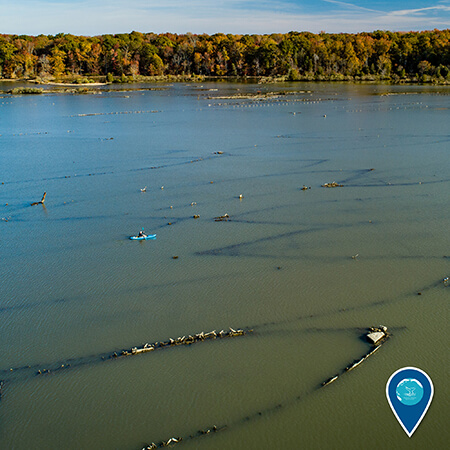
Say hello to our newest national marine sanctuary: Mallows Bay-Potomac River National Marine Sanctuary! This sanctuary protects over 100 World War I-era wooden shipwrecks, many of which have been partially reclaimed by nature. Learn about our recent community celebration and how you can visit this historic treasure.
Photo: Matt McIntosh/NOAA

On this day 148 years ago, the schooner E.B. Allen took its last voyage in Lake Huron. While the ship was bound for Buffalo, New York, a thick fog settled over the water. Unable to navigate, E.B. Allen collided with another vessel. Fortunately, all of the ship's crew were rescued and no lives were lost. Today, E.B. Allen lies at about 100 feet beneath the surface, protected by NOAA Thunder Bay National Marine Sanctuary.
Photo: NOAA

Comment below if manatees are your favorite animal! Manatees like those in NOAA Florida Keys National Marine Sanctuary can munch as much as 150 pounds of seagrass per day. These gentle, slow-moving animals are at risk from boat strikes, but conservation efforts are helping them! When you're boating in manatee habitat, always make sure to slow down and keep an eye out.
Photo: Robert Bonde/USGS

Snack time! Seabirds like this Cory's shearwater flock to NOAA's Stellwagen Bank National Marine Sanctuary to chow down on fish like sand lance. Their activities help researchers in the sanctuary track the health of fish populations, which in turn indicates how the sanctuary is doing overall.
Photo: Peter Flood

This Risso's dolphin is breakin' free! This species is very active on the ocean surface when they're not diving 1,000 feet deep near the edge of the continental shelf. This one was spotted swimming in NOAA's Monterey Bay National Marine Sanctuary.
Photo: Douglas Croft

29 never looked so fine – happy anniversary to NOAA Florida Keys National Marine Sanctuary! Protecting over 3,800 square miles and the only barrier coral reef in the continental United States, the sanctuary is home to a plethora of marine wildlife, including this beautiful red grouper. Learn how you can help the sanctuary thrive for the next 29 years and beyond
Photo: Greg McFall/NOAA

We see silly seals by the sea shore! While Hawaiian monk seals are undeniably adorable, they're also one of the most endangered marine mammals on the planet. NOAA Fisheries Service and Papahānaumokuākea Marine National Monument are working hard to help the population recover, but they still remain in critical status.
Photo: Paulo Maurin/NOAA

Raise your hands 🙌 if you love NOAA Olympic Coast National Marine Sanctuary as much as we do!
Photo: Dan Evans Jr.

You knew about seahorses but did you know about sea bunnies? This fluffy-looking nudibranch is called the white-knight dorid and lives in NOAA's Monterey Bay National Marine Sanctuary and elsewhere along the West Coast. Maybe bring a carrot next time you go diving here! (JK, they eat sponges.)
Photo: Chad King/NOAA

Shipwrecks on the ocean floor provide a safe harbor for all sorts of marine life! Here, fish flourish around the wreck of the USS Tarpon, located near NOAA Monitor National Marine Sanctuary. This U.S. submarine sank in World War II and now rests at a depth of 135 feet. Tarpon is heavily encrusted with coralline algae and other invertebrates, and sand tiger sharks are often spotted here.
Photo: Tane Casserley/NOAA

This summer, NOAA's Flower Garden Banks National Marine Sanctuary held a "Vet Into Your Sanctuary" fishing trip to bring U.S. military veterans out to the sanctuary. A total of 22 participants enjoyed an educational and fun fishing day with support from Project Healing Waters. A day on the water with a fishing rod in hand can provide veterans and others with a personal connection to the ocean that can develop to a life-long appreciation and continued stewardship of our underwater parks. We're honored to have been able to provide this opportunity to our veterans – happy Veterans Day!
Photo: Sepp Haukebo

The lagoon triggerfish is also known as the Picasso fish – an apt name for its bright colors. These beautiful reef-dwellers are found throughout the Indo-Pacific, including in Hawai‘i. This one was spotted in Hawaiian Islands Humpback Whale National Marine Sanctuary.
Photo: Michelle Smith

Cephalopod Saturday! 🐙💙 This gorgeous octopus was spotted in NOAA's Greater Farallones National Marine Sanctuary during an expedition with Nautilus Live.
Photo: OET/NOAA

Happy Manatee Awareness Month! Frequent visitors to NOAA Florida Keys National Marine Sanctuary, manatees face threats of habitat loss and watercraft collisions. But it’s not all doom and gloom for these gentle sea cows, as manatee populations have been increasing significantly since conservation efforts began. If you're boating in a known manatee habitat, keep them safe and slow down!
Photo: Bob Bonde/USGS

Sandbar sharks might not be the biggest sharks in the seas, but they are certainly impressive. Sandbar sharks are one shark species spotted at NOAA's Flower Garden Banks National Marine Sanctuary, where they tend to stay near the ocean floor. These beautiful sharks prey on fish, mollusks, and small crustaceans. Have you seen one while diving in the sanctuary?
Photo: Nick Zachar/NOAA

I spy with my little eye something…red! Well, red for now. This common octopus in NOAA Gray's Reef National Marine Sanctuary can change colors to hide from predators and to surprise prey. Specialized cells called chromatophores in the octopus’s skin allow it to camouflage itself with its surroundings. These clever cephalopods may be hard to play I Spy with, but they’re amazing at Hide and Seek!
Photo: Greg McFall/NOAA

What do you call a fish in space? A starfish! Though you may not actually be able to spot any sea stars in the night sky, many national marine sanctuaries offer beautiful views of dark skies. Here, the Milky Way shines brightly over the Anacapa Island Lighthouse in NOAA Channel Islands National Marine Sanctuary and Channel Islands National Park.
Photo: Nick Zachar/NOAA

Happy birthday to NOAA's Stellwagen Bank National Marine Sanctuary and Hawaiian Islands Humpback Whale National Marine Sanctuary! Though thousands of miles apart, both of these sanctuaries offer refuge to humpback whales. Each summer, humpback whales migrate from the Caribbean to Stellwagen Bank off the coast of Cape Cod, Massachusetts, where they and other whales feast on the food that flourishes in sanctuary waters. And in the Pacific, humpback whales journey to the warm waters surrounding the Hawaiian Islands each winter to mate, calve, and raise their young.
Top photo: Jeremy Winn; bottom photo: Ed Lyman/NOAA, under NOAA Fisheries Permit 14682-38079

Happy Jellyfish Day! These baby fish are celebrating by hanging out in the bell of a moon jelly in NOAA Florida Keys National Marine Sanctuary. What's your favorite species of jellyfish to see in your national marine sanctuaries?
Photo: Tiffany Pixie Duong/Ocean Rebels

A whale watcher's treat: Moments after a 4.7 magnitude earthquake struck California near NOAA's Monterey Bay National Marine Sanctuary last month, these humpback whales went into a breaching extravaganza. While it's not possible to say for sure, the whales were likely responding to the noise that occurred underwater during the earthquake.
Photo: Douglas Croft

We’re manatee-ing off Manatee Awareness Month with this big flex. Manatees are large, slow-moving herbivores that reside in NOAA Florida Keys National Marine Sanctuary in the winter. Unfortunately, manatees are listed as a federally threatened species, largely as a result of collisions with boats. Remember to always slow down when boating in areas known to have manatees!
Photo: Keith Ramos/U.S. Fish and Wildlife Service

Congratulations to Bruce Sudweeks, first place winner of the Sanctuary Life category of our Get Into Your Sanctuary Photo Contest! Life often flourishes on shipwrecks: here, fish swim around a tugboat located near NOAA Monitor National Marine Sanctuary.
Photo: Bruce Sudweeks

Congrats to Tiffany Pixie Duong for capturing first place in the Sanctuary Views category of our Get Into Your Sanctuary Photo Contest! Her photo brings Molasses Reef in NOAA Florida Keys National Marine Sanctuary alive on the screen. What invertebrates can you spot?
Photo: Tiffany Duong/Ocean Rebels

This turtle-y awesome picture from Olivia Williamson swam right into 1st place for the Sanctuary Recreation category of our Get Into Your Sanctuary Photo Contest! This diver got a treat when a green sea turtle swam by in NOAA Florida Keys National Marine Sanctuary.
Scuba diving is one of the best ways to explore our beautiful national marine sanctuaries. When swimming near wildlife, always give them plenty of space. Don't follow animals, cut off their path, or get between mothers and young; rather, watch quietly like this diver is doing. Learn more about responsible recreation.
Photo: Olivia Williamson

Ooh, barracuda! Mike Johnson's photograph of two barracuda in NOAA Florida Keys National Marine Sanctuary takes 2nd place in the Sanctuary Life category of our Get Into Your Sanctuary Photo Contest! Barracuda are highly effective ambush hunters with two sets of razor-sharp teeth. Mike waited for 45 minutes, hovering just off the seafloor, for these barracuda to approach close enough to get a stunning photo that wouldn't disturb them.
Photo: Mike Johnson

Take a trip to Bowling Ball Beach in NOAA's Greater Farallones National Marine Sanctuary! Congratulations to Anne Mary Schaefer for this stunning photo, which placed 2nd in the "Sanctuary Views" category of our Get Into Your Sanctuary Photo Contest.
Photo: Anne Mary Schaefer

2nd place in our Sanctuary Recreation category for the Get Into Your Sanctuary Photo Contest goes to Keith C. Flood! Keith photographed these divers exploring the Florida shipwreck at 200 feet of water in NOAA Thunder Bay National Marine Sanctuary. The steamer Florida sank in 1897 after a collision with the steamer George W. Roby, which nearly cut the ship in half. Today, the wreck sits awaiting exploration by advanced divers.
Photo: Keith C. Flood

Lunch time! Thanks to Douglas Croft Images, this hungry humpback whale lunged its way right into 3rd place in the Sanctuary Life category of our Get Into Your Sanctuary photo contest. One way humpback whales get their meals is by lunge feeding, when they rush up to the surface with open mouths and swallow mouthfuls of fish. Congratulations to Douglas for such an amazing NOAA's Monterey Bay National Marine Sanctuary photo!
Photo: Douglas Croft

Congratulations to Dustin Harris, whose photo of an island fox watching the sunset in NOAA Channel Islands National Marine Sanctuary placed third in the "Sanctuary Views" category! Island foxes are only found on California's Channel Islands and nowhere else in the world. They're the largest of the islands' native land mammals, but one of the smallest canid species in the world.
Photo: Dustin Harris

Today's our anniversary, and we're celebrating by kicking off the announcement of our Get Into Your Sanctuary Photo Contest winners! Placing third in the "Sanctuary Recreation" category is Anne Mary Schaefer, with this paw-fect walk on the beach in NOAA's Greater Farallones National Marine Sanctuary. Congratulations, Anne Mary!
Photo: Anne Mary Schaefer

Don't let the spikes fool you! While their cousins the sea urchins are covered with long, hard spines, sea cucumbers like this one in NOAA National Marine Sanctuary of American Samoa are actually covered with soft, leathery skin.
Photo: Greg McFall/NOAA

Sing it with us (and this humpback whale): Happy birthday to the Marine Mammal Protection Act! Enacted on this day in 1972, this important piece of legislation helps us protect animals like this humpback whale in NOAA's Stellwagen Bank National Marine Sanctuary. The act ensures that marine mammals like whales, porpoises, seals, sea lions, otters, and dolphins can carry out their normal lives without disruption – and without the threat of hunting, poaching, or exploitation.
Photo: Carolyn O'Connor

Citizen science isn't just for people anymore! This Muusoctopus octopus hopped aboard Nautilus Live's ROV Hercules last week to get a better look. Hercules was exploring a whale fall in NOAA's Monterey Bay National Marine Sanctuarythat was being scavenged by octopuses, fish, and other animals. The octopus crawled along Hercules' sampling vessels before presumably going back to eat some more. A whale fall – the carcass of a whale that has sunk to the seafloor – can feed communities of organisms for months or years.
Photo: OET/NOAA

Lift off into the weekend like these beautiful cormorants in NOAA Olympic Coast National Marine Sanctuary!
Photo: Dan Evans Jr.

This isn't exactly how this rockfish imagined starting off its weekend. Last week, researchers with Nautilus Live got a surprise when exploring NOAA's Greater Farallones National Marine Sanctuary. This sea star was attempting to eat a rockfish – sushi dinner?
Photo: OET/NOAA

Scientists aboard the E/V Nautilus got a treat yesterday when they came across a whale fall in NOAA's Monterey Bay National Marine Sanctuary! When whales die at sea, they sink to the seafloor where they can feed other organisms for years. There, the whale carcass or skeleton is known as a whale fall. The Nautilus Live team found this whale fall at a depth of 10,623 feet while exploring Davidson Seamount, an underwater mountain. The whale skeleton is lying on its back and is an estimated 13 to 16 feet in length. The team is working to identify the species, but it is confirmed to be a baleen whale. Look closely and you can see Muusoctopus octopuses and other marine animals!
Photo: OET/NOAA

Loch Ness Monster? Not at all – it's a gray seal in NOAA's Stellwagen Bank National Marine Sanctuary! While gray seals may appear approachable in the wild, human interference is a major threat to these marine mammals. Fishing entanglements, watercraft strikes, and interactions with humans put them at risk. Help protect gray seals by keeping a safe distance and not approaching them too close on land or on water.
Photo: Matt McIntosh/NOAA

Finding new friends in unlikely places! This flapjack octopus and rockfish were spotted cozying up in NOAA's Greater Farallones National Marine Sanctuary during a recent Nautilus Live dive.
Photo: OET/NOAA

We don't know about you, but we're pretty sure this sea lion in NOAA's Monterey Bay National Marine Sanctuary just realized it's Monday.
Photo: Douglas Croft Images

Grumpy that you missed last week's Nautilus Live expedition in NOAA's Cordell Bank National Marine Sanctuary and NOAA's Greater Farallones National Marine Sanctuary? We've got you covered – this week we'll be exploring the deep waters of NOAA's Monterey Bay National Marine Sanctuary! Tune in at nautiluslive.org.
Photo: OET/NOAA

There's nothing quite like a sunrise at sea. Where are you finding beauty this weekend?
Photo: Robert Schwemmer/NOAA

Octopus, or coral? This day octopus (he‘e in Hawaiian) in Papahānaumokuākea Marine National Monument is showing off its excellent camouflage skills. Octopuses and other cephalopods have specialized cells called chromatophores that allow them to change their colors; plus, they can change the texture of their skin to mimic the environment around them! This camouflage helps them go unseen by both predators and prey.
Photo: James Watt/NOAA

This octopus wants to know: have you been following the E/V Nautilus expedition in NOAA's Cordell Bank National Marine Sanctuary and NOAA's Greater Farallones National Marine Sanctuary? We're exploring the deep waters of these national marine sanctuaries with Nautilus Live, and you can watch the expedition in real time at nautiluslive.org! Tune in for the chance to see adorable octopuses and more.
Photo: OET/NOAA

We're not squidding around when we say we love cephalopods! Photographer Alexander Neufeld describes his encounter with this beautiful reef squid in NOAA Florida Keys National Marine Sanctuary this way: "A reef squid in the black waters off of Key Largo during a night dive. Several squid joined us during a portion of the dive, hovering just below the surface, which allowed for the reflection of the squid's body in the final image. Once the squid had enough of us, it took off in a cloud of ink."
Photo: Alexander Neufeld

We have some whale-y good news: the first humpback whale of the season has been spotted in Hawai‘i! Thousands of humpback whales return to Hawaiian Islands Humpback Whale National Marine Sanctuary each year to breed, give birth, and nurse their young. If you're in Hawai‘i – or anywhere else near the ocean – always make sure to give whales and other marine life plenty of space.
While this photo isn't this year's first whale, but rather a past visitor to the sanctuary, we hope to have photos soon!
Photo: NOAA, under NOAA Permit #782-1438

Cordell Bank rises from deep, dark waters off the coast of California – and is home to a technicolor array of marine life! Here, hundreds of widow rockfish swim through NOAA's Cordell Bank National Marine Sanctuary above bright invertebrates. Can you name the pink anemones growing on the bank?
Photo: Robert Lee/BAUE

Rose Atoll Marine National Monument rests within the waters of NOAA National Marine Sanctuary of American Samoa. It's known for its striking rosy reefs, which get their hue from pink coralline algae. These beautiful reefs are home to more than 100 species of coral, as well as large populations of giant clam, reef fish, and more.
Photo: Mark Manuel/NOAA

Sometimes even sea lions need to kick back and soak up some sun with their buddies. These sea lions found a buoy in NOAA's Greater Farallones National Marine Sanctuary to hang out on. Where are you relaxing this weekend?
Photo: Robert Schwemmer/NOAA

“Hey everybody, party at NOAA Gray's Reef National Marine Sanctuary tonight! Tell the whole school!” Hoping your Friday night plans are as fun as these Atlantic spadefish's.
Photo courtesy of Barbara Phillips

10/10 points for orca acrobatics! This breaching orca is showing off its black and white patterning in NOAA's Monterey Bay National Marine Sanctuary. An orca's high-contrast patterning helps obscure the outline of its body underwater so it's harder for prey to recognize it.
Photo: Douglas Croft Images

Take a deep dive into history with NOAA Monitor National Marine Sanctuary! The first national marine sanctuary ever designated in the U.S., this small sanctuary protects the wreck of the USS Monitor. Monitor is distinguished by being the first ironclad war vessel to fight for the United States – during the Civil War, it faced off with the Confederate CSS Virginia. It later sank in a storm off the coast of North Carolina, and today it rests on the seafloor, a memorial to those who were lost and a haven for sea life.
Photo: NOAA

Blenny for your thoughts! What do you think this seaweed blenny in NOAA Gray's Reef National Marine Sanctuary is thinking?
Photo: Greg McFall/NOAA

Monday morning's got us dreaming of our adventures from this weekend! Plan your next paddle or swim.
Photo: Bryan Dort

Meet the giant clam, also known as faisua in Samoan! These beautiful clams can be spotted in the coral reefs of NOAA National Marine Sanctuary of American Samoa. Once nestled into a location on the reef, a giant clam will remain stationary throughout its life. Like corals, giant clams have developed symbiotic partnerships with algae called zooxanthellae. In return for shelter, zooxanthellae provide giant clams with nutrients they've photosynthesized – and help give the clam's mantle its pretty colors.
Photo: NPS

So, uh, was anyone going to tell us that northern elephant seals are WAY bigger than sea otters, or were we supposed to find that out ourselves?
Photo: Phil Arnold

Whale, whale, whale – it's World Tourism Day! Your national marine sanctuaries are the perfect place for ocean adventures. Whether you're a fan of whale watching in Hawaiian Islands Humpback Whale National Marine Sanctuary or tide pooling in NOAA Olympic Coast National Marine Sanctuary, there's something for everyone. Find your adventure.
Photo: K. Grosskruetz/NOAA, under NOAA Permit #15240

Today is World Environmental Health Day. The environments of the ocean – from coral reefs to kelp forests – depend on us to help keep them healthy. We can all do our part, whether it's through reducing our use of plastics or working with our communities to reduce our carbon footprints. What will you do today, tomorrow, and the next day to help protect our blue planet?
Photo: Greg McFall/NOAA

Happy anniversary to NOAA Thunder Bay National Marine Sanctuary! This jewel of the Great Lakes protects the wrecks of more than 100 vessels that have been claimed by fire, ice, collisions, and storms. The sanctuary serves as a museum of the Great Lakes' maritime history. You can explore the many shipwrecks by diving, snorkeling, and paddling – and if you'd rather not get your feet wet, you can experience history at the many lighthouses that dot the sanctuary's shores.
Photo: David J. Ruck/NOAA

You otter believe this sea otter is having an otterly delicious snack! Dr. Nancy Foster Scholar Jessie Hale studies sea otters in NOAA Olympic Coast National Marine Sanctuary. She got a treat when she spotted this female otter chowing down on a lingcod egg mass.
Photo: Jessie Hale

It's Sea Otter Awareness Week, and these sea otters in NOAA's Monterey Bay National Marine Sanctuary want to know if you're aware of them! When you're exploring your national marine sanctuaries, make sure to keep an eye on your distance from wildlife like sea otters. Though they are otterly adorable, they'll be safer and healthier if you give them plenty of space.
Douglas Croft

Happy anniversary to NOAA Channel Islands National Marine Sanctuary! This southern California sanctuary encompasses 1,470 square miles off of Anacapa, Santa Barbara, Santa Cruz, San Miguel, and Santa Rosa islands. It protects everything from deep-sea coral communities to lush kelp forest. Nearshore, giant kelp helps support immense biodiversity – visitors can see sea lions, giant sea bass, and more!
Photo: Brett Seymour/NPS

Today is the International Coastal Cleanup! Whether you're participating in an official clean-up event or just picking up trash in your neighborhood, let us know how you're helping keep the ocean clean today. Here, two volunteers from Blue Kahuna Surf help remove marine debris from NOAA Florida Keys National Marine Sanctuary.
Photo: Jessica Hogan

These American white pelicans are celebrating Estuaries Week in style! Estuaries are locations where rivers meet the sea. Located in NOAA's Monterey Bay National Marine Sanctuary, Elkhorn Slough is one of California's great estuaries. Flushed by ocean tides in the heart of Monterey Bay, its waterways, mudflats, and marsh support a huge diversity of wildlife. Estuaries like Elkhorn Slough provide food, shelter, migration stopovers, and places to breed for many animals. However, they're also quite delicate and need our help to ensure they remain thriving ecosystems. Learn more about estuaries and how you can support them.
Photo: Douglas Croft

What happens to trash after it flows down a creek or falls off a vessel at sea? Usually, it stays in the ocean for a long, long time. There, it can choke animals who mistake it for food, or entangle animals and drown them. This huge conglomeration of fishing nets and other trash was removed from French Frigate Shoals in Papahānaumokuākea Marine National Monument by NOAA Marine Debris and partners. Since 1996, they have removed 1017 tons of debris the remote expanses of the Northwestern Hawaiian Islands, which is about the same weight as nine blue whales! You can help keep debris out of the sea by participating in a cleanup this weekend for the International Coastal Cleanup, or any other day of the year.
Photo: Koa Matsuoka

This humpback whale is lunging out of the ocean to wish NOAA's Monterey Bay National Marine Sanctuary a very happy birthday! 🐋🎂 And also, of course, to get a mouthful of fish, because what's a celebration without snacks? This iconic sanctuary protects 36 species of marine mammals, more than 180 species of seabirds and shorebirds, 525 species of fish, and a multitude of invertebrates and algae. How many can you name?
Photo: Douglas Croft

Eyes of a hawk, and ears of a...fish?
Stocky hawkfish are known as po‘opa‘a in Hawaiian. In the coral reefs of Papahānaumokuākea Marine
National Monument, they linger atop corals and survey their surroundings for prey, much like their
terrestrial namesake. As an added level of protection, a stocky hawkfish’s pectoral fins are resistant
to the stinging cells of fire corals, which normally harm other organisms upon contact. Well played,
hawkfish. Well played.
Photo: James Watt/NOAA

Oh buoy! This drill team is hard at work installing new mooring buoys in NOAA Florida Keys National Marine Sanctuary. Buoys allow boaters to enjoy their time out on the water without damaging the coral reef and seagrass bed ecosystems that lie beneath them. Buoys serve as as an alternative to anchoring, which is prohibited in waters less than 40 feet deep, and can also be used as markers relaying specific information about the area.
Photo: NOAA

This sea star traveling on a sea urchin in NOAA Gray's Reef National Marine Sanctuary would like to share an underwater hitchhiking pro-tip: if it moves, it's transportation!
Photo: Greg McFall/NOAA

Whale, whale, whale, what do we have here?
Whale watchers in NOAA's Monterey Bay National Marine Sanctuary got a surprise visit from a gray
newborn orca calf traveling with 10 members of the transient orca pod known as the CA216 family. While
most orcas are black and white, little is known about the uncommon gray pigment of this youngster. The
science is clear on one thing – this newborn is 100% adorable!
Photo: Douglas Croft

In addition to being markers of our maritime past, shipwrecks are home to a vast number of marine species – like these frilled anemones on the wreck of the Portland in NOAA's Stellwagen Bank National Marine Sanctuary. Next week, researchers from Woods Hole Oceanographic Institution (WHOI) and Marine Imaging Technologies will be visiting Portland and other shipwrecks to assess the state of the wrecks. They'll be livestreaming their expedition, and you can tune in while they journey deep beneath the ocean's surface! Leran more abouth this expedition.
Photo: NOAA

Some days you just have to lie down, wrap yourself in kelp, and nap the day away. It's all part of that pawsitive self care.
Photo: Douglas Croft

From tragedy to new life: sunk by a German U-boat during World War II, the American cargo ship Caribsea is now host to a vibrant reef not far from NOAA Monitor National Marine Sanctuary. The wreck is largely intact and is now a popular dive site.
Photo: NOAA

Strange but true: leather sea stars, like this one in NOAA Olympic Coast National Marine Sanctuary, smell like garlic! That's why they're also sometimes known as garlic stars. Have you ever gotten a whiff of one in your national marine sanctuaries?
Photo: David J. Ruck/NOAA

Mondays are for maritime history, and NOAA Thunder Bay National Marine Sanctuary has got lots of it! D.M. Wilson, pictured here, is one of the many wrecks sitting at the bottom of Thunder Bay National Marine Sanctuary in Lake Huron. In 1894, the wooden ship was headed for Milwaukee with its usual shipment of coal when a leak stopped it in its tracks. Despite attempts to tow it to safety, the ship sank near Thunder Bay Island. Today, divers can see most of the Wilson’s hull, which remains largely intact!
Photo: David J. Ruck/NOAA

Us: Hey, wanna hear a joke?
Gray seal in NOAA's Stellwagen Bank National Marine Sanctuary: sure
Us: Why do seals swim in salt water?
Gray seal: …
Us: …
Because pepper water makes them sneeze!
Gray seal: *face palm*
Don’t tell gray seals sealy jokes. Instead, earn your seal of approval by keeping a safe distance from them to protect them from human disturbances.
Photo: Anne Smrcina/NOAA

How would you caption this photo of a pair of masked boobies in Papahānaumokuākea Marine National Monument?
Photo: Lindsey Kramer/U.S. Fish and Wildlife Service

Seas the day with our National Marine Sanctuary System! Like this group of visitors enjoying a morning yoga session on the shores of Second Beach in NOAA Olympic Coast National Marine Sanctuary there is an opportunity for everyone to experience our sanctuaries.
Photo: Karlyn Langjahr/NOAA

What bottom dwelling marine critter found in NOAA Gray's Reef National Marine Sanctuary does this suspicious eye belong to? Leave a comment below with your guess, and we'll have the answer for you later today!
Photo: Greg McFall/NOAA

Happy National Wildlife Day! Not only are we celebrating our sanctuary wildlife, but also the partnerships that exist between many of them. In Hawaiian Islands Humpback Whale National Marine Sanctuary, sea turtles like these two get routine clean-ups from grazing reef fish at “cleaning stations” found along the reefs. The fish keep the sea turtles free of algae and other organisms that live on them, while the reef fish get a snack! A win-win situation if you ask us.
Photo: Nick Zachar/NOAA

My, what big teeth you have! Sand tiger sharks like this one can often be spotted on the wrecks of the Graveyard of the Atlantic, near NOAA Monitor National Marine Sanctuary. But never fear – though their teeth make them look fearsome, sand tiger sharks are typically docile near divers.
Photo: Tane Casserley/NOAA

Like the sun setting over Southeast Farallon Island in NOAA's Greater Farallones National Marine Sanctuary, our photo contest is coming to a close. The Get Into Your Sanctuary photo contest closes at the end of the day, so now's the time to submit those last few photos!
Photo: Robert Schwemmer/NOAA

Seen any cool nudibranchs lately, like this Spanish shawl nudibranch in NOAA Channel Islands National Marine Sanctuary? Now's the perfect time to submit your photos to the Get Into Your Sanctuary photo contest!
Photo: Cindy Shaw

When is a whale not a whale? When it's a whale shark! While whales are mammals, whale sharks are actually fish, named for their vast size. Like some whales, they are also filter feeders, chowing down on plankton. During the summer months, whale sharks travel to NOAA's Flower Garden Banks National Marine Sanctuary in the Gulf of Mexico to find this favorite food.
Photo: Kevin Lino/NOAA

Going on a coastal getaway this Labor Day weekend? Show our ocean and Great Lakes some love by leaving no trace when visiting, and helping out with a beach clean up if you can! Collective efforts to keep our water bodies a cleaner, better place, like these two volunteers are doing in NOAA Olympic Coast National Marine Sanctuary, is shore to be a crowd pleaser!
Photo: Karlyn Langjahr/NOAA

Nothing hits the spot like a midday nap, especially for sea otters! Due to their high metabolism, sea otters – like this one in NOAA's Monterey Bay National Marine Sanctuary – have to eat and rest a lot as part of their daily routine. As otterly adorable as they are, it’s important to keep a safe viewing distance when coming across a sea otter in the wild so you don't interrupt the time they need to take care of themselves. Keep sea otters safe and undisturbed by respecting their space, and their naps!
Photo: Cat Harper

We're o-fish-ally in the last week of the Get Into Your Sanctuary photo contest! Remember to submit your best photos of sanctuary wildlife, scenery, and recreation by September 2nd.
Photo: Steve Miller

Witnessing the spectacular wildlife of our national marine sanctuaries – like this humpback whale in Hawaiian Islands Humpback Whale National Marine Sanctuary – is always whaley exciting! It’s important to keep a safe viewing distance to make sure the wildlife aren’t disturbed by our admiration. In Hawai’i, whales cannot be approached closer than 100 yards, which protects humpback whales and whale watchers alike.
Photo: NOAA, under NOAA Fisheries Permit #782-1438

Incoming!
Brown pelicans like this one in NOAA's Monterey Bay National Marine Sanctuary are master divers. A
brown pelican can plunge into the water from as high as 60 feet above the surface.. Then it's able to
scoop up surprised fish into its throat pouch – a handy meal!
Photo: Douglas Croft

Hear ye, hear ye! Calling photographers of all skill levels – submit your best photos of our National Marine Sanctuary System’s scenery, wildlife, and recreation to the Get Into Your Sanctuary photo contest! Submissions are open until September 2nd.
Photo: Daryl Duda

Animal or plant? Both the feathery object and the coils in this photo may look like plants (or something otherworldly) but they're actually animals! Researchers from the Global Foundation for Ocean Exploration and NOAA's Flower Garden Banks National Marine Sanctuary witnessed this reef at Alderdice Bank in the Gulf of Mexico. The feathery creature is a feather black coral, while the coils are known as sea whip corals. Both feed on plankton that is swept by in the current!
This photo is from an ongoing expedition that is livestreaming dives from areas in and around Flower Garden Banks National Marine Sanctuary. Tune in and learn more.
Photo: GFOE/NOAA

Keep your friends close, and your anemones further away! Sea anemones – like this one found in NOAA Florida Keys National Marine Sanctuary – are close relatives of coral and jellyfish. While their brightly colored tentacles are a beautiful sight, they are actually venomous and are used for capturing prey. Most species are benign to humans, but keeping your hands to yourself protects both you and the animal. Don't make an enemy of a sea anemone!
Photo: Greg McFall/NOAA

Sea lion in NOAA's Cordell Bank National Marine Sanctuary once it realizes it’s not supposed to be flying: ...AAAHHH!
Photo: Dru Devlin/NOAA

NOAA Florida Keys National Marine Sanctuary protects one of the most iconic ocean places in the world. But these important ocean habitats are in jeopardy of being “loved to death.” To survive for future generations, the Keys need to change, and there’s no time to lose. The sanctuary is proposing a new Restoration Blueprint, and we want to hear from you.
Photo: Shawn Verne

Now presenting the rosy palace of Rose Atoll, located in NOAA National Marine Sanctuary of American Samoa! The reef at Rose Atoll gets its pink hues from crustose coralline algae, an unassuming friend of the coral reef ecosystem. While corals lay down their own stony skeleton, crustose coralline algae crust over and between the structures to help cement them together, forming a reef. Can you name a more iconic duo?
Photo: J. Kenyon/NOAA

We have an announcement: we've decided that this Facebook account will now be a succulent appreciation account.
Just kidding! This isn't a plant – it's a white-lined nudibranch. Nudibranchs, like this one found in NOAA's Monterey Bay National Marine Sanctuary, are sea slugs that often come in striking colors and forms. While they may look like they're making a fashion statement, nudibranchs often depend on their brilliant colors as defense from predators.
Photo: Steve Lonhart/NOAA

We’re a big fan of deep-sea fans! This fan coral and its fish friends were found at a depth of about 100 meters in the Santa Cruz Canyon, part of NOAA Channel Islands National Marine Sanctuary. Unlike their shallow-water relatives, deep sea corals don’t need sunlight to thrive; instead, they obtain energy and nutrients by trapping tiny organisms that pass through the water. Pretty fan-tastic if you ask us!
Photo: Marine Applied Research and Technology

Winter flounder in NOAA's Stellwagen Bank National Marine Sanctuary: “How does my new cloak of
invisibility look?”
Us: You tried.
Photo: Deborah Marx/NOAA

Row, row, row your boat, gently down the...lake? That’s right! Sailing, kayaking, or even paddling a traditional Mackinaw boat are among the many ways you can explore the maritime history and natural wonder of NOAA Thunder Bay National Marine Sanctuary, located in Lake Huron. There are recreational activities available for visitors of all skill levels! So, water you waiting for?
Photo: David J. Ruck/NOAA

A day octopus – or he’e mauli in Hawaiian – sits pretty at French Frigate Shoals in Papahānaumokuākea Marine National Monument. Many cephalopods have special cells in their skin tissue called chromatophores that enable them to change color very rapidly. A part of their neuromuscular system, these cells receive signals from the environment that an octopus can use to inform color change. Octopodes of this particular species can change color almost instantly as they move over their environment, making them nearly invisible to predators!
Photo: Andrew Gray/NOAA

Let your photography skills glow like this anemone in NOAA's Monterey Bay National Marine Sanctuary by submitting to the Get Into Your Sanctuary photo contest! Just a few more weeks to send in your photos.
Photo: Nathan Coyle

Just two sea star friends hanging out in an NOAA Olympic Coast National Marine Sanctuary tide pool. Tag your favorite tide pool buddy!
Photo: Shawn Sheltren/NPS
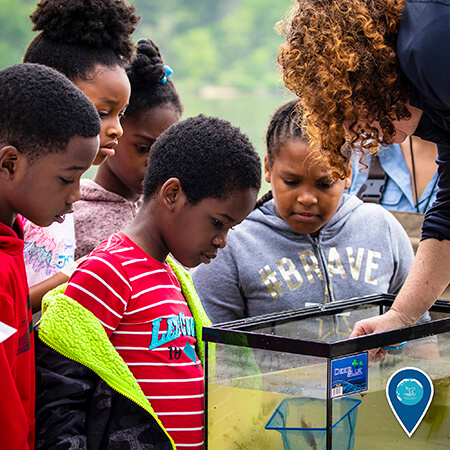
Have you heard the news? There's a brand new national marine sanctuary! Located in the tidal Potomac River, Mallows Bay-Potomac River National Marine Sanctuary protects a historic collection of shipwrecks. These shipwrecks in turn serve as habitat for many different animals, museums of our maritime past, and classrooms for students of all ages.
Photo: Matt McIntosh/NOAA

For World Lion Day, we're bringing you the lions of the sea: Indo Pacific lionfish. As their name suggests, these fish are native to the Indo Pacific region, and are part of the food web in coral reefs in that area. In recent decades, though, these fish have been found in coral reefs throughout the southeast Atlantic, Gulf of Mexico, and Caribbean – including in NOAA Gray's Reef National Marine Sanctuary, NOAA's Flower Garden Banks National Marine Sanctuary, NOAA Florida Keys National Marine Sanctuary, and NOAA Monitor National Marine Sanctuary. Experts speculate that people have been dumping unwanted lionfish into the ocean for the last 25 years or more.
In their newfound habitats, lionfish don't have natural predators – plus, they have voracious appetites and reproduce quickly. This may spell trouble for biodiversity in coral reefs. a group of 1,000 lionfish can consume 5 million prey fish in a single year! NOAA and our partners are working to understand and control this invasive species with new traps, lionfish derbies, and more. You can help by asking restaurants near you to serve lionfish, and learn more here.
Photo: Bess Bright

Are you spending your summer exploring your national marine sanctuaries? Don't forget to submit your photos to the Get Into Your Sanctuary photo contest! We're accepting photos in three categories – Sanctuary Life, Sanctuary Views, and Sanctuary Recreation – through Labor Day weekend.
Photo: Douglas Croft

Are you spending your summer exploring your national marine sanctuaries? Don't forget to submit your photos to the Get Into Your Sanctuary photo contest! We're accepting photos in three categories – Sanctuary Life, Sanctuary Views, and Sanctuary Recreation – through Labor Day weekend.
Photo: Michael Beattie

Sometimes it can be hard for maritime archaeologists to document shipwrecks because of all the fish! Here, NOAA Monitor National Marine Sanctuary archaeologist Will Sassorossi and NOAA Ship Nancy Foster's navigation officer ENS Sara Thompson explore the shipwreck of the USS Schurz, which sank during World War I off the coast of North Carolina. Shipwrecks like the USS Schurz have a second life beneath the waves as artificial reefs. Invertebrates like anemones and corals may attach to the wreck surface, while fish like the many seen here shelter and feed around the wreck.
Photo: Tane Casserley/NOAA

If the moon and the stars became part of the deep-sea of NOAA's Cordell Bank National Marine Sanctuary, this is what they would look like. *Cue Twilight Zone music.*
Photo: NOAA

How important is water quality to our marine and freshwater ecosystems? Important enough that we dedicate a month to celebrate it! August is National Water Quality Month. Our national marine sanctuaries depend on clean water to ensure that biological diversity, coastal scenery, and recreational and commercial opportunities thrive. During “Snapshot Day” in NOAA's Monterey Bay National Marine Sanctuary, hundreds of citizen science volunteers aid in water quality efforts, assessing rivers, streams, and other coastal California watersheds.
Photo: Christina Muegge

Gain a new perspective by visiting a national marine sanctuary near you! In NOAA Channel Islands National Marine Sanctuary, you can explore the mysterious sea caves that line the sanctuary or catch a whale watching tour. As we wrap up Get Into Your Sanctuary weekend, be sure to enter any sanctuary photos you love into the 2019 “Get into Your Sanctuary” photo contest
Photo: Sarah Raskin

Dive into our nation's maritime history and marine wonders with one of the many events taking place this weekend for Get Into Your Sanctuary!
Photo: David J. Ruck/NOAA

Are you joining us this weekend for Get Into Your Sanctuary days? Starting today through the weekend, we'll be holding events all across the country to celebrate the National Marine Sanctuary System. You don't have to be a scuba diver or a surfer to dive into the wonders of your national marine sanctuaries!
Photo: David J. Ruck/NOAA

Ever wonder what it might be like to have a sixth sense? Sharks have that covered! Specialized organs called ampullae of Lorenzini help these stealthy hunters detect small electrical fields released by other animals. That way, sharks can sense their prey even if it's buried in the sand or in murky water. Hammerhead sharks – like this one in NOAA Gray's Reef National Marine Sanctuary – have an especially large number of these ampullae on their broad head.
Photo: Mitchell Tartt/NOAA

Mirror mirror on the wall, who’s the sleepiest shark of them all?
Nurse sharks! These nocturnal bottom dwellers prefer to take it easy during daylight hours in caves
and dark crevices. At night, nurse sharks scout the seafloor for crustaceans, mollusks, and other
low-lying prey. This one was spotted in NOAA Florida Keys National Marine Sanctuary.
Bonus points if you can spot the eel hanging out near this shark!
Photo: Nick Zachar/NOAA

Meow!
This filetail catshark – found at a depth of 470 meters in NOAA's Monterey Bay National Marine
Sanctuary – is indeed 100 percent shark. However, it has light-sensitive eyes similar to that of cats,
which helps it hunt for fish and squid in the deep, dark waters that it lives in.
Photo: Kevin L. Stierhoff/NOAA

*Cue Jaws music*
This Laysan albatross, or mōlī, in Papahānaumokuākea Marine National Monument is in for a surprise.
Tiger sharks like this one are voracious predators, much like their terrestrial namesake, and are
known to take a bite out of just about anything that catches their attention. Though they can be
frightening, sharks like the tiger shark are incredibly important animals in ocean environments.
Sharks help remove dead or decaying debris from the ocean, and thereby help keep our ocean clean,
while also helping to keep ecosystems in balance.
Photo: Ilana Nimz/NOAA

Hey...hey you…you know what week it is? It’s Shark Week! 🦈🦈🦈
For the next few days we’ll be sinking our teeth into the importance of sharks in our National Marine
Sanctuary System. Caribbean reef sharks in NOAA Florida Keys National Marine Sanctuary play an
important role as apex predators of smaller reef fish, and help maintain a healthy balance in the
marine food web. What shark species are you looking forward to learning about this week?
Photo: Alexander Neufeld

No one said riding the waves in NOAA Olympic Coast National Marine Sanctuary was going to be easy! The important thing is to try, and get back up after you get knocked down. 😊 Check out some of the best surf spots in the National Marine Sanctuary System
Photo: Kate Thompson/NOAA

Ride into the weekend like this shrimp hitching a ride on a jelly in NOAA Gray's Reef National Marine Sanctuary!
Photo: Greg McFall/NOAA

Just how big are humpback whales? Consider the humpback whale tail, or flukes. From tip to tip, it can be 18 feet across!
Photo: Ed Lyman/NOAA, under NOAA Permit #15240

Cephalopods octopi our hearts! This Caribbean two-spot octopus was spotted hanging around the coral cap in NOAA's Flower Garden Banks National Marine Sanctuary. 🐙💙
Photo: GP Schmahl/NOAA

Jelly of this amazing photo? There's still time to submit your photos to the Get Into Your Sanctuary photo contest! We're accepting photos in three categories – Sanctuary Life, Sanctuary Views, and Sanctuary Recreation – through September 2. We can't wait to see the National Marine Sanctuary System through your eyes!
Photo: Michael Alyono

Happy birthday to NOAA Olympic Coast National Marine Sanctuary! This amazing Pacific Northwest spot protects everything from shoreline tide pools to deep-sea canyons. Today, the sanctuary turns 25 years old!
Photo: The Ocean Agency

"I spend so much time outdoors and am always very careful to leave it as I found it, or better than I found it. I also became dive certified a few years ago so I could not only explore 'beneath the surface' but also help with clean-up efforts." – Jackie Krawczak, NOAA Thunder Bay National Marine Sanctuary volunteer
What inspires you about the ocean and Great Lakes?
Photo: David J. Ruck/NOAA

Saturday afternoon nap? Don't mind if we do! Are you taking inspiration from this northern elephant seal in NOAA Channel Islands National Marine Sanctuary?
Photo: Robert Schwemmer/NOAA

Take wing to the newest national marine sanctuary: Bay-Potomac River National Marine Sanctuary! Located on the tidal Potomac River, this brand-new addition to the National Marine Sanctuary System protects a series of shipwrecks, which in turn serve as habitat for animals like this osprey.
Photo: Matt McIntosh/NOAA

We're considering a new national marine sanctuary in Lake Ontario, and we want to hear what you think! There are two more weeks to submit a comment about the proposed national marine sanctuary, which would protect historically-significant shipwrecks. Learn more about the proposal and how to comment.
Photo: NOAA

Looking for an adventure this summer? Join us for Get Into Your Sanctuary Days! From August 2 through 4, sites across the National Marine Sanctuary System will be holding events for our fifth national "Get Into Your Sanctuary" celebration.
Photo: David J. Ruck/NOAA

Overheard in NOAA's Monterey Bay National Marine Sanctuary:
Western gull chick: Feed me! Feed me! Feed me!
Adult gull:
Photo: Douglas Croft Images

Can you spot the octopus? 🐙 Look closely and you might spot a little cephalopod among the many invertebrates of NOAA's Cordell Bank National Marine Sanctuary!
Photo: Clinton Bauder/BAUE

Happy Shark Awareness Day! Whale sharks are the biggest shark – and the biggest fish – in the ocean. These massive sharks are filter feeders, consuming tiny zooplankton. Like many shark species, whale sharks have hundreds of teeth, but theirs are tiny, pointed backwards, and thought to have no role at all in feeding. Lucky divers can spot these gentle giants in NOAA's Flower Garden Banks National Marine Sanctuary.
Photo: Sam Farkas

"Uh oh. Did I leave the stove on?" This Garibaldi in NOAA Channel Islands National Marine Sanctuary is pretty sure it forgot something important...
Photo: Beata Lerman

Ride the waves into the weekend in NOAA's Greater Farallones National Marine Sanctuary! Which beach are you visiting this weekend?
Photo: Jennifer Stock/NOAA

You don’t have to be a scuba diver to enjoy the kelp forests of NOAA Channel Islands National Marine Sanctuary! Kayak tours are one way to adventure around the sanctuary, where you can paddle around sea caves and above the giant kelp forests with a birds-eye view of the underwater world beneath you.
Photo: Anna Jacobson/Channel Islands Adventure Company

Don’t you just love a healthy coral reef? NOAA National Marine Sanctuary of American Samoa protects critical reef-building coral species, like these staghorn corals. Healthy coral reefs provide habitat for a wide variety of marine organisms, all the while protecting shorelines from large waves and storms.
Photo: David J. Ruck/NOAA

Do you have some glamour shots of your National Marine Sanctuary System? Consider sending in your best shots for the Get Into Your Sanctuary photo contest! This opalescent nudibranch found in NOAA's Monterey Bay National Marine Sanctuary was submitted in last year’s contest. Photos will be accepted through September 2.
Photo: Arial Bauman

BIG NEWS: Today, along with the state of Maryland and Charles County, we're announcing the designation of a new national marine sanctuary to protect the remains of more than 100 abandoned steamships and vessels built as part of America’s engagement in World War I. Mallows Bay-Potomac River National Marine Sanctuary, about 40 miles south of Washington, D.C., is the first national marine sanctuary designated since 2000.
Photo: Nick Zachar/NOAA

Each year, literal tons of garbage washes up on the shores of the Northwestern Hawaiian Islands in Papahānaumokuākea Marine National Monument. There, it threatens animals including juvenile Laysan albatross, who may eat plastic pieces or get entangled in derelict fishing nets. NOAA works to clean up this trash to keep wildlife safe – since 1996, the marine debris team has removed 1.9 million pounds of derelict fishing gear and other garbage from the monument!
Photo: Ryan Tabata/NOAA

Overheard at NOAA Florida Keys National Marine Sanctuary open mic:
“When the moon hits your eye like a big pizza pie, that’s *gasps*...a moray.”
Caption the reaction of the fish hiding behind the sea fan.
Photo: Greg McFall/NOAA

Trash and animals don't mix well! Do you know what to do if you spot a marine mammal in distress?
First off, don't try to approach or disentangle the animal yourself. Wild animals – especially scared ones – can be volatile, and may injure you or themselves. Instead, contact your local stranding network so that trained professionals can safely help the animal in distress. If you're in Monterey Bay National Marine Sanctuary, where this fur seal was spotted, contact The Marine Mammal Center hotline (San Francisco Bay Area: 415-289-7325; Monterey or Santa Cruz Counties: 831-633-6298; San Luis Obispo County: 805-771-8300).
Photo: Douglas Croft Images

We’re celebrating stars (and stripes) today! #IndependenceDay is one of the most popular beach days of the year, but litter also follows large crowds onto our shores. Luckily, you can enjoy the salt, sand, and sun while being a steward of your local marine environment. By reducing your use of single-use plastics and leaving no trace when packing up for the day, you can help preserve our beaches and ocean for marine life, and make your visit a more enjoyable one! Bonus points if you set aside some time to clean up other parts of the beach.
What beach are you visiting today?
Photo: Nancy Sefton

Ever wondered what paradise looks like? Well look no further! The beaches and coasts of NOAA National Marine Sanctuary of American Samoa are truly a sight to sea. However, marine debris not only threatens the diverse wildlife protected by the sanctuary, but it can also be an eyesore for those who admire these beautiful and culturally-significant landscapes. When celebrating Independence Day, keep in mind that trash travels! You can help preserve our national marine sanctuaries by cleaning up after yourself and encouraging those around you to do the same.
Photo: Greg McFall/NOAA

Bereef it or not, every year around 8 million metric tons of plastic make their way into our ocean! Trash that is left behind on shores and beaches are often swept into the ocean by high tides and wind, and can travel thousands of miles once it enters the water. Even deep ecosystems far from shore, like this one in NOAA's Cordell Bank National Marine Sanctuary, can be impacted plastic pollution. If you're visiting a beach this week for the Fourth of July, help keep our ocean clean and reefs healthy by joining a beach clean up, or take the lead and organize one!
Photo: Robert Lee/BAUE

Don’t be in breach of ocean etiquette! This week, we’ll be celebrating the red, white, and blue with Clean Beaches Week to protect and preserve our ocean and Great Lakes and all of their inhabitants, such as the humpback whales of NOAA's Stellwagen Bank National Marine Sanctuary. Due to their feeding methods, whales and other cetaceans are vulnerable to encounters with marine plastic floating through their habitats. By keeping our beaches trash free and leaving no trace behind when we enjoy our shores, we’re also helping protect marine life down the line!
Photo: Anne Smrcina/NOAA

Whale you know what they say, the best things in life come when you’re not looking for them! That’s exactly what happened with whale watchers in NOAA's Monterey Bay National Marine Sanctuary recently when they had some surprise visitors. A pod of rare Baird’s beaked whales were spotted swimming in the area, including some calves. The elusive whales are usually found far out at sea, and likely traveled to Monterey Bay following food, like squid and fish.
Photo: Douglas Croft Images

A fairy is among us! A fairy tern chick, that is. Known as manu-o-kū in Hawaiian, fairy terns are native to the Northwestern Hawaiian Islands, including Papahānaumokuākea Marine National Monument. Unlike most seabirds, fairy terns lay their eggs directly onto a surface like a tree branch or cliff ledge, rather than building a traditional nest! When the chicks hatch, they use their sturdy claws to grip onto the surface, which helps them weather even the strongest winds and storms.
Photo: Koa Matsuoka

Introducing the red Irish lord of NOAA Olympic Coast National Marine Sanctuary: a master of disguise, professional ambush predator, and in desperate need of some lip balm.
Photo: Katy Laveck Foster

Sink into some maritime history with NOAA Monitor National Marine Sanctuary! The USS Monitor, pictured here, was the first ironclad warship in the Union army. In 1862 in the throes of the Civil War, Monitor led the Union into battle against the Confederate ironclad CSS Virginia at the Battle of Hampton Roads. While the battle ultimately resulted in a draw, it marked the end of an era for wooden warships! Later that year, the USS Monitor met its fateful end off the coast of North Carolina during a treacherous storm, along with 16 brave members of its crew. Over a century later when the shipwreck was discovered, Monitor National Marine Sanctuary was designated as the first national marine sanctuary in the United States to protect our maritime heritage.
Photo: NOAA

Humpback whales aren’t the only ones that enjoy the waters of Hawaiian Islands Humpback Whale National Marine Sanctuary! The sanctuary is also the perfect spot for responsible recreation. This surfer is riding the famous “Pipeline,” or “Pipe,” wave break on O’ahu’s North Shore, one of the most powerful (and dangerous) surf spots in the world. Have you surfed in Hawaiian Islands Humpback Whale National Marine Sanctuary or other sanctuaries?
Photo: Walker Langley

A visitor from the north! Photographer Douglas Croft snapped this photo of transient orca T165 in NOAA's Monterey Bay National Marine Sanctuary back in April. T165 and his family usually range in the waters of British Columbia and Alaska, and this was their first recorded visit to Monterey Bay.
Photo: Douglas Croft Images

"Did someone say it's snack time?" This black-crowned night heron was spotted resting in a tree on the coast of NOAA's Greater Farallones National Marine Sanctuary, possibly wondering if it's time for to go eat yet. These herons typically feed between evening and early morning, which helps them avoid competition with other heron species.
Photo: Sara Heintzelman/NOAA

When gray seals and other seals hang out in the water upright like this one, they're said to be "bottling." Gray seals are often spotted within NOAA's Stellwagen Bank National Marine Sanctuary, where – between rests – they feed on fish, crustaceans, squid, and sometimes even small seabirds. While gray seals may appear approachable in the wild, human interference is a major threat to these marine mammals. Fishing entanglements, watercraft strikes, and interactions with humans put them at risk. Help protect gray seals by keeping a safe distance and not approaching them too close on land or on water.
Photo: Anne Smrcina/NOAA

10/10 points for acrobatics and style for this humpback whale in NOAA's Monterey Bay National Marine Sanctuary!
Photo: Douglas Croft Images

While you're relaxing and having fun in your national marine sanctuaries this summer, don't forget to snap some photos and send them into the Get Into Your Sanctuary Photo Contest! This photo of a paddleboarder relaxing over the shipwreck Albany in NOAA Thunder Bay National Marine Sanctuary was a 2018 "Sanctuary Portraits" submission. What photos will you send in?
Photo: Bryan Dort

In September of 2017, Hurricane Irma tore through NOAA Florida Keys National Marine Sanctuary, carrying large amounts of marine debris into the ocean. In response, the sanctuary and the National Marine Sanctuary Foundation launched Goal: Clean Seas Florida Keys to help professional dive shops lead underwater cleanup efforts in the sanctuary. In its first year, the initiative removed more than 18,000 pounds of marine debris from sanctuary waters!
Photo: Jack Fishman

Looking for adventure this summer? Look no further than your national marine sanctuaries! Whether you prefer kayaking in NOAA Channel Islands National Marine Sanctuary or tide pooling in NOAA Olympic Coast National Marine Sanctuary, we have something for everyone.
Photo: Sienna Streamfellow

Octopus in NOAA's Cordell Bank National Marine Sanctuary, who has places to be, other cephalopods to see: "Hey, do you mind? I’m a little octopied here!"
Every summer in recent years, we've teamed up with Nautilus Live to explore and map areas of our national marine sanctuaries. This octopus was one of many curious and exciting marine critters that we spotted in Cordell Bank in 2017!
Photo: OET/NOAA

Is it a plant? A coral? An extraterrestrial life form?
If you said none of the above, you’re correct! This crinoid in NOAA National Marine Sanctuary of American Samoa is a marine animal related to sea stars and sea urchins. Many crinoids can attach themselves to a hard surface, and use their feathery pinnules to catch plankton from the water.
(Photo: Greg McFall/NOAA)
Wisdom might get all the attention for being the world’s oldest known banded bird that has raised around 35 chicks in her lifetime (and counting!), but have you met her equally dedicated mate, Akeakamai?
Each year since 2006, Akeakamai, a Laysan albatross, has returned to Midway Atoll in Papahānaumokuākea Marine National Monument with his mate Wisdom to raise a chick. Over the course of several months, both parents take turns incubating the egg. When they’re not on parenting duty, they forage for food. Once the egg hatches, both parents spend another 5 to 6 months raising the chick before it leaves the island. Happy Father's Day to Akeakamai and all the dedicated dads out there!
Photo: Bob Peyton/USFWS














Let’s orcastrate some extra love for our ocean because June is National Ocean Month!
In NOAA's Monterey Bay National Marine Sanctuary, seeing orcas like this one is a special treat. Transient orcas feed on marine mammals in the sanctuary. By rising above the waterline they can survey their surroundings and gain new perspective.
(Photo: Robert Schwemmer/NOAA)
Who do you think will win in this NOAA's Monterey Bay National Marine Sanctuary race: the humpback whale, or the sea lion?
(Photo: Peter Flood)


(Photo: Sara Heintzelman/NOAA


"The more clearly we can focus our attention on the wonders and realities of the universe about us, the less taste we shall have for destruction." - Rachel Carson
Happy birthday to "the mother of the age of ecology," Rachel Carson! Rachel Carson believed we are all responsible for caring for our natural world, and her dedication to environmental preservation has inspired generations. We can all do our part to carry on Carson's legacy and become better stewards of our blue planet, whether it's through removing marine debris or reducing our carbon footprints. What will you do? Let us know in the comments!
(Photo: Ryan Tabata/NOAA)
What inspires you about the ocean and Great Lakes?
(Photo: NOAA)






Aaaand lift-off! Albatrosses like this black-footed albatross are long-distance travelers, migrating between their feeding and nesting grounds. This particular albatross was spotted in NOAA's Monterey Bay National Marine Sanctuary by Robert Schwemmer, our West Coast Region maritime heritage coordinator, and is special because of that little bit of green you see on its leg. That's a bird band, a small tag used to identify individual birds. Thanks to Schwemmer's zoom lens, we were able to read the number on this one and match it in the U.S. Geological Survey (USGS) database.
This particular albatross was originally banded May 30, 2002 – nearly 17 years ago – when it was too young to fly. It was banded in French Frigate Shoals in what is now part of Papahānaumokuākea Marine National Monument, more than 2,700 miles away from where it was spotted in Monterey Bay! Its band can help researchers track its journey and better understand the life cycle and ecological needs of black-footed albatrosses.
If you observe a banded bird in the wild, you can report it. Learn more about this albatross sighting
(Photo: Robert Schwemmer/NOAA)

…
Because it’s well armed! *crickets*
(Photo: NOAA/MARE)









(Photo: Carolyn O'Connor)
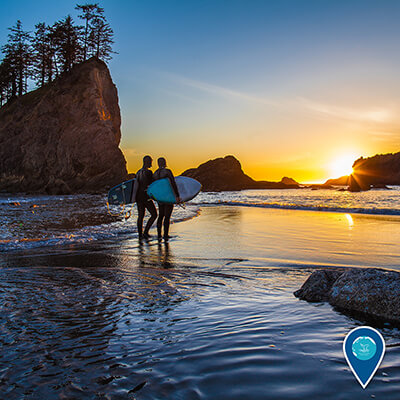
(Photo: Matt McIntosh/NOAA)

(Photo: David Slater/NOAA)

(Photo: Nick Zachar/NOAA)

(Photo: Richard Formica)

(Photo: Chad King/NOAA)

(Photo: Tane Casserley/NOAA)

(Photo: Ed Lyman/NOAA, under NOAA Permit #774-1714)

(Photo: Peter Flood)

(Photo: Greg McFall/NOAA)

(Photo: The Ocean Agency/XL Catlin Seaview Survey)

(Photo: Nick Zachar/NOAA)

(Photo: NOAA)

(Photo: Boxuan Zhan)

(Image: Ayaan Patel)

(Photo: Douglas Croft Images)

(Photo: Nick Zachar/NOAA)

How are you celebrating Earth Day?
(Photo:Douglas Croft Images)

What inspires you about the ocean and Great Lakes?
(Photo: NOAA)

(Photo: Nick Zachar/NOAA)

Humpback whales (typically 45 feet long): Baleen it.
A little perspective from NOAA's Monterey Bay National Marine Sanctuary for your Friday.
(Photo: Douglas Croft Images)

(Photo: Tony Knight)

(Photo courtesy of Jill Heinerth)






![An orca spyhopping.]](/media/eib/1591s.jpg)

(Photo: Nick Zachar/NOAA)

(Photo: Ed Lyman/NOAA, under NOAA Permit #15240)









































































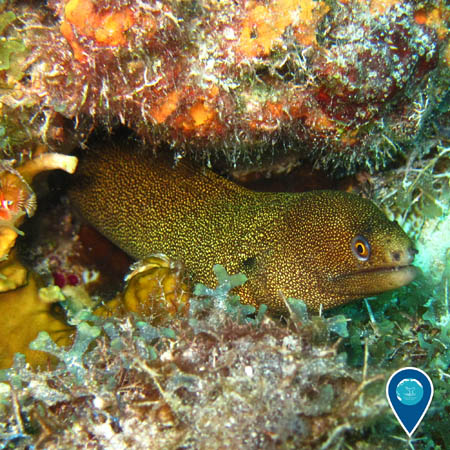









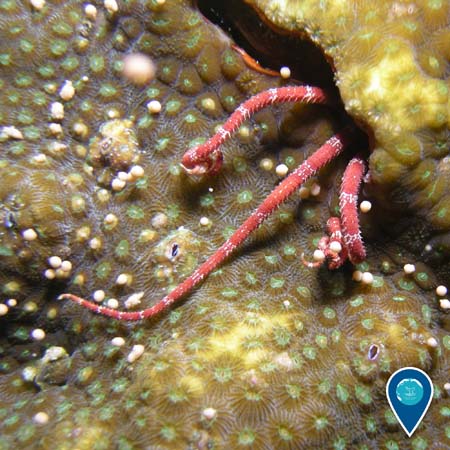



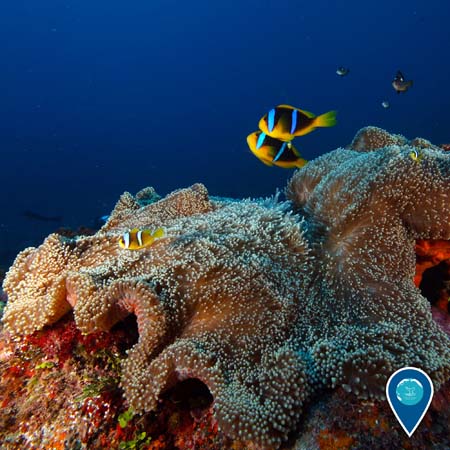






















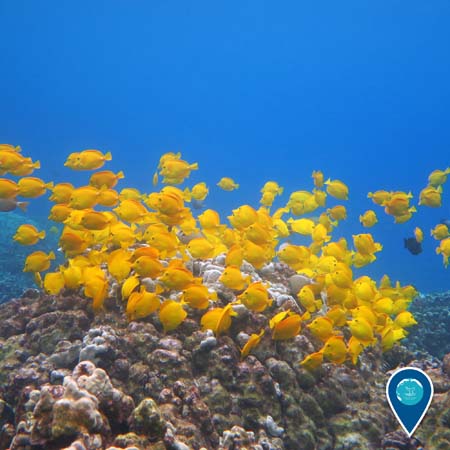












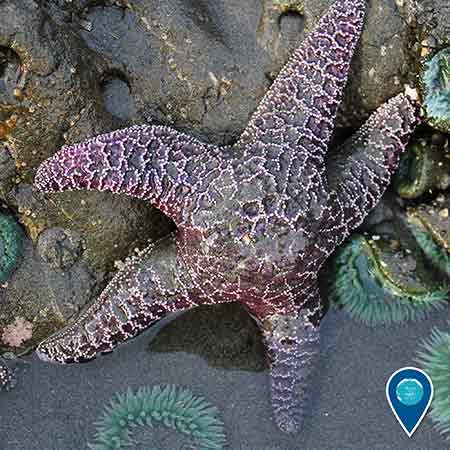





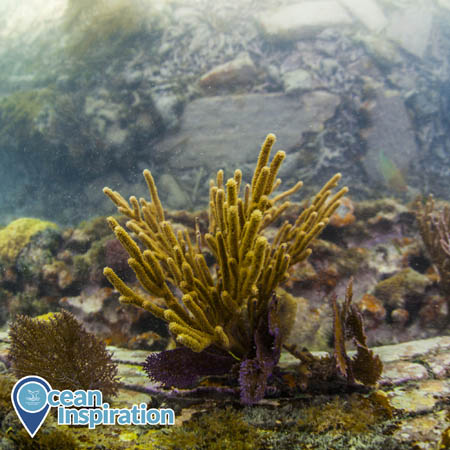










































































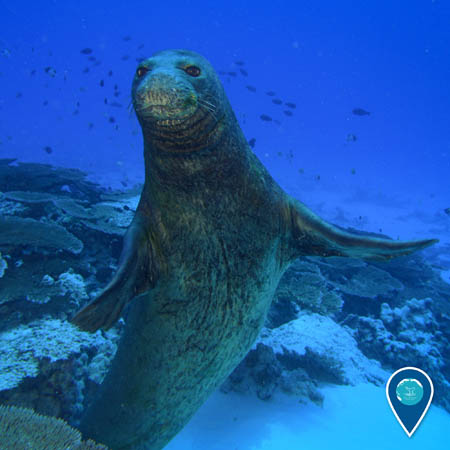
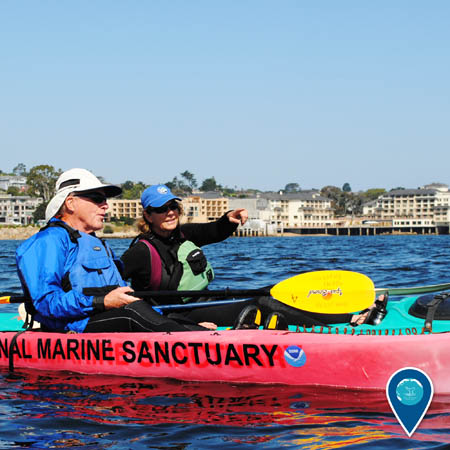
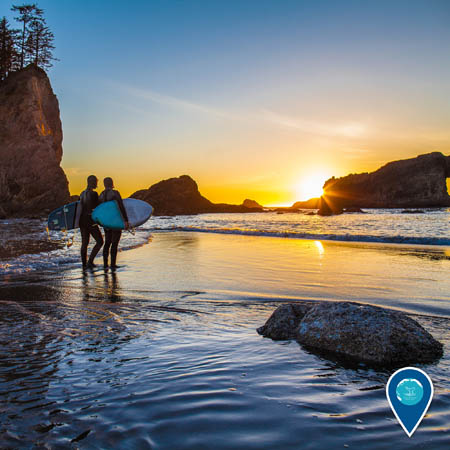
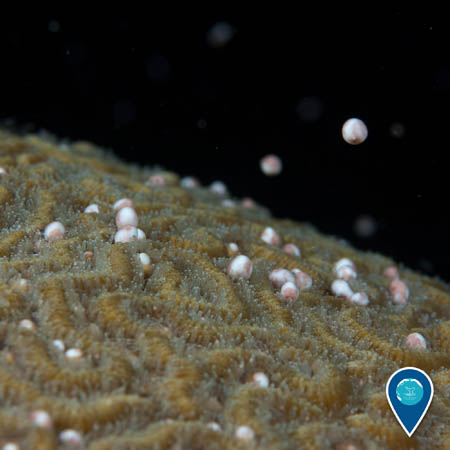
 e of the most abundant
displays in the entire Caribbean. Most scientists agree that these mass spawning events are designed to
allow genetic mixing and dispersal of offspring over large distances. Plus, the sheer volume of the
events allow for the fertilization and survival of a significant number of larvae despite the best
efforts of predators. (Photo: G.P. Schmahl/NOAA)
e of the most abundant
displays in the entire Caribbean. Most scientists agree that these mass spawning events are designed to
allow genetic mixing and dispersal of offspring over large distances. Plus, the sheer volume of the
events allow for the fertilization and survival of a significant number of larvae despite the best
efforts of predators. (Photo: G.P. Schmahl/NOAA)